11.3: North America c. 1500 - 1900 (I)
- Page ID
- 67097
North America c. 1500 – 1900
From the colonization of the new world to revolution, and independence.
Native North American art, c. 1500 – today
“Native American art” generally refers to peoples in what is today the United States and Canada.
c. 1500 - present
A beginner's guide
Terms and Issues in Native American Art
Alabama, Arizona, Arkansas, Connecticut, Illinois, Iowa, Kansas, Kentucky, Massachusetts, Minnesota, Mississippi, Missouri, the Dakotas, Ohio, Oklahoma, Oregon, Utah, Wisconsin, Wyoming—all state names derived from Native American sources. Pontiac, moose, raccoon, pecan, kayak, squash, chipmunk, Winnebago. These common words also derive from different Native words and demonstrate the influence these groups have had on the United States.Pontiac, for instance, was an 18th century Ottawa chief (also called Obwandiyag), who fought against the British in the Great Lakes region. The word “moose,” first used in English in the early seventeenth century during colonization, comes from Algonquian languages.
Stereotypes

Stereotypes persist when discussing Native American arts and cultures, and sadly many people remain unaware of the complicated and fascinating histories of Native peoples and their art. Too many people still imagine a warrior or chief on horseback wearing a feathered headdress, or a beautiful young “princess” in an animal hide dress (what we now call the Indian Princess). Popular culture and movies perpetuate these images, and homogenize the incredible diversity of Native groups across North America. There are too many different languages, cultural traditions, cosmologies, and ritual practices to adequately make broad statements about the cultures and arts of the indigenous peoples of what is now the United States and Canada.
In the past, the term “primitive” has been used to describe the art of Native tribes and First Nations. This term is deeply problematic—and reveals the distorted lens of colonialism through which these groups have been seen and misunderstood. After contact, Europeans and Euro-Americans often conceived of the Amerindian peoples of North America as noble savages (a primitive, uncivilized, and romanticized “Other”). This legacy has affected the reception and appreciation of Native arts, which is why much of it was initially collected by anthropological (rather than art) museums. Many people viewed Native objects as curiosities or as specimens of “dying” cultures—which in part explains why many objects were stolen or otherwise acquired without approval of Native peoples. Many sacred objects, for example, were removed and put on display for non-Native audiences. While much has changed, this legacy lives on, and it is important to be aware of and overcome the many stereotypes and biases that persist from prior centuries.
Repatriation
One significant step that has been taken to correct some of this colonial legacy has been NAGPRA, or the Native American Graves Protection and Repatriation Act of 1992. This is a U.S. federal law that dictates that “human remains, funerary objects, sacred objects, and objects of cultural patrimony, referred to collectively in the statute as cultural items” be returned to tribes if they can demonstrate “lineal descent or cultural affiliation.” Many museums in the U.S. have been actively trying to repatriate items and human remains. For example, in 2011, a museum returned a wooden box drum, a hide robe, wooden masks, a headdress, a rattle, and a pipe to the Tlingít T’akdeintaan Clan of Hoonah, Alaska. These objects were purchased in 1924 for $500.
In the 19th century, many groups were violently forced from their ancestral homelands onto reservations. This is an important factor to remember when reading the essays and watching the videos in this section because the art changes—sometimes very dramatically—in response to these upheavals. You might read elsewhere that objects created after these transformations are somehow less authentic because of the influence of European or Euro-American materials and subjects on Native art. However, it is crucial that we do not view those artworks as somehow less culturally valuable simply because Native men and women responded to new and sometimes radically changed circumstances.
Many twentieth and twenty-first century artists, including Oscar Howe (Yanktonai Sioux), Alex Janvier (Chipewyan [Dene]) and Robert Davidson (Haida), don’t consider themselves to work outside of so-called “traditional arts.” In 1958, Howe even wrote a famous letter commenting on his methods when his work was denounced by Philbrook Indian Art Annual Jurors as not being “authentic” Native art:
Who ever said that my paintings are not in the traditional Indian style has poor knowledge of Indian art indeed. There is much more to Indian Art than pretty, stylized pictures. There was also power and strength and individualism (emotional and intellectual insight) in the old Indian paintings. Every bit in my paintings is a true, studied fact of Indian paintings. Are we to be held back forever with one phase of Indian painting, with no right for individualism, dictated to as the Indian has always been, put on reservations and treated like a child, and only the White Man knows what is best for him? Now, even in Art, ‘You little child do what we think is best for you, nothing different.” Well, I am not going to stand for it. Indian Art can compete with any Art in the world, but not as a suppressed Art…. 1
More terms and issues
The word Indian is considered offensive to many peoples. The term derives from the Indies, and was coined after Christopher Columbus bumped into the Caribbean islands in 1492, believing, mistakenly, that he had found India. Other terms are equally problematic or generic. You might encounter many different terms to describe the peoples in North America, such as Native American, American Indian, Amerindian, Aboriginal, Native, Indigenous, First Nations, and First Peoples.
Native American is used here because people are most familiar with this term, yet we must be aware of the problems it raises. The term applies to peoples throughout the Americas, and the Native peoples of North America, from Panama to Alaska and northern Canada, are incredibly diverse. It is therefore important to represent individual cultures as much as we possibly can. The essays here use specific tribal and First Nations names so as not to homogenize or lump peoples together. On SmartHistory, the artworks listed under Native American Art are only those from the United States and Canada, while those in Mexico and Central America are located in other sections.
You might also encounter words like tribes, clans, or bands in relation to the social groups of different Native communities. The United States government refers to an Indigenous group as a “tribe,” while the Canadian government uses the term “ban.” Many communities in Canada prefer the term “nation.”
Identity
In order to be legally classified as an indigenous person in the United States and Canada, an individual must be officially listed as belonging to a specific tribe or band. This issue of identity is obviously a sensitive one, and serves as a reminder of the continuing impact of colonial policy. Many contemporary artists, including James Luna (Pooyukitchum/Luiseño) and Jaune Quick-to-See-Smith (from the Confederated Salish and Kootenai Tribes of the Flathead Indian Nation), address the problem of who gets to decide who or what an Indian is in their work.
Luna’s Artifact Piece (1987) and Take a Picture with a Real Indian (1993) both confront issues of identity and stereotypes of Native peoples. In Artifact Piece, Luna placed himself into a glass vitrine (like the ones we often see in museums) as if he were a static artifact, a relic of the past, accompanied by personal items like pictures of his family. In Take a Picture with a Real Indian, Luna asks his audience to come take a picture with him. He changes clothes three times. He wears a loincloth, then a loincloth with a feather and a bone breastplate, and then what we might call “street clothes.” Most people choose to take a picture with him in the former two, and so Luna draws attention to the problematic idea that somehow he is less authentically Native when dressed in jeans and a t-shirt.
Even the naming conventions applied to peoples need to be revisited. In the past, the Navajo term “Anasazi” was used to name the ancestors of modern-day Puebloans. Today, “Ancestral Puebloans” is considered more acceptable. Likewise, “Eskimo” designated peoples in the Arctic region, but this word has fallen out of favor because it homogenizes the First Nations in this area. In general, it is always preferable to use a tribe or Nation’s specific name when possible, and to do so in its own language.
Additional resources:
Interview with James Luna for the Smithsonian
The National Museum of the American Indian
Janet Catherine Berlo and Ruth B. Phillips, Native North American Art, 2nd ed. (Oxford: Oxford University Press, 2015).
Brian M. Fagan, Ancient North America: The Archaeology of a Continent, 4th ed. (London: Thames and Hudson, 2005).
David W. Penney, North American Indian Art (New York: Thames and Hudson, 2004).
Karen Kramer Russell, ed., Shapeshifting: Transformations in Native American Art (New Haven: Yale University Press, 2012).
About geography and chronological periods in Native American art
Typically when people discuss Native American art they are referring to peoples in what is today the United States and Canada. You might sometimes see this referred to as Native North American art, even though Mexico, the Caribbean, and those countries in Central America are typically not included. These areas are commonly included in the arts of Mesoamerica (or Middle America), even though these countries are technically part of North America.
So how do we consider so many groups and of such diverse natures? We tend to treat them geographically: Eastern Woodlands (sometime divided between North and Southeast), Southwest and West (or California), Plains and Great Basin, and Northwest Coast and North (Sub-Arctic and Arctic). While this is by no means a perfect way of addressing the varied tribes and First Nations within these areas, such a map can help to reveal patterns and similarities.
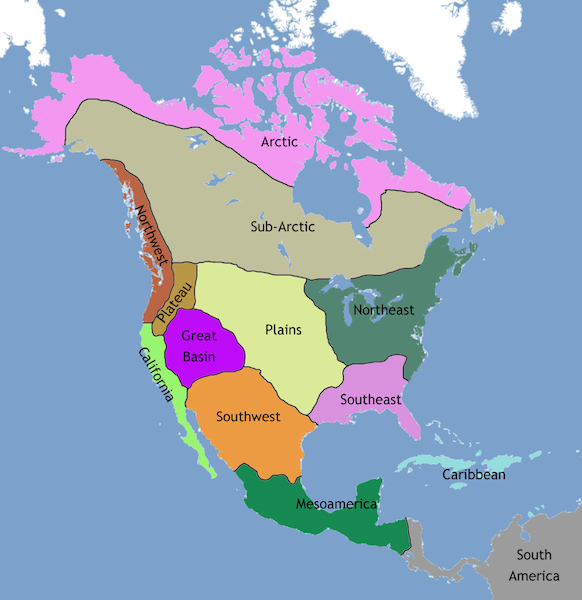
Chronology
Chronology (the arrangement of events into specific time periods in order of occurrence) is tricky when discussing Native American or First Nations art. Each geographic region is assigned different names to mark time, which can be confusing to anyone learning about the images, objects, and architecture of these areas for the first time. For instance, for the ancient Eastern Woodlands, you might read about the Late Archaic (c. 3000–1000 B.C.E.), Woodland (c. 1100 BCE–1000 C.E.), Mississippian (c. 900–c. 1500/1600 C.E.), and Fort Ancient (c. 1000–1700) periods. But if we turn to the Southwest, there are alternative terms like Basketmaker (c. 100 B.C.E.–700 C.E.) and Pueblo (700–1400 C.E.). You might also see terms like pre- and post-Contact (before and after contact with Europeans and Euro-Americans) and Reservation Era (late nineteenth century) that are used to separate different moments in time. Some of these terms speak to the colonial legacy of Native peoples because they separate time based on interactions with foreigners. Other terms like Prehistory have fallen out of favor and are problematic since they suggest that Native peoples didn’t have a history prior to European contact.
Organization
We arrange Native American and First Nations material prior to c. 1500 in a separate section which includes material about the Ancestral Puebloans, Moundbuilders, and Mississippian peoples. Those objects and buildings created after c. 1500 are in their own section, which will hopefully highlight the continuing diversity of Native groups as well as the transformations (sometimes violent ones) occurring throughout parts of North America. Artists working after 1914 (or the beginning of WWI) are located in both the Art of the Americas section, and in the modern and contemporary areas.
Additional resources:
Janet Catherine Berlo and Ruth B. Phillips, Native North American Art, 2nd ed. (Oxford: Oxford University Press, 2015).
Brian M. Fagan, Ancient North America: The Archaeology of a Continent, 4th ed. (London: Thames and Hudson, 2005).
David W. Penney, North American Indian Art ( New York: Thames and Hudson, 2004).
Karen Kramer Russell, ed., Shapeshifting: Transformations in Native American Art (New Haven: Yale University Press, 2012).
East
Global trade and an 18th-century Anishinaabe outfit
by DR. DAVID W. PENNEY, NATIONAL MUSEUM OF THE AMERICAN INDIAN, SMITHSONIAN INSTITUTION and DR. STEVEN ZUCKER
Video \(\PageIndex{1}\): Anishinaabe outfit, c. 1790, collected by Lieutenant Andrew Foster, Fort Michilimackinac (British), Michigan, Birchbark, cotton, linen, wool, feathers, silk, silver brooches, porcupine quills, horsehair, hide, sinew; the moccasins were like made by the Huron–Wendat people (National Museum of the American Indian, Smithsonian Institution), a Seeing America video
Speakers: Dr. David Penney, Associate Director for Museum Scholarship, Exhibitions, and Public Engagement, National Museum of the American Indian and Dr. Steven Zucker
Additional resources
SmartHistory images for teaching and learning:

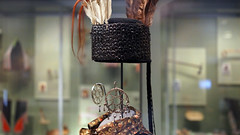
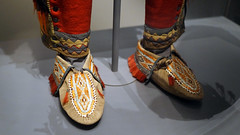
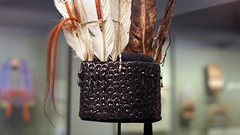
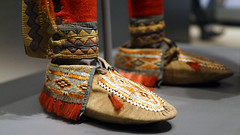

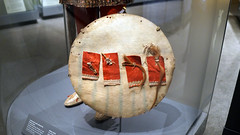
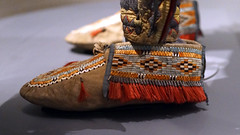

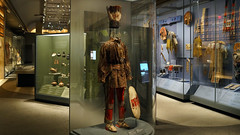
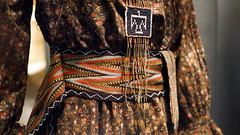
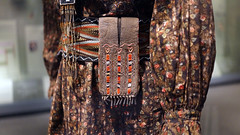
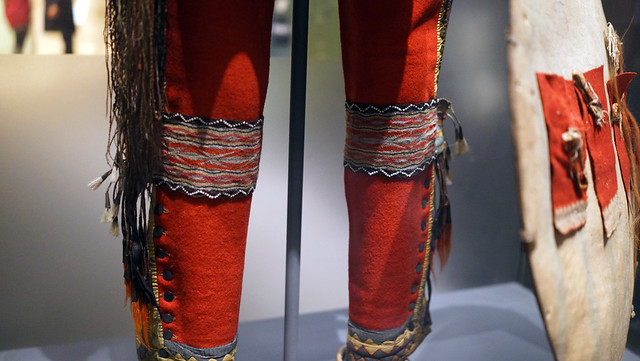
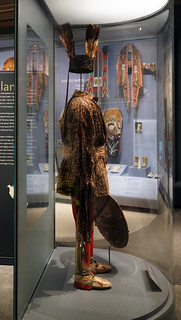
The bandolier bag
by DR. ADRIANA GRECI GREEN and DR. STEVEN ZUCKER
Video \(\PageIndex{2}\): A conversation with Dr. Adriana Greci Green and Dr. Steven Zucker. Shoulder Bag, 1840-1850, Delaware, Lenni Lenape, cotton, wool, silk, glass beads, tinned iron, brass, bone, 29 1/2 inches high (Newark Museum of Art, Purchase 2017 Mr. and Mrs. William V. Griffin Fund 2017.10)
Additional resources:
The Shoulder Bag at the Newark Museum of Art
Bandolier Bag

When looking at photographs of what we today call a Bandolier Bag (in the Ojibwe language they are called Aazhooningwa’on, or “worn across the shoulder”), it is nearly impossible to see the thousands of tiny beads strung together that decorate the bag’s surface.¹ This is an object that invites close looking to fully appreciate the process by which colorful beads animate the bag, making a dazzling object and showcasing remarkable technical skill.
What is a Bandolier Bag?
Bandolier Bags are based on bags carried by European soldiers armed with rifles, who used the bags to store ammunition cartridges. While Bandolier Bags were made by different tribes and First Nations across the Great Lakes and Prairie regions, they differ in appearance. The stylistic differences are the result of personal preference as much contact with Europeans and Euro-Americans, goods acquired in trade, and travel.

The National Museum of the American Indian (NMAI) in New York City has a wonderful example of a Bandolier Bag, most likely made by a Lenape artist (the Lenape are part of the Delaware tribe or First Nation, who lived along the Delaware River and parts of what is today New York State).²
Bandolier Bags (like this one) are often large in size and decorated with a wide array of colorful beads and ribbons. They are worn as a cross-body bag, with a thick strap crossing a person’s chest to allow it to rest on the hip.
These bags were especially popular in the late nineteenth century in the Eastern or Woodlands region, which comprised parts of what is today Canada and the United States. The Woodlands area encompasses the Great Lakes Region and terrain east of the Mississippi River. This enormous geographic area has a long, complex history including the production of objects we today recognize as “art,” that date back more than 4,000 years.
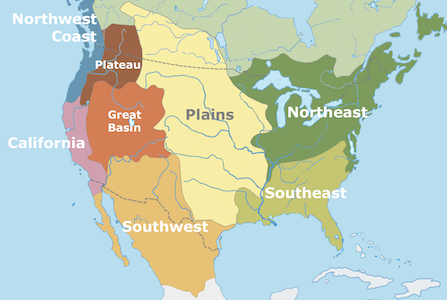
Bandolier Bags were created across this vast expanse of land, and the NMAI has examples from the Upper Great Lakes region and Oklahoma. Due to events and laws like the Indian Removal Act of 1830 (signed by President Andrew Jackson), the Lenape were forcibly removed from these ancestral lands and relocated to areas of Oklahoma, Wisconsin, and Ontario, Canada. Despite these traumatic relocations, tribes like the Lenape continued to create objects as they had in ancestral lands. Bandolier bags are one example of this continued artistic production.
Material and design

While men most commonly wore these bags, women created them. Initially, Bandolier Bags did not have a pocket, but were intended to complement men’s ceremonial outfits. Men even wore more than one bag on occasion, dressing themselves in a rainbow of colors and patterns. Even those bags with pockets weren’t necessarily always used to hold objects.
Women typically produced Bandolier Bags using trade cloth, made from cotton or wool. It is often possible to see the exposed unembroidered trade cloth underneath the cross-body strap. The NMAI bag (above) uses animal hide in addition to the cotton cloth, combining materials that had long been used among these groups (animal hides) with new materials (cotton trade cloth).
Beads and other materials were embroidered on the trade cloth and hide. The tiny glass beads, called seed beads, were acquired from European traders, and they were prized for their brilliant colors. Glass beads replaced porcupine quillwork, which had a longstanding history in this area. Before the use of glass beads, porcupine quills were acquired (carefully!), softened and dyed. Once they were malleable enough to bend, the quills were woven onto the surfaces of objects (especially clothing or other cloth goods like bags). Quillwork required different working techniques than embroidering with beads, so people adopted new methods for decorating the surfaces of bags, clothing, and other goods.

In addition to glass beads, the NMAI bag is decorated with silk ribbons—also procured via trade with Europeans. Much like the glass beads, silk ribbons offered a new material with a greater variety of color choices. Looking at the NMAI bag, we can see that the artists attached strips of yellow, blue, red, and green ribbons, like tassels, to the ends of the straps, as well as longer orange ribbons that fall below the bottom of the bag. Before the introduction of ribbons, women would paint the surface of hides in addition to decorating the bags with quillwork. Ribbons afforded women the opportunity to produce more textural variation, and to expand the surface of the bags in new ways. Imagine wearing this bag: the bright colors would attract attention and the sparkle of the beads would reflect sunlight as the ribbons fluttered in the wind or moved as one walked.
Further animating the surface of the NMAI Bandolier Bag is a red wool fringe, capped with metal cones that attach to the bag’s rectangular pouch. Like the ribbons and beads, the fringe and metal offered more colors and textures to the bag’s surface.

The designs on the bag are abstracted and symmetrical. White beads act as contour lines to help make the designs more visible to the naked eye. On the cross-body strap, we see a design that branches in four directions. Yet notice how the artist has actually made each side slightly different. The left portion of the strap displays a light blue background, and the repeating form is more rounded, with softer edges. On the right side of the strap, the blue is darker, the framing pink and green is varied, and the repeating form displays more straight lines. The small size of seed beads allowed for more curvilinear designs than quillwork.

It is possible that the contrasting colors represent the Celestial/Sky and Underworld realms. The abstracted designs on the sash may also be read in relation to the cosmos because they branch into four directions, which might relate to the four cardinal directions (north, south, east, and west) and the division of the terrestrial (earthly) realm into four quadrants.
Prairie Style
The NMAI Bandolier Bag relates to a broader array of objects that demonstrate the Prairie Style. The artist of the NMAI Bandolier Bag borrowed from older Delaware traditions, as well as those of other native peoples after they were forcibly relocated. Another Bandolier bag in the NMAI collection (below), by an Anishnaabe artist, demonstrates the “Prairie Style” clearly in the upper section where a floral motif floats against a dark ground.


The Prairie Style used colorful glass beads fashioned in floral patterns. The patterns could be either naturalistic flowers or abstract floral designs. A Sac and Fox breechcloth in the NMAI collection (left) is a clear example of the more abstract Prairie Style because the floral designs do not closely resemble flowers that you might see in nature (the Sacs or Sauks are an Eastern Woodlands group, the Fox tribe is closely related to them, and they are both centered in Oklahoma today, though there are Sac and Fox tribes in Iowa and Kansas as well).
The Prairie Style is the result of peoples coming into contact with one another, particularly in the wake of removal from their ancestral homelands. Floral forms, combined with the use of ribbons and colorful glass beads, not only attest to the transformations in artistic production, but also testifies to the creativity of people as they adapted to new situations. Bandolier Bags, as well as other objects and clothing, helped to express group identities and social status. In the wake of forced removals and threats to traditional ways of life, objects like the NMAI Bandolier Bag demonstrate the resilience and continued creativity of groups like the Lenape.
Today
Bandolier Bags are still made and worn today—attesting to their rich and complex history and their continuing ceremonial and cultural functions. For example, when the NMAI opened a new museum in Washington, D.C., in 2004, Ojibwe men wore colorful Bandolier Bags during the opening festivities and ceremonies. Artists continue to innovate by creating new interpretations of Bandolier Bags. Maria Hupfield, who belongs to the Wasauksing First Nation in Ontario, Canada, and currently lives in Brooklyn, made a Bandolier Bag from gray felt—an industrial material transformed into something beautiful and historically significant.
1. Anishnaabe is the name for the ethnic group that comprises the Ojibwe, Odawa, and Potawatomi First Nations around the Great Lakes. Due to relocations of the nineteenth century, many other groups like the Delaware and Dakota currently live on the same lands.
2. In the United States, it is more common to see the term “Native American,” “Native,” or “Indigenous,” whereas “First Nations” used more frequently in Canada.
Additional resources:
Lenape Bandolier Bag in the National Museum of the American Indian
Sac and Fox man’s breechcloth in the National Museum of the American Indian (NMAI)
Anishinaabe bandolier bag in the National Museum of the American Indian (NMAI)
The NMAI blog on Maria Hupfield
David W. Penny, North American Indian Art, (London: Thames and Hudson, 2004).
Janet Catherine Berlo and Ruth B. Phillips, Native North American Art, 2 ed. Oxford History of Art series (Oxford: Oxford University Press, 2014).
SmartHistory images for teaching and learning:
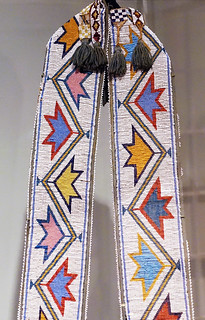



West
Juana Basilia Sitmelelene, Presentation Basket (Chumash)
by DR. LAUREN KILROY-EWBANK and DR. STEVEN ZUCKER
Video \(\PageIndex{3}\): Juana Basilia Sitmelelene, Coin (Presentation) Basket, Chumash, Mission San Buenaventura, c. 1815-22, sumac, juncus textilis, mud dye, 9 x 48 cm (National Museum of the American Indian).Speakers: Dr. Lauren Kilroy-Ewbank and Dr. Steven Zucker
Learn about this beautiful basket—a luxury item made by a Chumash woman in California (then, New Spain) at the time of the Mexican War of Independence from Spain—with motifs derived from Spanish coins.
War Shirt (Upper Missouri River)
by DR. JOHN P. LUKAVIC, DENVER ART MUSEUM
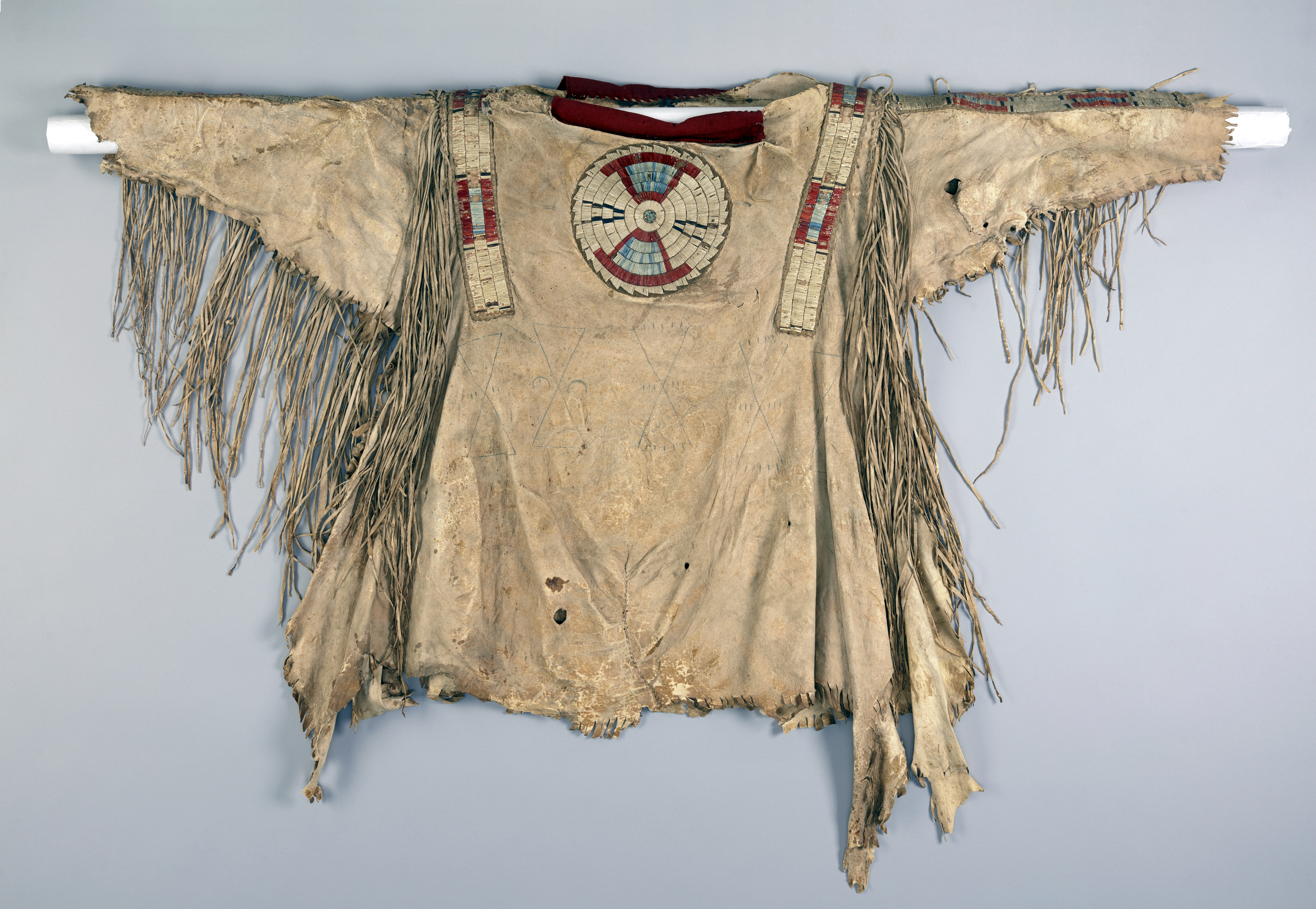
Studying art during a pandemic
As many of us find ourselves working and studying from home while social distancing during the world-wide spread of COVID-19, let us think about the impact other pandemics and epidemics have had on world populations and their arts. Visual records open a window into such events, as we see in depictions of leprosy in European medieval illuminated manuscripts or in pictographic accounts of smallpox epidemics that spread across the Great Plains of North America in the eighteenth and nineteenth centuries.[1] Northern plains groups experienced 36 epidemics between 1714 and 1919, which were documented in chronological order in winter counts.[2] A winter count depicted the most important events that occurred in any given year. Community elders would meet each year to discuss what had occurred since winter started (denoted by the first snowfall), and would select the most important event to name the year, after which a symbol (or pictograph) would be created and added to a hide painting.
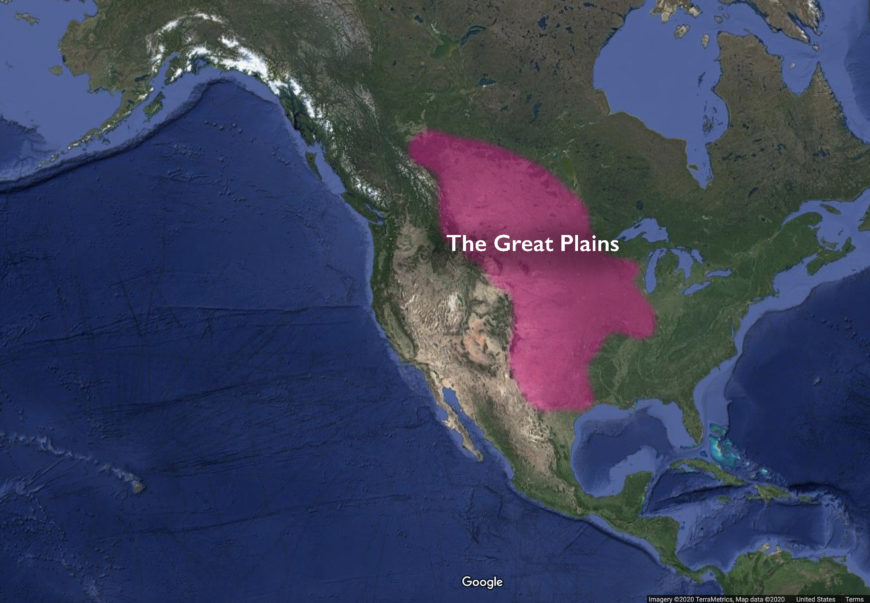
One example is the 1837–38 smallpox epidemic which was catastrophic for the Mandan Nation.[3] According to historian Clay Jenkinson “In two waves of smallpox on the Upper Missouri, separated by 56 years, the Mandan had been reduced from a proud nation of more than 15,000 individuals to a pathetic remnant of 145.”[4] With so much loss we must consider the dramatic impact such events had on the transmission of Indigenous knowledge, but also celebrate these communities’ perseverance, and ability to adapt. Today the population of the Three Affiliated Tribes (Mandan, Hidatsa, and Arikara) have again risen to around 15,000 citizens who live on the Fort Berthold Indian Reservation in North Dakota.[5]
Understanding this history of pandemic and loss provides us with a lens through which to see artworks from the upper Missouri River region. The scarcity of existing objects, and as a result, limited visual references create significant challenges in making specific attributions and comparisons from this region and period of time.
Still, some of the defining features of northern plains groups (at the time of contact) formed as a response to disease and the resulting loss of life. One scholar notes that “The social fluidity whereby tribes or divisions of tribes split apart and regrouped may have developed as a means of coping with catastrophic population loss.”[6] Epidemics affected all aspects of life for plains groups. For example, warriors could not train and military technology could not be developed if the group was sick and dying.[7]
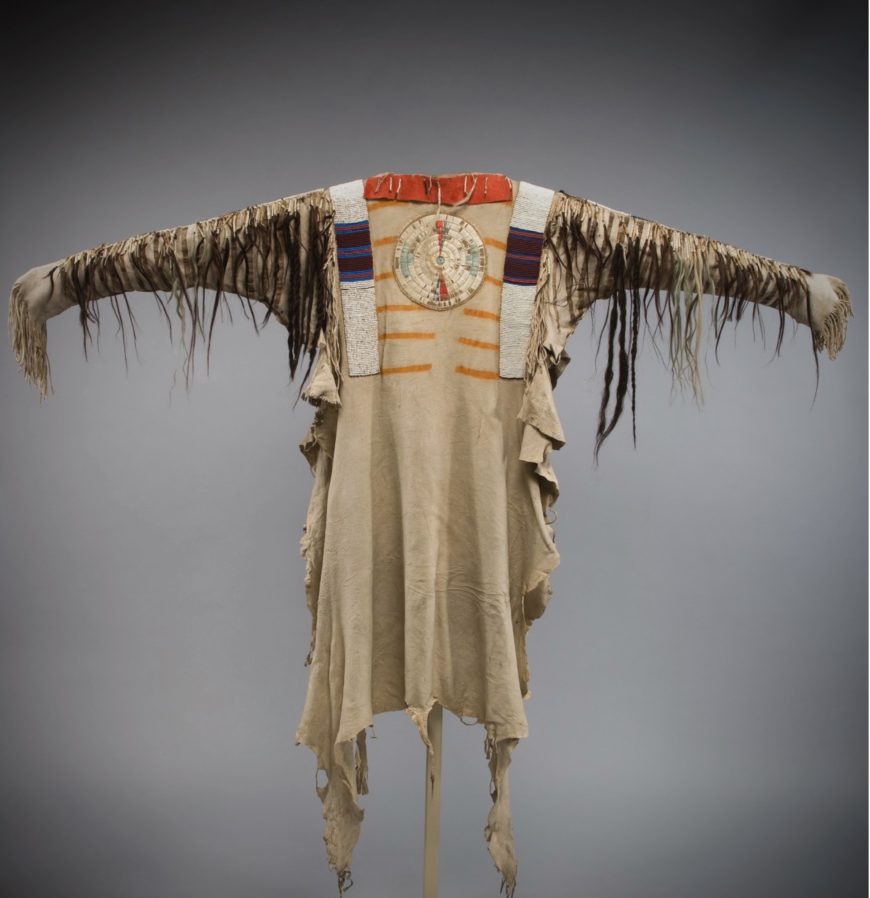
Museum collections and the paintings of Catlin and Bodmer
We see evidence of the enormous population loss in men’s shirts from this time period. In this context, men’s shirts refer to a shirt worn by a warrior into battle or during festivals (so not daily use), and which are decorated with hair fringes (human and horse), ermine tails, quillwork, and beadwork. While we may know they were made by artists from this region, assigning an attribution to a particular community is difficult for several reasons. Few pre-1850 arts by Indigenous artists from any region exist in U.S. museums, although some can be found in international museums (including in the Paul Kane collection in the Manitoba Museum in Winnipeg and the collections of Prince Maximiliam of Wied in museums located in Berne, Berlin, and Stuttgart). Some collections exist from Lewis and Clark’s expedition from 1804–1806, but William Clark’s personal collection, once housed in his home in St. Louis until his death in 1838, went missing around this time and its whereabouts remains unknown to this day.[8] The total number of works of American Indian arts from the Plains before 1850 remains quite small.
When you narrow down these early nineteenth-century arts to shirts, and those exclusively from the upper Missouri River region, there are few examples with which to compare, and even fewer with documentation. Of the 40 shirts in the collection of the Denver Art Museum from the Plains and Plateau regions, only two date to around 1830 or before. One is attributed to an Assiniboine artist and the other is dated to 1800–20, and is the focus of this discussion.
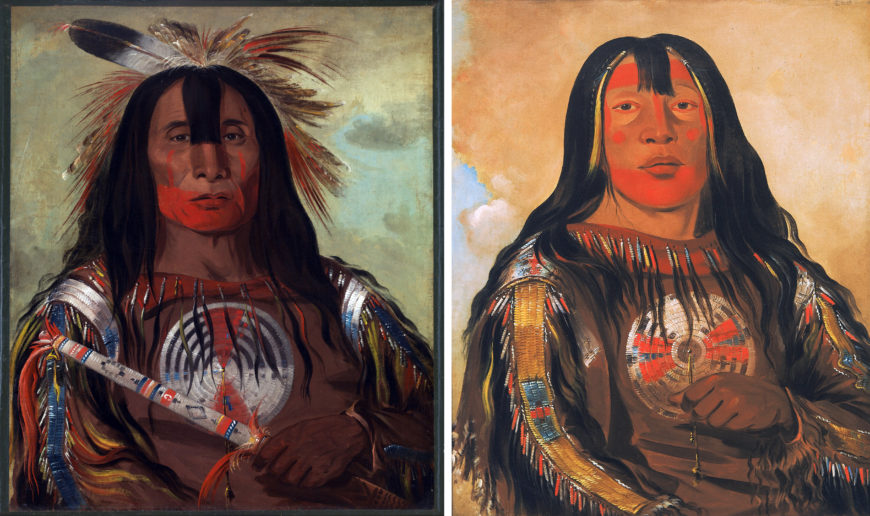
With limited examples, great losses in the continuity of Indigenous knowledge, and works that predate photography by decades, the main way to identify these shirts is through the written reports of fur traders and explorers, as well as the paintings of George Catlin and Karl Bodmer who traveled in the region in the 1830s.
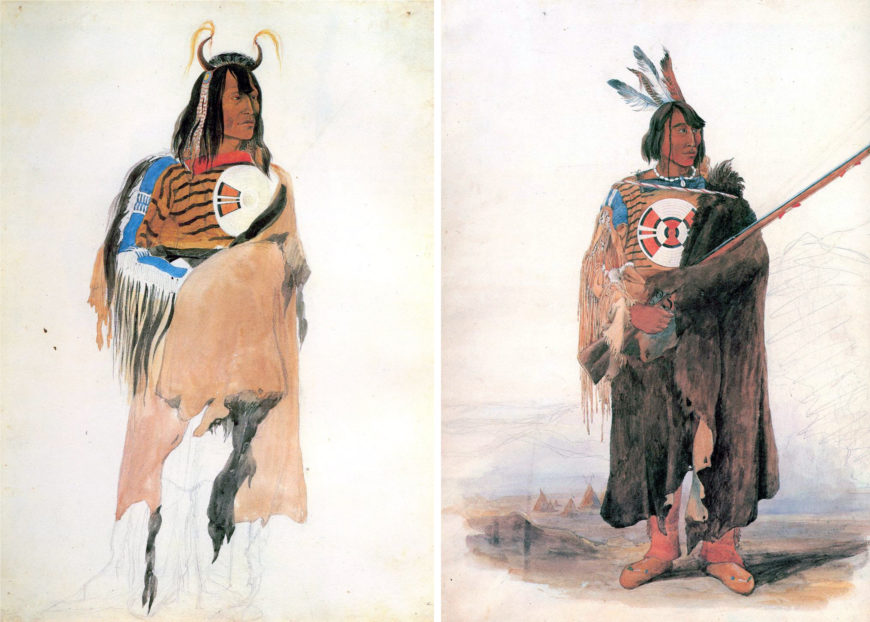
Interpreting what the shirt says about the man who wore it
In December of 2019 the Denver Art Museum received two shirts from the Upper Missouri region of the Plains as gifts from a private collector: one dating to around 1800–20 and the other to around 1855. The earlier of these two shirts is without question the single most significant work to come into DAM’s Native arts collection in decades.

It is exceedingly rare and among the earliest shirts from the Upper Missouri River region in existence. The shirt’s lack of beadwork, minimal use of Bayetta trade wool, and quilled design elements point to its early creation date and connection to this region.
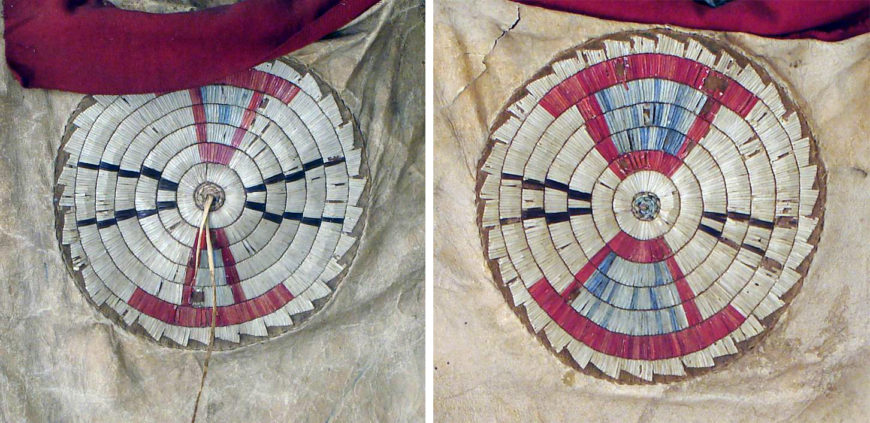
This fringed “poncho” style shirt with red trade wool rectangular “bibs” was made using Native tanned mountain sheep hides and sewn using sinew (animal tendons or ligaments used as thread). On both the front and back of the shirt are saw-tooth edged medallions (rosettes) and over each shoulder and along each sleeve are three quilled lanes with geometric patterning.
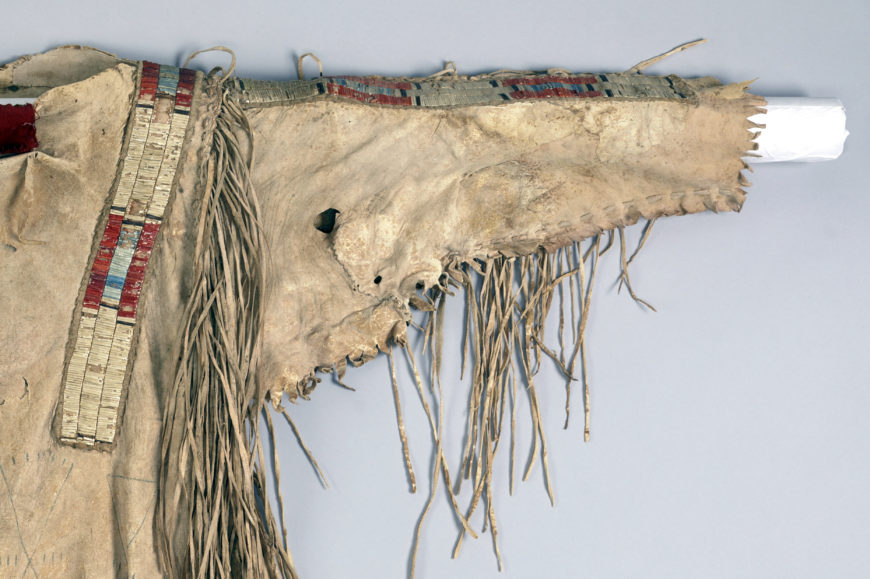
While little was recorded about the meanings of such elements, the medallions are commonly considered representations of forces of nature, such as the sun or powerful winds. It has also been suggested that the designs on medallions, such as those seen on this shirt and many others from this region, may represent the wings of a Thunderbird, a sacred being for many Plains tribes.
The central medallions are made from porcupine quills, likely plant material, and possibly also bird quills. Porcupine quillwork is a technique Indigenous to North America and was prevalent prior to the trade of European manufactured glass trade beads. Today this technique is experiencing a resurgence among many Native artists. The materials used on this shirt (as well as materials not used, such as glass beads) suggest it was made just as trade between fur trappers and Native people began in the central part of North America.
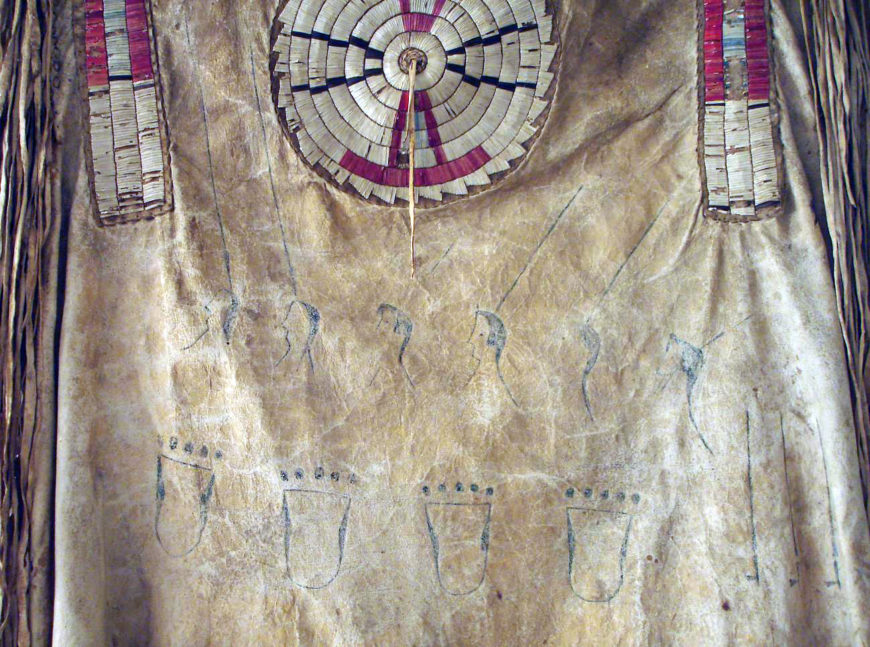
What is among the most exciting elements of this shirt are a series of pictographic and geometric drawings found on either side. If you look closely you will see faint indigo drawings of six heads, above which are floating lines. Below the heads is a row of four bear paws, and to the right are three pipes. The exact meaning of these elements was not recorded; however, based on Indigenous knowledge and with the help of Dr. Timothy McCleary, a colleague from Little Bighorn Tribal College at Crow Agency in Montana, we believe we know what they mean.
The heads with floating lines likely refer to counting coup, or striking an enemy with a stick. When a warrior touched his enemy with his coup stick, it was regarded as an act of extreme bravery because he had to get close to his opponent. The pipes may suggest how many times the shirt’s owner led successful war parties. The bear paws show how many Plains grizzlies the owner of the shirt had killed. Drawings and explanations in American ethnologist Garrick Mallery’s 1889 publication Picture Writing of the American Indians demonstrates how widespread such imagery was among Plains artists in the late nineteenth century. Mallery’s text reproduces a drawing and accompanying explanation by an Oglala Lakota man that explains the meaning of pipes depicted similarly to what we see in the shirt, as well as other design elements recorded on it.
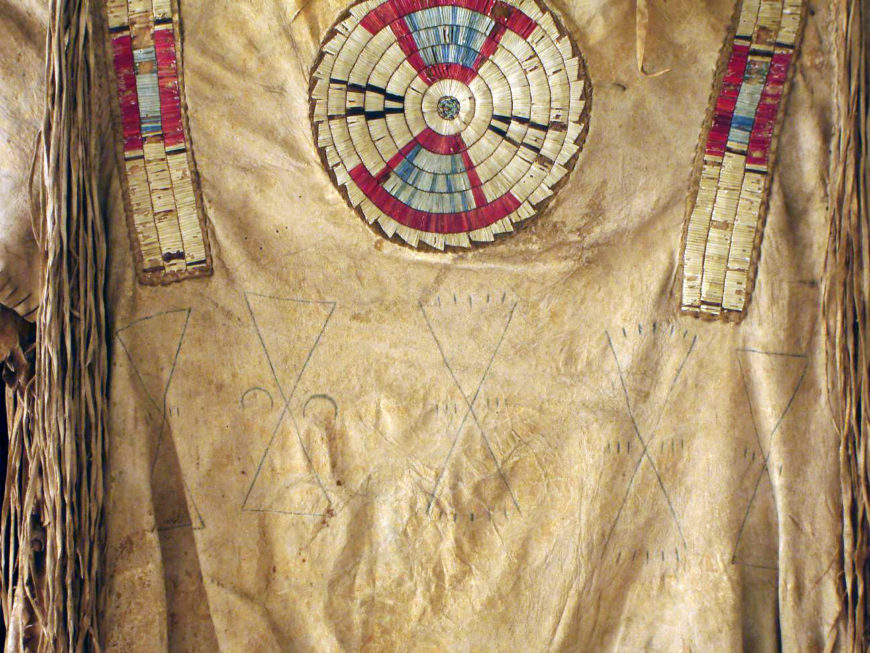
The designs on the front of the shirt tell even more specific stories about the owner. Here, we find drawings of five X-like forms arranged below the medallion. These are war honor marks. From left to right, we can read these to recount the original owner’s achievements in war. The first shows that the warrior was the third person to touch a live enemy in battle (counting coup). The next shows that after he had dismounted an enemy, the owner of the shirt captured the enemy’s horse. The next two Xs show he was the fourth person to count coup on an enemy during battle. Then the last shows that he was again the third to count coup on an enemy. Mallery recorded variations of these designs and meanings as told to him by Hidatsa, Mandan, and Arikara consultants.
These marks were common ways to record war deeds among the Native people of the Upper Missouri River region and are found on clothing, tipis, and in rock art. The Mandan, Hidatsa, Arikara, and Crow people are well known for their use of this X to represent an enemy. While a few other tribes also used this imagery, this form with the associated hash marks (denoting the number of coups) and horse hoof prints are all from one of the Upper Missouri River tribes.
Ongoing challenges
Indigenous people have faced countless challenges to their ways of life since the arrival of settler-colonial people. Sickness and disease took its toll, but so did forced relocation, land allotment that broke up clan and society structures, prohibitions against ceremonies and religions, traumatic boarding school experiences, broken treaties, and institutional and structural racism, to name a few. Each of these created seemingly insurmountable hurdles for Indigenous people to overcome.
Many of these challenges still exist. The Navajo Nation has been hit hard by COVID-19. Two Lakota reservations are under attack from the governor of South Dakota for the medical checkpoints they put up on their own roads to protect their citizens from the spread of this disease. Generational trauma from past experiences warns them to protect themselves. Elders are the keepers of knowledge and they are most at risk. The transmission of intergenerational knowledge of all forms, visual arts included, is difficult during such times. But this knowledge still exists in communities. These art forms are still being created by brilliant and innovative Indigenous youth. And this should give us hope for the future.
Notes:
[1] Linea Sundstrom, “Smallpox Used Them up: References to Epidemic Disease in Northern Plains Winter Counts, 1714–1920,” Ethnohistory 44, no. 2 (Spring, 1997), pp. 305–343
[2] Sundstrom, “Smallpox Used Them up,” p. 308
[3] It has been suggested that the Mandans, Arikaras, and Hidatsas from the upper Missouri River region lost a combined 70% of their populations. Donald J. Lehmer, “Epidemics among the Indians of the Upper Missouri,” in Selected Writings of Donald J. Lehmer, ed. W. Raymond Wood, Reprints in Anthropology no. 8 (I977), pp. 105–11
[4] Clay Jenkinson, “Smallpox and Indians: When Pandemic Warnings Go Unheeded,” in Governing, April 22, 2020, https://www.governing.com/context/Smallpox-and-Indians-When-Pandemic-Warnings-Go-Unheeded.html
[5] Jenkinson, “Smallpox and Indians”
[6] Sundstrom, “Smallpox Used Them up,” p. 325
[7] Sundstrom, “Smallpox Used Them up,” p. 325.
[8] Norman Feder, American Indian Art Before 1850, Denver Art Museum Summer Quarterly (1965), p. 5; National Park Service, Department of the Interior, “William Clark’s Indian Museum: A Tradition Continued,” in The Museum Gazette (October 1997), p. 5
Additional resources
Learn more about the Denver Art Museum’s collection of Indigenous Arts of North America
Learn about Lakota Winter Counts in this Smithsonian video
Learn more about narrative art of the Plains from the National Museum of the American Indian
Colin Taylor, “Analysis and Classification of the Plains Indian Ceremonial Shirt: John C. Ewers Influence on a Plains Material Culture Project,” in Fifth Annual Plains Indian Seminar in Honor of Dr. John C. Ewers, ed. George P. Horse Capture and Gene Ball (Buffalo Bill Historical Center, Cody, 1980)
David W. Penney, Art of the American Frontier: The Chandler-Pohrt Collection (Detroit Institute of Arts, 1992)
George Horse Capture and Joseph D. Horse Capture, Beauty, Honor and Tradition: The Legacy of Plains Indian Shirts (University of Minnesota Press, 2001)
Colin F. Taylor, Buckskin & Buffalo: The Artistry of the Plains Indians (New York: Rizzoli, 1998)
George Catlin and His Indian Gallery (Smithsonian American Art Museum, 2002)
David C. Hunt and Marsha V. Gallagher, Karl Bodmer’s America (Joslyn Art Museum, 1984)
Emma I. Hansen, Memory and Vision: Arts, Cultures and Lives of Plains Indian Peoples (Seattle and London: University of Washington Press, 2007)
Garrick Mallery, Picture Writing of the American Indians, Volume I (New York: Dover Publications, 1972). A reprint of the paper “Picture Writing of the American Indians,” in the Tenth Annual Report of the Bureau of Ethnology to the Secretary of the Smithsonian Institution, 1888-89, by J. W. Powell, Director, published by the Government Printing Office, Washington, D.C. in 1893
Norman Feder, “Plains Pictographic Painting and Quilled Rosettes,” in American Indian Art Magazine, Vol. 5, no. 2, pp. 54–62
Colin F. Taylor, Saam: The Symbolic Content of Early Northern Plains Ceremonial Regalia, (Verlag Fur Amerikanistik, 1993)
Norman Feder, Two Hundred Years of North American Indian Art (New York: Praeger Publishers, 1971)
John F. Taylor , I977, “Sociocultural Effects of Epidemics on the Northern Plains: 1734–1850,” Western Canadian Journal of Anthropology 7 (4): pp. 55–81
Bear Claw Necklace (Pawnee)
by DR. JOHN P. LUKAVIC, DENVER ART MUSEUM and DR. STEVEN ZUCKER
Video \(\PageIndex{4}\): Bear Claw Necklace (Pawnee), before 1870, grizzly bear claws and hide, otter pelt, beads, cedar, tobacco and other materials (Denver Art Museum), a SmartHistory Seeing America video
Speakers: Dr. John Lukavic, curator of Native Arts, Denver Art Museum and Dr. Steven Zucker
Additional historical narratives:
Matt Reed
Tribal Historic Preservation Officer, Cultural Resource Division of the Pawnee Nation of Oklahoma notes that:
When the Lakota attacked, Sky Chief put the necklace and the family’s sacred bundle on his young daughter, put her on his horse, and told her to run. She made it to safety. Sky Chief died right after he killed his own little boy to prevent the child’s capture, torture, and death by the Sioux. When Sky Chief’s daughter eventually got back to Genoa, Nebraska (then the Pawnee Reservation), the little girl, now an orphan, was taken in by Bluehawk (Matt Reed’s grandfather), who raised her as his own. She grew up, married, and in 1987, her granddaughter, Elizabeth, gave the sacred bundle to the Earthlodge Museum in Republic, Kansas. More information on the bundle can be found here.
Roger Echo-Hawk
Pawnee tribal historian, notes that:
Stacy Matlock, a Chaui Pawnee chief, was said to have worn this necklace in 1925 during a visit to the Lakota when they formally apologized for the 1873 attack at Massacre Canyon. The Denver Art Museum acquired the necklace in 1973.
SmartHistory images for teaching and learning:
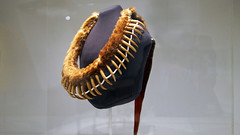
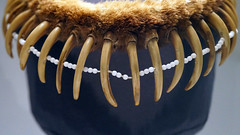
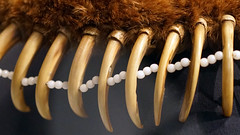
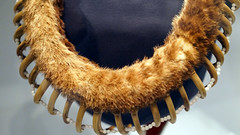


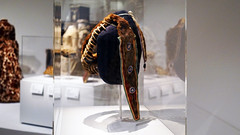
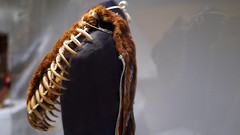
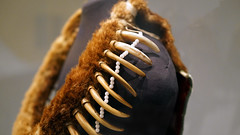
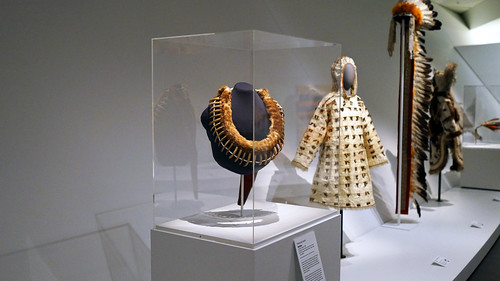
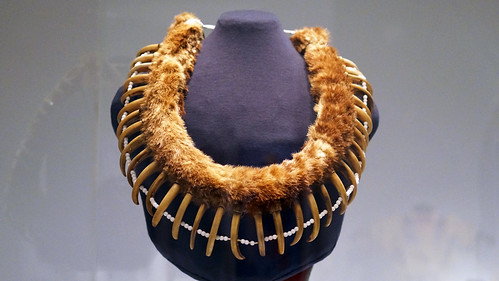
Eastern Shoshone: Hide Painting of the Sun Dance, attributed to Cotsiogo (Cadzi Cody)

Animal hide painting
Painting on animal hides is a longstanding tradition of the Great Basin and Great Plains people of the United States, including the Kiowa, Lakota, Shoshone, Blackfeet, Crow, Dakota, and Osage. While the earliest surviving hide paintings date to around 1800, this tradition was undoubtedly practiced much earlier along with other forms of painting like petroglyphs (rock engravings).

Painting, in tandem with oral traditions, functioned to record history. Often artists like Cotsiogo (Eastern Shoshone; pronounced “co SEE ko”), who is also known by his Euro-American name, Cadzi Cody, painted on elk, deer, or buffalo hides using natural pigments like red ochre and chalk, and eventually paints and dyes obtained through trade. Usually, artists decorated the hides with geometric or figural motifs. By the later nineteenth century certain hide artists like Cotsiogo began depicting subject matter that “affirmed native identity” and appealed to tourists. The imagery placed on the hide was likely done with a combination of free-hand painting and stenciling.
Men and women both painted on hides, but men usually produced the scenes on tipis (tepees), clothing, and shields. Many of these scenes celebrated battles and other biographical details. The Brooklyn Museum’s hide painting by Cotsiogo may have functioned as a wall hanging and has also been classified as a robe.

The artist
Cotsiogo (also Codsiogo, Katsikodi or Cadzi Cody), a member of the Eastern Shoshone tribe, painted many hides in addition to the two shown above. They represent his experiences during a period of immense change for the Shoshone people. During his lifetime, Cotsiogo was placed on the Wind River Reservation in central western Wyoming.

The Wind River Reservation is the size of Rhode Island and Delaware combined and had been established by the Fort Bridger Treaty of 1868. Prior to their placement on the Wind River Reservation, the Shoshone moved with the seasons and the availability of natural resources. Many Shoshone traversed the geographic regions we now call the Great Plains and Plateau regions.

Cotsiogo likely created the Brooklyn Museum hide painting (above) for Euro-American tourists who visited the reservation. It might explain why there is a scene of buffalo hunting, a scene which was thought to be desirable to tourists. Its production helped to support him after the Shoshone were moved to the reservation. With newly established trade markets and the influx of new materials, artists like Cotsiogo sometimes produced work that helped support themselves and their families.

Subject matter
Cotsiogo’s Brooklyn Museum hide painting combines history with the contemporary moment. It displays elements of several different dances, including the important and sacred Sun Dance and non-religious Wolf Dance (tdsayuge or tásayùge). The Sun Dance surrounds a not-yet-raised buffalo head between two poles (or a split tree), with an eagle above it. Men dressed in feather bustles and headdresses—not to be confused with feathered war bonnets—dance around the poles, which represents the Grass Dance. With their arms akimbo and their bodies bent, Cotsiogo shows these men in motion. Men participating in this sacred, social ceremony refrained from eating or drinking.

The Sun Dance was intended to honor the Creator Deity for the earth’s bounty and to ensure this bounty continued. It was a sacred ceremony that tourists and anthropologists often witnessed. However, the United States government deemed it unacceptable and forbid it. The U.S. government outlawed the Sun Dance until 1935, in an effort to compel Native Americans to abandon their traditional ways. Cotsiogo likely included references to the Sun Dance because he knew tourist consumers would find the scene attractive; but he modified the scene combining it with the acceptable Wolf Dance, perhaps to avoid potential ramifications. The Wolf Dance eventually transformed into the Grass Dance which is performed today during pow wows (ceremonial gatherings).

The hide painting also shows activities of daily life. Surrounding the Sun Dance, women rest near a fire and more men on horses hunt buffaloes. Warriors on horses are also shown returning to camp, which was celebrated with the Wolf Dance. Two tipis represent the camp, with the warriors appearing between them. Some of the warriors wear feathered war bonnets made of eagle feathers. These headdresses communicated a warrior acted bravely in battle, and so they functioned as symbols of honor and power. Not just anyone could wear a feathered war bonnet!

Cotsiogo shows the warriors hunting with bows and arrows while riding, but in reality Shoshone men had used rifles for some time. Horses were introduced to the Southwest by Spaniards. Horses made their way to some Plains nations through trade with others like the Ute, Navajo, and Apache. By the mid-eighteenth century, horses had become an important part of Plains culture.

Buffaloes were sacred to the Plains people because the animals were essential to their livelihood. Some scenes display individuals skinning buffaloes and separating the animals’ body parts into piles. All parts of the buffalo were used, as it was considered a way of honoring this sacred animal. At the time Cotsiogo painted this hide, most buffalo had either been killed or displaced. Buffaloes had largely disappeared from this area by the 1880s. Cotsiogo’s hide thus marks past events and deeds rather than events occurring at the time it was created.
Editor’s note on the contemporary situation on the Wind River Reservation :
According to The New York Times, the 14,000 current residents of the Wind River Reservation suffer a crime rate more than five times the national average, a life expectancy of only 49 years, and an unemployment rate that may be above 80 percent.
Additional resources:
Information on Cotsiogo, University of Wyoming
Hide with history of Eastern Shoshone Chief Washakie’s combats
A Song of the Horse Nation: Horses in Native American Cultures, an exhibit at the NMAI
Feathered war bonnet
More than an accessory (way more)

Today it might be fairly common to see feathered headdresses worn at outdoor music festivals as an attractive or visually powerful accessory. However, feathered headdress replicas in this context misuse important cultural and spiritual objects of the Native tribes of the Great Plains. These objects have become so popular in our contemporary cultural imagination (like in many Western movies) that we often assume that the feathered headdress was a prevalent item of Plains dress (and all First Nations and indigenous groups)—especially as they were envisioned by nineteenth-century Euro-American artists such as Karl Bodmer or George Catlin.
Catlin’s Máh-to-tóh-pa (”Four Bears,” painted 1832), for instance, shows the Mandan chief standing in a war shirt with leggings and festooned with a feathered headdress that frames his head and extends down the length of his back.¹ Works like this one were often sent around North America to introduce unfamiliar people to Native peoples of the Great Plains, causing many to assume that such headdresses were commonplace items.

However, feathered headdresses, or more correctly, eagle-feather war bonnets, were and are objects of great significance for peoples of the Plains tribes. As described in a White River Sioux story about Chief Roman Nose, “He had the fierce, proud face of a hawk, and his deeds were legendary. He always rode into battle with a long warbonnet trailing behind him. It was thick with eagle feathers, and each stood for a brave deed, a coup counted on the enemy.”¹
A male warrior had to earn the privilege of wearing a war bonnet, like the Cheyenne or Sioux war bonnet in the Brooklyn Museum’s collection (left). This item of adornment, along with the warrior’s clothing, communicated his rank in a given warrior society. Someone could not just decide to wear one–it was decidedly not a fashion accessory. In fact, to acquire a war bonnet a warrior had to display great bravery in battle. On those occasions that a warrior accomplished great deeds or battle coups, he received an eagle feather. For this reason, feathers also recalled specific moments in time. When worn into battle, a warrior could not surrender his war bonnet, and so it acquired associations with bravery and valiancy. Warriors who had elaborate bonnets clearly possessed these desirable qualities in great quantities.

Only important chiefs and warriors could don a war bonnet, and they were typically worn during ceremonies; certain types of war bonnets would have been difficult to wear into battle, especially those that trailed down the length of the back. Regardless of when they were worn, imagine a warrior on horseback wearing a war bonnet: he would seem to be moving, as if he were a bird in flight—a striking and intimidating appearance. War bonnet feathers could take several different forms, they might stand straight-up, create a halo around the face, or trail down the back.

From the front, the Brooklyn Museum’s war bonnet fanned outwards and framed an individual’s head, almost like the rays of the sun. Eagle feathers—actually the tail feathers of golden eagles—rise upwards and outwards from a hide band decorated with colored glass beads. The beads, common on many mid-to late nineteenth-century war bonnets, were acquired from European and Euro-American traders, often replacing quillwork decoration (decorative element made with porcupine quills). Colorful and easy to manipulate, glass beads were used to create intricate decorative patterns on a variety of objects, including clothes. The Brooklyn Museum’s war bonnet shows a stepped-fret pattern that alternates between red and blue, with all the forms picked out by a thick contour line. These bead colors paired with the white and grey eagle feathers, yellow-dyed horse hair, and tiny red-pink downy tufts create a beautiful, colorful object, one that is also remarkable for the different textures presented to the eye. The materials of this object betray its date of creation in the late nineteenth or early twentieth century. Earlier war bonnets did not have the pink fluff, but would have had only horsehair at the tips.

This particular war bonnet was clearly for someone of great importance. This is evident because of the numerous feathers in the bonnet itself and because of the feathers that run down the length of the body. Women did not traditionally wear war bonnets, although occasionally after battle, when their male family members—say their husbands—returned, they might don the war bonnet while dancing to celebrate.
Warrior dress
It is important not to think of the feathered war bonnet alone or as the only dress item that demonstrated a warrior’s status and accomplishments. A warrior would also be wearing a war shirt, breastplate, and leggings to complete his outfit. Similar to the way in which a feather was earned for brave deeds, the stripes on a warrior’s leggings could designate specific exploits. War shirts also communicated a warrior’s status because locks of hair (horse or human) could be attached to a shirt to showcase accomplishments such as combat or capturing horses. Designs on war shirts, too, could note such accomplishments.

Tipi liners
Besides dress, other objects related triumphs in battle including narrative tipi liners (hides used to decorate the interior of a tipi, also teepee) or buffalo-hide robes. While the tipi itself would be fashioned by women, tipi liners with narrative scenes were created by men. These autobiographical and historical narrative scenes often depicted battle scenes that commemorated brave deeds in battle.

A muslin tipi liner in the Brooklyn Museum’s collection (above, and detail below), created during the early Reservation period (1880–1920) shows the battle exploits of the Lakota warrior Rain-In The-Face (Ité Omágaˇzu, who lived on the Standing Rock reservation in North Dakota) at a time when life for many people living on the Great Plains had been violently disrupted by Euro-American soldiers. Native peoples had been forcibly removed from their homes and lands and placed on reservations, and so their previous ways of life were in a moment of crisis and transition. As a result, prior deeds and acts of battle coups became important to remember as a source of cultural, historical, and ceremonial pride. Rain-In-The-Face’s tipi liner draws on earlier traditions commemorating a warrior’s battle exploits—in this case his own—but does so in a new medium (muslin, crayon and pencil rather than painted hide) and in a new context—living on the reservation. In some scenes on the liner, Rain-In-The-Face is shown on horseback, holding weapons and a shield and riding in battle.

Today people do not earn war bonnets from great battle accomplishments, but by helping a given community in some way. A war bonnet might also commemorate one’s deeds in the U.S. military, a different way to remember one’s strength and courage (versus the battles of the nineteenth century and earlier).
The war bonnet in popular culture
While the feathered headdress is common at many outdoor music festivals and makes a regular appearance in many popular culture films, images, and objects, there have been sustained attempts by many Native groups to end this appropriation for the problematic stereotypes and misunderstanding it conveys. In particular, the misconception that all Native American peoples wore and still wear feathered headdresses, rather than the male warriors and chiefs of the Great Plains who earned the right to wear them. The war bonnet as a contemporary fashion accessory perpetuates a lack of understanding of the postcolonial fate of Native groups across North America.
1. “Chief Roman Nose Loses His Medicine,” in American Indian Myths and Legends, edited by Richard Erdoes and Alfonso Ortiz (New York: Pantheon Books, 1984), 256.
Additional resources:
The war bonnet in the Brooklyn Museum
The White Cloud, Head Chief of the Iowas (for more on George Catlin)
The Plains Indians: Artists of Earth and Sky
Buffalo Bill Center of the West, Plains Indian Museum
Blog post from Native Appropriations, “But Why Can’t I Wear a Hipster Headdress?”
Max Carocci, Ritual and Honour: Warriors of the North American Plains (London: British Museum Press, 2011).
Janet Catherine Berlo and Ruth B. Phillips, Native North American Art, 2 ed. Oxford History of Art series (Oxford: Oxford University Press, 2014).
David W. Penny, North American Indian Art, (London: Thames and Hudson, 2004).
Nancy Rosoff and Susan Kennedy Zeller, eds. Tipi: Heritage of the Great Plains (University of Washington Press, 2010).
Gaylord Torrence, The Plains Indians: Artists of Earth and Sky (Skira, 2014).
Nellie Two Bear Gates, Suitcase
by DR. JILL AHLBERG YOHE, MINNEAPOLIS INSTITUTE OF ART and DR. BETH HARRIS
Video \(\PageIndex{5}\): Nellie Two Bear Gates, Suitcase, 1880-1910, beads, hide, metal, oilcloth, thread (Minneapolis Institute of Art)
Additional resources:
Henry Oscar One Bull, Custer’s War
by DR. JILL AHLBERG YOHE, MINNEAPOLIS INSTITUTE OF ART and DR. STEVEN ZUCKER
Video \(\PageIndex{6}\): Henry Oscar One Bull/Tȟatȟáŋka Waŋžíla (Hunkpapa Lakota), Custer’s War, c. 1900, 39 x 69 inches (irregular), pigments, ink on muslin (Minneapolis Institute of Art)
Additional resources:
Statements by Henry Oscar One Bull, University of Oklahoma Library
SmartHistory images for teaching and learning:
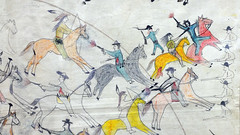
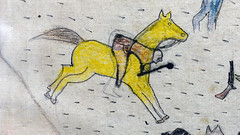
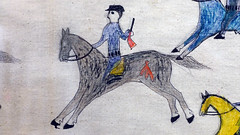
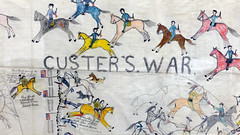
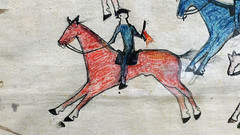
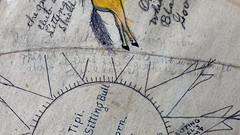
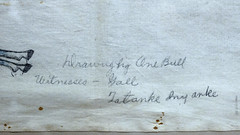
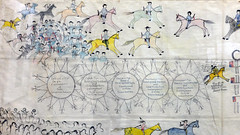
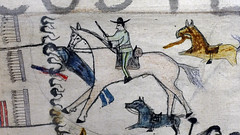
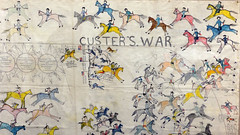
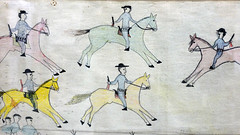

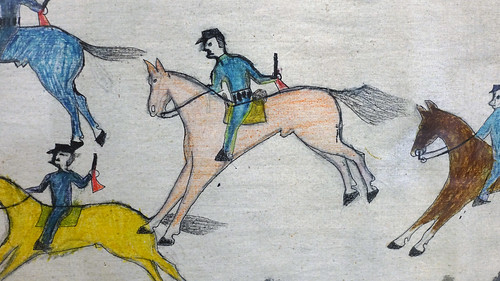
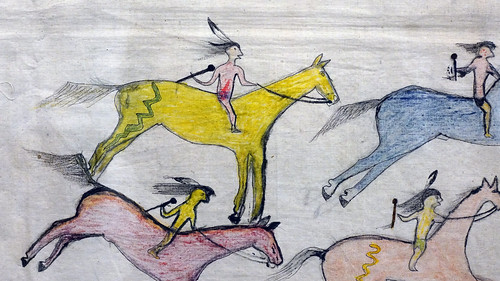
Southwest
Nampeyo (Hopi-Tewa), polychrome jar
by DR. DAVID W. PENNEY, NATIONAL MUSEUM OF THE AMERICAN INDIAN, SMITHSONIAN INSTITUTION and DR. STEVEN ZUCKER
Video \(\PageIndex{7}\): Nampeyo (Hopi-Tewa), polychrome jar, c. 1930s, clay and pigment, 13 x 21 cm (National Museum of the American Indian, Smithsonian Institution), a Seeing America video
Speakers: Dr. David Penney, Associate Director for Museum Scholarship, Exhibitions, and Public Engagement, National Museum of the American Indian and Dr. Steven Zucker
Additional resources
SmartHistory images for teaching and learning:
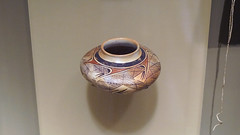

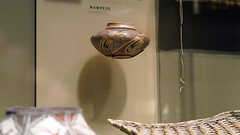
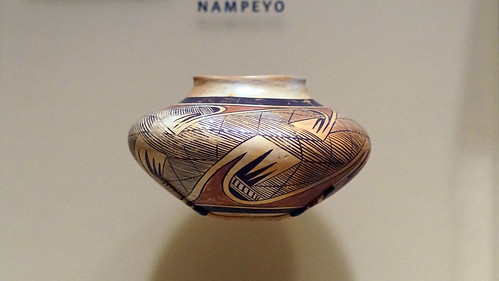
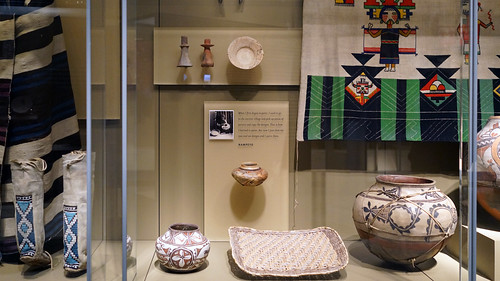
Puebloan: Maria Martinez, Black-on-black ceramic vessel
Born Maria Antonia Montoya, Maria Martinez became one of the best-known Native potters of the twentieth century due to her excellence as a ceramist and her connections with a larger, predominantly non-Native audience. Though she lived at the Pueblo of San Ildefonso, about 20 miles north of Santa Fe, New Mexico, from her birth in 1887 until her death in 1980, her work and her life had a wide reaching importance to the Native art world by reframing Native ceramics as a fine art. Before the arrival of the railroad to the area in the 1880s, pots were used in the Pueblos for food storage, cooking, and ceremonies. But with inexpensive pots appearing along the rail line, these practices were in decline. By the 1910s, Ms. Martinez found a way to continue the art by selling her pots to a non-Native audience where they were purchased as something beautiful to look at rather than as utilitarian objects.

Her mastery as a ceramist was noted in her village while she was still young. She learned the ceramic techniques that were used in the Southwest for several millennia by watching potters from San Ildefonso, especially her aunt Nicholasa as well as potters (including Margaret Tafoya from Santa Clara), from other nearby Pueblos. All the raw materials had to be gathered and processed carefully or the final vessel would not fire properly. The clay was found locally. To make the pottery stronger it had to be mixed with a temper made from sherds of broken pots that had been pounded into a powder or volcanic ash. When mixed with water, the elasticity of the clay and the strength of the temper could be formed into different shapes, including a rounded pot (known as an olla) or a flat plate, using only the artist’s hands as the potting wheel was not used. The dried vessel needed to be scraped, sanded, smoothed, then covered with a slip (a thin solution of clay and water). The slip was polished by rubbing a smooth stone over the surface to flatten the clay and create a shiny finish—a difficult and time-consuming process. Over the polished slip the pot was covered with designs painted with an iron-rich solution using either pulverized iron ore or a reduction of wild plants called guaco. These would be dried but required a high temperature firing to change the brittle clay to hard ceramics. Even without kilns, the ceramists were able to create a fire hot enough to transform the pot by using manure.

Making ceramics in the Pueblo was considered a communal activity, where different steps in the process were often shared. The potters helped each other with the arduous tasks such as mixing the paints and polishing the slip. Ms. Martinez would form the perfectly symmetrical vessels by hand and leave the decorating to others. Throughout her career, she worked with different family members, including her husband Julian, her son Adam and his wife Santana, and her son Popovi Da. As the pots moved into a fine art market, Ms. Martinez was encouraged to sign her name on the bottom of her pots. Though this denied the communal nature of the art, she began to do so as it resulted in more money per pot. To help other potters in the Pueblo, Ms. Martinez was known to have signed the pots of others, lending her name to help the community. Helping her Pueblo was of paramount importance to Ms. Martinez. She lived as a proper Pueblo woman, avoiding self-aggrandizement and insisting to scholars that she was just a wife and mother even as her reputation in the outside world increased.

Maria and Julian Martinez pioneered a style of applying a matte-black design over polished-black. Similar to the pot pictured here, the design was based on pottery sherds found on an Ancestral Pueblo dig site dating to the twelfth to seventeenth centuries at what is now known as Bandelier National Monument. The Martinezes worked at the site, with Julian helping the archaeologists at the dig and Maria helping at the campsite. Julian Martinez spent time drawing and painting the designs found on the walls and on the sherds of pottery into his notebooks, designs he later recreated on pots. In the 1910s, Maria and Julian worked together to recreate the black-on-black ware they found at the dig, experimenting with clay from different areas and using different firing techniques. Taking a cue from Santa Clara pots, they discovered that smothering the fire with powdered manure removed the oxygen while retaining the heat and resulted in a pot that was blackened. This resulted in a pot that was less hard and not entirely watertight, which worked for the new market that prized decorative use over utilitarian value. The areas that were burnished had a shiny black surface and the areas painted with guaco were matte designs based on natural phenomena, such as rain clouds, bird feathers, rows of planted corn, and the flow of rivers.
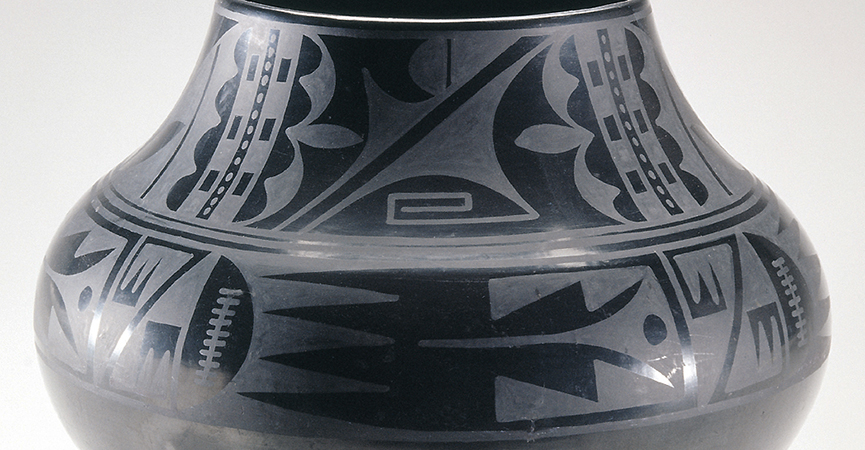
The olla pictured above features two design bands, one across the widest part of the pot and the other around the neck. The elements inside are abstract but suggest a bird in flight with rain clouds above, perhaps a prayer for rain that could be flown up to the sky. These designs are exaggerated due to the low rounded shapes of the pot, which are bulbous around the shoulder then narrow at the top. The shape, color, and designs fit the contemporary Art Deco movement, which was popular between the two World Wars and emphasized bold, geometric forms and colors. With its dramatic shape and the high polish of surface, this pot exemplifies Maria Martinez’s skill in transforming a utilitarian object into a fine art.
The work of Maria Martinez marks an important point in the long history of Pueblo pottery. Ceramics from the Southwest trace a connection from the Ancestral Pueblo to the modern Pueblo eras. Given the absence of written records, tracing the changes in the shapes, materials, and designs on the long-lasting sherds found across the area allow scholars to see connections and innovations. Maria Martinez brought the distinctive Pueblo style into a wider context, allowing Native and non-Native audiences to appreciate the art form.
Additional resources:
This pot at the National Museum of Women in the Arts
The Art, Life and Legacy of Maria Martinez
Maria Martinez Pottery – San Ildefonso Pueblo
Maria Martinez (Through the Eyes of the Pot: A study of Southwest Pueblo Pottery and Culture)
Maria Martinez: Indian Pottery of San Ildefonso (documentary video, 1972)
R. L. Bunzel, The Pueblo Potter: A Study of Creative Imagination in Primitive Art (Dover Publications, 1929).
Hazel Hyde, Maria Making Pottery: The Story of Famous American Indian Potter Maria Martinez (Sunstone Press, 1992).
Alice Marriott, Maria: The Potter of San Ildefonso (University of Oklahoma Press, 1987).
Susan Peterson and Francis H. Harlow, The Living Tradition of Maria Martinez (Kodansha, 1992).
—–, Pottery by American Indian Women: The Legacy of Generations (Abbeville Press, 1997).
Richard Spivey,The Legacy of Maria Poveka Martinez (Museum of New Mexico Press, 2003).
Stephen Trimble, Talking with the Clay: The Art of Pueblo Pottery in the 21st Century (School of American Research Press, 2007).
Julian Martinez, Buffalo Dancers
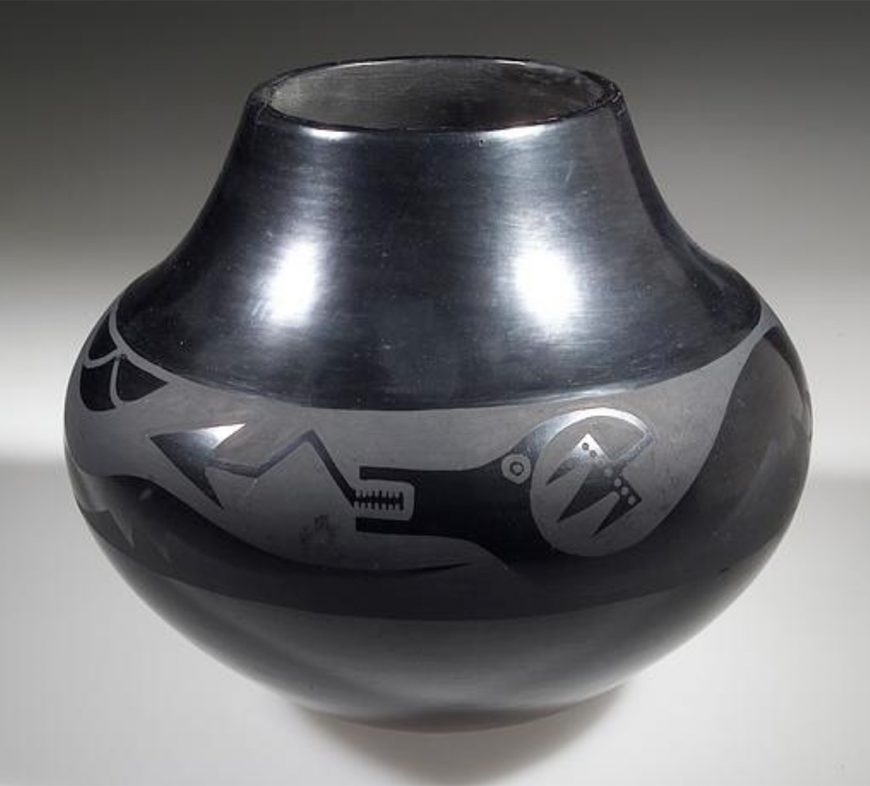
Famous Pueblo pottery
As an artist, Julian Martínez from San Ildefonso Pueblo is best known for the ceramics he made with his wife, Maria Martínez. Together, they produced the matte-black on polished-black pottery for which they and their Pueblo colleagues gained international fame.
Maria formed the pots into elegant shapes and Julian painted the designs, both geometric and figurative, including historic motifs such as the feather pattern from Mimbres pottery and the avanyu, the horned serpent similar the Mesoamerican deity Quetzalcoatl.
Julian Martínez also worked at the Museum of New Mexico, where he took advantage of the opportunity to study the Museum’s collection of Southwestern pottery, and he learned more during the summers when he worked at the field school at the Pajarito Plateau (later renamed Bandelier National Monument). In addition to his work on pottery, Martínez drew on paper; he always kept a notebook where he sketched ideas and recorded what he had seen. Though most of his images were painted on paper, he created a few murals on walls and, on rare occasions, he painted on hide, as he did for his Buffalo Dancers from about 1930, now in the collection of the National Museum of the American Indian in New York City (below).
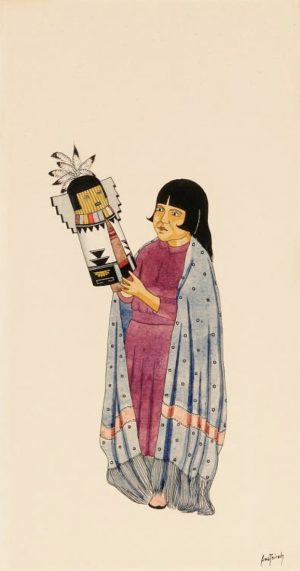
Pueblo painting
Painting has long been part of Pueblo life; it can be found on the walls of the kivas (the round ceremonial structures usually partially underground) and on dance regalia such as wands, tablitas (ceremonial headdresses), clothing, and other items. A thriving art community developed around 1900 during a difficult time in Pueblo history: due to illness and outward migration, the population was reduced to less than 200. When the Atchison Topeka and Santa Fe Railway extended its track to the area in 1880, the economy of the Pueblo was transformed as more outside goods were purchased and more items, especially ceramics and paintings on paper, were made to sell to tourists traveling to the area.
An important group of Pueblo artists called the San Ildefonso Self-Taught Group, active from around 1900 to around 1930, included Julian Martínez, Tonita Peña, Crescencio Martínez, and Awa Tsireh (Alfonso Roybal). Most of their work depicted scenes common to Pueblo life, mainly ceremonial dances and genre scenes.
The Buffalo Dance
Martínez was elected governor of San Ildefonso in 1925 and he served as a leader in ceremonies. Like other Pueblo painters, he refrained from depicting ritual objects, sites, and altars that were considered private, and focused instead on dances that were open to the public. The Buffalo Dance is one of the most commonly represented of all Pueblo dances by the Self-Taught Group. Art historian J.J. Brody described it as one of the most “comprehensible to outsiders of all public ritual dances of the Pueblo people.” [1] Performed annually on January 23rd to honor the Pueblo patron saint, San Ildefonso, the Buffalo Dance enacts a hunting scene, with three dancers playing the roles of a hunter, buffalo, and a buffalo maiden (or buffalo mother) who has the power to induce the animals to sacrifice themselves to provide food and hide.
Early twentieth-century Pueblo paintings by artists including Tsireh, Peña, and Martínez all depict the Buffalo Dance in the same way, with the three figures in profile, facing the same direction as they would be during the dance. The men wear a buffalo headdress and dance kilts with depictions of avanyu (a horned serpent), and their skin is painted black. The buffalo maiden wears an embroidered one-shouldered manta, or dress.
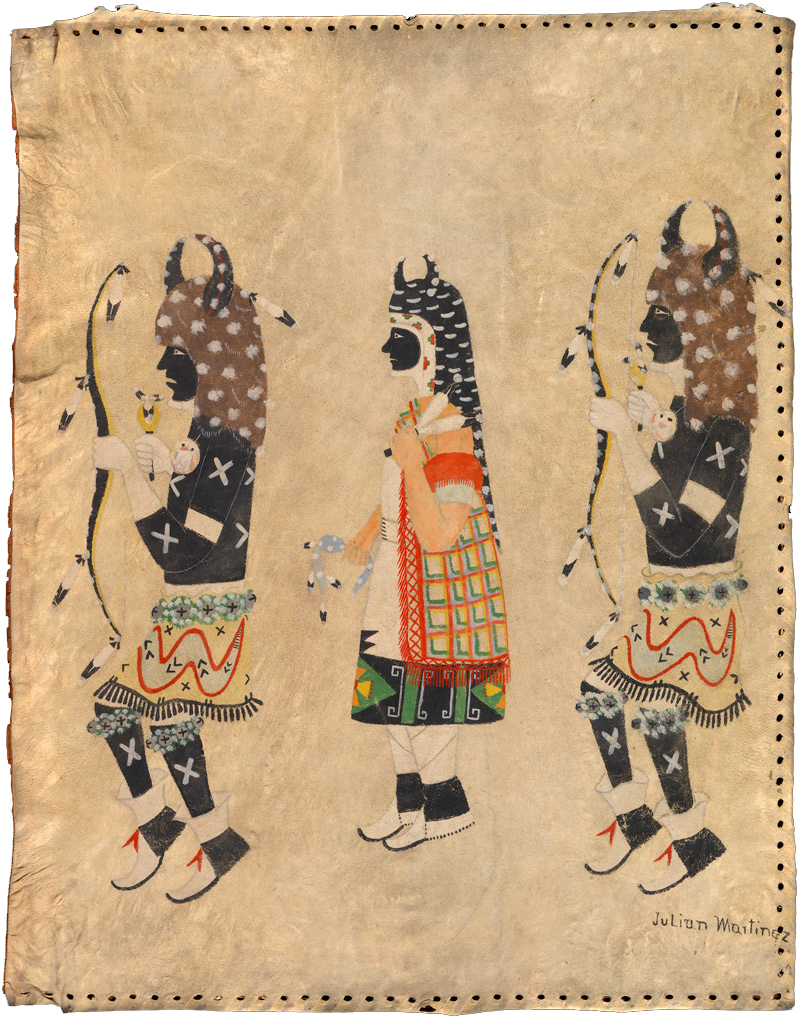
In this hide painting, Martínez gave all three figures the same facial features, focusing instead on varying details in their clothing and regalia. There is no sense of space; the figures lack modeling and do not cast shadows. The flatness of the figures and the lack of a background suggest the influence of early Modernist abstraction. The empty space might also symbolize an area that is sacred—unbound by place or time. Paintings of such dances might even portray a space where the viewers themselves also participate in the dance, because, as anthropologist Alfonso Ortiz from Ohkay Owingeh Pueblo has observed, everyone in the community dances in ceremonies.[2]
Though Martínez painted several versions of the Buffalo Dance, the NMAI version is unusual for its material: animal hide. More commonly used in art from the Plains, hide is stronger and suppler than paper as a base. This particular hide has small holes on along three of its sides, suggesting that it was used to cover a portfolio or large book, with a string or leather cord run through the holes to attach it over a group of drawings.[3] Later, the image may have been unlaced and cut along one side, accounting for the smooth edge.
Pueblo painting continues
With its bright colors and strong forms, Julian Martínez’s Buffalo Dancers exemplifies the early period of Pueblo painting. In 1932, the Santa Fe Indian School (whose painting program became known as “The Studio School”) started teaching art, and developed the Santa Fe Indian School Style. This new style retained the earlier emphasis on dance and genre scenes with the same flatness and lack of modeling, but the work became more decorative and lost the intimacy of the earlier works.
During Martínez’s his life, local artists, anthropologists, and ethnographers expressed their appreciation for his work, noting his radiant colors, technical skill, and mastery of form. Martínez’s Buffalo Dancers, like other paintings produced by the San Ildefonso Self-Taught Group, conveys a sense of movement and energy in its figures and shares the joy of the ceremonies.
[1] J.J. Brody, Pueblo Indian Painting: Tradition and Modernism in New Mexico (School for Advanced Research Press, 1997).
[2] Alfonzo Ortiz, The Tewa World: Space, Time, Being and Becoming in a Pueblo Society (Chicago, Illinois: The University of Chicago Press, 1969).
[3] I am indebted to Dr. Jonathon Batkin and Dr. Bruce Bernstein for sharing this idea.
Additional resources:
This work in the Infinity of Nations exhibition at the National Museum of the American Indian
Claremont Colleges Digital Library, “Pueblo and Plains Indian Watercolors.”
Mimbres Pottery (from the Smithsonian)
Anthes, Bill. Native Moderns: American Indian Painting, 1940–1960. (Chapel Hill, North Carolina: Duke University Press, 2006).
Bruce Bernstein, and Jackson Rushing. Modern by Tradition: American Indian Painting in the Studio Style. (Santa Fe, New Mexico: Museum of New Mexico Press, 1995).
J.J. Brody, Pueblo Indian Painting: Tradition and Modernism in New Mexico, 1900-1930. (Santa Fe, New Mexico: School of Advanced Research Press, 1997).
—. Anasazi and Pueblo Painting. (Albuquerque, New Mexico: University of New Mexico Press, 1991).
—. Indian Painters and White Patrons. (Albuquerque, New Mexico: University of New Mexico Press, 1971).
Ruth Bunzel, The Pueblo Potter: A Study of Creative Imagination in Primitive Art. (1911) (Mineola, New York: Dover Publications, 1972).
Ina Sizer Cassidy, Art and Artists of New Mexico. (Bureau of Publications, State of New Mexico, 1943).
Katherin L Chase, Indian Painters of the Southwest: The Deep Remembering. (Santa Fe, New Mexico: School of Advanced Research, 2002).
Dorothy Dunn, .American Indian Painting of the Southwest and Plains Area. (Albuquerque, New Mexico: University of New Mexico Press, 1968).
—. “The Studio: 1932-1937: Fostering Indian Art as Art,” El Palacio vol. 83, no. 4, pp. 5-9.
Aaron Fry, “Local Knowledge and Art Historical Methodology: A New Perspective on Awa Tsireh and the San Ildefonso Easel Painting Movement,” Hemispheres: Visual Cultures of the Americas 1 (Spring, 2008): pp. 46-61.
Jessica Horton and Janet Catherine Berlo, “Pueblo Painting in 1932: Folding Narratives of Native Art into American Art History,” in John Davis, Jennifer A. Greenhill, and Jason D. LaFountain, editors, A Companion to American Art. (John Wiley & Sons, Inc., 2015).
Alice Marriott, Maria: The Potter of San Ildefonso (1948) (Norman, Oklahoma: University of Oklahoma Press, 1987).
Elizabeth A Newsome, “Reflexivity and Subjectivity in Early Native American Painting: A Critique of Perspectives on the Traditional Style,” American Indian Culture and Research Journal 25:3 (2001), pp.103-142.
Alfonzo Ortiz, The Tewa World: Space, Time, Being and Becoming in a Pueblo Society (Chicago, Illinois: The University of Chicago Press, 1969).
—, “Dual Organization as an Operational Concept in the Pueblo Southwest,” Ethnology, vol. 4, No. 4. (October 1965), pp. 389-396.
David W Penney. and Lisa Roberts. “America’s Pueblo Artists: Encounters on the Borderlands,” in W. Jackson Rushing III, editor, Native American Art in the Twentieth Century. (London: Routledge Press, 1999).
Susan Peterson, Living Tradition of Maria Martinez. First published in 1977. (Tokyo, Japan: Kodansha International, 1989).
—. Pottery by American Indian Women: The Legacy of Generations. (New York, New York: Abbeville Press, 1997).
Rushing, W. Jackson, and Allan Houser. Allan Houser: An American Master (Chiricahua Apache, 1914-1994). (New York, New York: H.N. Abrams, 2004).
W. Jackson, Rushing, Native American Art in the Twentieth Century. (London: Routledge Press, 1999).
Sasha T. Scott, A Strange Mixture: The Art and Politics of Painting Pueblo Indians. (Norman, Oklahoma: University of Oklahoma Press, 2015).
Tryntje Van Ness Seymour, When the Rainbow Touches Down: The Artists and Stories Behind the Apache, Navajo, Rio Grande Pueblo, and Hopi Paintings in the William and Leslie Van Ness Denman Collection. (Phoenix, Arizona: Heard Museum, 1988).
Julie Solometo, “The Context and Process of Pueblo Mural Painting in the Historic Era,” Kiva vol. 76, no. 1 (2010), pp. 83-116.
Richard Spivey The Legacy of Maria Poveka Martinez. (Santa Fe, New Mexico: Museum of New Mexico Press, 2003).
R. Strickland, “Where Have All the Blue Deer Gone? Depth and Diversity in Post War Indian Painting,” American Indian Art Magazine v. 10 (Spring 1985), pp. 36-45
Jill Drayson Sweet, Dances of the Tewa Pueblo Indians: Expressions of new life. (Santa Fe, New Mexico: School for Advanced Research on the, 2004).
Clara Lee Tanner, Southwest Indian Painting: A Changing Art. (Tucson, Arizona: University of Arizona Press, 1971).
Sharyn Rohlfsen Udall, Contested Terrain: Myth and Meanings in Southwest Art. (Albuquerque, New Mexico: University of New Mexico Press, 1996).
Edwin L. Wade, “Straddling the Cultural Fence: The Conflict for Ethnic Artists within Pueblo Societies,” in The Arts of the North American Indian: Native Traditions in Evolution, ed. Edwin L. Wade (New York, New York: Hudson Hills Press, 1986), pp. 243-254.
The pueblo modernism of Ma Pe Wi
by DR. ADRIANA GRECI GREEN and DR. BETH HARRIS
Video \(\PageIndex{8}\): Velino Shije Herrera (Ma Pe Wi), <em>Design, Tree and Birds</em>, c. 1930, watercolor on paper, 25.25 x 17.75 inches (Newark Museum of Art, Gift of Amelia Elizabeth White, 1937, 37.216). Speakers: Dr. Adriana Greci Green and Dr. Beth Harris
Test your knowledge with a quiz
Key points
- In the early 20th century, there was new interest in Pueblo art and culture from modernist artists and the growing tourist industry. This came at a time when Indian Schools endangered Native American cultural traditions in an effort by the U.S. government to eliminate Native American ways of life and replace them with mainstream American culture.
- Beginning in 1918, informal painting classes were offered at the Santa Fe Indian School, and Velino Shije Herrera, along with fellow artists Awa Tsireh and Fred Kabotie, developed a genre of watercolor painting on paper that connected European styles with indigenous traditions of painting. Works like Design, Tree and Birds blended traditional symbolism and forms, with elements of modernist painting to create a hybrid for non-native audiences.
- As modernist Pueblo painting grew in popularity, some of its supporters also worked to protect the rights of the Puebloan peoples, supporting organizations like The Indian Rights Association, which helped raise awareness about the devastation created through government policies and practices.
Go deeper
This work of art at the Newark Museum
The Modernist-Inspired Watercolors of a Pioneering Pueblo Painter
The legacy of Indian Schools, at NPR
See Pueblo pottery painting from the 1930s
Explore primary sources on government policies towards Native Americans in the early 20th century
Learn more about the Indian Rights Association
Velino Shije Herrera at the Smithsonian American Art Museum
More to think about
Modern Native American artists like Clarissa Rizal and Jamie Okuma have blended their native traditions with contemporary style or meaning. What makes a work of art “traditional”? What other examples can you think of where an artist has blended their own culture with mainstream forms or techniques?
Northwest coast
Ceremonial belt (Kwakwaka’wakw)
by DR. AARON GLASS and DR. STEVEN ZUCKER
Video \(\PageIndex{9}\): Ceremonial belt (Kwakwaka’wakw), late 19th century, wood, cotton, paint, and iron (Field Museum, Chicago), an ARCHES video. Special thanks to Aaron Glass, the Bard Graduate Center, the U’mista Cultural Centre, and Corrine Hunt
Transformation masks
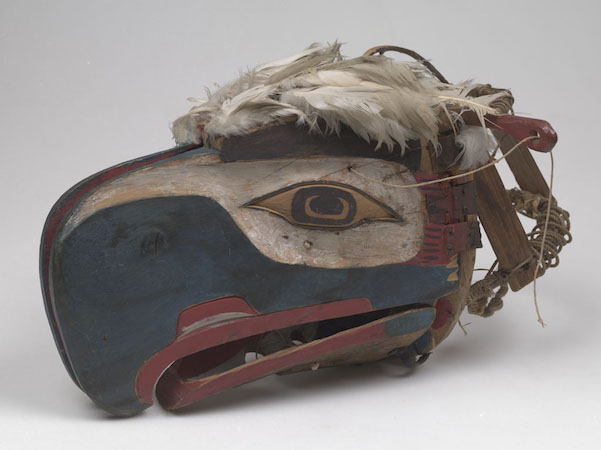
Transformation
Imagine a man standing before a large fire wearing the heavy eagle mask shown above and a long cedar bark costume on his body. He begins to dance, the firelight flickers and the feathers rustle as he moves about the room in front of hundreds of people. Now, imagine him pulling the string that opens the mask, he is transformed into something else entirely—what a powerful and dramatic moment!
Northwest Coast transformation masks manifest transformation, usually an animal changing into a mythical being or one animal becoming another. Masks are worn by dancers during ceremonies, they pull strings to open and move the mask—in effect, animating it. In the Eagle mask shown above from the collection of the American Museum of Natural History, you can see the wooden frame and netting that held the mask on the dancer’s head. When the cords are pulled, the eagle’s face and beak split down the center, and the bottom of the beak opens downwards, giving the impression of a bird spreading its wings (see image below). Transformed, the mask reveals the face of an ancestor.

A Transformation Mask at the Brooklyn Museum (below) shows a Thunderbird, but when opened it reveals a human face flanked on either side by two lightning snakes called sisiutl, and with another bird below it and a small figure in black above it.


A whale transformation mask, such as the one in the Metropolitan Museum of Art (below), gives the impression that the whale is swimming. The mouth opens and closes, the tail moves upwards and downwards, and the flippers extend outwards but also retract inwards.

Transformation masks, like those belonging to the Kwakwaka’wakw (pronounced Kwak-wak-ah-wak, a Pacific Northwest Coast indigenous people) and illustrated here, are worn during a potlatch, a ceremony where the host displayed his status, in part by giving away gifts to those in attendance. These masks were only one part of a costume that also included a cloak made of red cedar bark. During a potlatch, Kwakwaka’wakw dancers perform wearing the mask and costume. The masks conveyed social position (only those with a certain status could wear them) and also helped to portray a family’s genealogy by displaying (family) crest symbols.
The Kwakwaka’wakw
Masks are not the same across the First Nations of the Northwest Coastal areas; here we focus solely on Kwakwaka’wakw transformation masks.
The Kwakwaka’wakw (“Kwak’wala speaking tribes”) are generally called Kwakiutl by non-Native peoples. They are one of many indigenous groups that live on the western coast of British Columbia, Canada. The mythology and cosmology of different Kwakwaka’wakw Nations (such as the Kwagu’ł (Kwakiutl) or ‘Namgis) is extremely diverse, although there are commonalities. For instance, many groups relate that deceased ancestors roamed the world, transforming themselves in the process (this might entail removing their animal skins or masks to reveal their human selves within).
Kwakwaka’wakw bands are arranged into four clans (Killer Whale, Eagle, Raven, and Wolf clans). The clans are divided into numayn (or ‘na’mina), which can be loosely translated as “group of fellows of the same kind” (essentially groups that shared a common ancestor). Numayns were responsible for safe-guarding crest symbols and for conveying their specific rights—which might include access to natural resources (like salmon fishing areas) and rights to sacred names and dances that related to a numayn’s ancestor or the group’s origins. The numayn were ranked, and typically only one person could fill a spot at any given moment in time. Each rank entailed specific rights, including ceremonial privileges—like the right to wear a mask such as the Brooklyn Museum’s Thunderbird transformation mask. Animal transformation masks contained crests for a given numayn. Ancestral entities and supernatural forces temporarily embody dancers wearing these masks and other ceremonial regalia.
Animals and myths
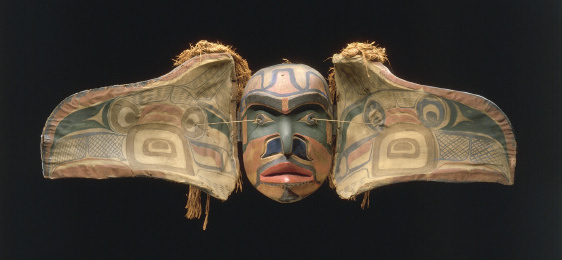
Many myths relate moments of transformation often involving trickster supernaturals (a trickster is a god, goddess, spirit, man, woman, or anthropomorphic animal who exhibits a great degree of intellect or secret knowledge and uses it to play tricks or otherwise disobey normal rules and conventional behavior). Raven, for instance, is known as a consummate trickster—he often changes into other creatures, and helps humans by providing them with a variety of useful things such as the sun, moon, fire, and salmon. Thunderbird (Kwankwanxwalige’), who was a mythical ancestor of the Kwakwaka’wakw, also figures prominently in mythology. He is believed to cause thunder when he beats his wings, and lightning comes from his eyes. He lives in the celestial realm, and he can remove his bird skin to assume human form.
Design and materials
The masks illustrated here display a variety of brightly colored surfaces filled with complex forms. These masks use elements of the formline style, a term coined in 1965 to describe the characteristics of Northwest Coast visual culture. The Brooklyn Museum mask provides a clear example of what constitutes the formline style. For instance, The Brooklyn Museum mask (when open) displays a color palette of mostly red, blue-green, and black, which is consistent with other formline objects like a Tlingit Raven Screen (a house partition screen) attributed to Kadyisdu.axch’ (detail below). The masks, whether opened or closed, are bilaterally symmetrical. Typical of the formline style is the use of an undulating, calligraphic line. Also, note how the pupils of the eyes on the exterior of the Brooklyn Museum mask are ovoid shapes, similar to the figures and forms found on the interior surfaces of many masks. This ovoid shape, along with s- and u-forms, are common features of the formline style.

The American Museum of Natural History and Brooklyn Museum masks are carved of red cedar wood, an important and common material used for many Northwest Coast objects and buildings. Masks take months, sometimes years, to create. Because they are made of wood and other organic materials that quickly decay, most masks date to the nineteenth and twentieth centuries (even though we know that the practice extends much farther into the past). In fact, the artistic style of many transformation masks it thought to have emerged over a thousand years ago.
With the introduction and enforcement of Christianity and as a result of colonization in the nineteenth century, masking practices changed among peoples of the Northwest Coast. Prior to contact with Russians, Europeans, and Euro-Americans, masks like the Brooklyn Museum’s Thunderbird Transformation Mask, were not carved using metal tools. After iron tools were introduced along with other materials and equipment, masks demonstrate different carving techniques. Earlier masks used natural (plant and mineral based) pigments, post-contact, brighter and more durable synthetic colors were introduced. The open mask from the American Museum of Natural History, for example, displays bright red, yellow, and blue.
Ceremonies and potlatches
Masks passed between family members of a specific clan (they could be inherited or gifted). They were just one sign of a person’s status and rank, which were important to demonstrate within Kwakwaka’wakw society—especially during a potlatch. Franz Boas, an anthropologist who worked in this area between 1885 and 1930, noted that “The acquisition of a high position and the maintenance of its dignity require correct marriages and wealth—wealth accumulated by industry and by loaning out property at interest—dissipated at the proper time, albeit with the understanding that each recipient of a gift has to return it with interest at a time when he is dissipating his wealth. This is the general principle underlying the potlatch….”¹

Potlatches were banned in 1885 until the 1950s because they were considered immoral by Christian missionaries who believed cannibalism occurred (for its part, the Canadian Government thought potlatches hindered economic development because people ceased work during these ritual celebrations). With the prohibition of potlatches, many masks were confiscated. Those that weren’t destroyed often made their way into museums or private collections. When the ban against potlatches was removed by the Canadian government, many First Nations have attempted to regain possession of the masks and other objects that had been taken from them. Potlatches are still practiced today among Northwest Coast peoples.
Editor Note: In the United States, it is more common to see the term “Native American,” “Native,” or “Indigenous,” whereas “First Nations” used more frequently in Canada.
1. Franz Boas, Kwakiutl Ethnography (Chicago: University of Chicago Press, 1966), 51. It is important to mention that Boas is a controversial figure for many, especially because of his active acquisition of objects and skeletons belonging to different First Nations. Much of what he collected is today in the American Museum of Natural History in NYC.
Additional resources:
Kwakiutl Ethnography from the Milwaukee Public Museum
American Indian History from the Smithsonian
Repatriation of a British Museum mask (UNESCO)
Whale Transformation Mask at The Metropolitan Museum of Art
Bill Holm, Northwest Coast Indian Art (Seattle: University of Washington Press, 1965).
Alice B. Kehoe, North American Indians: A Comprehensive Account, 2nd ed. (New Jersey: Prentice Hall, 1992).
Bruce Greenville, “Introduction,” in Down from the Shimmering Sky: Masks of the Northwest Coast, Peter Macnair, et al, 14–16 (Vancouver, BC, Seattle: Douglas & McIntyre and University of Washington Press, 1998).
Aldona Jonaitis, Art of the Northwest Coast (Seattle: University of Washington Press, 2006).
Edward Malin, A World of Faces: Masks of the Northwest Coast Indians (Portland, OR: Timber Press, 1978).
Judith Ostrowitz, Privileging the Past: Reconstructing History in Northwest Coast Art (Vancouver, BC: Univdrsity of British Columbia Press, 1999).
Stanley Walens, “‘The Potlatch Era,’” in Kwakiutl, Indians of North America (New York: Chelsea House Publishers, 1992 [Updated 2008]).
SmartHistory images for teaching and learning:
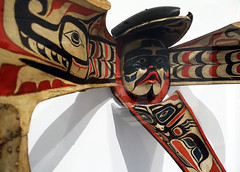
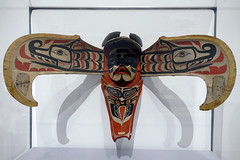
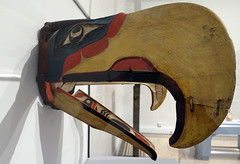
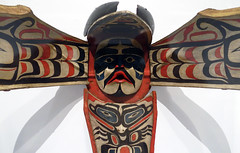
North Wind Mask
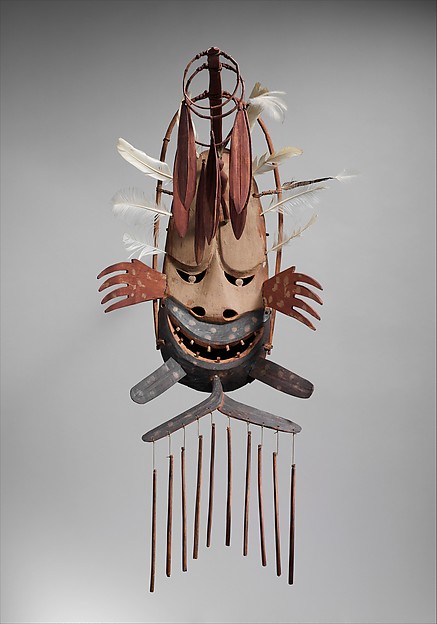
The Bering Sea, on the western coast of Alaska, is home to the Yup’ik peoples. This area has one of the world’s coldest climates, making for very challenging living conditions. Yup’ik men carved and painted masks to occupy them while indoors during the long dark winter months (when temperatures could fall to -48 degrees Fahrenheit).
These masks played important social and ceremonial functions during dances, actively participating in the communal, spiritual life of the Yup’ik. Masked dances celebrated spiritual transformation, but were also intended to herald the coming of springtime or to bring good fortune to an upcoming hunt.
The Yup’ik
The Yup’ik, or Yupik (“Real People”), people come from Alaska (comprised of the Central Yup’ik and the Alutiiq). They are related to other indigenous groups or First Nations including the Inuit in Canada, the Yuiit or Siberian Yupik (also referred to as Chukchi in Siberia) and Iñupiat in Alaska, who have all been incorrectly lumped together as “Eskimos.”
Prior to contact with foreigners (such as Russians, Europeans, and Euro-Americans), the Yup’ik turned to the ocean for their livelihood. They fished and hunted sea mammals, and often moved with the seasons to follow these sources of food. Many Yup’ik communities still live along the Alaskan coast—and continue to draw on these natural resources.
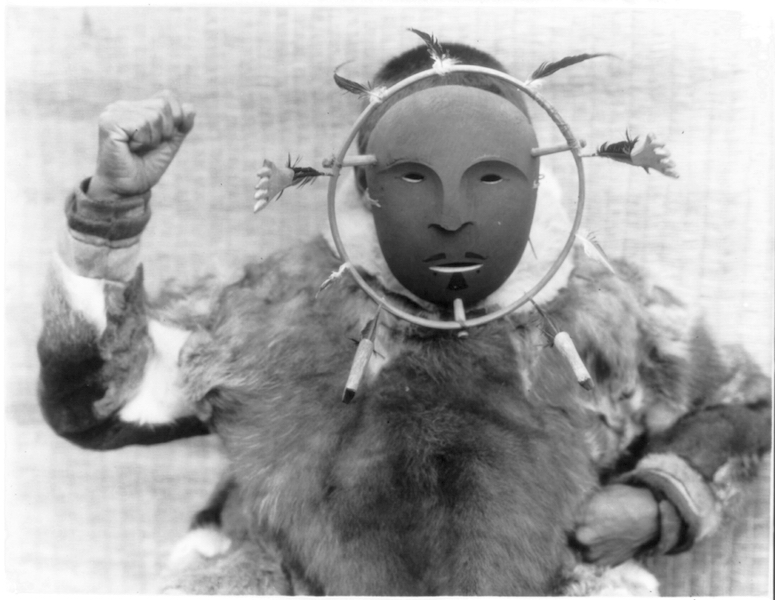
Making Masks
Masking practices formed a vital component of Yup’ik culture. Masks were often made in pairs, and after they were used, the masks were typically discarded or destroyed. Only the most important—often those made and worn by the ritual specialist—might be kept and reused.
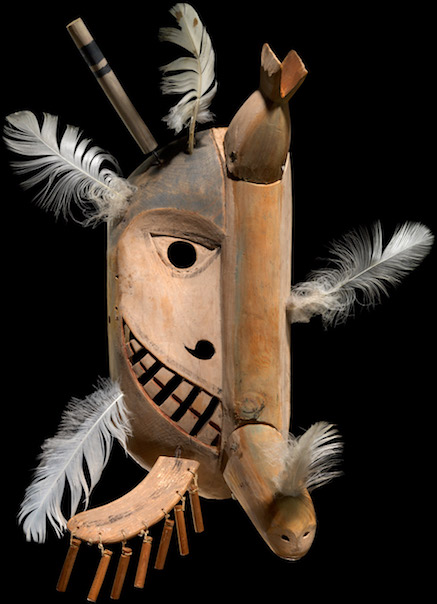
Young men learned to carve by observing their family members producing masks. Ritual or spiritual specialists (frequently referred to today as “shamans”) often oversaw the carving of masks, but artists also added their own touches to them. No two masks were identical, and each had its own story.
Many different materials were used to create Yup’ik masks. In a wonderful, animated mask from around 1910 now in the National Museum of the American Indian in New York (left), a Yupik carver used driftwood, baleen, feathers, paint, and cotton twine to create a mask representing a grinning face.
The Metropolitan Museum of Art’s early twentieth-century mask (image at the top of the page) uses fewer materials—wood, paint, and feathers—and it shows Negakfok, or the North Wind (also called “the spirit that likes cold and stormy weather”). Imagine that when someone participated in a ceremony and wore this mask, the dangling wood pieces collided making noise—evoking not only the movement of wind, but also the noise it makes. The white spots may symbolize snowflakes. It calls to mind the experience of an icy wind whipping up snow—evoking the cold winters of western Alaska.
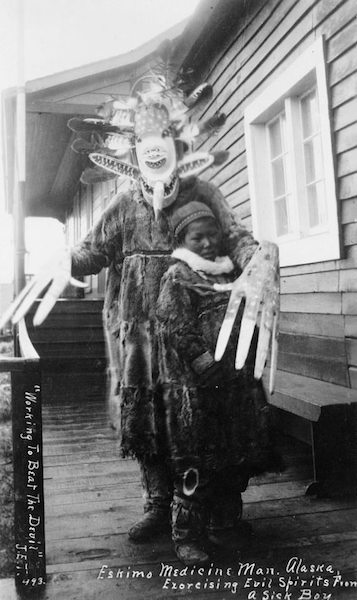
Masking Ceremonies
Making masks and participating in performances helped to forge social bonds and to engage with beings in the spirit world. These beings were not only people, but also animals, and elements of the environment, and sometimes even hybrids. Spirits could be embodied by living creatures as well as objects like hunting tools, so it was crucial to respect the environment in which one lived. During ceremonies, masks transformed the individual wearing it into a spirit made manifest in the material world. This element of transformation is evident in the appearance of many masks that combine animal and human elements with others that relate to the environment. Men typically wore these masks during ceremonies, while women might use finger masks to animate their hands. Ritual specialists usually directed dances and selected which males would be masked participants.
Beyond wearing the masks, hand drums were often used during the dances. Ceremonial clothing further animated dances and worked with the masks to transform an individual into a channel for a spirit. Think of these ceremonies as a form of storytelling, with the music and masked dancing as the primary means of conveying a narrative and making contact with the spirits that aided people living in a challenging natural environment. All of these events, including the carving and painting of masks, occurred in the communal men’s house, called a qasgiq.
Changes in Yup’ik Traditions
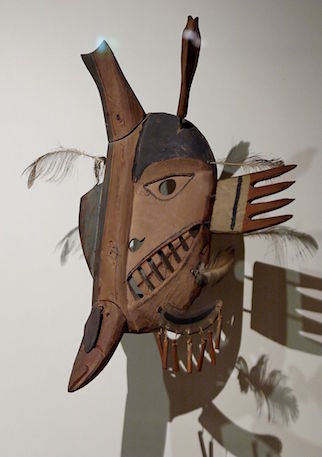
As the Yupik came into contact with Russians, Euro-Americans, and Europeans during the nineteenth century, they began to trade with groups beyond those who lived near by. As a result of increased contact with outsiders in the late nineteenth and early twentieth century however, some Yup’ik lifeways were altered, especially with attempts to Christianize them. One of the major changes that occured was the banning of masked dancing performances.
Masked dances were forbidden when outsiders deemed these rituals an impediment to Christian evangelization. Some masks were confiscated. Other masks entered private collections in the early twentieth century after they were discarded after use.
In the early twentieth century, Surrealist artists and writers collected Yup’ik masks because of their extraordinary appearance and the Surrealist interest in transformation. For instance, Andre Breton, the founder of the Surrealists, was known to have owned masks—finding inspiration in their conceptual nature. Enrico Donati, another surrealist artist, bought a mask in 1945 that recently sold in 2011 for more than two million dollars. Many of these masks were acquired from Julius Carlebach, a dealer in New York City who had sold masks to the Surrealists, and who had himself received many objects from George Gustav Heye whose collection forms the basis for the Museum of the American Indian (located in New York City and Washington, D.C.).
Additional resources:
Negakfok mask at the Metropolitan Museum of Art
Yup’ik Dance Clothes at the National Museum of the American Indian
Yup’ik Mask at the National Museum of the American Indian (NY)
Information about Arctic/Subarctic Peoples from the National Museum of the American Indian
Janet Catherine Berlo and Ruth B Phillips, Native North American Art, 2 ed. (Oxford: Oxford University Press, 2014)
Igor Krupnik, Yupik Transitions: Change and Survival at Bering Strait, 1900–1960 (Fairbanks: University of Alaska Press, 2013)
“Agayuliyararput Our Way of Making Prayer,” Arctic Studies Center of the Smithsonian’s National Museum of Natural History
Contemporary art
Jaune Quick-to-See Smith, Trade (Gifts for Trading Land with White People)
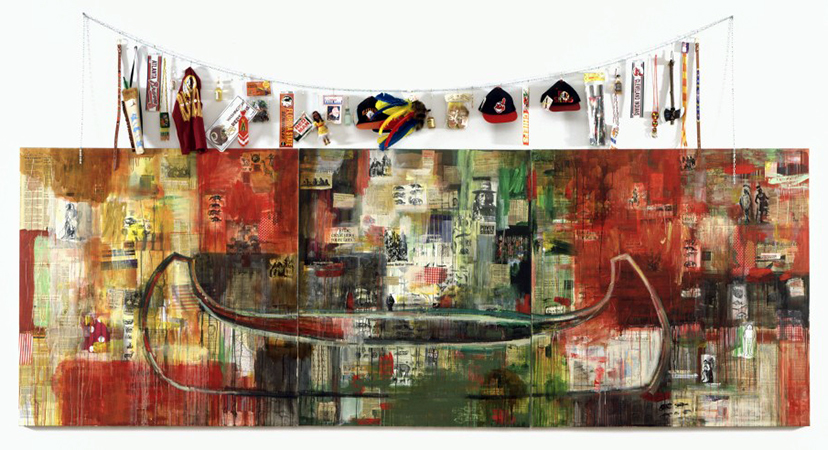
A Non-Celebration
As a response to the 500th anniversary of Christopher Columbus’ arrival in North America in 1992, the artist Jaune Quick-to-See Smith, from the Confederated Salish and Kootenai Tribes of the Flathead Indian Nation, created a large mixed-media canvas called Trade (Gifts for Trading Land with White People). Trade, part of the series “The Quincentenary Non-Celebration,” illustrates historical and contemporary inequities between Native Americans and the United States government.
Trade references the role of trade goods in allegorical stories like the acquisition of the island of Manhattan by Dutch colonists in 1626 from unnamed Native Americans in exchange for goods worth 60 guilders or $24.00. Though more apocryphal than true, this story has become part of American lore, suggesting that Native Americans had been lured off their lands by inexpensive trade goods. The fundamental misunderstanding between the Native and non-Native worlds—especially the notion of private ownership of land—underlies Trade. Smith stated that if Trade could speak, it might say: “Why won’t you consider trading the land we handed over to you for these silly trinkets that so honor us? Sound like a bad deal? Well, that’s the deal you gave us.”1

For Trade, Smith layered images, paint, and objects on the surface of the canvas, suggesting layers of history and complexity. Divided into three large panels, the triptych (three part) arrangement is reminiscent of a medieval altarpiece. Smith covered the canvas in collage, with newspaper articles about Native life cut out from her tribal paper Char-Koosta, photos, comics, tobacco and gum wrappers, fruit carton labels, ads, and pages from comic books, all of which feature stereotypical images of Native Americans. She mixed the collaged text with photos of deer, buffalo, and Native men in historic dress holding pipes with feathers in their hair, and an image of Ken Plenty Horses—a character from one of Smith’s earlier pieces, the Paper Dolls for a Post Columbian World with Ensembles Contributed by US Government from 1991-92.

She applied blocks of white, yellow, green, and especially red paint over the layer of collaged materials. The color red had multiple meanings for Smith, referring to her Native heritage as well as to blood, warfare, anger, and sacrifice. With the emphasis on prominent brushstrokes and the dripping blocks of paint, Smith cited the Abstract Expressionist movement from the 1940s and 50s with raw brushstrokes describing deep emotions and social chaos. For a final layer, she painted the outline of an almost life-sized canoe. Canoes were used by Native Americans as well as non-Native explorers and traders in the eighteenth, nineteenth and early twentieth century to travel along the waterways of North America. The canoe suggests the possibility of trade and cultural connections—though this empty canoe is stuck, unable to move.

Above the canvas, Smith strung a clothesline from which she dangled a variety of Native-themed toys and souvenirs, especially from sports teams with Native American mascots. The items include toy tomahawks, a child’s headdress with brightly dyed feathers, Red Man chewing tobacco, a Washington Redskins cap and license plate, a Florida State Seminoles bumper sticker, a Cleveland Indian pennant and cap, an Atlanta Braves license plate, a beaded belt, a toy quiver with an arrow, and a plastic Indian doll. Smith offers these cheap goods in exchange for the lands that were lost, reversing the historic sale of land for trinkets. These items also serve as reminders of how Native life has been commodified, turning Native cultural objects into cheap items sold without a true understanding of what the original meanings were.
The Artist
The artist was born on January 15, 1940, at the St. Ignatius Jesuit Missionary on the Reservation of the Flathead Nation. Raised by her father, a rodeo rider and horse trader, Smith was one of eleven children. Her first name comes from the French word for “yellow” (jaune), a reminder of her French-Cree ancestors. Her middle name “Quick-to-See” was not a reference to her eyesight but was given by her Shoshone grandmother as a sign of her ability to grasp things readily. From an early age Smith wanted to be an artist; as a child, she had herself photographed while dressed as Henri de Toulouse-Lautrec. Though her father was not literate, education was important to Smith.

She received a bachelor of arts from Framingham State College in Massachusetts in 1976 in art education rather than in studio art because her instructors told her that no woman could have a career as an artist, though they acknowledged that she was more skilled than the men in her class. In 1980 she received a master of fine arts from the University of New Mexico. She was inspired by both Native and non-Native sources, including petroglyphs, Plains ledger art, Diné saddle blankets, early Charles Russell prints of western landscapes, and paintings by twentieth-century artists such as Paul Klee, Joan Miró, Willem DeKooning, Jasper Johns, and especially Kurt Schwitters and Robert Rauschenberg (see image below). Both Schwitters and Rauschenberg brought objects from the quotidian world into their work, such as tickets, cigarette wrappers, and string.
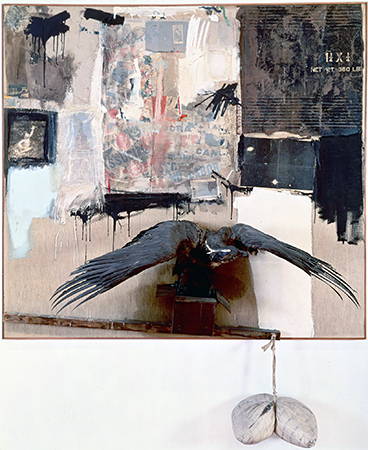
In addition to her work as an artist, Smith has curated over thirty exhibitions to promote and highlight the art of other Native artists. She has also lectured extensively, been an artist-in-residence at numerous universities, and has taught art at the Institute of American Indian Arts in Santa Fe, New Mexico the only four-year university dedicated to teaching Native youth across North America. In her years as an artist, Smith has received many honors, including an Eitelijorg Fellowship in 2007, a grant from the Joan Mitchell Foundation to create a comprehensive archive of her work, a Lifetime Achievement Award from the Women’s Caucus for the Arts, the College Art Association’s Committee on Women in the Arts award, the 2005 New Mexico Governor’s award for excellence in the arts, as well as four honorary doctorate degrees.
Smith’s art shares her view of the world, offering her personal perspective as an artist, a Native American, and a woman. Her work creates a dialogue between the art and its viewers and explores issues of Native identity as it is seen by both Native Americans and non-Natives. Trade (Gifts for Trading Land with White People) restates the standard narratives of the history of the United States, specifically the desire to expand beyond “sea to shining sea,” as encompassed in the ideology of Manifest Destiny (the belief in the destiny of Western expansion), and raises the issue of contemporary inequities that are rooted in colonial experience.
1. Arlene Hirschfelder, Artists and Craftspeople, American Indian Lives, New York: Facts On File, 1994, page 115.
Additional resources:
Jaune Quick-to-See Smith at the Smithsonian American Art Museum
“Smith, Jaune Quick-to-See” in American Indian History Online
Lawrence Abbot, I Stand in the Center of the Good: Interviews with Contemporary Native American Artists, University of Nebraska Press: Lincoln, 1994.
Carolyn Kastner, Jaune Quick-to-See Smith: An American Modernist, University of New Mexico Press: Albuquerque, 2013.
Melanie Herzog, “Building Bridges Across Canada: Jaune Quick-to-See Smith.” School Arts (October 1992): 31–34.
Tricia Hurst, “Crossing Bridges: Jaune Quick-to-See Smith, Helen Hardin, Jean Bales.” Southwest Art, April 1981, 82–91.
Tricia Hurst, ”Jaune Quick-to-See Smith,” January 17–March 14, 1993. Norfolk, Virginia: Chrysler Museum, 1993.
Joni L. Murphy, “Beyond Sweetgrass: The Life and Art of Jaune Quick-To-See Smith.” Ph.D. dissertation. University of Kansas, 2008.
Clarissa Rizal, Resilience Robe
by LILY HOPE AT PORTLAND ART MUSEUM and DR. BETH HARRIS
Video \(\PageIndex{10}\): Clarissa Rizal, Resilience Robe, 2014, merino wool, 64 x 53 inches (Portland Art Museum)
Wendy Red Star, 1880 Crow Peace Delegation
by WENDY RED STAR AT PORTLAND ART MUSEUM and DR. STEVEN ZUCKER
Video \(\PageIndex{11}\): Wendy Red Star, 1880 Crow Peace Delegation: Peelatchiwaaxpáash/Medicine Crow (Raven), Peelatchixaaliash/Old Crow (Raven), Déaxitchish/Pretty Eagle, Bia Eélisaash/Large Stomach Woman (Pregnant Woman) aka Two Belly, Alaxchiiaahush/Many War Achievements or Plenty Coups aka Chíilaphuchissaaleesh/Buffalo Bull Facing The Wind, 2014, 10 inket prints and red ink on paper, 16 15/16 x 11 15/16 inches (each) © Wendy Red Star (Portland Art Museum)
Contemporary Native American Architecture
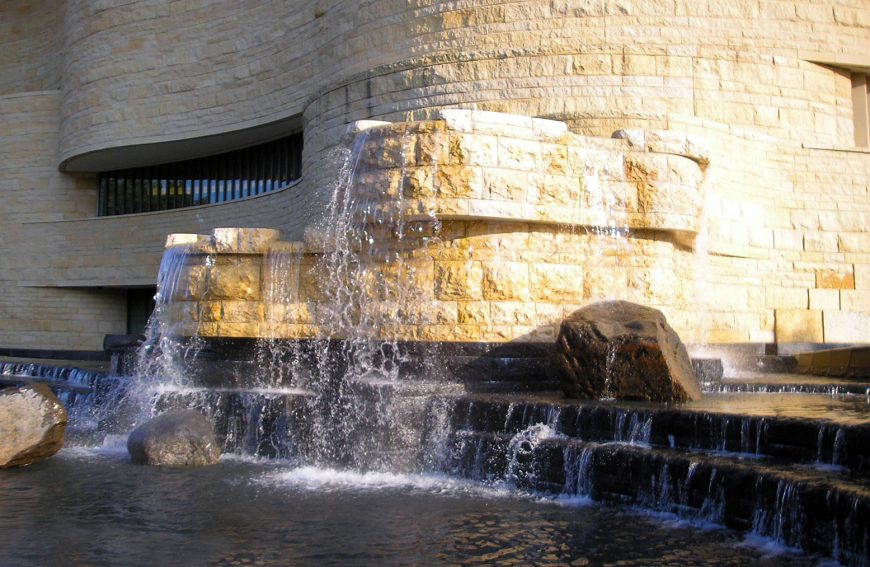 Figure \(\PageIndex{72}\): Fountain (detail), Douglas Cardinal, Louis Weller with GBQC and Polshek Partners, National Museum of the American Indian, Washington, DC, 2004 (photo: Gryffindor)
Figure \(\PageIndex{72}\): Fountain (detail), Douglas Cardinal, Louis Weller with GBQC and Polshek Partners, National Museum of the American Indian, Washington, DC, 2004 (photo: Gryffindor)Design and heritage
You are a member of one of the midwestern nations of Native Americans. Your ancestors had no permanent architecture because they were nomadic hunter-gatherers (see photo below). But now you live on a reservation in South Dakota, or near the Twin Cities in Minnesota. You and your relatives want to establish a cultural center, or a day care, or health clinic for your people.

Do you want it to look like the local museum or clinic (image left) built by the Federal or State government? Probably not, because in the post-modern era since about 1965, various groups have proclaimed their specific ethnic identity. Native Americans now reinforce cultural memory despite the near-eradication of their cultures by European-American governments and individual prejudice. This emphasis is now common among other minority and religious groups that have suffered under dominant cultures here and abroad.
Your native nation will seek an architect perhaps not of Native American ancestry; that will depend upon available talent and sensitivity to your culture, although increasing numbers of Native Americans have studied architecture. You will want the design to suggest something appropriate to your heritage.
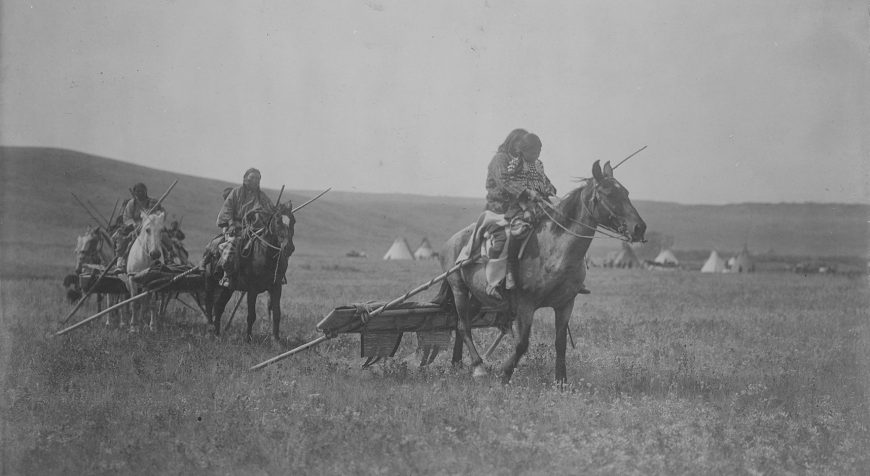
Midwest
In the Midwest, the result might reflect local types of lodges, tipis, and ceremonial buildings of the past, but made of practical and accessible modern materials since an original tipi made of animal hides would be impermanent and lightweight. When the original hides no longer kept out the weather, they were easily replaced with new ones, but people today want durable materials and have time and funds for less frequent maintenance. The tipi has inspired versions in concrete, the Shakopee Mdewakanton Community Hall (1989) by Johnson, Sheldon, Sorensen, in glass, the Southern Ute Cultural Center (2011), by Jones & Jones* (see image below) and in rough stone with wood beams as in the Chief Gall Inn (1972) designed by Harrison Bagg at the Standing Rock Reservation in South Dakota.
The Four Winds School (1983) at Fort Totten on the Spirit Lake Reservation in North Dakota by Charles Archambault, Denby Deegan* and Neil McCaleb,* has the overall round shape of a ceremonial lodge or tipi but in order to accommodate classrooms, a gymnasium and cafeteria, the interior is divided into rooms around a circular core containing a tipi for counseling sessions.
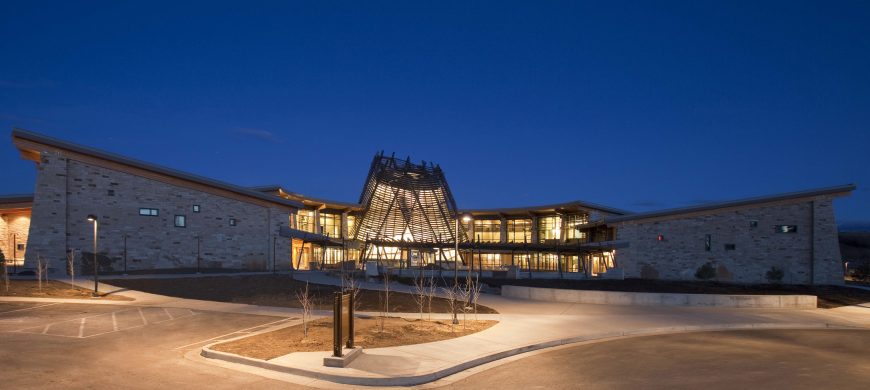
Northwest coast
Along the Northwest coast, the building will probably be a rectangle of logs or milled wood with a pitched roof, evoking ancestral longhouses made from trees in the dense local forests. Retaining the traditional long shape while using some reinforced concrete for the sake of permanence, the Makah nation in Washington State created a cultural center in Neah Bay (1979 by Fred Bassetti architects) that has cedar cladding to harmonize with older buildings on the reservation. The Native American student center at Oregon State University uses logs and the longhouse form to accommodate members of several Native nations, without imitating buildings of one group (image below). The longhouse is a traditional form of architecture for several Native American nations in the coastal Northwest and was built to house extended families and community functions.
At least one individual, Lawrence Joe,* of the Upper Skagit reservation in Washington has built a longhouse (1986) for therapeutic activities intended to accustom delinquent or disturbed youths to better ways of living according to traditional ethical standards. Northeastern forests, too, have provided logs for construction since ancient times, and various wood-covered buildings have been erected there for tribal offices, a student center at Cornell University (1991, by Flynn Battaglia, see detail below), museums and cultural centers. If there is insufficient money for a properly insulated wooden construction, a group may decorate a simpler building made of industrial materials with appropriate historically-based ornament, as in the Takopi Indian Health Center in Tacoma, WA (2002, by Mulvanny G2) or the Seneca-Iroquois National Museum in Salamanca NY (by Lloyd Barnwell,* designs by Carson Waterman*).
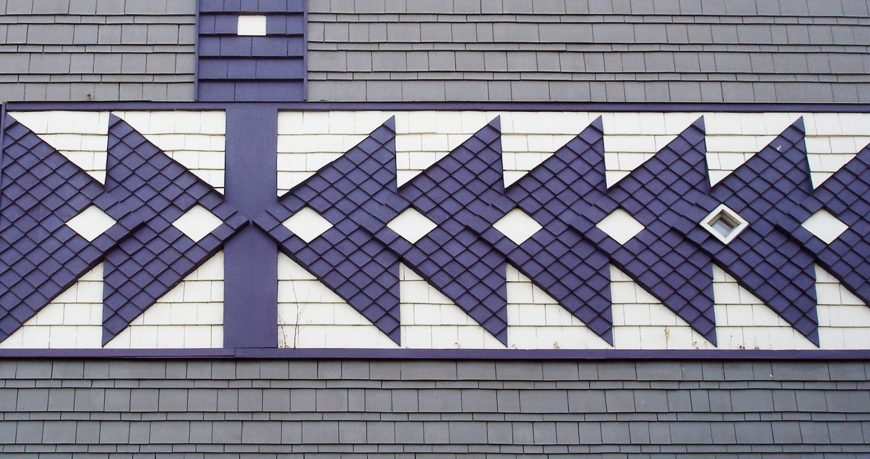
Southwest
In the southwest, a structure might be made of adobe (earthen brick structures made of sand, silt, clay, and straw), with thick walls and small windows to moderate heat during the warm months. Adobe requires frequent maintenance, however, so new buildings are often made of reinforced concrete, a durable material that can be colored to match the local earth of which adobe is composed. The San Felipe Pueblo school in New Mexico (image below) has geometric forms, close to those of an adobe building but with larger windows to admit more natural light and with subtle colors to enhance the appeal of the building to its young users.
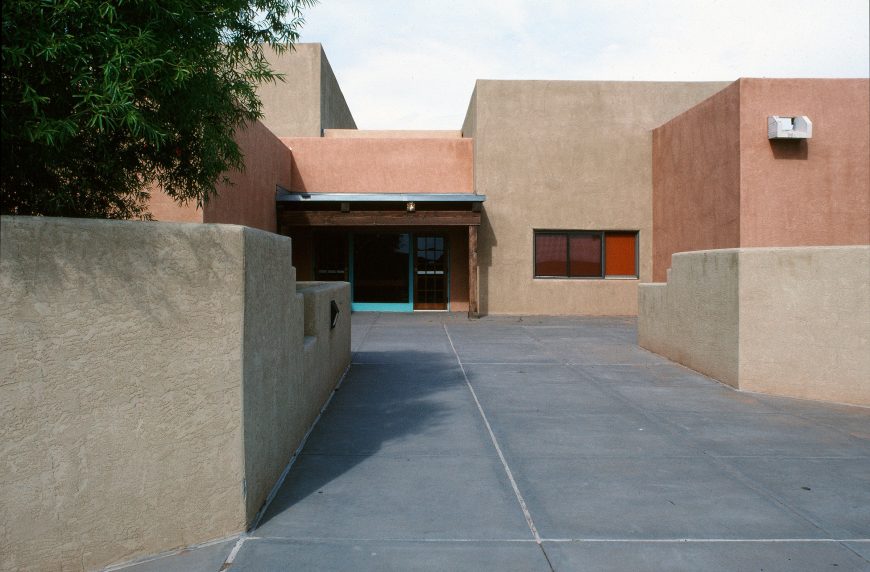
A southwestern building may also be built primarily of other natural materials, such as stone or wood, roughly hewn as the ancestors would have left it. The Pojoaque Pueblo Council Chambers, a seriously impressive building of modest size, is one example. A stone post barely altered from its natural state supports the sapling ceiling of the principal room in a thick-walled adobe structure. The building owes its form to two designers, the pueblo’s own governor, George Rivera* (also a sculptor) and Joel McHorse, Jr., as well as to its own construction organization—rather than to an imported designer. Along the highway entrance to the pueblo, Rivera* also designed a museum and cultural center using the solid, massive geometric forms customary in adobe building (see image below).
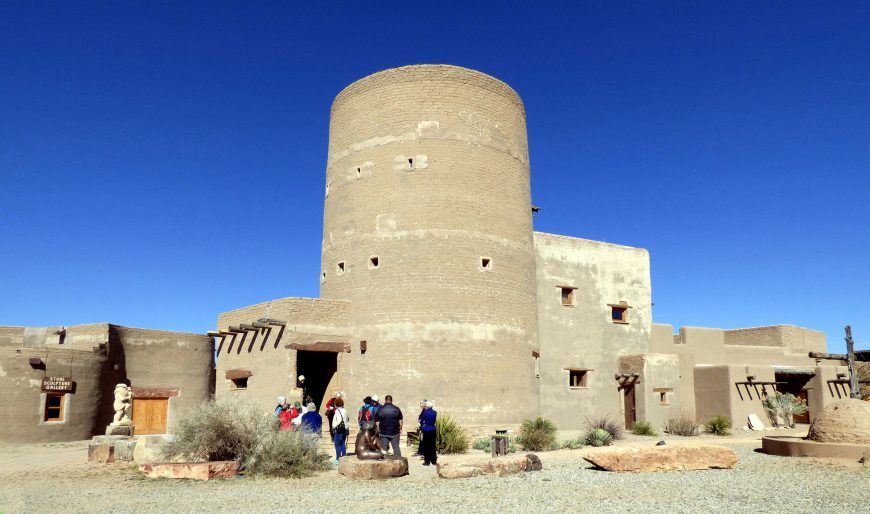
Urban centers
It is less easy to imagine an urban center where members of several native nations come together despite their varied cultural and architectural traditions. Whose culture will dominate? When it is impossible to find a site and funds for a new building, members must rent space in existing buildings that can be decorated inside with art or objects pertinent to the cultures in the area. The Minneapolis American Indian Center is a purpose-built center (see image below). The design connects the inside to nature through large glass windows. Woven wood designs by George Morrison* cover large parts of the outside. A ceremonial circle with stepped seating forms part of the entrance plaza. Inside, events take place below a ramp that replaces stairs or banked seating, to accommodate the customary ways of observing events—in small groups, spaced comfortably apart from one another. This building expresses Native life ways even though it does not imitate an indigenous building type.
Natural forms
Several buildings for Native groups specifically evoke natural forms revered by the members of the nation. The Oneida in Wisconsin built a school with a plan in the form of a turtle (below left), and the same animal, sacred to the Iroquois confederacy, inspired the plan of a now-closed cultural center in Niagara Falls (below right).
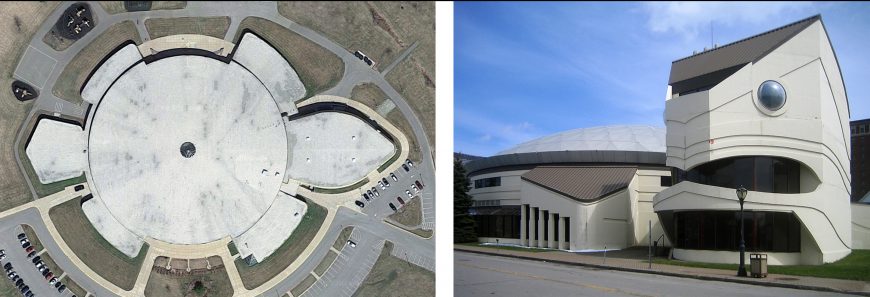
The National Museum of the American Indian in Washington, D.C., opened in 2004, is the result of collaboration, first with Douglas Cardinal* and GBQC, then with a consortium headed by Louis Weller* and Polshek Partners. Donna House,* an ethnobotanist and others also contributed to the result. Unlike smooth white buildings on the Mall, this one has a rough yellow stone surface, and is surrounded by landscaping of only indigenous ornamental or food-yielding plants. The boldly contoured facade confronts the neoclassical design of the Capitol. Inside and out, curving lines dominate because some Native American design participants claimed that these contours were natural and indigenous; they saw rigid straight lines as imports from abroad. A domed rotunda just inside the entrance accommodates ceremonies that can be viewed both at ground level and from surrounding balconies. As a building in the nation’s capital, the Museum reflects its position within the largely neoclassical context of the straight-sided Mall while accommodating various indigenous traditions.
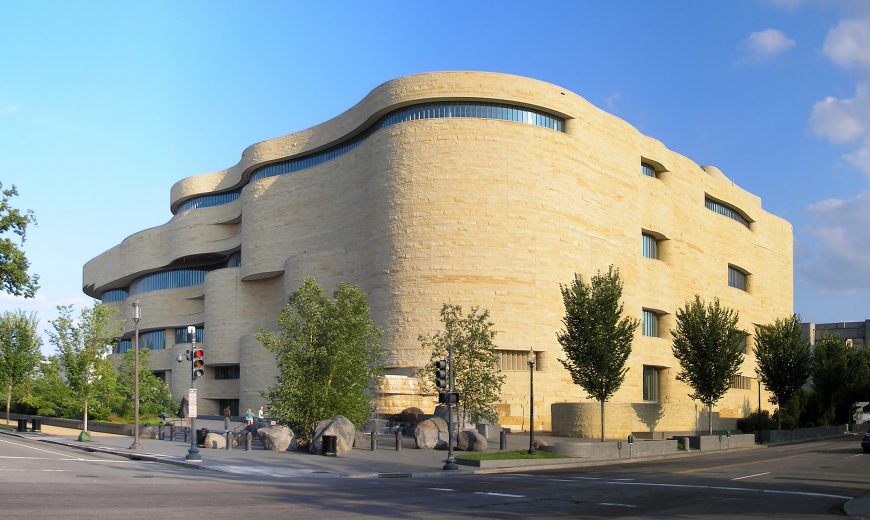
The variety of native traditions, available materials, and architectural expertise has therefore given our continent new and culturally sensitive architectural forms during the last two generations.
*denotes Native American ancestry
Additional resources
Carol Herselle Krinsky, Contemporary Native American Architecture, New York, Oxford University Press, 1996
Joy Monice Malnar and Frank Vodvarka, New Architecture on Indigenous Lands, Minneapolis, University of Minnesota Press, 2013
Peter Nabokov and Robert Easton, Native American Architecture, New York, Oxford University Press, 1990
New Spain (Spanish colonies)
New Spain consisted of Mexico, much of Central America, parts of the West Indies, from California to Florida, and the Philippines.
c. 1521–1821 C.E.
A beginner's guide
New Spain, an introduction
by DR. LAUREN KILROY-EWBANK and DR. STEVEN ZUCKER
Video \(\PageIndex{12}\): An introduction to the Viceroyalty of New Spain
Prints and Printmakers in Colonial New Spain
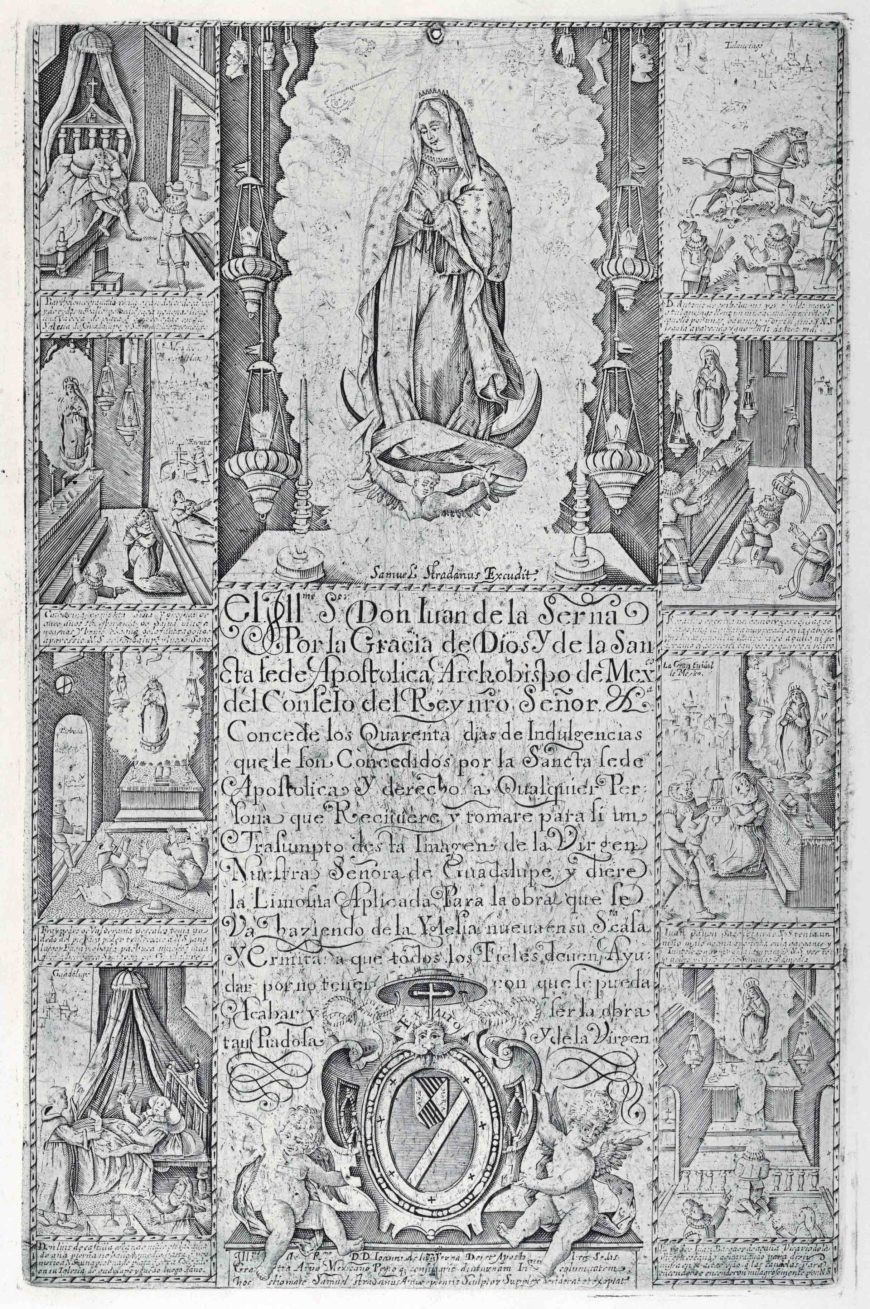
One of the earliest representations of the Mexican Virgin of Guadalupe, today patroness of the Americas and an important symbol of Mexican national and religious identity, is an engraving printed in 1608. The engraving depicts the Virgin of Guadalupe at the top of the page, seemingly hovering above an altar. Candles and hanging lamps illuminate her while ex-votos shaped like body parts testify to her powers of intercession.
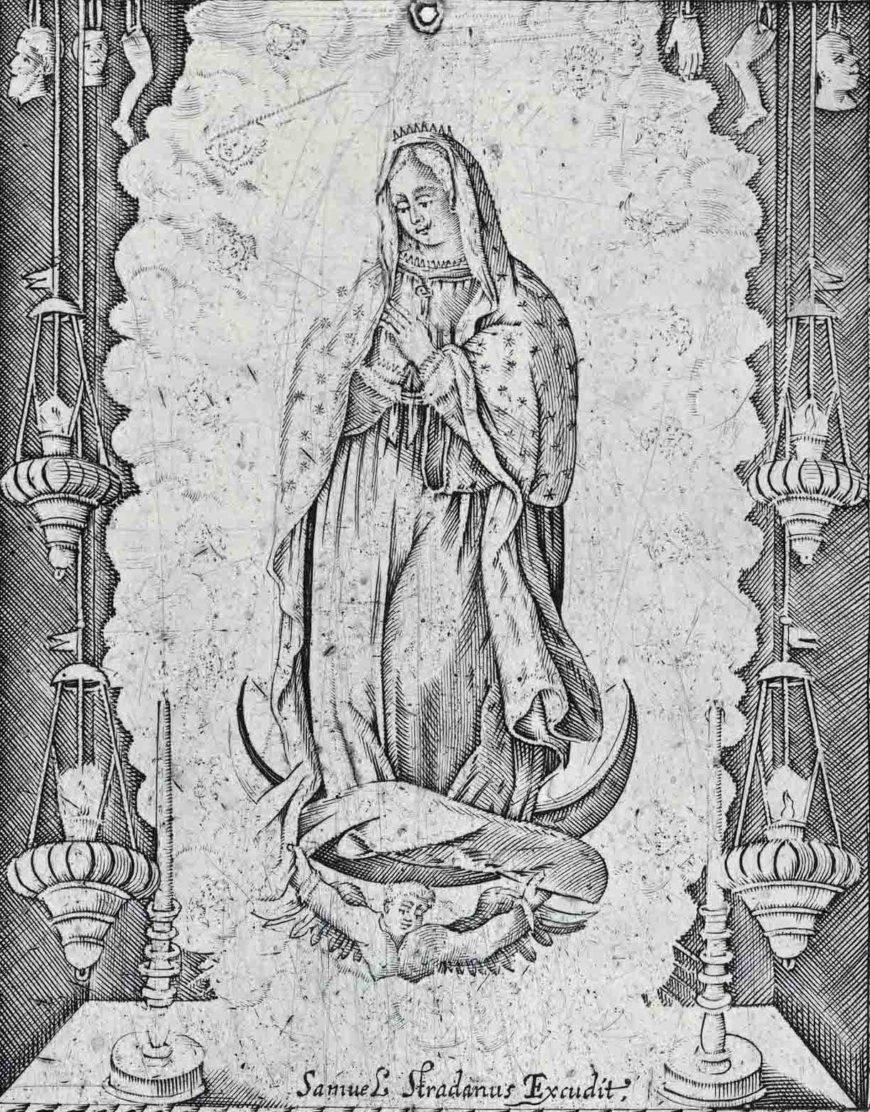

The borders of the print incorporate small scenes narrating miracles of the Virgin, each with its own minuscule descriptive text. Prints like this one, produced in multiples by inking an engraved copperplate and then running it through a roller press so that the ink transferred from its surface onto the paper sheet, allowed for wide diffusion of an image. They became important vehicles for the promotion of religious devotions, but also for the propagation of political propaganda and for the transmission of news and scientific knowledge.
A printed indulgence
The 1608 engraving of the Virgin of Guadalupe was cut by Samuel Stradanus, one of the most important early Mexican engravers who was originally from northern Europe. He even signed it “Samuel Stradanus Excudit” (published by Samuel Stradanus). The print served as an indulgence certificate issued by Mexican Archbishop Juan Pérez de la Serna. The money raised from the sale of the indulgences was used to finance the construction of the new sanctuary of Tepeyac (where the Virgin of Guadalupe first miraculously appeared, just north of Mexico City), which was consecrated in 1622.
The printed indulgence provides testimony to the early material culture surrounding devotion to the Marian advocation. Purchasers of the indulgences received a printed image that they could keep for their own use, perhaps displaying it in their homes or place of work. Prints like this one might then become objects of prayer themselves, or even used to enact miraculous cures. The faithful lit candles before devotional prints like this one, pressed them to injured body parts, and carried them on their persons for protection.
Mexico City was the first and most important center for printing in Spanish colonial Latin America, publishing far more books and printed images than any other city in Spain’s American dominions. The first typographic press was established in Mexico City in 1539, and 73 engravers are known to have worked in Mexico City over the course of the colonial period in New Spain. During this period, prints served the needs of both the church and laity in the region, promoting state and Church orthodoxy but were also manipulated by printers to meet a devout market that did not always adhere to official conventions.
The Inquisition and Mexican prints
Religious orthodoxy was critical during this period of the Counter Reformation, and was enforced by the Holy Office of the Inquisition in Mexico City. Some Mexican Inquisition cases reveal the varied and complex ways in which inhabitants of the city engaged with these prints [1]. Many of the Inquisition cases involving prints centered on faulty inscriptions associated with those printed images. These cases reveal the complex ways in which religious prints in particular might be produced, circulated, and engaged with by viewers. For example, in 1572, Juan Ortiz, a blockcutter who produced carved woodblocks for impression, appeared before the Inquisition under suspicion of Lutheranism. He had cut a block of the Virgin of Rosary that then appeared printed alongside an inscription promising “perpetual grace” to its purchasers. The Inquisitors condemned the inscription and expelled Ortiz from the Americas, arguing he had added the text for financial rather than devotional reasons. Printed images that promised spiritual benefits to their owners demonstrate the intertwined nature of devotional and financial motives: prints claiming to have greater spiritual power might sell better on the market.
In another instance, in 1690, the Inquisition investigated prints available for sale in the town of Puebla depicting Bishop Juan de Palafox y Mendoza and the nun Catalina de San Juan (known as the “china poblana”), both popular holy figures. Both Catalina de San Juan and Bishop Palafox were uncanonized and thus not officially recognized by the Catholic Church as sanctioned subjects of devotion. The prints violated the Church’s prohibitions against devotion to unapproved figures. They also demonstrate the power of popular piety and the ability of prints to promote this kind of devotion. In response to these prints, the inquisition released an edict reiterating the prior prohibitions on images of the two figures.
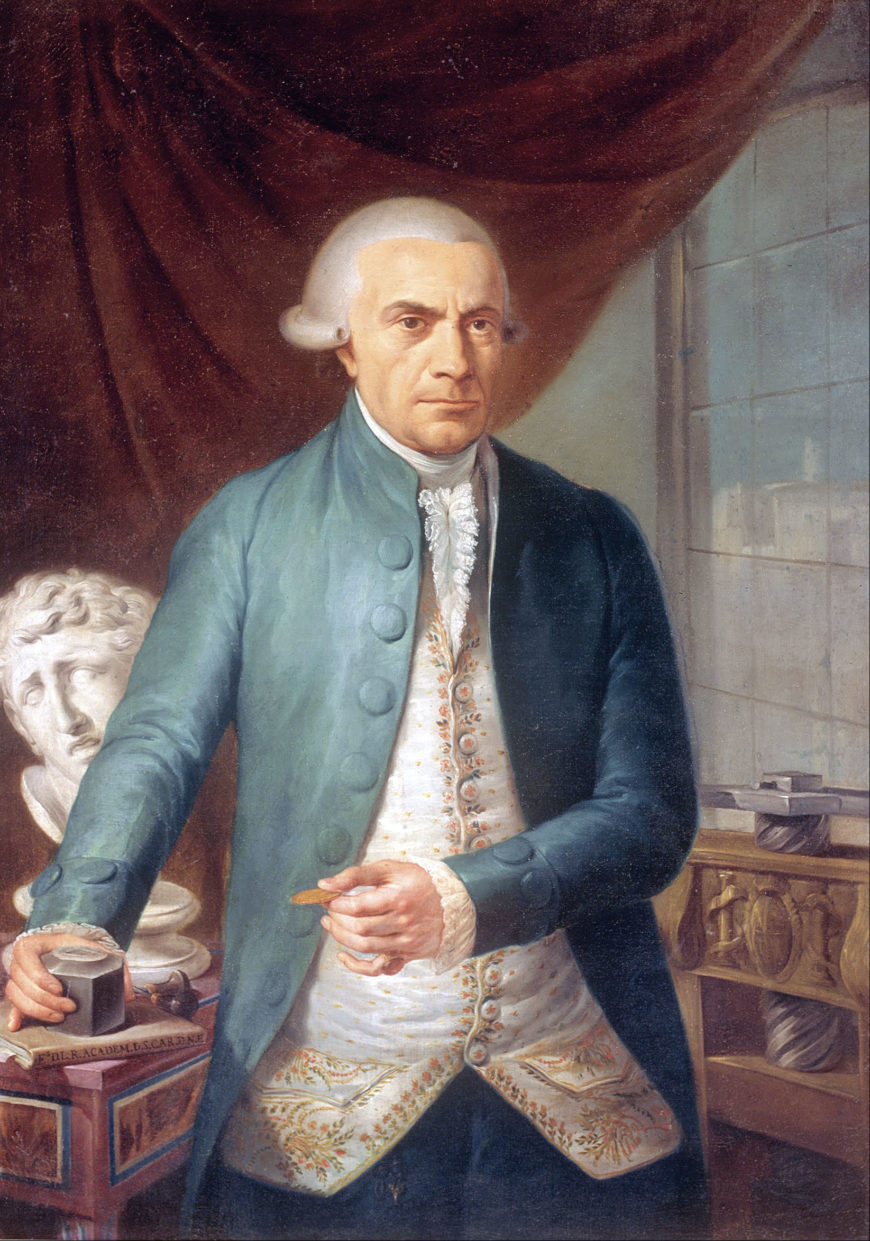
Mexican printmaking and the Academy of San Carlos
One of the key factors that distinguishes New Spanish printmaking from printmaking in other parts of the Spanish Americas is the 1783 foundation of the Royal Academy of the Three Noble Arts of San Carlos, the first art academy in the Americas. The Spanish engraver Jerónimo Antonio Gil came to New Spain in 1778 to serve as the chief engraver to the Royal Mint. He initially established an engraving school at the mint before eventually founding the Royal Academy of San Carlos, where he also taught engraving and trained students in the Neoclassical style, popular at the time in Europe. He would serve as the Academy’s director general until his death.
Gil and his academy introduced a new kind of artistic training and production to New Spain—one grounded in Enlightenment ideas of good taste and careful study of prototypes from Greco-Roman antiquity as well as of the life model. Engravings produced by academy artists employed a precise linear syntax to reproduce works of art made in other media, such as painting. Their works used linear perspective to convey buildings and illusionistic spaces, and demonstrate a strong knowledge of human anatomy and the use of light and dark to model forms. They also exhibit a new aesthetic of clean lines, reduction of Baroque ornament, and influence of Greco-Roman architecture and idealized representations of the human body. Gil’s influence can be seen in the engravings produced by his disciples as well as in the work of artists who emerged from the Academy [2].
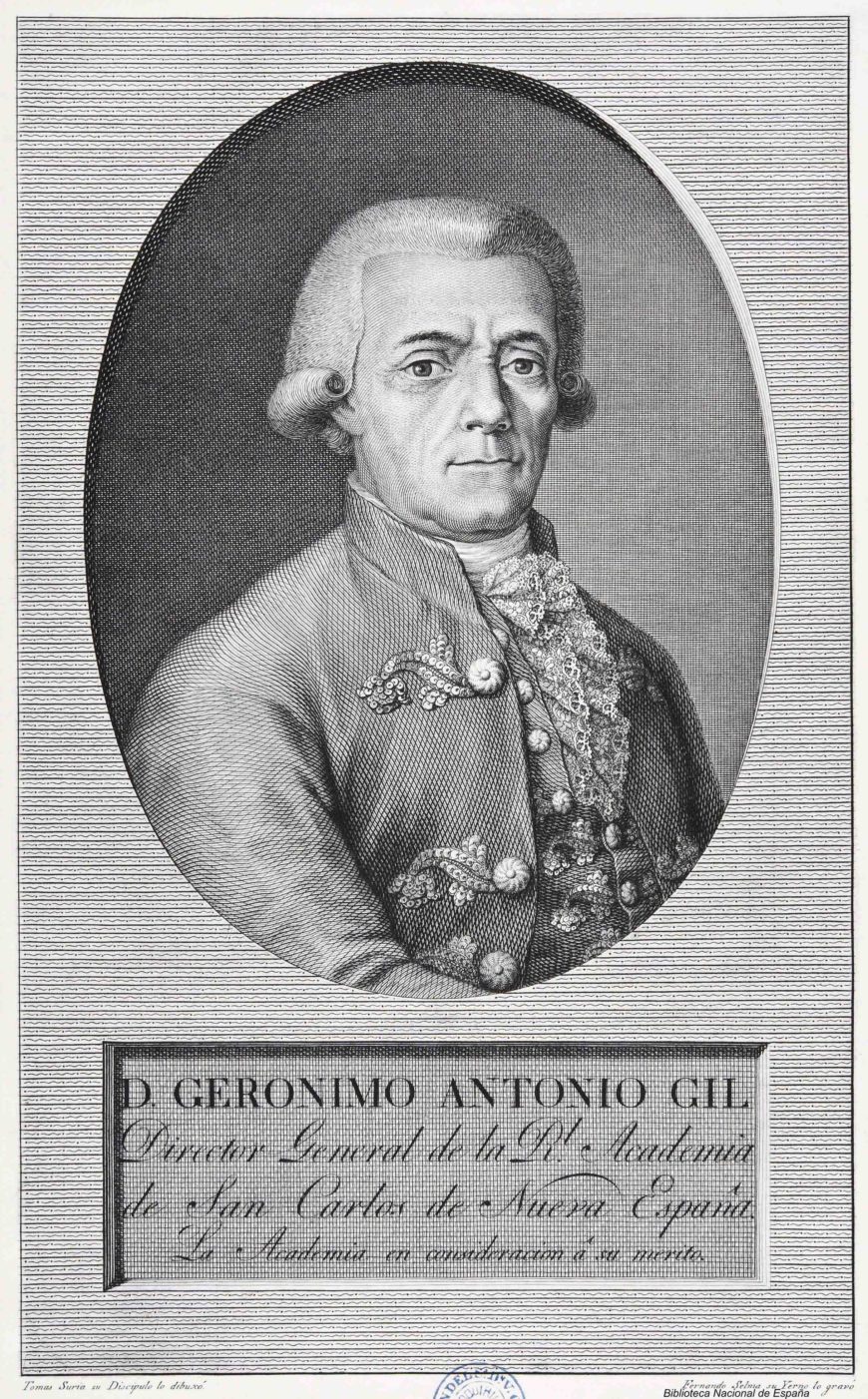
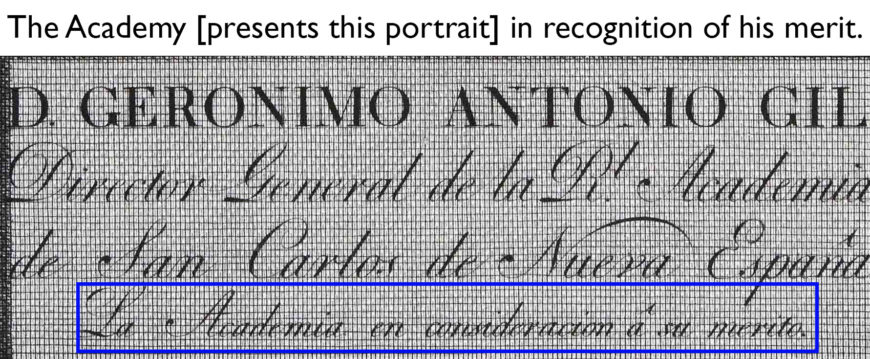
We have two portraits of Gil, a 1796 painting by Mexican artist Rafael Ximeno y Planes and a 1793 engraving by Fernando Selma (Gil’s son-in-law) after Tomás Suria. In both, Gil is recognized for his central role in founding the Academy and portrayed as a gentleman of the Enlightenment. Selma’s engraving shows Gil gazing forthrightly out at the viewer, and he wears a fashionable wig and coat.
The text below his portrait declares Gil the Director General of the Academy and gives the reason for the production of the portrait as “The Academy [presents this portrait] in recognition of his merit” (La Academia en consideracion â su merito). Prints of important personages were frequently produced to adorn texts in their honor or for distribution to the public. Gil himself engraved numerous portraits of Mexican luminaries.
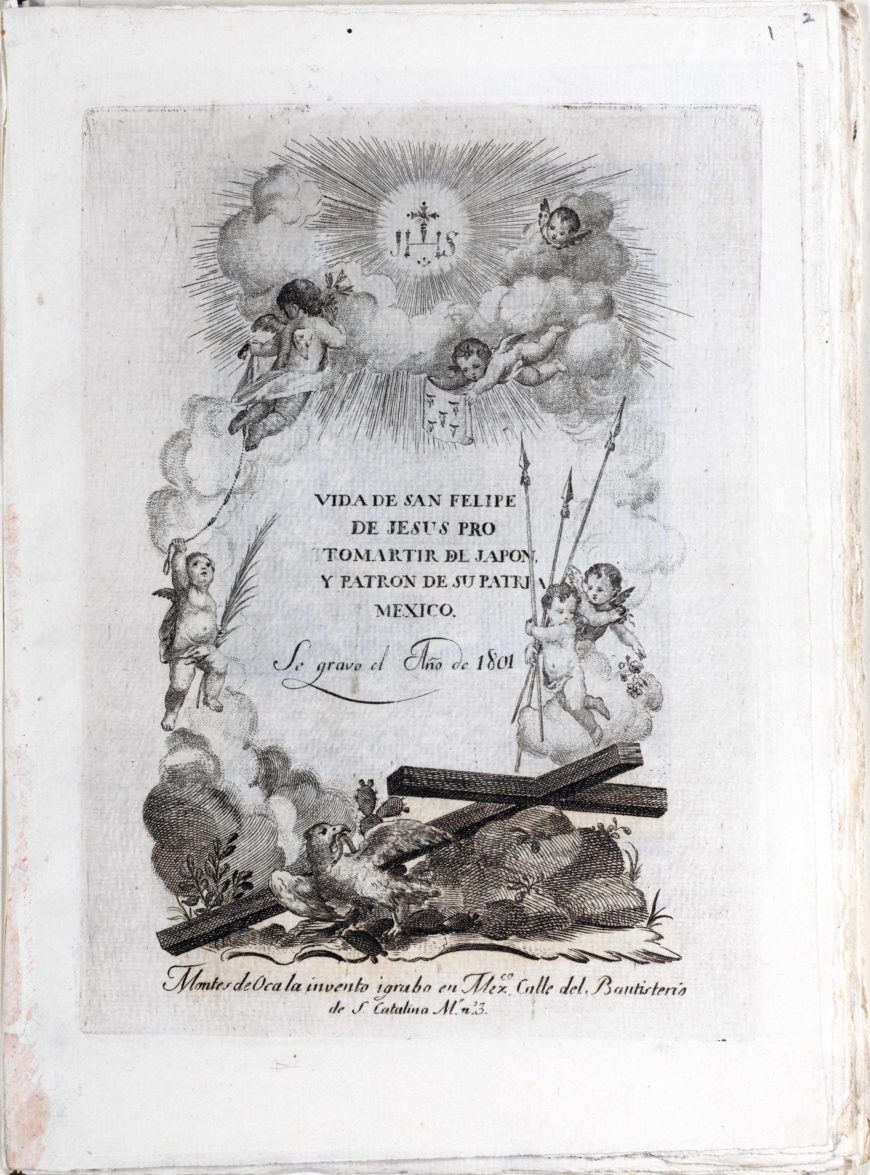
One of Gil’s students, José María Montes de Oca, merits special mention for a book he self-published in 1801 immediately after leaving the Academy. The book, Life of Saint Philip of Jesus, protomartyr of Japan and Patron of His Home Nation of Mexico (Vida de San Felipe de Jesus Protomartir del Japon y Patron de su Patria Mexico), is exceptional in the whole of colonial printmaking in that it consists entirely of full-page etched illustrations without typeset text. Furthermore, all thirty etchings were designed and executed by Montes de Oca himself.

Montes de Oca names himself as not only the artist but the “inventor” of the images, which narrate the life of Felipe de Jesús, a sixteenth-century martyr who had been born in Mexico but died in Japan. In naming himself “inventor,” Montes de Oca defined himself as the creator of the iconography and compositions, not simply the producer of the plates.
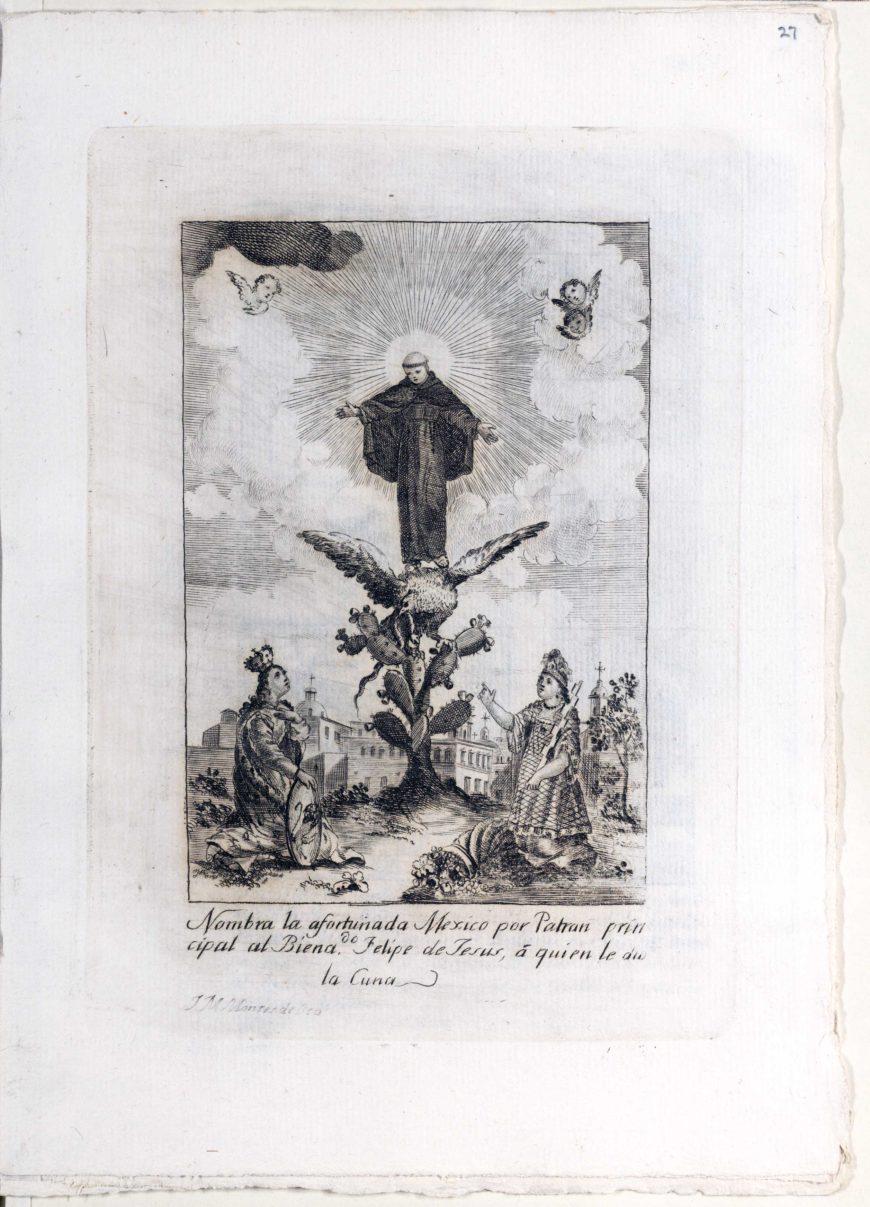
In the best-known image from Montes de Oca’s text, Felipe de Jesus stands in glory on the back of an eagle that has perched, a snake in its beak and wings spread, on a nopal cactus, while allegorical representations of Mexico and Spain kneel before him. Felipe de Jesús opens his arms as if to embrace these allegorical figures from afar. Prints like Montes de Oca’s Felipe de Jesús series allowed for the repetition and broad circulation of images of potential saints, promoting familiarity with their remarkable deeds and admirable virtues and thus encouraging the development of devotion to them.
Why prints mattered
Printed images produced in colonial New Spain allowed for the circulation of local religious imagery and promotion of such diverse figures as the Virgin of Guadalupe and Felipe de Jesús, and the controversial Bishop Palafox and Catalina de San Juan. In the eighteenth century, with the arrival of Jéronimo Antonio Gil and the establishment of the Royal Academy of San Carlos, engraving became an important medium for promotion of new styles and modes of taste. Throughout the colonial period, this ephemeral, multiple, and reproductive medium allowed for the wide circulation of images and their corresponding ideas to a broad public, creating a shared religious and political culture.
Notes:
[1] Kelly Donahue-Wallace, “Prints and Printmakers in Viceregal Mexico City, 1600-1800” (Dissertation, University of New Mexico, 2000), chapter 6.
[2] Kelly Donahue-Wallace, Jerónimo Antonio Gil and the Idea of the Spanish Enlightenment (Albuquerque: University of New Mexico Press, 2017), chapters 4–6.
The Bug That Had the World Seeing Red
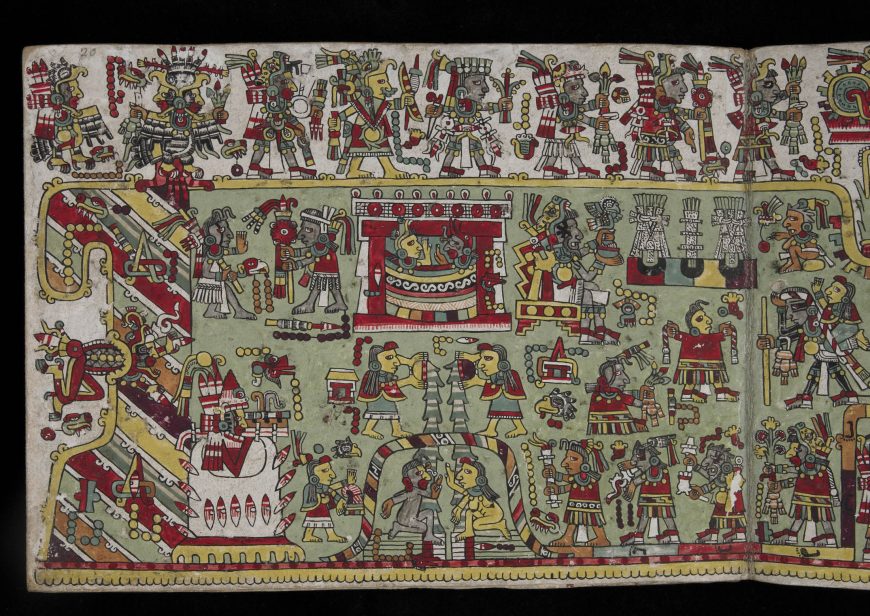
The power of red
Once there was a color so valuable that emperors and conquistadors coveted it, and so did kings and cardinals. Artists went wild over it. Pirates ransacked ships for it. Poets from Donne to Dickinson sang its praises. Scientists vied with each other to probe its mysteries. Desperate men even risked their lives to obtain it. This highly prized commodity was the secret to the color of desire—a tiny dried insect that produced the perfect red.
How could a color be so valuable? In culture after culture, red commands the eye. We are drawn to its power, and to its passion, its sacrifice, its rage, its vitality. It’s not an accident that this coveted color is red: It turns out that we humans are unusually susceptible to scarlet hues. Studies show that the color quickens our pulse and breath, perhaps because we link it with birth, blood, fire, sex, and death.
The quest for a color
But for much of human existence, broad mastery of the color crimson was elusive. Only a few natural substances produce red dye. Henna, madder roots, brazilwood, archil lichens, and fermented stews of rancid olive oil, cow dung, and blood numbered among the sources over the centuries, but most of them fell short—faltering as dyes for textiles and setting into corals, russets, and persimmons instead of true scarlets. The worst of them faded fast into dull pinkish browns. True reds proved rare, and the evocative pigment became even more prized.
Thousands of years ago, however, Mesoamericans discovered that pinching an insect found on prickly pear cacti yielded a blood-red stain on fingers and fabric. The tiny creature—a parasitic scale insect known as cochineal—was transformed into a precious commodity. Breeders in Mexico’s southern highlands began cultivating cochineal, selecting for both quality and color over many generations.
The results were spectacular. The carminic acid in female cochineals could be used to create a dazzling spectrum of reds, from soft rose to gleaming scarlet to deepest burgundy. Though it took as many as 70,000 dried insects to make a pound of dye, they surpassed all other alternatives in potency and versatility.
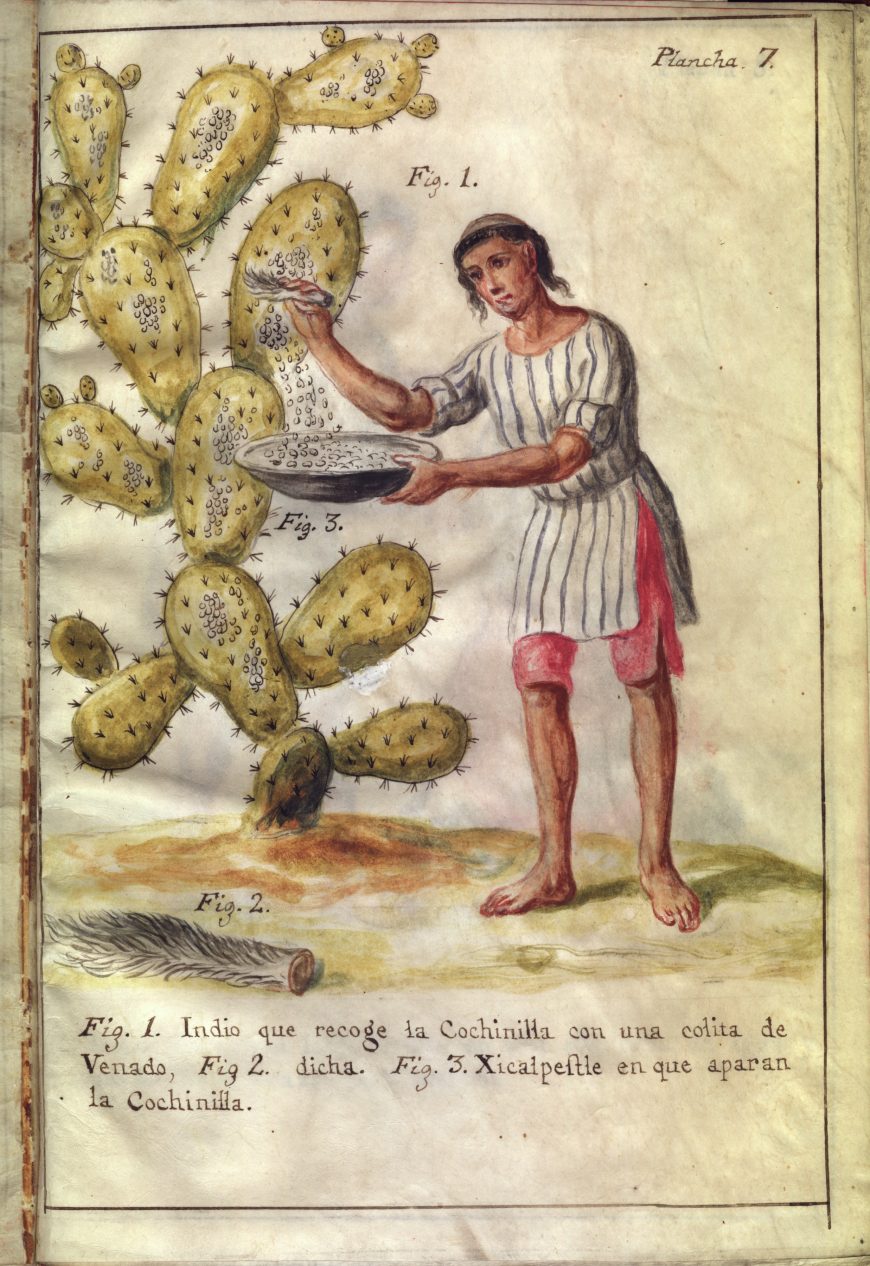
Cochineal spread through ancient Mexico and Central America, where it was used for the quotidian and the sacred. Textiles, furs, feathers, baskets, pots, medicines, skin, teeth, and even houses bore the brilliant red dye. Scribes colored the history of their people with its crimson ink.
Cochineal comes to the world
When the Spanish conquistadors landed in Mexico, they were struck by the stunning scarlets of the New World. The exotic source of the dye became a sensation back in Europe, where it was deemed the “perfect red.” The Spanish would go on to ship tons of the dried insects back to the Old World and beyond. Their monopoly on the color’s source made it one of their most valuable exports from Mexico, second only to silver.
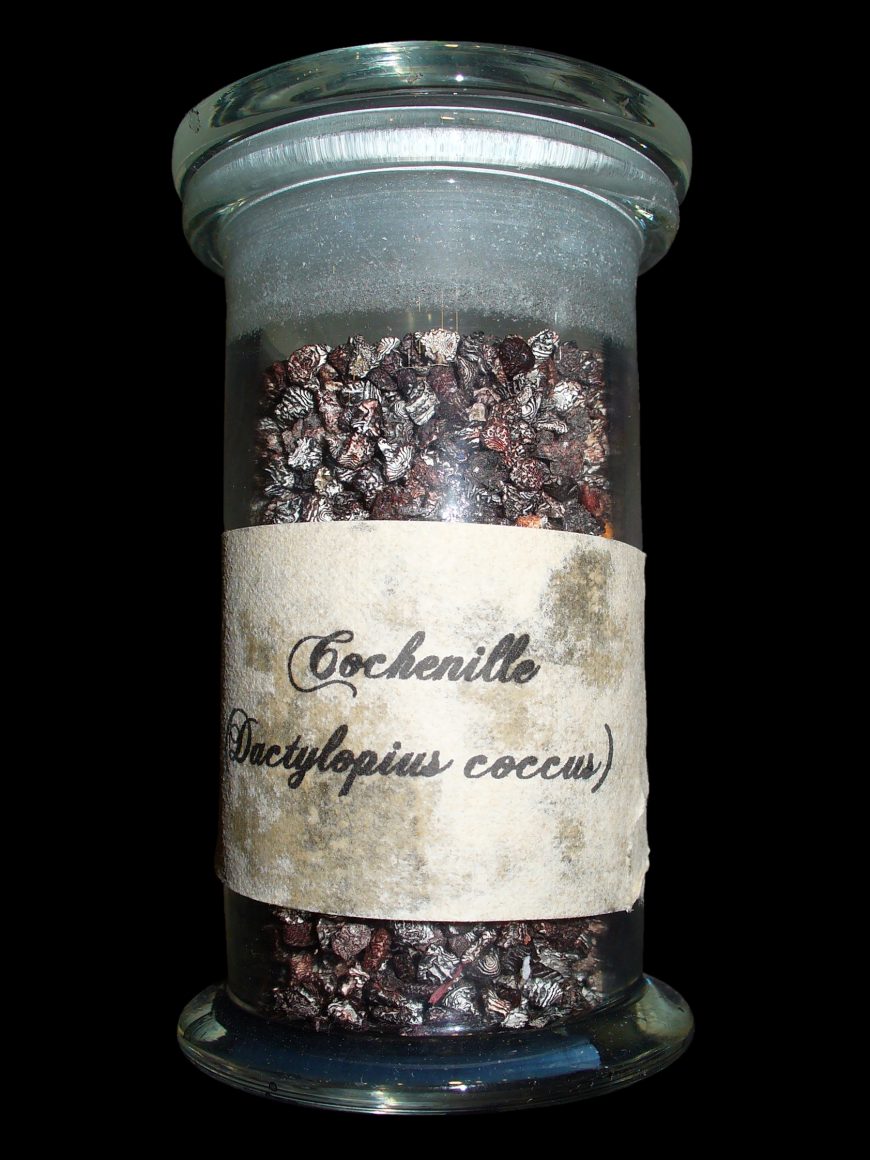
Europeans largely used cochineal on textiles, where it produced red fabrics of an unmatchable sheen and intensity. (It could also be used to make shades of peach, pink, purple, and black—but the reds were what made cochineal famous.) To see this magnificent red was to see power. Court gowns and royal robes were made with cochineal, as were the uniforms of British officers. The scarlet dye even found its way back across the ocean, into the “broad stripes” of the embattled banner over Fort McHenry that inspired the U.S. national anthem.
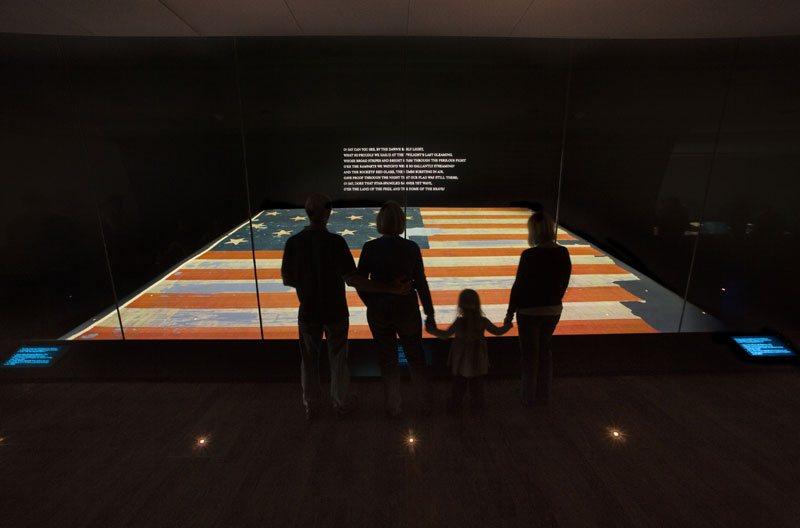
Painting and pitfalls with the new red
Cochineal also found a spot in the artist’s paint box. If you were a European artist on a tight budget, you could procure your cochineal from shreds of dyed cloth, but fresh-ground insects yielded much better results. Artists usually combined their cochineal with a binder, creating a pigment known as a lake.
It’s impossible to tell with the naked eye which painters used cochineal to make their reds. But recent advances in chemical analysis have confirmed its presence in numerous masterpieces. Among those works is Rembrandt’s The Jewish Bride.
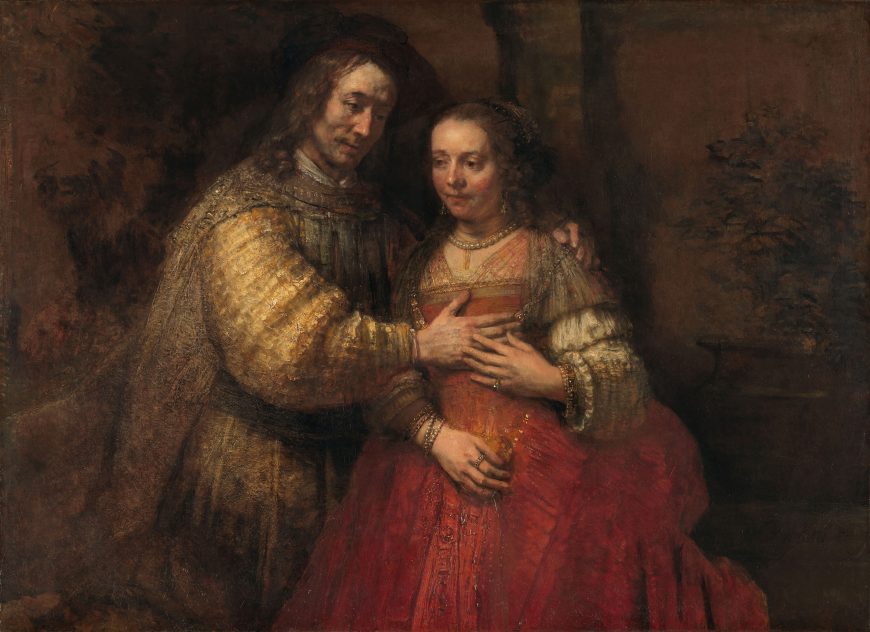
Between the muted browns and golds, the bride’s red gown draws the eye. A combination of vermilion base and cochineal glaze allowed Rembrandt to give the dress its great depth and luster. Other painters of the period also loved to use cochineal lakes to paint glowing red fabrics, such as the shimmering scarlet silks in Anthony van Dyck’s Charity and possibly in the Portrait of Agostino Pallavicini as well.
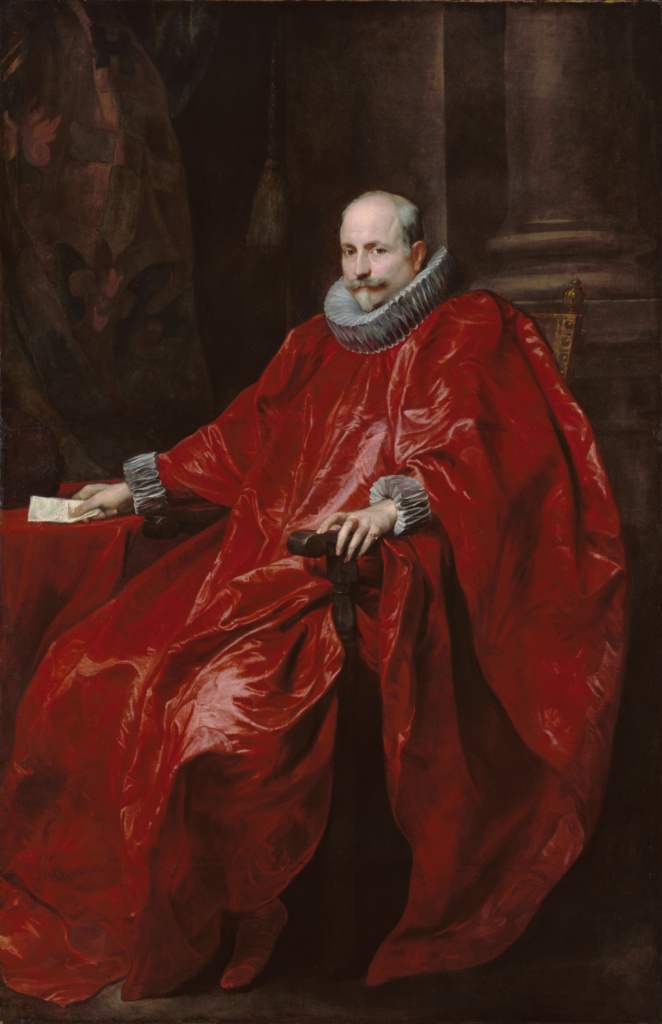
Eye-catching though these cochineal lakes were, they had one great drawback. Unlike cochineal dye on cloth, which usually holds fast to its color, cochineal pigments in paint tended to fade with exposure to light. This was especially true of watercolors. J. M W. Turner’s cochineal-reddened sunsets, for example, literally pale in comparison to what he originally set down.
Cochineal could be fugitive in oils too. A lake made with minimal cochineal, or cochineal of poor quality, faded in a matter of years. Even quality cochineal has dimmed over the centuries. The dowdy jacket in Thomas Gainsborough’s Dr. Ralph Schomberg and the blotchy pastel backdrop of Renoir’s Madame Léon Clapisson both are pale versions of the original.
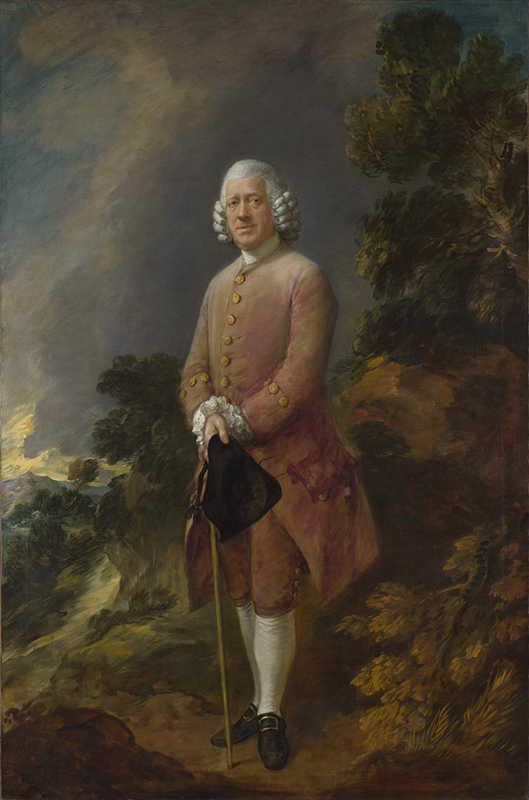
Yet while Dr. Schomberg is consigned to his discolored suit for the foreseeable future, Madame Clapisson recently was given new life. A team at Northwestern University and the Art Institute of Chicago analyzed the cochineal that remained in the portrait and digitally recreated the painting in all its glory. Regard the original and the restoration, and you can see both the force of cochineal and its weakness.
When new artificial reds like alizarins made from coal tar became available in the late 19th century—ones more lasting and less expensive than those created by the naturally occurring insect—artists eagerly picked them up. By the late 20th century, artists had abandoned cochineal. Dyers, too, turned to cheaper alternatives. Even in its homeland, the insect nearly disappeared.
A red reborn
Today, in a surprising turn of history, the cochineal market is booming again—thanks to contemporary demand for safe food and cosmetic coloring. See names like carmine, carminic acid, crimson lake, Natural Red 4, or E120 on a label, and you may be looking at a modern manifestation of the color once fit for kings.
A few artists and dyers, too, have been tempted back by its revival—drawn to its intensity and sheen, its historical and cultural resonances. One is Elena Osterwalder, whose stunning installations employ both cochineal and the amatl bark-paper used by Mesoamericans before the Conquest.
In Oaxaca, once the epicenter of the cochineal trade, you can still find traditional weavers breathing new life into the ancient color.
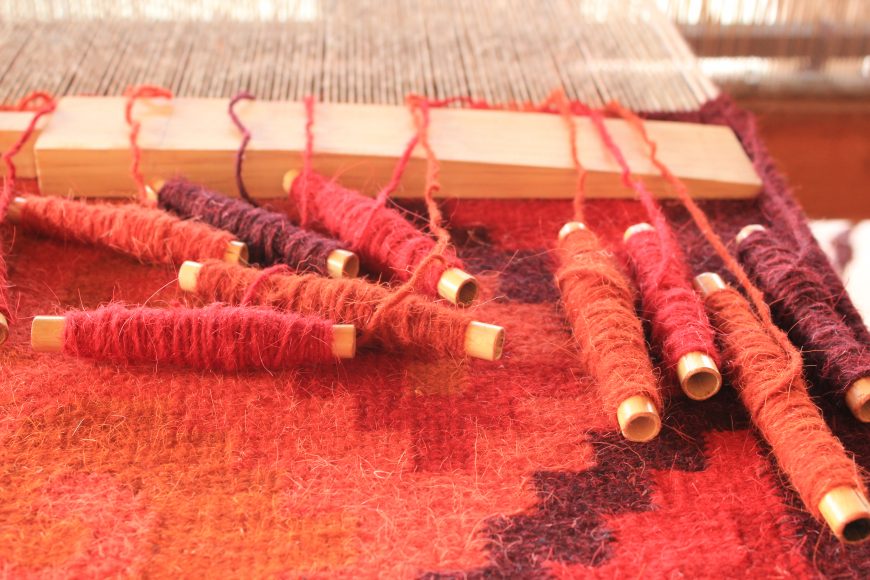
Though the high era of cochineal may have ended, the power conveyed by its potent hue remains. Over centuries and continents, we humans have always been drawn in by red. After all, it’s in our blood.
This essay first appeared in the iris (CC BY 4.0).
Additional resources:
Read about the Star-Spangled Banner at the New York Times
Read about Renoir’s colors in Madame Clapisson at the New York Times
The Medici collect the Americas
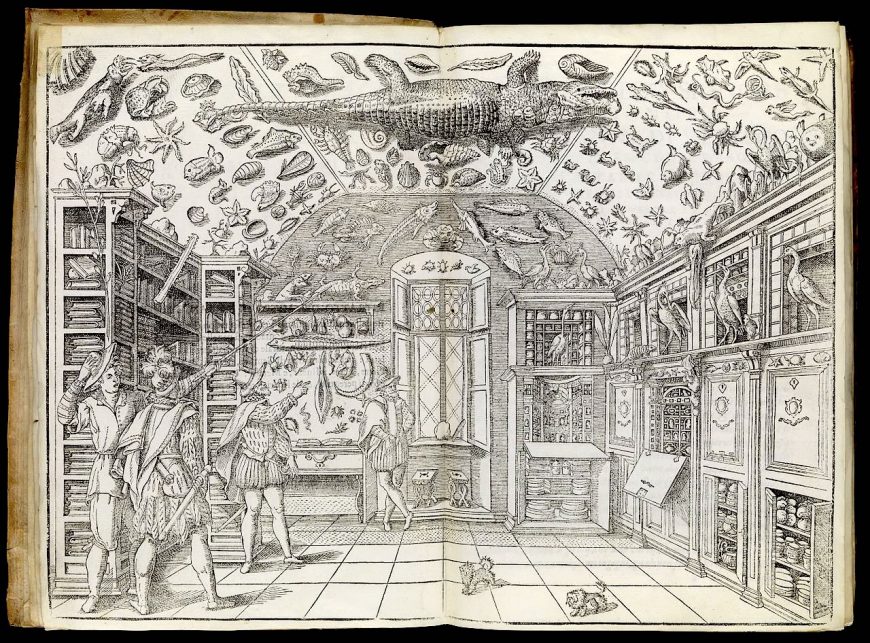
Americana and cabinets of curiosities
After Christopher Columbus landed on the Caribbean island of Hispaniola in 1492 and the subsequent Spanish invasion and colonization of much of the Americas, material objects, flora, and fauna from these faraway lands were shipped back to Europe where many people perceived them as exotic items of wonder and fascination. Americana—objects sent from the Americas—were found in numerous cabinets of curiosities (also known as Wunderkammern). Cabinets of curiosities first appeared in sixteenth-century Europe as a way to display items perceived as exotic, curious, and wondrous. The strategy of collecting Americana and displaying it in cabinets of curiosities offered a way to engage with the Americas for those who might never undertake the voyage. In a sense, we might even say that this allowed Europeans to take possession of these distant lands.
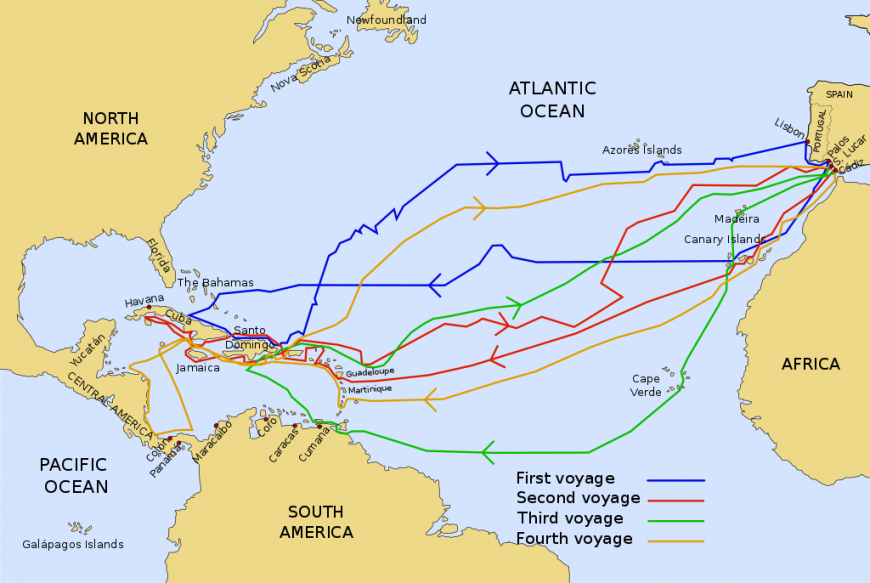
The origin of cabinets of curiosities in the sixteenth century coincides with the discovery, by Europeans, that the world was much larger than they previously believed. It also coincides with the invasion and the colonization of the Americas and the millions of people who lived there. Technological and scientific advancements in mapping and navigation spurred interest in collecting items from around the globe, as well as the instruments needed to create maps and sail the seas.
Cabinets of curiosity created a microcosm of a world that could be studied, ordered, and understood, but they were not spaces in which just anyone could encounter and study such objects, these were personal spaces for the elite (and anyone they invited). They often combined human-made (artificialia), natural elements (naturalia), and scientific objects and instruments (scientifica), as we see in Ferrante Imperato’s 1599 illustration of a Wunderkammern.
Of the naturalia sent from the Americas, living animals—especially birds—were among the most popular. Turkeys, parrots, and macaws were among the birds that arrived in Europe. The armored appearance of armadillos were also a continuous source of wonder; and their shell retained its shape, even if they died on the transatlantic voyage. Apparently, some were even gilded and displayed on pillars in Europe.
Among the human-made items from the Americas found in Renaissance curiosity cabinets are Olmec masks, Mesoamerican codices (such as the Codex Vaticanus A), New Spanish featherworks, Brazilian hammocks, Taíno objects, and more. Among the most exceptional objects to first enter European Wunderkammern were those sent by Hernán Cortés in 1519, as gifts to the Holy Roman Emperor, Charles V. Turquoise masks, golden figurines, featherworks, and more were met with excitement and amazement by people in Toledo, Valladolid, and eventually Brussels. Albrecht Dürer even remarked that “In all my life I have seen nothing that made my heart rejoice so much as these things. Here I have found wonderful, costly things and I have marveled at the subtle ingenuity of people in strange lands.”[1]
The Medici Popes
Among the most avid collectors of Americana were members of the powerful Florentine Medici family. Medici popes Leo X (Giovanni di Lorenzo de’ Medici, who reigned as Pope from 1513–21) and Clement VII (Giulio di Giuliano de’ Medici, who reigned from 1523–34) collected Americana—and in fact were some of the earliest to do so. They never traveled across the Atlantic, yet their desire to understand these lands increased, especially with ongoing evangelization attempts. Leo X commissioned frescoes filled with American flora and fauna. For instance, he commissioned the artist Giovanni di Udine to paint maize (also known as corn and first domesticated by Indigenous peoples in southern Mexico about 10,000 years ago) in festoons in the Loggias (designed by Raphael) in the Vatican palace.
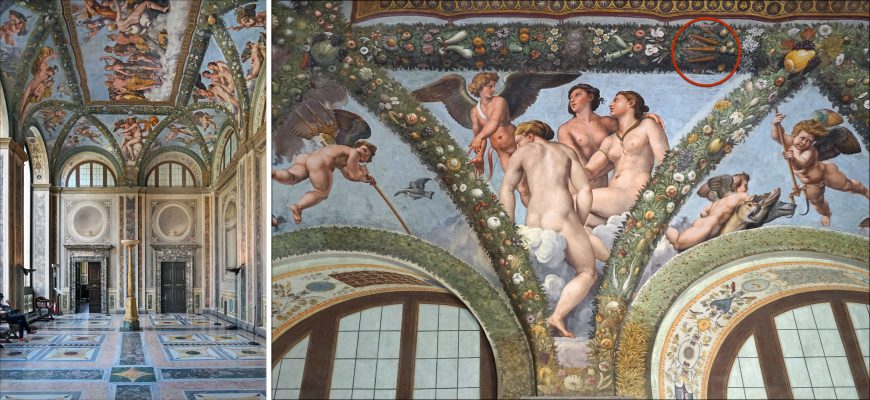
Udine had, though, painted the first known depictions of maize earlier, between 1515–17, in the festoons around frescoes by Raphael in the Loggia of Psyche within the Villa Farnesina in Rome, which belonged to the wealthy Sienese banker Agostino Chigi. Pope Clement VII was likewise among the earliest patrons to commission artworks that depicted subjects related to this foreign world which he had never seen with his own eyes. In his Villa Madama (Sala di Giulio Romano, c. 1520) in Rome, he had Udine paint a naturalistic turkey along with other birds like peacocks.
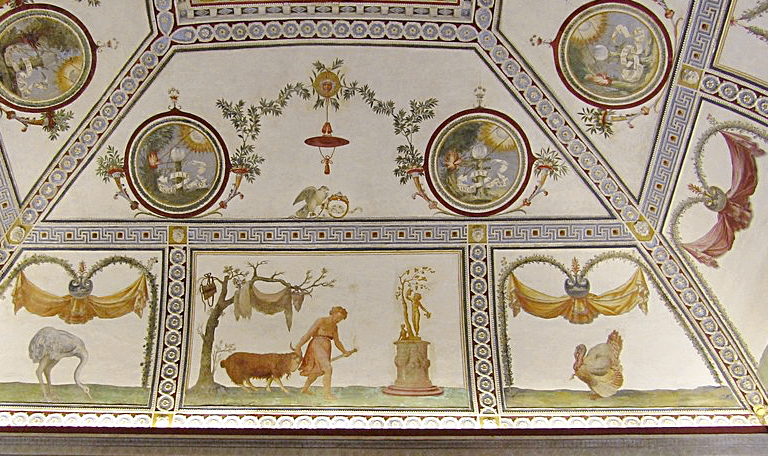
Popes Leo X and Clement VII also actively acquired Americana as well. In 1514, the Portuguese king, Manuel I, sent Leo X a gift of flora and fauna from the Americas and India. It is likely that part of this gift included plants like maize and beans from the Americas, as well as the special gift of an elephant, called Hanno, from India, of whom Leo was extremely fond.
The Ñudzavui (Mixtec) Codex Vindobonensis Mexicanus I, one of the few surviving pre-conquest Mesoamerican screenfold codices, was owned by Clement VII. The King of Portugal reportedly sent it to Clement VII, along with other gifts from the Americas, sometime before 1523. A decade later, the Medici pope received another gift of objects from the Spanish Dominican friar, Domingo de Betanzos, who had traveled to New Spain to aid in evangelizing the Indigenous populations. The Dominican friar apparently gifted the pope featherworks, Ñudzavui turquoise masks, and codices.
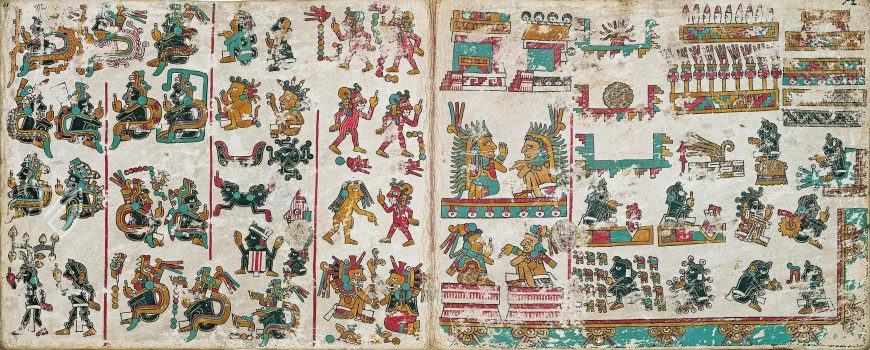
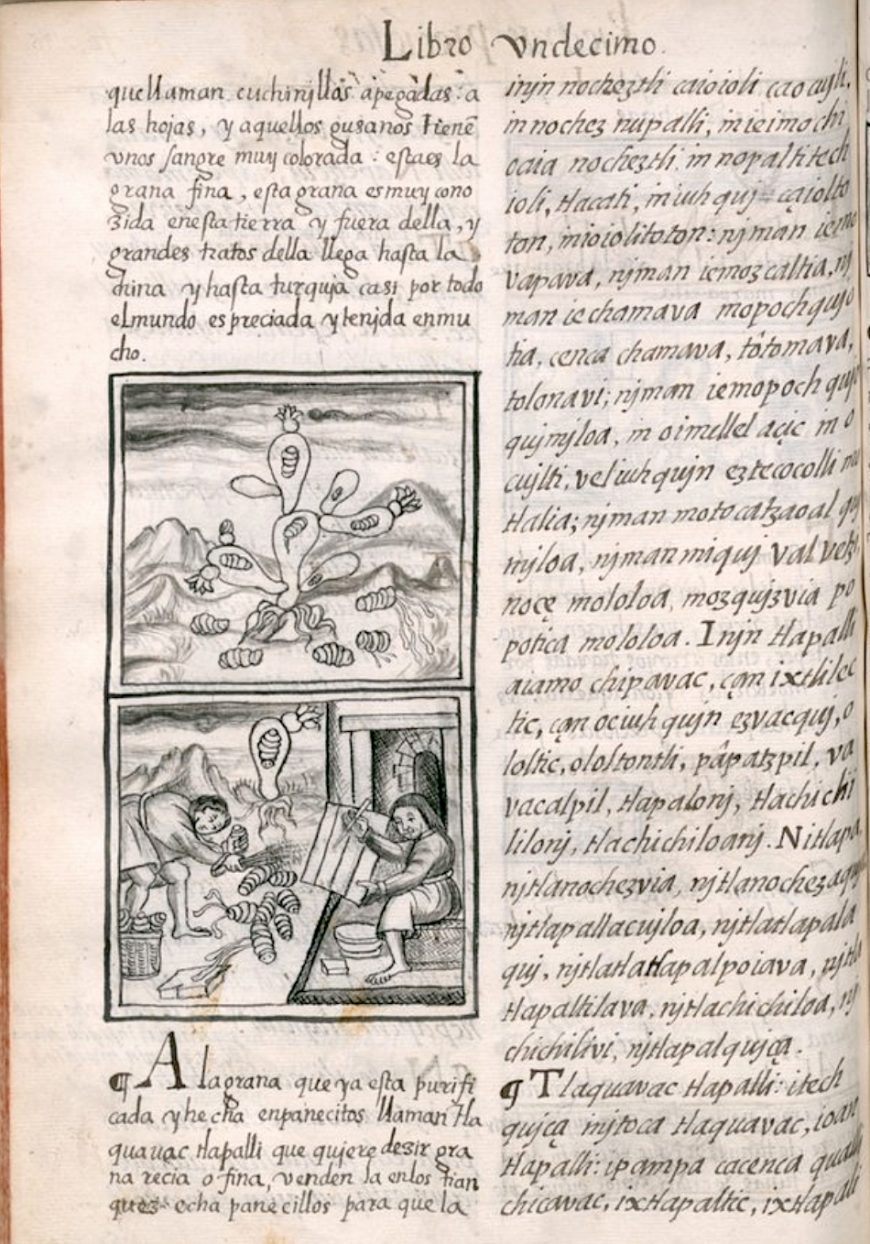
The First Grand Duke: Cosimo I de’ Medici
Grand Duke Cosimo I de’ Medici (who reigned from 1537–1574) and his wife, Duchess Eleanora di Toledo, like their Medici family members, never traveled to the Americas. But they too continued to acquire plants, animals, and other objects from these far-away lands. They also commissioned artworks that made visual reference to the Americas, possibly as a way to participate in a vicarious conquest of these foreign peoples and places. Cosimo was partly able to collect Americana because of his marriage to Eleanora, a noblewoman of the Spanish court. Their marriage in 1539 helped to cement a Medici alliance with Spain, which would aid Cosimo in his collecting practices. The two grew maize, and apparently even started to cultivate tomatoes and medicinal plants (also introduced from the Americas). Cosimo had live birds, including turkeys, at Medici estates. Beyond their interest in living flora and fauna, the Medici Duke and Duchess also had also obtained a number of objects from the Americas, including mosaic masks, objects made of jade, and feather cloaks.
How items such as these were listed in Medici inventories reveals the challenges that Europeans faced when classifying Amerindian objects. In a 1553 inventory, Aztec masks were listed under ‘jewelry’ (goia), but not long thereafter in another inventory they were listed as “theatrical masks” (maschera) in an attempt to compare them with recognizable European forms with clear functions. At this time there was also an interest in Greco-Roman theatrical masks, so perhaps the Aztec masks were eventually believed to function in a similar capacity. This reframing of Mesoamerican masks—from jewelry to masks—could also relate to broader ways in which Europeans were trying to understand and reconcile American objects, many of which were unfamiliar to them. [2]
Grand Dukes Francesco I (1574 to 87) and Ferdinando I (1587 to 1609)
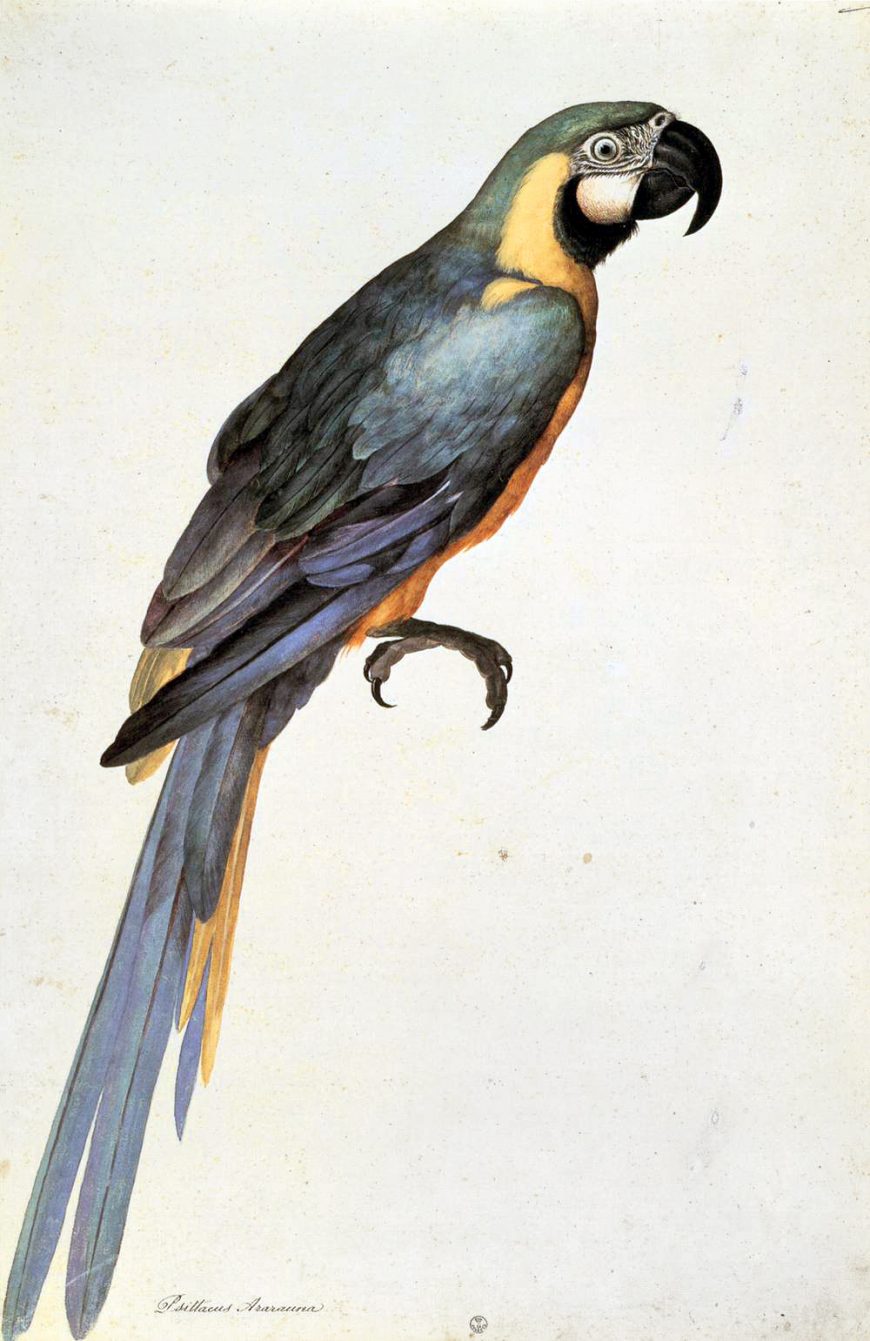
Cosimo and Eleanora’s eldest son, Francesco, was similarly drawn to the naturalia and artificialia of the Americas, sharing his father’s keen interest in birds and plants. At one point, he commissioned Jacopo Ligozzi to create naturalistic drawings of local and exotic plants and animals, some of which came from the Americas. Among the most remarkable are his depictions of a pineapple, a macaw, and the American century plant (Agave americana), all drawn circa 1570.
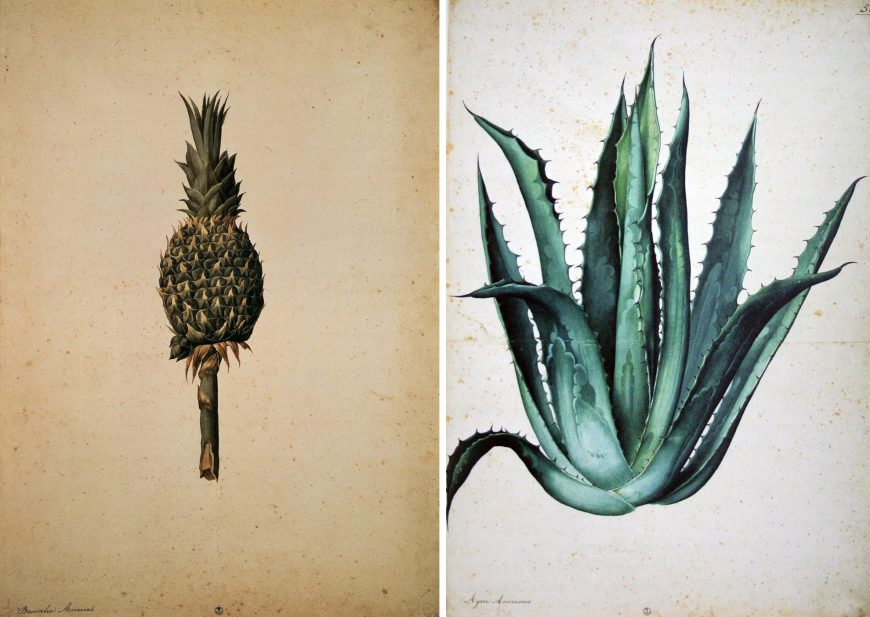
Ligozzi had live models on which to base his clearly articulated images, and his almost microscopic details were praised. Francesco’s interest in the American naturalia extended to his experiments as well. In the Casino di San Marco in Florence which had workshops, including the Medici porcelain factory, Francesco conducted experiments and studied his collection of plants and animals. Like his father, he continued to grow plants, some of them from the Americas, in a nearby botanical garden. He would use some in his alchemical experiments, creating medicines and other distillations. Francesco often gifted objects and naturalia from the Americas to other high-ranking individuals who were similarly fascinated with items from distant lands. One sumptuous gift was given to Duke Albrecht V of Bavaria in 1572, and it included featherworks, gold and silver figurines, parrots, food items, and more.
Francesco’s younger brother, Ferdinando, also had a desire to collect Americana. As a cardinal in Rome, he acquired numerous objects, such as multiple featherworks, one of which was a bishop’s mitre. He also came into ownership of the Florentine Codex, an encyclopedia produced between 1575 and 1577 under the direction of the Franciscan friar Bernardino de Sahagún along with Indigenous collaborators. This twelve volume text included discussion of cochineal, which produced a highly coveted red dye, along with other types of resources from the Americas. One can imagine Ferdinando’s interest in possibly learning from the Florentine Codex how to manufacture cochineal.
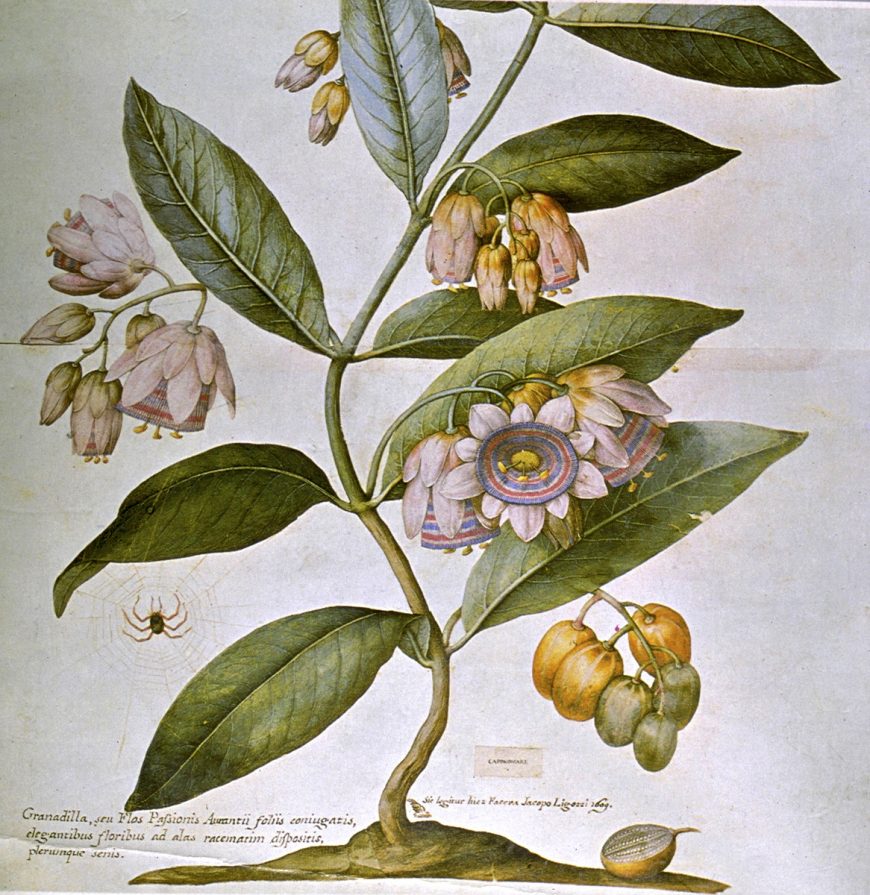
When Francesco died in 1587, and Ferdinando became Grand Duke of Florence, he moved from Rome to Florence with his collection. Ligozzi, who had remained in the employ of the Medici court even after Francesco’s death, would then paint, at the request of Ferdinando, one of his most well-known and final botanical images: the Passiflora coerulea, or the passion flower (or Granadilla or maracot originally). Previously unknown to Europeans, it had only recently become known, and sent across the Atlantic to Europe. The plant sparked immense curiosity because of the manner in which it visually evoked the crown of thorns, and so became a powerful Christian symbol.
Knowing the unknown
Medici fascination with Americana in the sixteenth century was certainly not unique. Across Europe, many powerful individuals sought to acquire objects taken from the Americas, as a way to know the unknown, to exert some control over the colonial processes underway, and to possess exotic and rare things. The Medici popes and three grand dukes provide a more focused example of the ways in which Americana intersected with European interests in conquest and colonization, science and alchemy, and collecting and visual culture in the sixteenth century.
Acknowledgments
Thanks are due to Lydia Parker.
Notes:
[1] Adriana Turpin, “The New World collections of Duke Cosimo I de’ Medici and their role in the creation of a Kunst- and Wunderkammer in the Palazzo Vecchio,” Curiosity and Wonder from the Renaissance to the Enlightenment, ed. R.J.W. Evans and Alexander Marr (London: Ashgate, 2006), p. 64.
[2] Isabel Yaya, “Wonders of America: The Curiosity Cabinet as a Site of Representation and Knowledge,” Journal of the History of Collections (2008), pp. 1–16.; Turpin, p. 73.
Additional resources
The Medici Collections of the Museo Galileo, on Google Arts and Culture
Collecting for the Kunstkammer on The Metropolitan Museum of Art’s Heilbrunn Timeline of Art History
Christian F. Feest, “The Collecting of American Indian Artifacts in Europe, 1493–1750,” in America in European Consciousness, 1493–1750, ed. Karen Ordahl Kupperman (University of North Carolina Press, 1995), pp. 324–60.
J. Janick and G. Caneva, “The First Images of Maize in Europe,” Maydica 50 (2005), pp. 71–80.
Eloise Quiñones Keber, “Collecting Cultures: A Mexican Manuscript in the Vatican Library,” in Reframing the Renaissance, ed. Claire Farago (New Haven and London: Yale University Press, 1995), pp. 229–42.
Lia Markey, Imagining the Americas in Medici Florence (Penn State University Press, 2016).
Peter Mason, “From Presentation to Representation: Americana in Europe,” Journal of the History of Collections 6 (1994), pp. 1–20.
Larry Silver, “Europe’s Global Vision,” in Blackwell Companions to Art History: A Companion to Renaissance and Baroque Art, ed. Babette Bohn and James M. Saslow (Wiley, 2013).
Adriana Turpin, “The New World collections of Duke Cosimo I de’ Medici and their role in the creation of a Kunst- and Wunderkammer in the Palazzo Vecchio,” Curiosity and Wonder from the Renaissance to the Enlightenment, ed. R.J.W. Evans and Alexander Marr (London: Ashgate, 2006), pp. 63–85.
Isabel Yaya, “Wonders of America: The Curiosity Cabinet as a Site of Representation and Knowledge,” Journal of the History of Collections (2008), pp. 1–16.
Virgin of Guadalupe
Video \(\PageIndex{13}\): Virgin of Guadalupe, late 17th century, 190 cm high, oil paint, gilding, and mother of pearl on panel (Franz Mayer Museum, Mexico City)

Loving mother. Devoted wife. Ideal woman. Queen of Heaven.
Who could ever be this perfect? For Christians, the Virgin Mary carries all these titles, and she is often celebrated in art as a mother, wife, and queen. With Spanish colonization of the Americas, devotion to the Virgin Mary crossed the Atlantic.
The conquistador Hernán Cortés even carried a small statue of the Madonna with him as he searched for gold and encountered the indigenous peoples of Mexico. After the defeat of the Aztec capital of Tenochtitlan in 1521 and the establishment of the Spanish Viceroyalty of New Spain (Spanish rule in Mexico, Central America, and part of the U.S., 1521-1821), the Virgin Mary became one of the most popular themes for artists. One Marian cult image eventually became more popular than any other however: the Virgin of Guadalupe, also known as La Guadalupana. Her image is found everywhere throughout Mexico today, gracing churches, chapels, homes, restaurants, vehicles, and even bicycles.
Imagery from the Book of Revelation and the Song of Songs
Many people consider the original image of Guadalupe to be an acheiropoieta, or a work not made by human hands, and so divinely created. Some consider the image the product of an indigenous artist named Marcos Cipac (de Aquino), working in the 1550s. In the original image, still enshrined in the basilica of Guadalupe in Mexico City today, Guadalupe averts her gaze and clasps her hands together in piety. She stands on a crescent moon, and is partially supported by a seraph (holy winged-being) below. She wears Mary’s traditional colors, including a brilliant blue cloak over her dress. Embroidered roses decorate her rose-colored dress. Golden stars adorn her cloak and a mandorla of light surrounds her.
The image of Guadalupe relates to Immaculate Conception imagery, which drew aspects of its symbolism from the Book of Revelation and the Song of Songs. For instance, the Book of Revelation describes the Woman of the Apocalypse as “clothed with the sun, with the moon under her feet and a crown of twelve stars on her head.” In the Guadalupe image, twelve golden rays frame her face and head, a direct reference to the crown of stars.
Ashen skin
Guadalupe’s ashen skin is the subject of some discussion. It is possible that she represents an indigenous Madonna. However, the Virgin of Guadalupe in Extremadura, Spain, after whom Mexico’s Guadalupe is named, is a black-skinned Madonna—a direct reference to Mary’s beauty based on a passage from the Song of Songs: “I am black but beautiful.” Black Madonnas were popular long before Guadalupe’s appearance in Mexico, and so it is possible that her ashen skin situates her within this pre-existing tradition.

Seeing her today
Today, millions travel annually to her basilica to glimpse the original image, which visitors see while zooming beneath it on a conveyor belt. The original shrine devoted to Guadalupe, on a hill above the basilica, marks the site of her initial miraculous appearance.
Her miraculous revelation to Juan Diego
The story associated with her miraculous revelation varies depending on the author, but the general story goes something like this: In December 1531, a converted Nahua man named Juan Diego was on his way to mass. As he walked on the hill of Tepeyac(ac), formerly the site of a shrine to the Aztec mother goddess Tonantzin, Guadalupe appeared to him as an apparition, calling him by name in Nahuatl, the language of the Nahua. According to one textual account written in Nahuatl, Juan Diego described her as dark-skinned, with “Garments as brilliant as the sun.” She requested that Juan Diego ask the bishop, Juan de Zumárraga, to construct a shrine in her honor on the hill. After recounting the story, the bishop did not believe Juan Diego and requested proof of this miraculous appearance. After speaking again with Guadalupe on two other occasions, she informed Juan Diego to gather Castilian roses—growing on the hillside out of season—inside his tilma, or native cloak made of maguey fibers, and bring them to the bishop. When Juan Diego opened his tilma before Bishop Zumárraga the roses spilled out and a miraculous imprint of Guadalupe appeared on it. Immediately, Bishop Zumárraga began construction of a shrine on the hill.
Devotion to Guadalupe
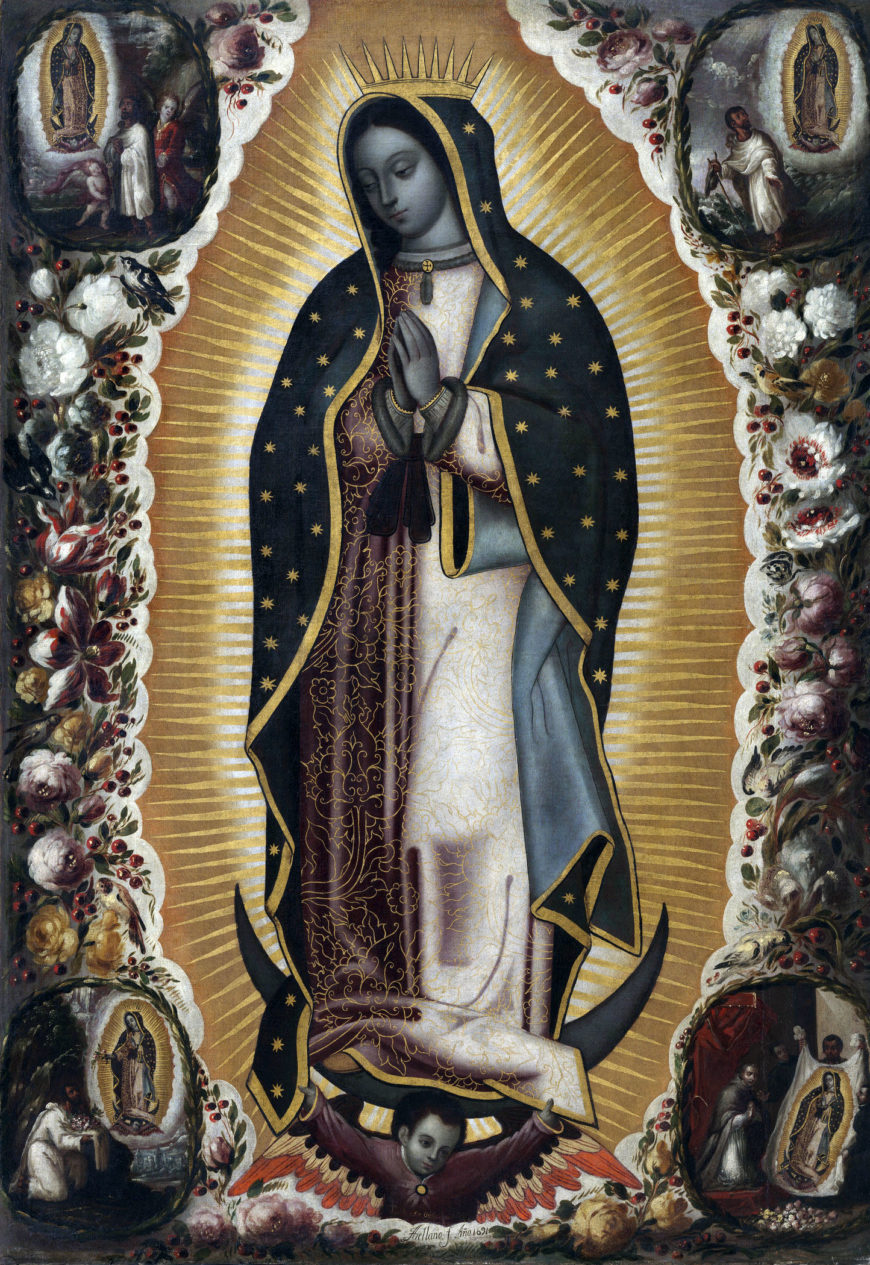
Initially, devotion to Guadalupe was primarily local. Yet veneration of Guadalupe increased, especially because people attributed her with miraculously interceding on their behalf during calamitous events. For instance, she was thought to assist in ending a flood in Mexico City in 1629 and an epidemic that ravaged the population of the capital between 1736-37. After the 1737 epidemic subsided, Mexico City declared her patron of the city. In 1746, Guadalupe was even declared the co-patroness of New Spain along with St. Joseph, and Pope Benedict XIV granted a feast day and mass in her honor for December 12 in the year 1754.
She was so revered that people of different social and ethnic backgrounds paid her reverence. In particular, creoles (pure-blooded Spaniards born in the Americas) promoted her devotional cult. They wrote some of the earliest texts recounting her miraculous appearance on Novohispanic soil, a fact they advertised as proof that God blessed the Americas and approved of a new nation. To support this notion, artists often included the motto “Non fecit taliter omni nationi” (Psalm 147:20—He has not dealt thus with any other nation) into their artworks.
True copies

Images depicting Guadalupe proliferated in the seventeenth century as devotion to her increased. Prints, paintings, and enconchados (oil painting and shell-inlay) replicate the original tilma image. Sometimes artists included inscriptions that mention the representation is a true copy of the tilma image.
For example, Manuel de Arellano writes “After the original” (Tocada el original) on his 1691 version of Guadalupe. This statement suggests that artists based their work on the original image and some of the power of the original image transferred to the replication. Besides replicating the tilma image, artists often included the narrative of the miracle in the four corners of the composition, as Arellano’s and Isidro Escamilla’s version from 1824 demonstrate. Frequently flowers frame the mandorla surrounding Guadalupe, a direct reference to the Castilian roses in Juan Diego’s tilma.
To prove further that New Spain was equal to Europe, some of the most famous artists of the eighteenth century, such as Miguel Cabrera and Juan Patricio Morlete Ruiz, were invited by the clergymen of the Basilica of Guadalupe to inspect the image on April 30, 1751 to authenticate that the image was indeed miraculous. In 1756, Cabrera published the result of this inspection as Maravilla Americana (American Marvel) in which he declared that the tilma image was indeed an acheiropoieta.
Guadalupe and national identity
Other visual motifs further communicate the political connotations with which Guadalupe increasingly became linked. For instance, some artists placed an eagle perched on a cactus below Guadalupe, which had long functioned as a sign for the establishment of the Aztec capital of Tenochtitlan that became Mexico City after the Conquest. Guadalupe’s connection to creole identity and the creole desire for Mexican independence was solidified after father Miguel Hidalgo raised a liturgical banner of Guadalupe during his cry for independence in 1810.
Additional resources:
Manuel de Arellano’s Virgin of Guadalupe at LACMA
Isidro Escamilla’s Virgin of Guadalupe in the Brooklyn Museum
Shrine of Guadalupe in the Catholic Encyclopedia
Director’s Journal: The Virgin of Guadalupe (video from the Indianapolis Museum of Art)
SmartHistory images for teaching and learning:

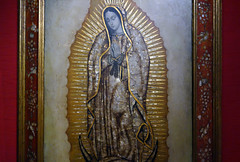

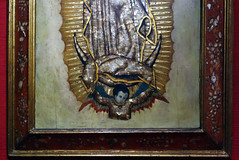
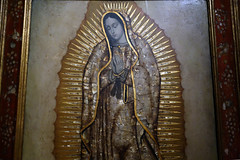
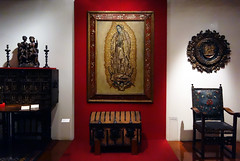
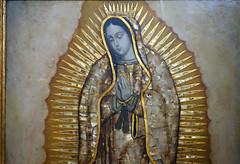
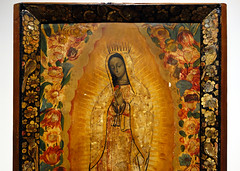
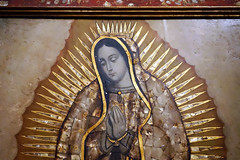
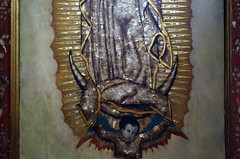
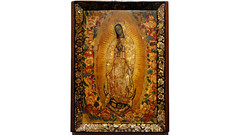
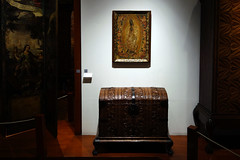
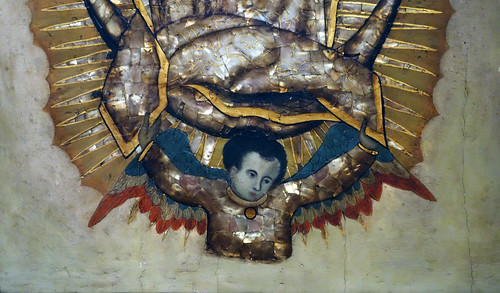
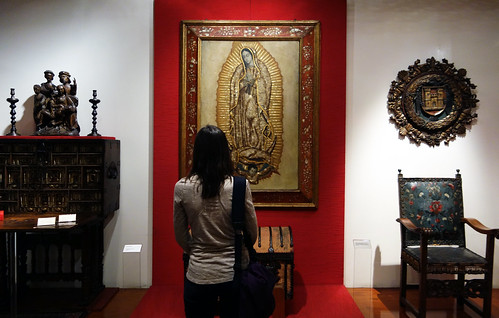
16th century
Hispaniola’s early colonial art, an introduction
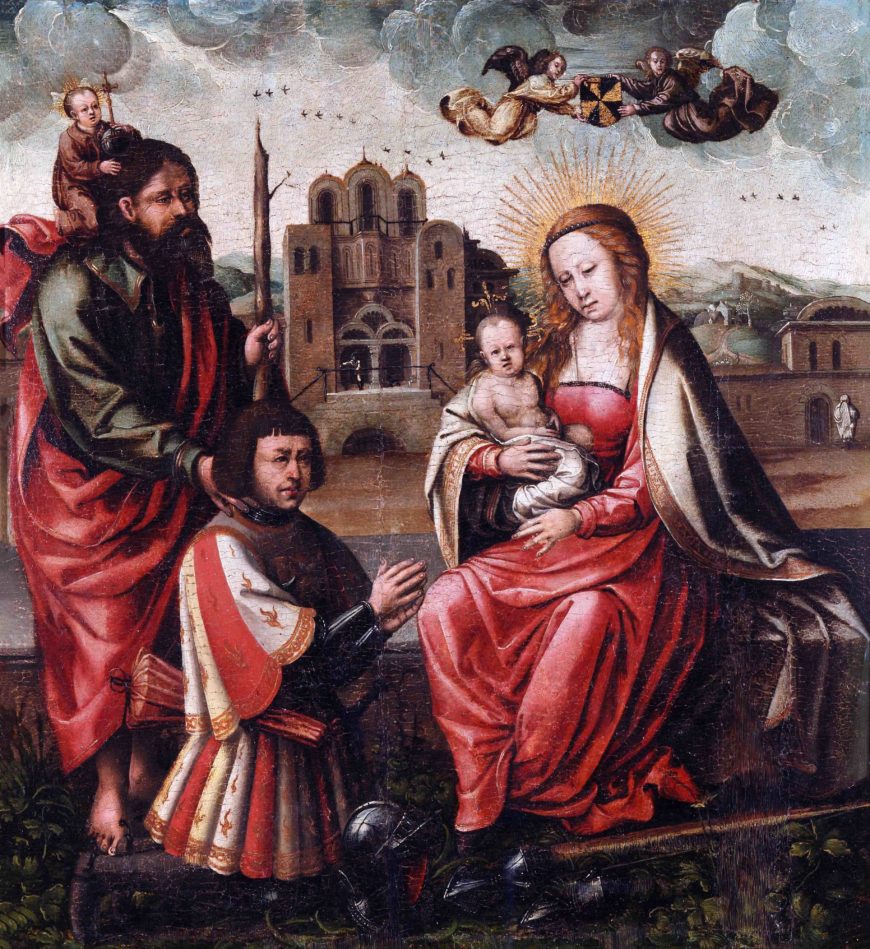
In the Lázaro Galdiano Museum in Madrid, a small painting shows Saint Christopher presenting Christopher Columbus to the Virgin Mary and Christ child. Columbus wears a gold-braided waistcoat inscribed with the Spanish heraldic motto of “Plus Ultra” (“Further beyond”—a Latin phrase and the national motto of Spain) over an armored suit.[1] The Basilica Cathedral Santa María la Menor of Santo Domingo—recognizable by its double-arched doorway—dominates the background.
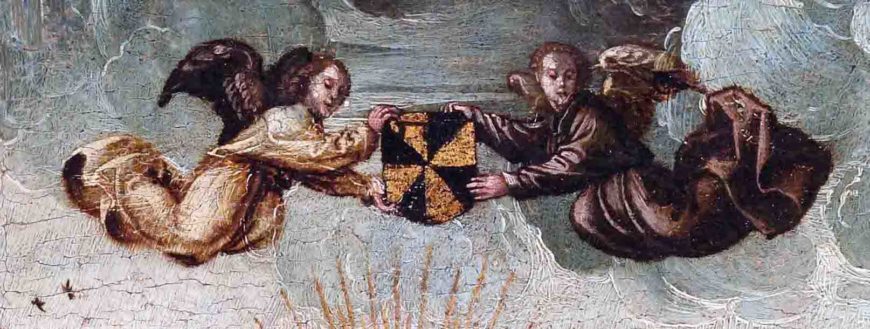
Two angels float above the Virgin and carry the insignia of the Dominican Order, calling to mind the name of the city, Santo Domingo (Saint Dominic in English), the capital of the Caribbean island that Columbus named La española (eventually Hispaniola), named in honor of Spain, which had financed Columbus, and which Taíno peoples called Ayiti or Kiskeya. Today the island contains two nations, Dominican Republic and Haiti.
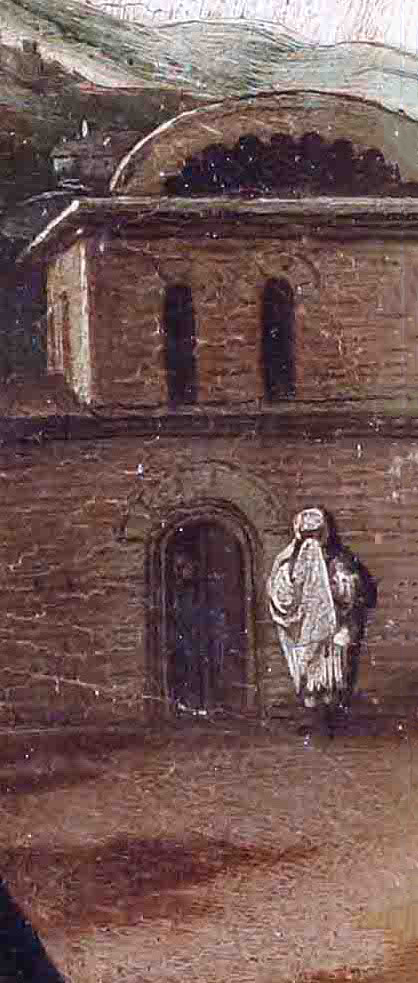
The association of Santo Domingo with the Dominican order relates to the foundation of the city on the eastern banks of the Ozama river (by Columbus’s brother, Bartolomé) on the feast day of Saint Dominic of Guzmán, who founded the Dominican Order in 1216. The day coincidentally happened to be Sunday (in Spanish, Domingo), and the name of Columbus’s father was Domenico (Domingo, in Italian)— sealing the choice of the name for the city.
One figure in the background of the painting might strike the viewer as out-of-place because he is dressed in a turban and tunic. Yet this “Moorish” dress was not uncommon in Spain, especially because Muslims had controlled most of the Iberian peninsula (today Spain and Portugal) for hundreds of years. What is less well known is that enslaved black Moors (Muslim inhabitants of Iberia) had been in Hispaniola since at least 1550 despite a royal prohibition. A letter (dated 1550) from Santo Domingo officers to the crown asks the king to exempt the (at least) 100 enslaved Moors of Hispaniola from the 1543 royal prohibition because they performed various trades.[2] Under the watchful gaze of this turbaned figure, Columbus surrenders his helmet, gauntlets, and spear at the feet of the Virgin, offering her the first Christian city of the Americas.
This painting reveals the early European interest in picturing the so-called “New World” (many people were unable to travel to the Americas, but wanted to see what it looked like). The turbaned figure also stands as a reminder to peninsular viewers (or people living on the Iberian Peninsula) of threats to Christian dominance. The final Muslim stronghold on the Iberian Peninsula only fell to the Spanish Catholic Monarchs in 1492, followed by the expulsion of Muslims and Jews who refused conversion to Christianity. In the painting, the turbaned figure provides a justification for the colonization of the Americas.
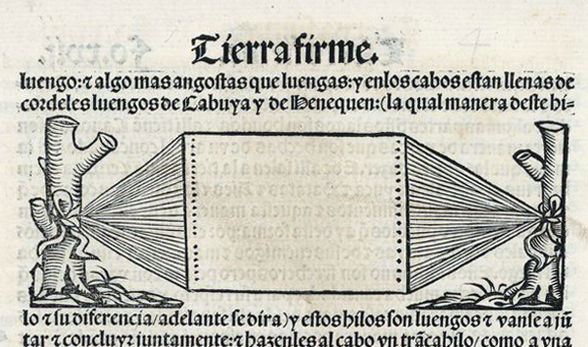
It is possible the painter worked in Seville as part of the large picture-making industry dedicated to producing religious images (especially of the Virgin Mary) to aid in conversion in the Americas. The artist would not have seen Santo Domingo firsthand, but learned about it from images or written accounts. A letter Columbus sent announcing the news of the “discovery” included, in its different editions throughout Europe, several engravings depicting America and its inhabitants. Royal chronicler Gonzalo Fernández de Oviedo’s Natural and General History of the Indies also introduced Europeans to the fauna, flora, and peoples of Hispaniola, which he had observed in person. His book included the first illustrations of the pineapple, the hammock, the barbecue, and tobacco.
A Blueprint for Colonization
The European invasion and colonization of the Americas was launched in 1492 from Hispaniola. For sixteen years, Hispaniola was Spain’s only active colony in the hemisphere, making the lessons learned on the island an important part of the playbook for colonizing elsewhere in the Americas. In 1493, Columbus and his crew arrived after the second voyage ready to establish a trading post in the style of Portuguese feitorias (factories), which were fortified, coastal trading houses that the Portuguese set up in west Africa to monopolize trade in gold and enslaved peoples. They served as warehouses and customs agencies mediating exchange between local trading networks and European monarchs. The second voyage also brought Franciscan missionaries who would begin the process of conversion; by 1500 they had baptized 3,000 Indigenous people.
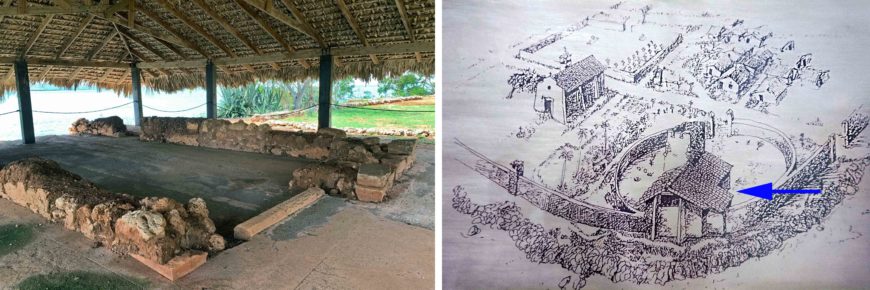
La Isabela, the first European settlement of the Americas, was founded on January 6, 1494 in today’s Puerto Plata province (in northern Hispaniola), after the celebration of a mass during which Amerindians first saw a sculpture of the Virgin Mary in the context of Catholic liturgy. The experiment at La Isabela failed after four years because the all-male settlement suffered starvation, absences by Columbus who left to explore Cuba, indigenous resistance, and a mutiny led by Columbus’s former servant, Francisco Roldán.
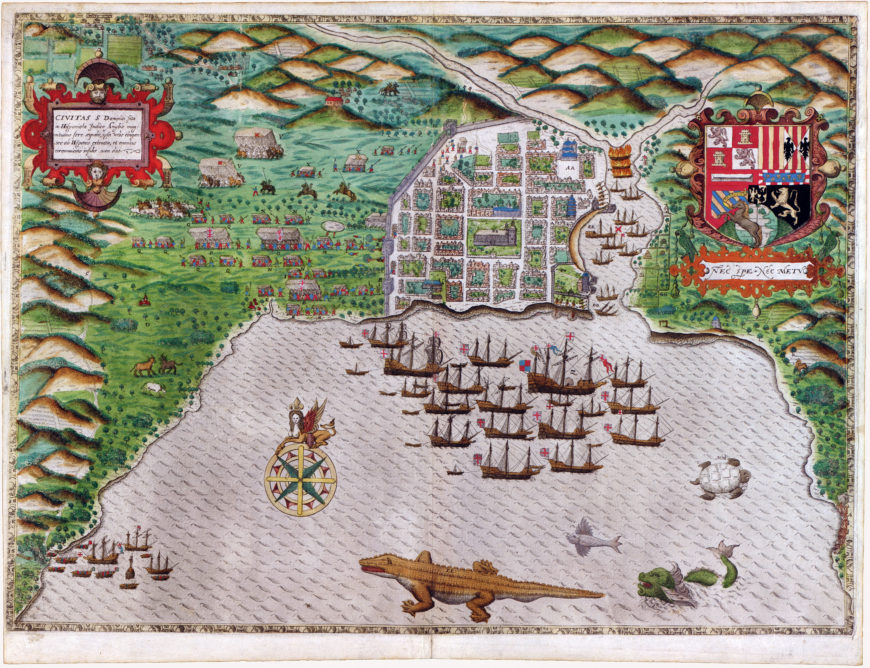
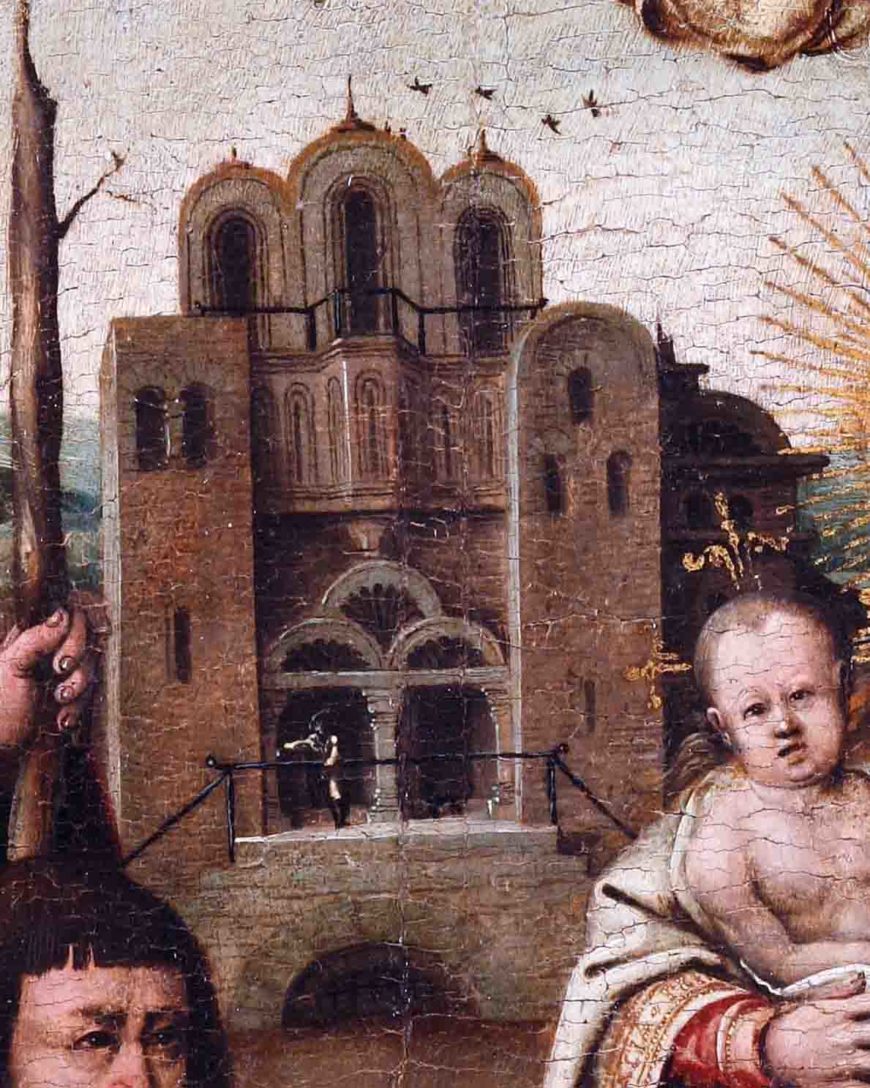
Before La Isabela failed, the Spanish monarchy had ordered the change of the site’s status from trade post to a fully imperial venture in a move to centralize power.[3] This change tells us that the Spanish monarchs wished to expand their empire. With a defined, imperial venture in mind, governor of the Indies Nicolás de Ovando arrived on the island with 2,500 colonists, and founded Santo Domingo proper in 1502 after moving it to the western banks of the Ozama river. He developed the city using a rectilinear grid known as a traza, which anchored church, elite residences, and government buildings around a main plaza, with streets meeting at right angles. This organization had several advantages including peripheral and internal surveillance, and possibilities for expansion. With its ideal proportions, the traza symbolized the idealized civility and order of classical Rome. The work of ancient Roman architect Vitruvius enjoyed a resurgence in fifteenth-century Europe, and Spaniards reproduced this classical architectural language in their own imperial pursuits. Before the Americas, they implemented the grid model to subjugate the Canary Islands, as well as in the military encampment of Santa Fe de Granada on the eve of the final battle to recapture Spain from Muslim control. Another source for urban planning in the early Spanish Americas was the prophet Ezekiel’s vision of Heavenly Jerusalem which offered the Spanish crown the opportunity to promote Santo Domingo as the heavenly city, thus raising its political and religious stature.
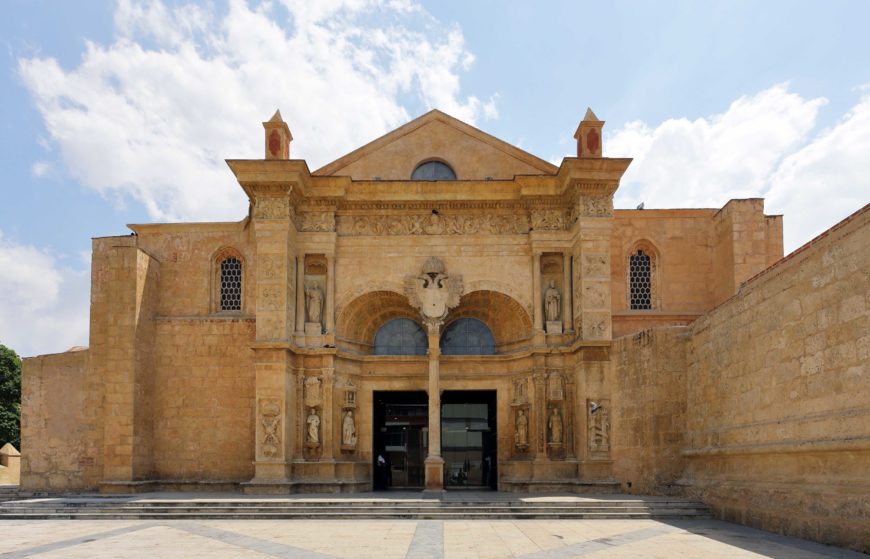
The Cathedral Basilica of Santo Domingo was important to the city’s early urban development—it was the center of city life. Construction of the Cathedral began in 1514 (possibly 1523) and finished in the 1540s, well after the city’s residents had begun to emigrate to newly conquered territories. The coral limestone façade featured a pediment and portico—elements borrowed from classical architecture), and prominently displayed the shield of Habsburg Emperor Charles V. Ornamented tabernacles, flanking the double-arched entranceway, houses statues of the apostles, evoking the Spanish empire’s evangelizing mission. This classicizing language fits with other urban elements in the city, such as the traza (the grid structure).
Virgen de la Antigua in Santo Domingo Cathedral
Early colonial artworks found inside the Cathedral speak to the transatlantic crossings of popular Iberian religious images and devotions. In his book, Oviedo, the Royal chronicler, writes,
“a large image of our Lady of Antigua, today in the main church of this city in the altar next to the sacristy, copied from the image of Antigua in the main church of Seville.”[4]
According to Oviedo, the painting was placed in the Cathedral of Santo Domingo in 1523 after captain Francisco Vara (from Seville) found it floating in the Caribbean ocean, the only object retrieved from his vessel’s shipwreck.
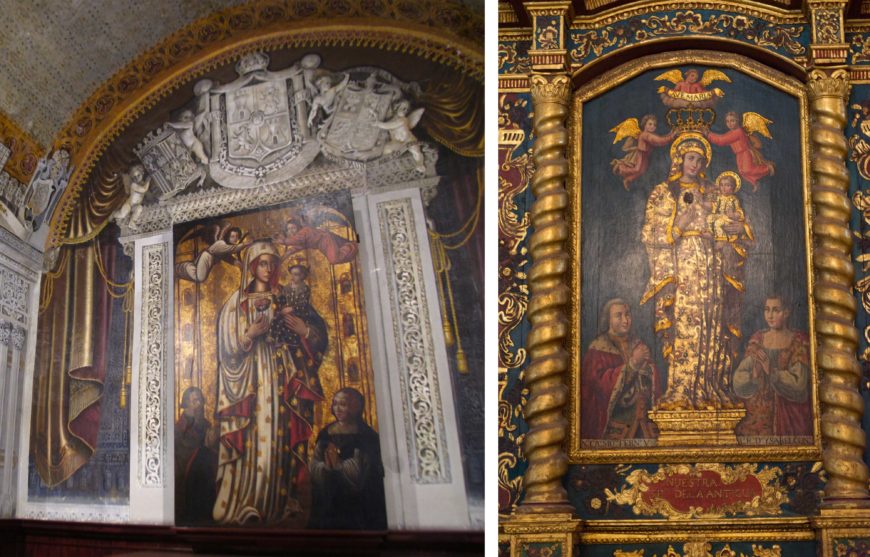
This painting is likely one that hangs in the Santo Domingo Cathedral today, displayed on the left side of the main entrance. It features a standing Virgin, carrying the Christ child with her left arm and a flower in her right hand. Two angels hover above her head holding her crown, and two unidentified donors appear below.[5] Diagonally across from this painting, on the right side of the presbytery, another Virgen de la Antigua painting with similar iconography can be seen, except that the donors pictured in the lower segment are the Spanish monarchs Ferdinand and Isabel.[6]
The Virgen de la Antigua was a popular form of the Virgin Mary in Spain, and stories circulated of her miraculous intervention on behalf of Christian kingdoms during the Reconquest. In one of the decisive battles in the 13th century, the image of the Virgen de la Antigua allegedly appeared in a vision to Fernando III of Castile as a mural painting inside a mosque in Seville, signaling an imminent victory against Muslim forces. Her image eventually traveled to the Americas as part of Europe’s colonial expansion in the 16th century. Devotion to her inspired votive offerings thanking or petitioning the Virgin for a safe passage, such as we see in the two paintings in the Cathedral today. Devotees also visited the image in the cathedral to implore her protection against storms and catastrophes as people coped with the unpredictability of nature.
In this early period, a great deal of art was produced in Spain for shipment to Hispaniola. Much of it was religious, made for Christian liturgical and devotional purposes. Still, there would have also been secular portraiture, sumptuous textiles, and other movable objects (like furniture) that marked the owner’s social standing. While commercial painters in Seville produced many of the works that arrived during the early colonial period, some were made by more prominent artists and their workshops, such as Alejo Fernández and Juan Martínez Montañes. Much of this early art no longer survives unfortunately. Owners emigrated with their art, storms destroyed work, and the Francis Drake’s sacking of Santo Domingo in 1586 led to the disappearance of some early colonial art as well.
Reception of Images
Art that arrived in Hispaniola aboard the first Spanish fleets forced a reckoning between cultures that did not understand or use images in the same way. In one infamous encounter, Taínos seized an image of the Virgin from an oratory, buried it in a field, and urinated on it. Seeing the incident as an insult, Columbus’s brother ordered the natives burned alive. Catalonian Hieronymite friar Ramón Pané recounts this story in the opening of his ethnographic report, An Account of the Antiquities of the Indies (completed in 1498), to suggest Taíno idolatry.[7] For the Taíno however, the venerated image could fertilize the ground just like a zemi (sculptures of wood, stone, or clay, that sheltered deities or ancestral beings). Art historian Amara Solari suggests that Taíno believed that the Marian icon embodied precontact numinous (supernatural or holy) qualities, allowing them to transpose the zemi and Christian icon.
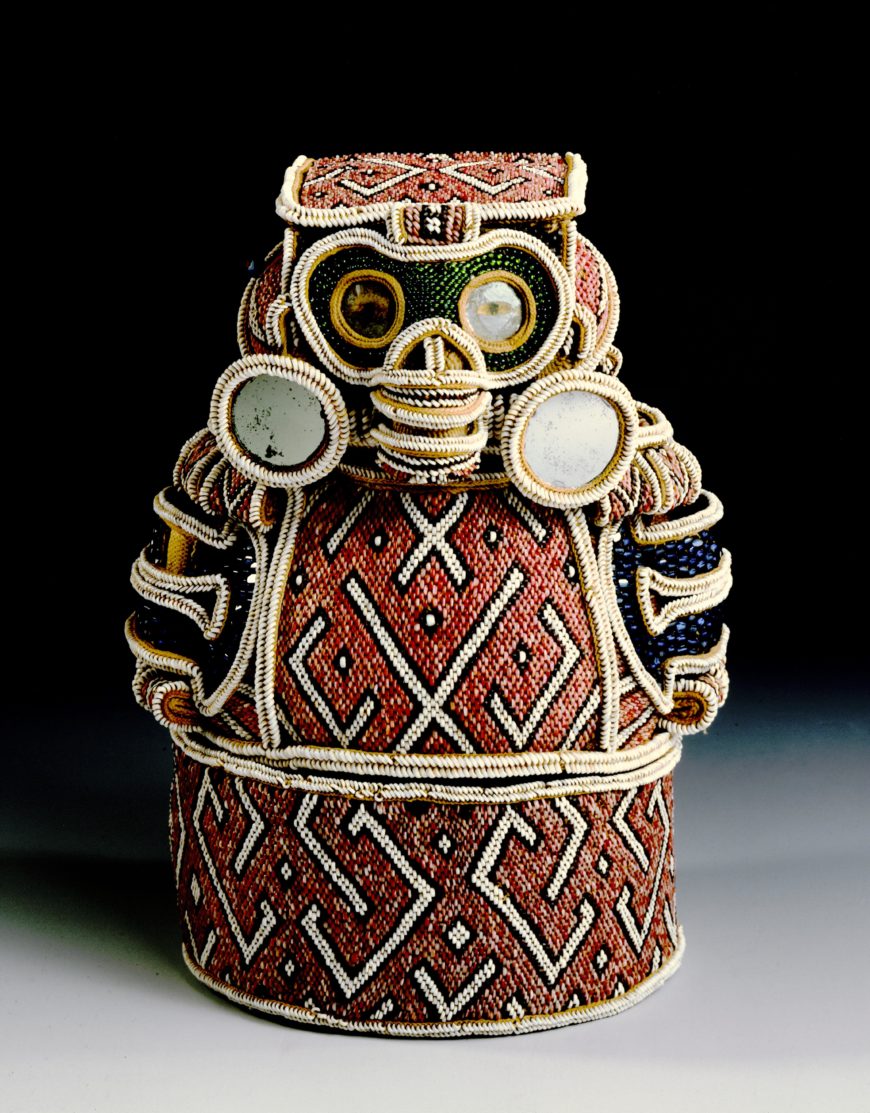
False starts like these, the persecution of so-called idolatry, and the near genocide of the Taíno within the first fifty years of European arrival (due to diseases and cruel labor practices), doomed the potential development of transcultural aesthetics (the merging of cultural elements into a completely new iteration) during the early colonial period. Still, one surviving zemi (called the Pigorini zemi) hints at the ways different cultures and visual systems converged during the early colonial era. Its mix of African rhinoceros horn and European glass beads demonstrate the different cultures, artistic practices, and materials that convened in Hispaniola.
![Diego Valadés, “Friar Preaching to Native Converts,” 1579, copperplate engraving, within Rhetorica Christiana ad concionandi et orandi usum accommodate […] ex Indorum maximè deprompta sunt historiis. Perugia: Petrus Jacobus Petrutius, 1579.](https://smarthistory.org/wp-content/uploads/2019/10/Houghton_Typ_525.79.865_-_Rhetorica_christiana_Diego_Valade%CC%81s_211-870x1195.jpg)
Political, religious, and social indoctrination via Christian images was a strategy deployed by conquistadors and clerics since the early days of contact. Due to language barriers, images became important teaching aids in Spain’s missionary enterprise. An engraving by Diego de Valadés in Rhetorica Christiana (Christian Rhetoric) shows a Franciscan friar in New Spain preaching on a pulpit to a crowded assembly of natives. He points to the lienzos (painted cloths) with a stick, showing how images were useful for religious conversion.
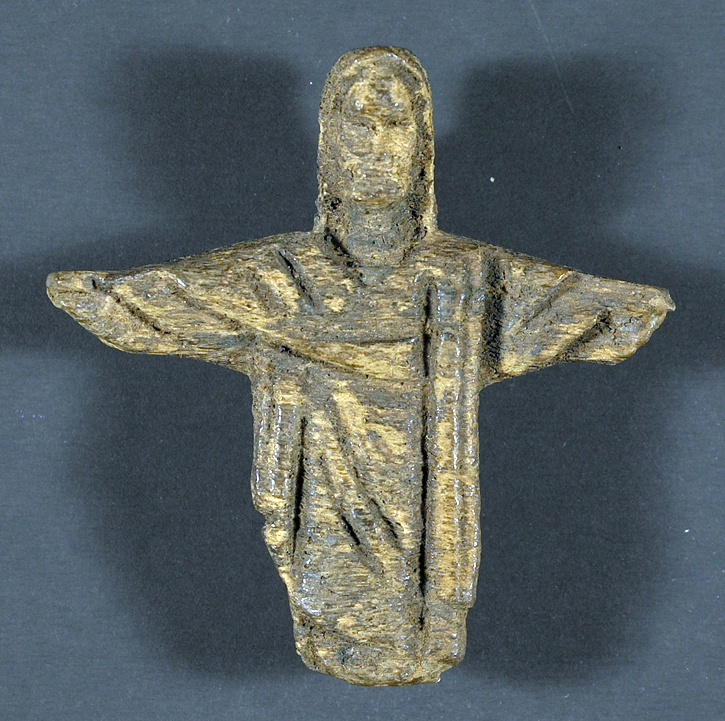
Archaeological material can help us learn about the use of images and spaces for instruction and religious conversion in Hispaniola. A fragment of a small wooden sculpture of Christ found in San Rafael Cave in Santo Domingo is a type of religious prop employed in this exchange. Chapels or private oratories (small chapels for private worship) in the estates of encomenderos could have also functioned as early conversion sites after the Laws of Burgos of 1512 ordered that Spaniards build churches within their haciendas and display images to instruct the Taíno.
Hispaniola was the first point of long-term contact between the cultures of Europe, America, and Africa. The visual and material culture, such as paintings of Marian miracles, helped people stake territorial and identity claims. More research is needed to bring to light the production and reception of art by Amerindians, Africans, and mixed-race peoples, as well as to fully illuminate the implications of early Hispaniola’s role in subsequent colonial schemes.
Notes:
[1] Emilio Rodríguez Demorizi, España y los comienzos del arte y la escultura en América (Santo Domingo: Gráficas Reunidas, 1966), pp. 95-96.
[2] See José Antonio Saco. Historia de la esclavitud de la raza africana en el nuevo mundo y en especial en los países américo-hispanos. Habana: Cultural, 1938. Vol. I, pp. 305–306.
[3] Pauline Kulstad-González, Hispaniola: Home of Hell? Decolonizing Grand Narratives about Intercultural Interactions at Concepción de la Vega (1494–1564) (Sidestonepress, 2020).
[4] Oviedo, Historia de las Indias, Madrid, 1855, Vol I, 426.
[5] The painting is dated to c. 1520–1523 by Dominican art historian, Danilo de los Santos, in Memoria de la pintura Dominicana: Raíces e impulso nacional, Vol. 1 2000 AC 1924 (Santo Domingo: Grupo E. León Jiménez, 2003), 100. Santos, quoting the Marques de Lozoya (in Demorizi, España y los comienzos del arte, 1966, p. 9) writes that this is the oldest version of La Antigua in the country. Santos associates this painting with Oviedo’s story about a painting of La Antigua surviving a shipwreck. Demorizi, however, dates the painting to 1500, p. 50.
[6] Demorizi dates this painting to 1520. See Demorizi, España y los comienzos del arte, 101. Additionally, according to a publication by the Fundación de la Zona Colonial, this is the panel that Oviedo says was rescued from a shipwreck, and it was brought to Santo Domingo in 1527. See Arte Sacro Colonial en Santo Domingo (Santo Domingo: Amigo del Hogar, 2002), pp. 38 and 16 [No sources offered].
[7] Ramón Pané, Relación acerca de las antigüedades de los indios, 53–54. As seen in Gruzinski, Images at War, footnote 24.
Additional resources
Alemar, L. La Catedral de Santo Domingo: Descripción Histórico-Artístico Arqueológica de Este Portentoso Templo, Primada de Las Indias. Barcelona, Spain: Casa Editorial Araluce, 1933.
Brown, J. “Spain in the Age of Exploration: Crossroads of Artistic Cultures.” In Circa 1492: Art in the Age of Exploration, ed. J. Levenson, 41–43. Washington DC: National Gallery of Art and New Haven, CT: Yale University Press, 1991.
Conley, Tom. “De Bry’s Las Casas.” In Amerindian Images and the Legacy of Columbus. R. Jara, N. Spadaccini, eds. Minneapolis and London: University of Minnesota Press, 1992.
Deagan, Kathleen A., and Jose Maria Cruxent, Archaeology at La Isabela: America’s First European Town. New Haven: Yale University Press, 2002, accessed July 5 2020.
De los Santos, Danilo. Memoria de la pintura dominicana. Santo Domingo: Grupo E. León Jimenez, 2005.
Fernández de Oviedo y Valdes, Gonzalo. Historia general y natural de las Indias. Madrid: Real Academia de la Historia, 1851.
Gaudio, Michael. Engraving the Savage: The New World and Techniques of Civilization (Minneapolis: University of Minnesota Press, 2008)
Guitar, L. 2006. “Boiling it Down: Slavery on the First Commercial Sugarcane Ingenios in the Americas (Hispaniola, 1530–45).” In Slaves, Subjects, and Subversives: Blacks in Colonial Latin America, eds. J. Landers and B. Robinson, 39–82. Albuquerque, NM: University of New Mexico Press.
Gruzinski, Serge, Images at War: Mexico from Columbus to Blade Runner (1492-2019), transl. Heather McLean. Durham: Duke University Press, 2001.
Kagan, Richard. Urban Images of the Hispanic World 1493-1793. New Haven, London: Yale University Press, 2000.
Kulstad-González, Pauline M, Hispaniola: Home or Hell? Decolonizing Grand Narratives about Intercultural Interactions at Concepción de la Vega (1494-1564) Sidestone Press Dissertations, 2020.
Matthew, Restall, and Lane, Kris. Latin America in Colonial Times. Cambridge: Cambridge University Press, 2018.
Niell, Paul. Caribbean Art and Architecture under Spanish Colonial Rule (1492-1898). Oxford Art Online, 2018. Accessed as of August 8, 2020, https://doi-org.proxy.lib.fsu.edu/10.1093/oao/9781884446054.013.2000000077
Niell, Paul, “The Late Gothic,” Postmedieval: a journal of medieval cultural studies (2015) 6, 243–257. doi:10.1057/pmed.2015.23
Ostapkowicz, Joanna, Fiona Brock, Alex C. Wiedenhoeft, Rick Schulting & Donatella Saviola, “Integrating the Old World into the New: an “Idol from the West Indies”. Downloaded from https://www.cambridge.org/core. IP address: 90.202.6.114, on 21 Sep 2017 at 15:42:31, subject to the Cambridge Core terms of use, available at https://www.cambridge.org/core/terms. https://doi.org/10.15184/aqy.2017.151
Otte, Enrique, “La flota de Diego Colón. Españoles y genoveses en el comercio trasatlántico de 1509”, Revista de Indias, Madrid, 1964, No. 97-98, 475.
Palm, E. 1945–1946. Plateresque and Renaissance Monuments on the Island of Hispaniola. Journal of the Society of Architectural Historians 5: 1–14.
Palm, E. 1944. Rodrigo de Liendo: Arquitecto en La Española. Ciudad Trujillo, Dominican Republic: Editorial ‘La Nación,’ de Luis Sánchez Andújar.
Rodríguez Demorizi, Emilio. España y los comienzos de la pintura y escultura en América. Santo Domingo: Gráficas Reunidas, 1966.
van Groesen, Michiel, “The de Bry Collection of Voyages (1590–1634): Early America reconsidered,” Journal of Early Modern History 12 (2008): 1–24.
Waldron, Lawrence. Pre-Columbian Art of the Caribbean. Gainesville: University of Florida Press, 2019.
Classical Architecture in Viceregal Mexico
by DR. JUAN LUIS BURKE
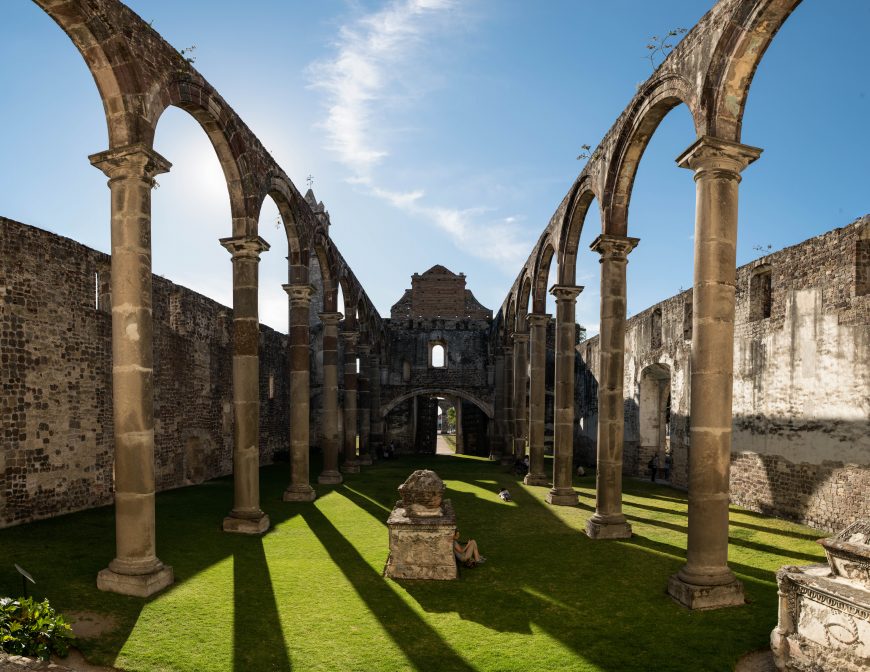
The Renaissance — not just in Italy
The term “renaissance” generally invokes images of Italian cities, buildings, and artworks, rather than images of American ones. However, the renaissance had tremendous repercussions on the American continents, and its influence can be found from Philadelphia to Buenos Aires. In fact it might be more useful to think of the renaissance not as a European phenomenon at all, but as a wide-ranging cultural movement that centered on the rebirth and rediscovery of classical (ancient Greek and Roman) culture that sparked many innovations and changes in architecture, urbanism, pictorial art, theatre, science, literature, and more.
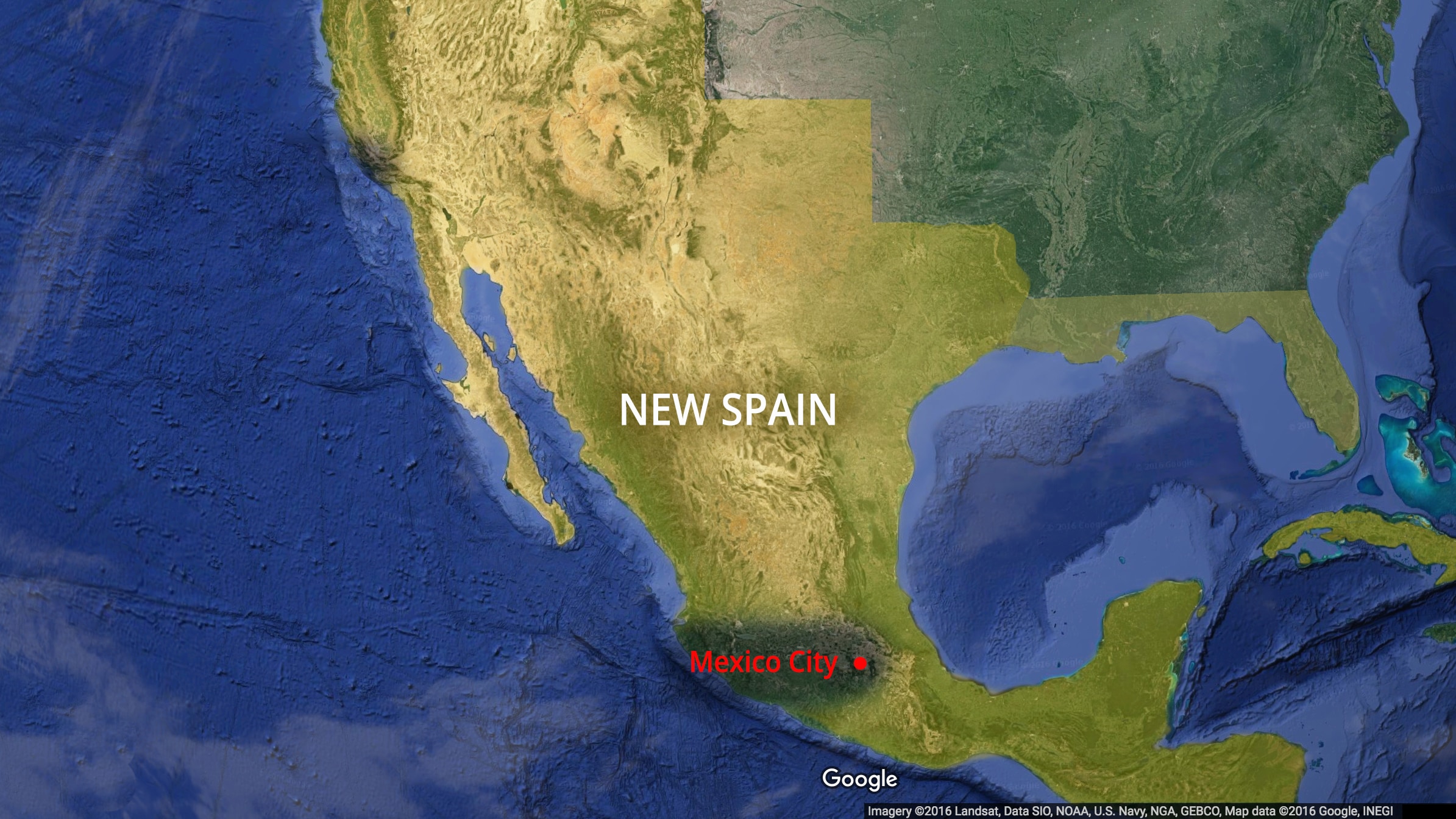
Cities, buildings, and architects in New Spain
Spanish colonizers and criollos believed that adopting specific classicizing architectural styles from Europe helped to give their civic and religious buildings a sense of proper decorum. The idea of what constituted decorous architecture derived from Greek and Roman philosophical and architectural sources, including those written by Aristotle, Cicero, St. Augustine, and even Isidore of Seville.
In the sixteenth century, cities were considered to embody an ideal of sophisticated and refined living. This is an ancient idea that took root among peoples in Spain during the medieval period. In the Hispanic world, the term for this idea of a civilized urban center was policía (which derives from the ancient Greek term polis, meaning city). This idea of the ordered urban center was brought to the Americas where the structure and building of cities became one of the most important colonizing strategies of the Spaniards.
One of the regions in the Americas that saw a resurgence of classical culture was Mexico. From the early sixteenth to the early nineteenth centuries, the territory roughly comprised by present-day Mexico, the midwestern and southwestern U.S., and parts of Central America was known as New Spain — a territory claimed and ruled by the Spanish Crown. Throughout this period, towns and cities in the central and southern part of New Spain (by far the most populated of the territory) grew in size. They were inhabited by a diverse population that included Spanish colonizers, criollos (the offspring of Spanish colonizers born in the Americas), indigenous peoples of diverse ethnic origin, Africans (originally brought as slaves, many later becoming freed citizens), small communities of other Europeans, Asians, conversos (Jewish people who had converted to Christianity), and many ethnic mixtures in between.
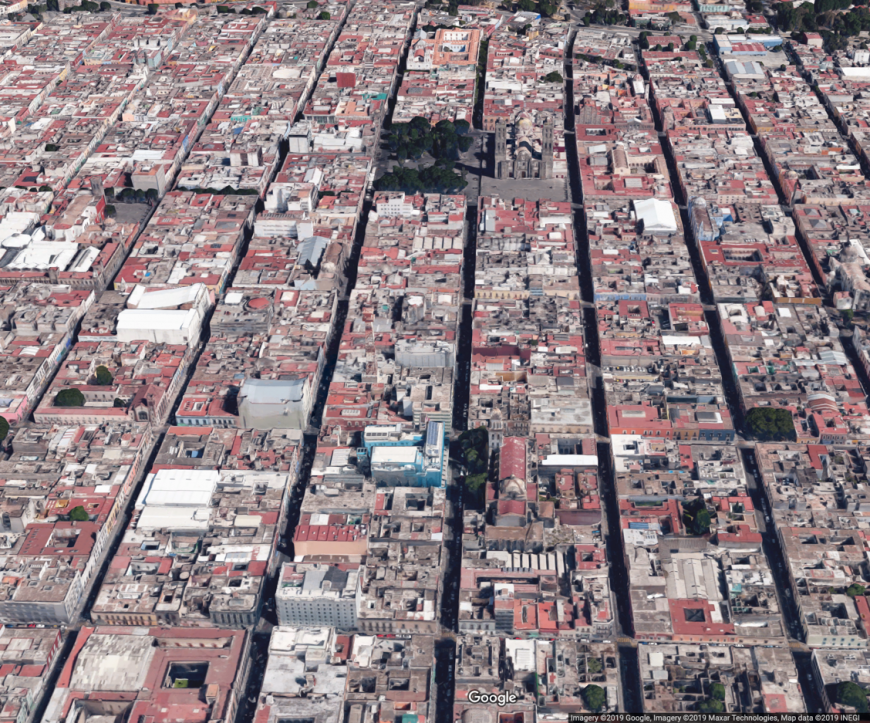
Cities acquired a prominent place in the colonizing strategies of the Spaniards. Spanish colonizers and criollos adopted architectural styles from Europe in an effort to validate their civic and religious institutions. Cities participated in dividing peoples along ethnic lines to create social and racial hierarchies. During the sixteenth century, cities were created for indigenous peoples, while other cities were created for Spaniards and their offspring, in what was a clear segregationist effort on behalf of the Spanish colonizers. Cities for indigenous peoples were termed repúblicas de indios, while repúblicas de españoles was the term employed for cities destined for European colonizers and their offspring. In the repúblicas de españoles — and also in the república de indios, but arguably to a lesser extent — the preferred architectural language of the most representative buildings was classical in style.
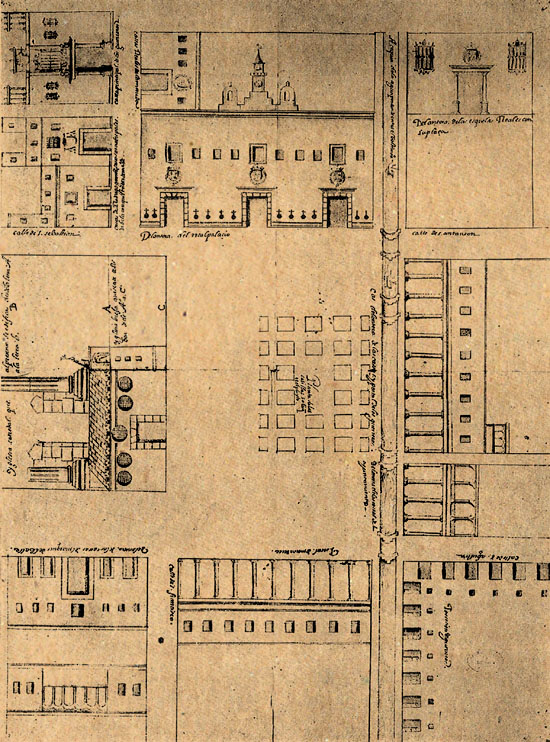
Residences for elite families or buildings such as city halls, educational institutions, and hospitals, drew from classical architectural sources. In a plan of Mexico City’s central square drawn in 1596, we can see that some of the most important buildings of the city had portals with classical elements such as columned porticoes. Mexico City at the time must have been (architecturally speaking) reminiscent of towns in the Iberian Peninsula (such as Trujillo or Cáceres, both in the region of Extremadura, the birthplace of conquerors and architects, like Francisco Becerra).
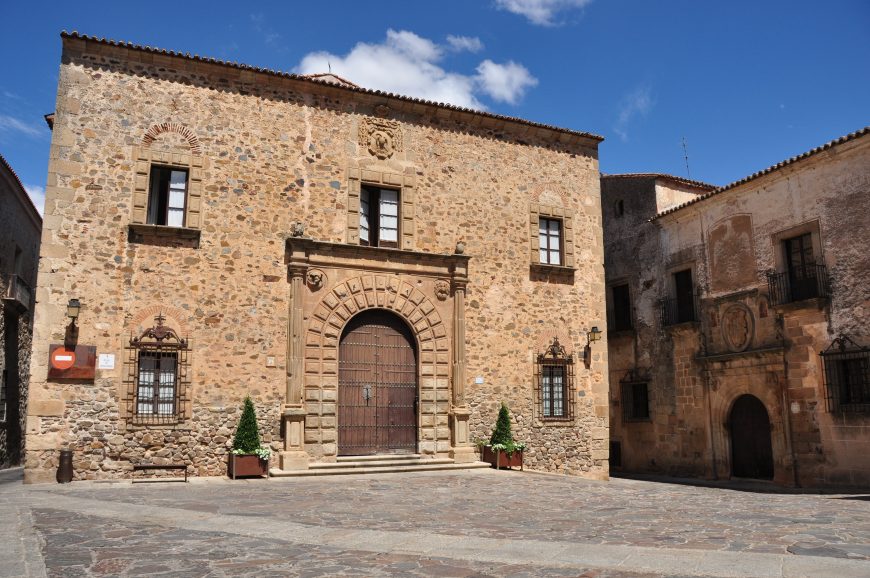
Religious architecture, including cathedrals, monasteries, and church-sponsored buildings such as hospitals and orphanages, were also designed employing the language of classical architecture to indicate proper decorum and appropriateness.
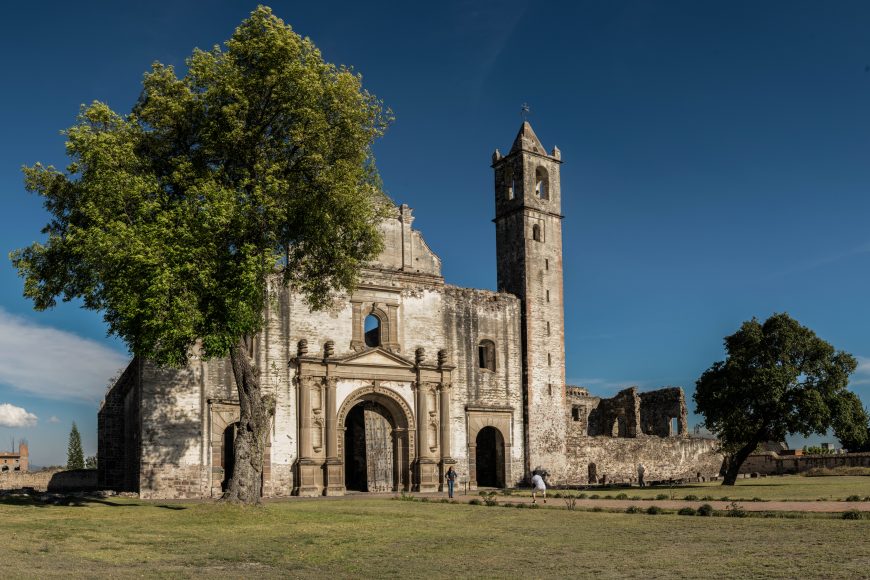
The façade of the Convento de Tecali is considered to be one of the most refined late-Renaissance designs in New Spain. Some elements, like the proportions of the architectural orders, were likely taken from a treatise like the one by Sebastiano Serlio, an Italian architect who published a profusely illustrated treatise in the 16th century, which was extremely influential in both Europe and the Spanish Americas.
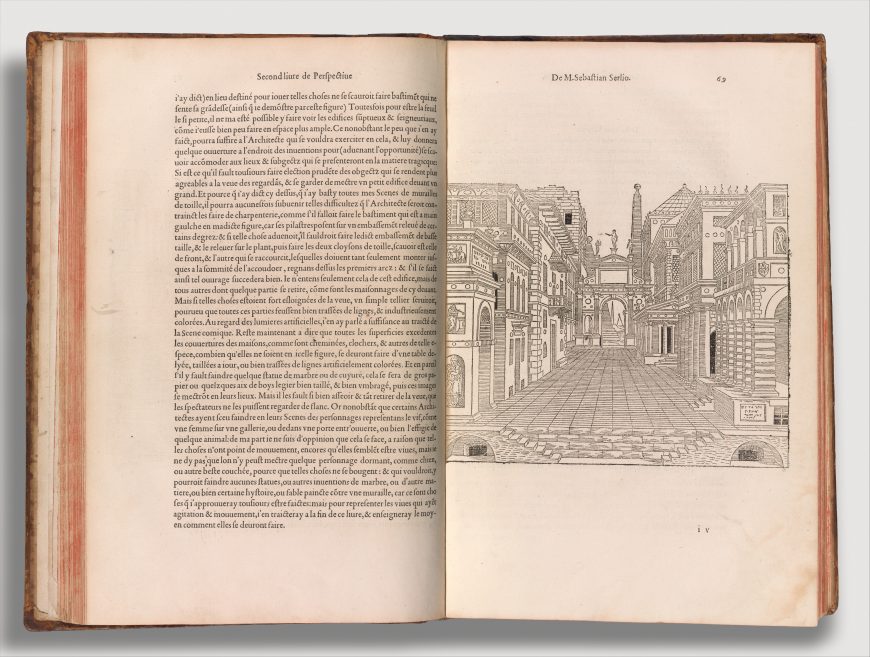
Architects, patrons, and their sources
Some of the first classically trained architects, like Claudio de Arciniega and Francisco Becerra who arrived in New Spain (from Spain) began practicing their trade during the latter part of the sixteenth century. Their presence signaled the arrival of late-Renaissance architecture to the viceroyalty.
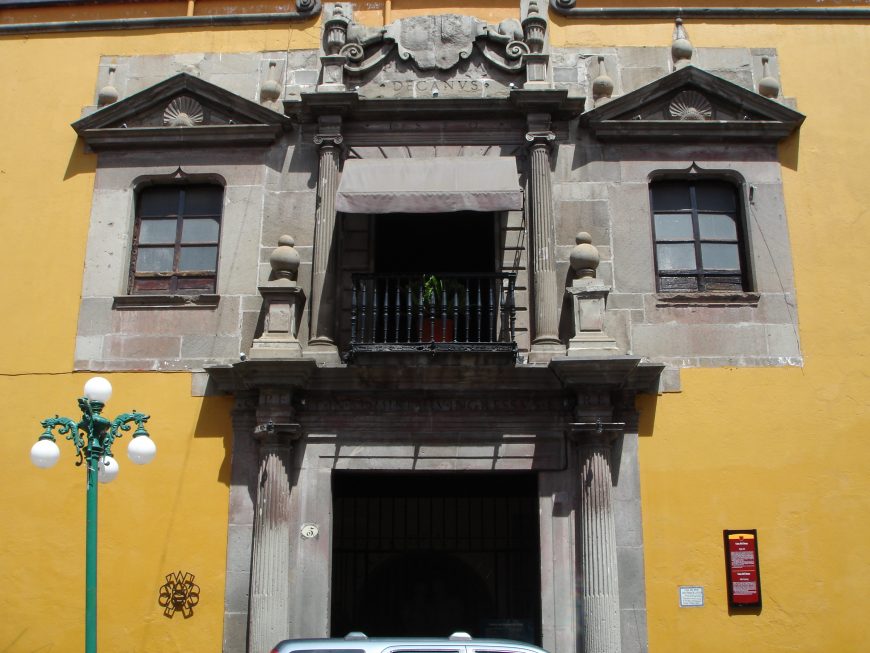
The façade and portal of the Casa del Deán, the residence of the dean of the Cathedral Chapter of the City of Puebla, showcases the classicizing renaissance influences brought to New Spain. The design of this urban palace has been attributed to Becerra, an architect born in Extremadura, Spain. The dean, named Tomás de la Plaza, was known to be a humanist, a person who studied classical literature and culture, which explains his choice of the classical style for his residence.
Even prior to their arrival, the first viceroy of New Spain, Antonio de Mendoza (who ruled from 1535–1550), was well-versed in matters of architecture, and was known to have possessed copies of the architectural treatises by Vitruvius (the ancient Roman architect) and Leon Battista Alberti (the Renaissance architect). These treatises were the most important vehicles of transmission of classical architectural forms. We see the likely influence of these publications in the official architecture that was built during the sixteenth century in the viceroyalty, and the way cities such as Puebla and Mexico City were being designed and developed. For Europeans in New Spain, just as in Europe, these treatises represented the pinnacle of architectural theory; they were the accepted repository of knowledge regarding what classical architecture was, the knowledge needed to practice the discipline of architecture, and the manner of properly designing and constructing buildings and cities.
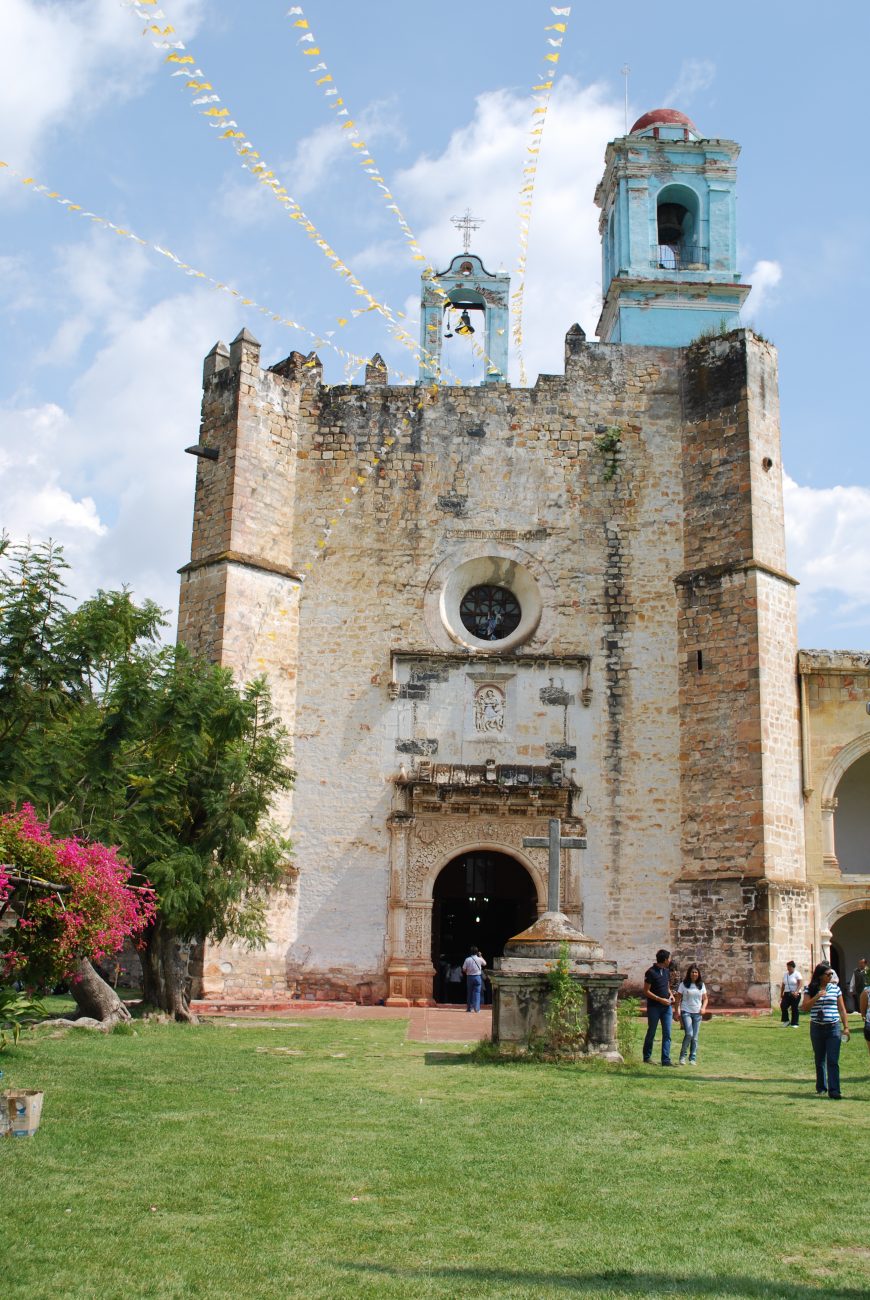
Complicating Classicism
By the start of the seventeenth century, it appeared clear that the classical architectural tradition had taken root. At the same time, it was also clear that the indigenous and mestizo builders, who constituted the bulk of the work force in New Spain, had also established a style of their own. This was especially the case in towns and cities that were more distant from the repúblicas de españoles.
In reality, this architectural style had been there all along, as some of the first monasteries erected by the mendicant missionaries together with the native workers and builders, were fascinating architectural combinations of European influences—including Gothic, Mannerist, Plateresque, Mudéjar, and classicizing Italianate—combined with indigenous traits and attributes.
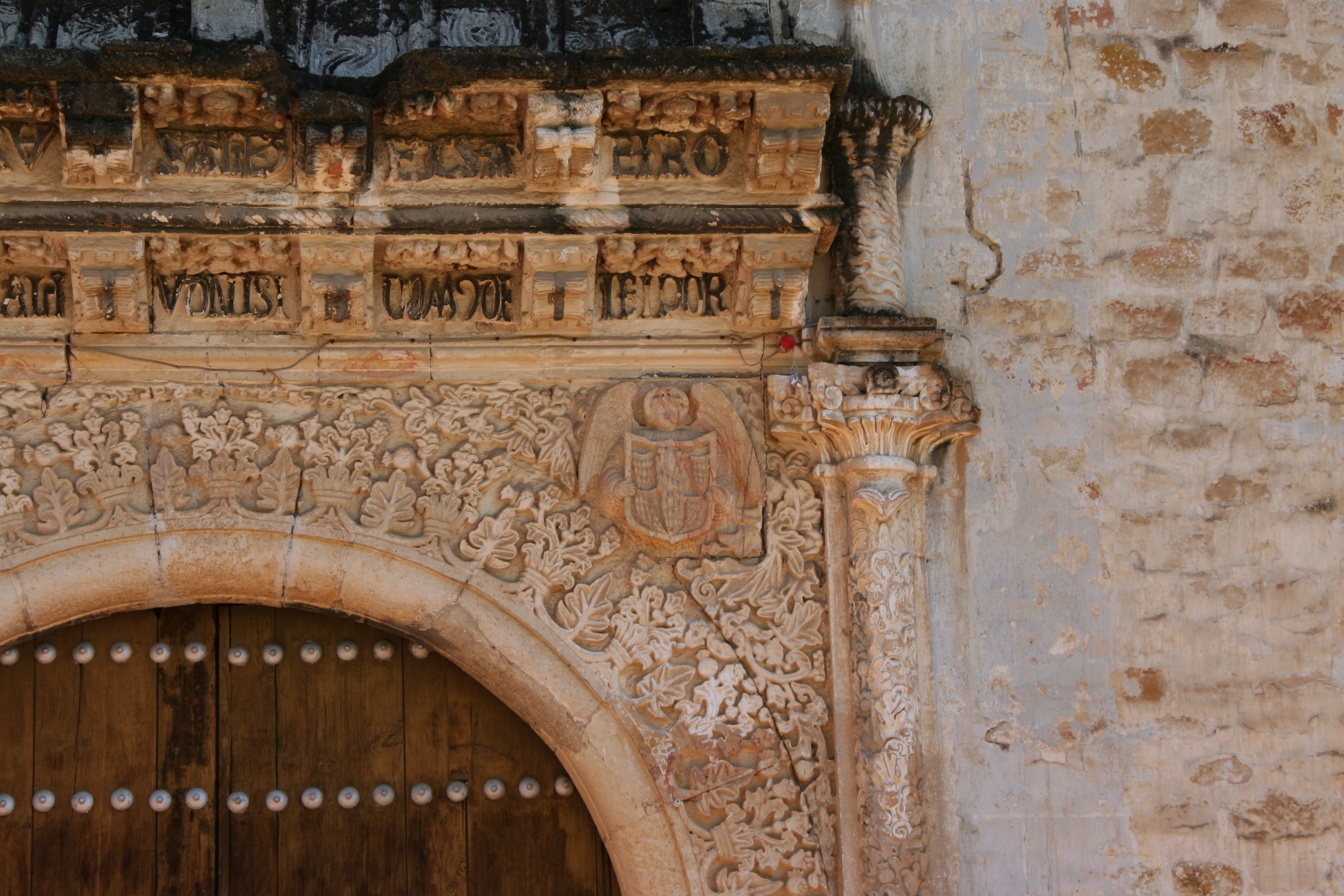
We see this in the façade of the Convento de Huaquechula, for instance, approximately 56 km (35 miles) south of the City of Puebla. It has a main portal of carved stone that displays native sculptural traits, such as floral designs in an indigenous style, in which the stigmata are represented as a native motif of a bleeding wound (center of the image, on the spandrel within a coat of arms held by a cherub). The stigmata was a symbol employed by the Franciscan Order, reminiscent of their founder, St. Francis of Assisi, who received the stigmata. Today, this style has been called at times mestizo, other times hybrid, with no consensus among experts on a definitive term.
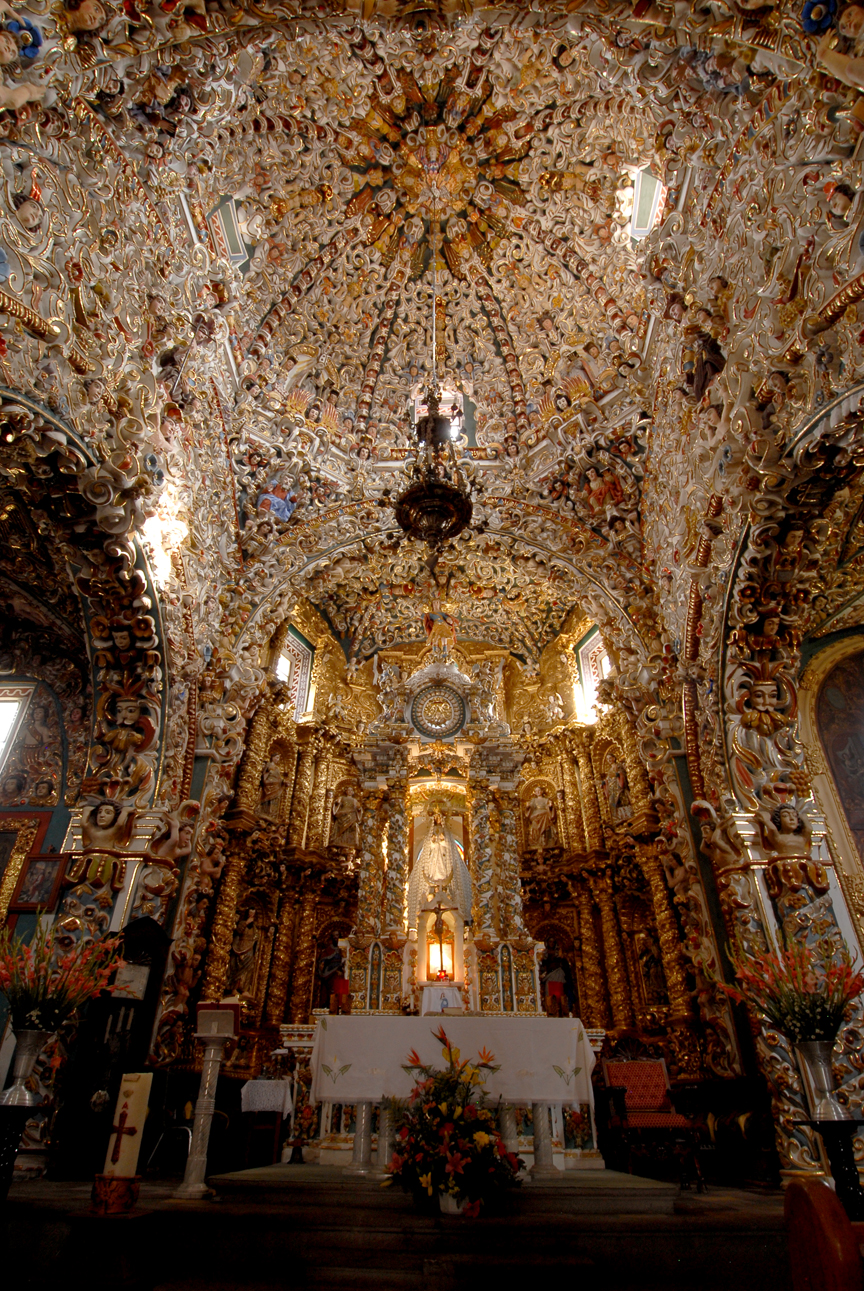
Once the classical language of architecture took hold, it appeared to start its transformation into the next big architectural wave, which art historians often call the Baroque — which constituted the most developed and fascinating architectural tradition to flourish during the viceregal period in New Spain and other Spanish dominions in the Americas. It bears remembering, however, that Baroque architecture in New Spain and elsewhere borrowed elements from the classical language of architecture as a basis for articulating and ordering its own vocabulary.
Additional resources
Mission churches as theaters of conversion in New Spain
Aristotle, “Book IV,” in Nicomachean Ethics, The Internet Classics Archive
Carlos Chanfón Olmos, ed., Historia de la arquitectura y el urbanismo mexicanos: El periodo virreinal, Tomo I: El encuentro de dos universos culturales (Fondo de Cultura Económica, 1997).
Fernando Checa, Alfredo Morales J., and Víctor Nieto, Arquitectura del renacimiento en España, 1488–1599. Manuales de Arte (Madrid: Cátedra, 2009).
Luis Javier Cuesta Hernández, Arquitectura del Renacimiento en Nueva España: “Claudio de Arciniega, maestro maior de la obra de la Yglesia Catedral de esta ciudad de México” (Mexico City: Universidad Iberoamericana, 2009).
Federico Fernández Christlieb and Angel Julián García Zambrano, Territorialidad y paisaje en el altepetl del siglo XVI (Mexico City: Fondo de Cultura Económica, 2006).
Yolanda Fernández Muñoz, “El arquitecto Francisco Becerra,” Boletín de Monumentos Históricos – Tercera época, no. 27 (April 2013), pp. 135–50.
Jonathan Israel, Raza, clases sociales y vida política en el México colonial, 1610–1670 (Mexico City: Fondo de Cultura Económica, 1980).
Richard Kagan, Urban Images of the Hispanic World, 1493–1793 (New Haven: Yale University Press, 2000).
John McAndrew and Manuel Toussaint, “Tecali, Zacatlan, and the Renacimiento Purista in Mexico,” The Art Bulletin vol. 24, no. 4 (1942), pp. 311–25.
Antonio Molero Sañudo, “Francisco Becerra y Otros Nuevos ‘Arquitectos’ En La Nueva España,” NORBA, Revista de Arte XXXVI (2016), pp. 69–94.
Ernesto de la Torre Villar, Las congregaciones de los pueblos de indios (Mexico City: UNAM, 1995).
Guillermo Tovar de Teresa, “La utopía del virrey de Mendoza,” in La utopía mexicana del siglo XVI: Lo bello, lo verdadero y lo bueno, 1st ed. (Mexico City: Editorial Azabache, 1992).
Mission churches as theaters of conversion in New Spain
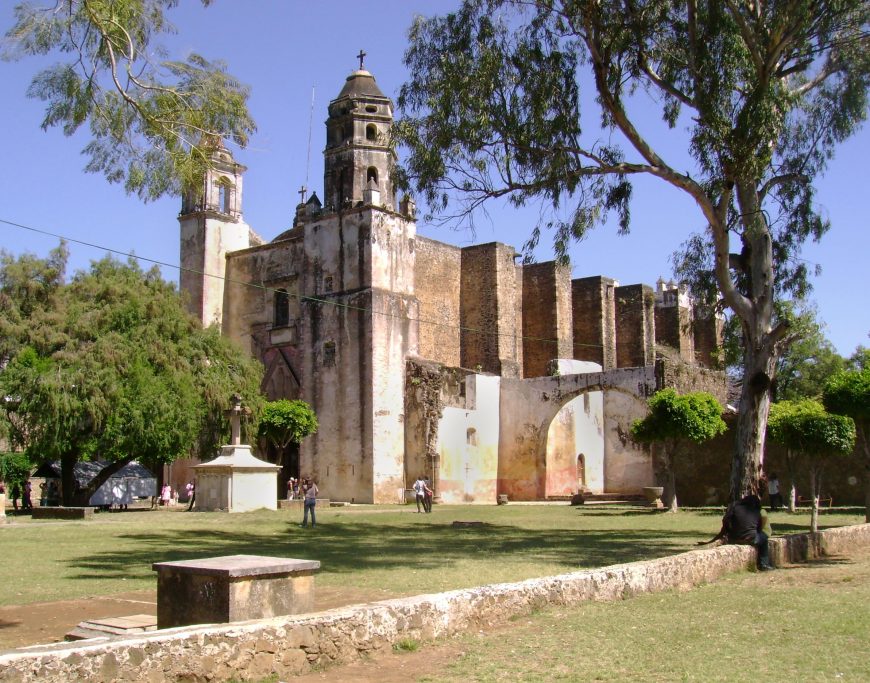
In the Viceroyalty of New Spain, the Roman Catholic Church was an important—if not the most important—art patron, commissioning churches, altarpieces, paintings, and sculptures, a result of the system of Royal Patronage (Patronato Real), which granted the Spanish Crown unprecedented privileges in Church affairs in exchange for Spain’s funding of missionary ventures abroad (this was a unique system in Europe). The colonization of New Spain therefore worked in favor of both the Crown’s imperialist and material aspirations, and the Church’s desire to evangelize local indigenous populations.
These goals were accomplished largely through the work of missionaries and mission churches, as well as through an active artistic program that initiated the construction of new buildings and art schools that trained Amerindians in the art of painting, sculpture, and even cartography. Royal Patronage also meant that colonial authorities exercised considerable power over the Church in New Spain, controlling church appointments, revenues, and architectural programs.
The importance of mission churches
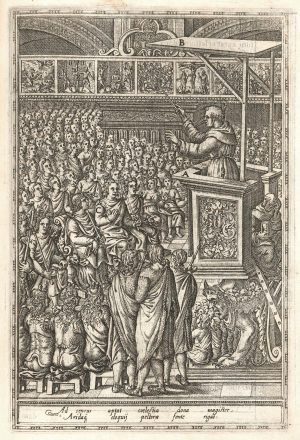
The Christianization of the Americas began in 1537, following the papal bull Sublimis Deus, through which Pope Paul III declared that the native populations were in fact human beings with souls and the intellectual potential to understand the tenets of Christianity, and thus were not subject to enslavement (prior to this moment they had been considered savage and even demonic by the Church).
This religious fervor grew even more severe in 1545, when the Council of Trent convened in response to the rising threat of Protestantism, a new form of Christianity that emerged in the sixteenth century as a reformed version of Roman Catholicism. In response to the Protestant Reformation, the Council of Trent launched a global campaign—known as the Counter-Reformation—that reaffirmed Roman Catholic beliefs and teachings. One of the results of this effort was that religious institutions like churches, monasteries, and convents were expected to play an active role in expanding their congregations and expounding the values of Roman Catholics through the proliferation of religious spaces.
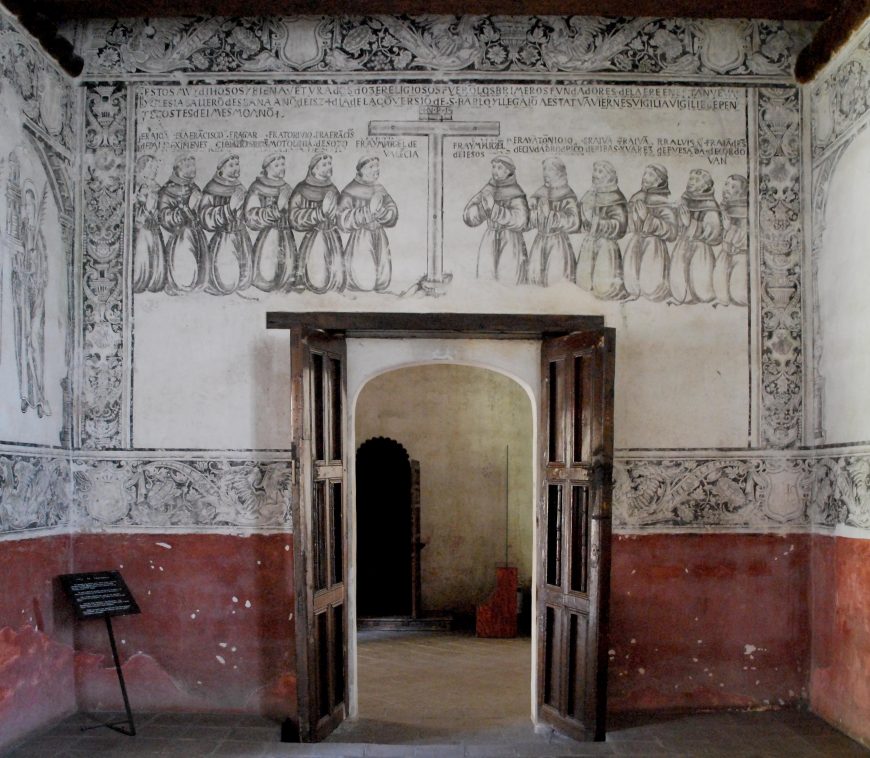
From 1523 to 1580, many religious orders arrived in New Spain, among them the Dominicans, Franciscans, Augustinians, and Jesuits. Determined to convert the native people and expand the congregation, friars built mission churches, also called conventos, in indigenous communities, such as the Franciscan Church of San Miguel in Huejotzingo (above) and the Augustinian Church of San Salvador in Malinalco (below).
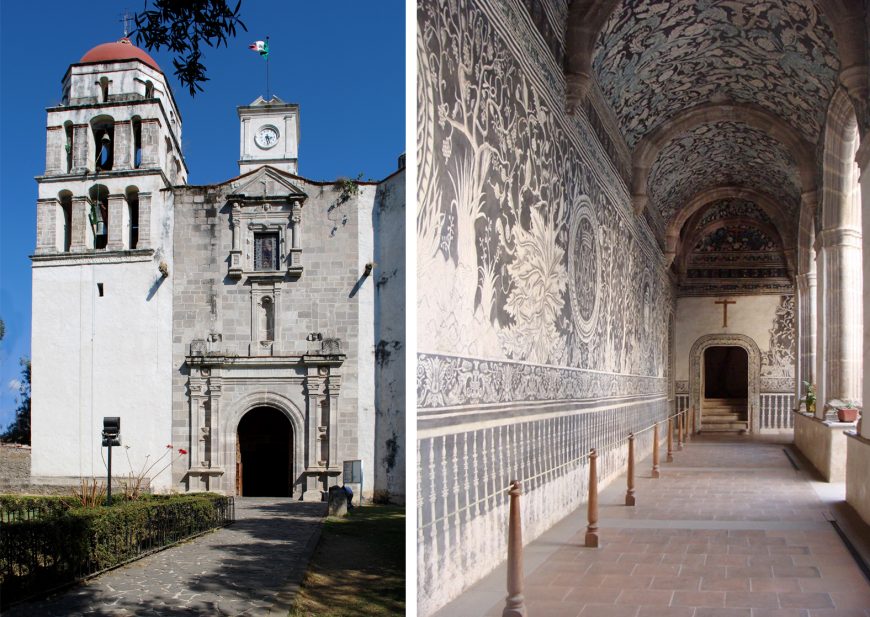
These mission churches, which followed a similar architectural plan but varied in terms of decoration, are among the earliest examples of colonial architecture—a testimony to the importance given to missionary work within the Viceroyalty of New Spain. A religious militia of sorts, the friars not only empowered the Church, but also facilitated the colonization of New Spain without the use of a standing army.
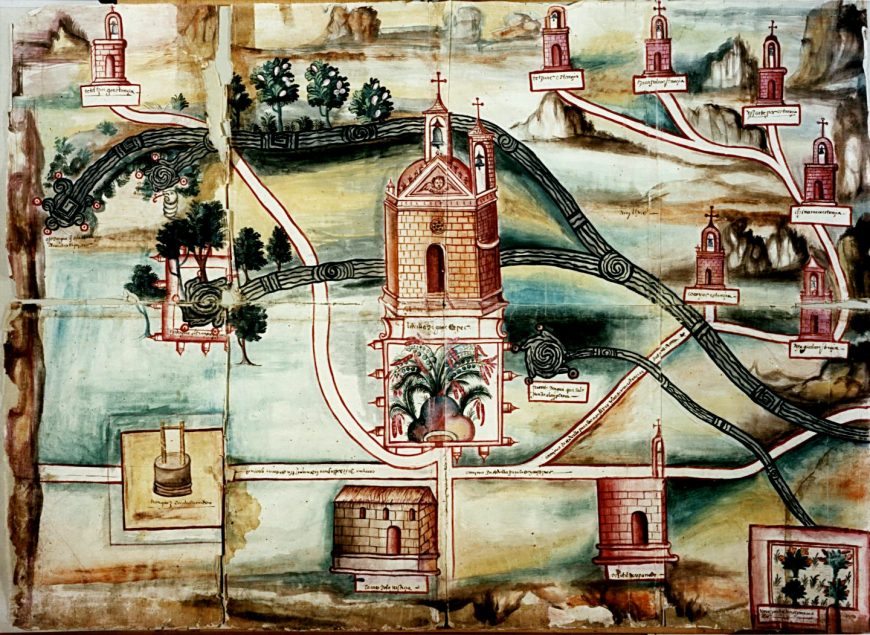
Colonial maps like the Map of Oaxtepec reiterate the importance of mission churches. Here, the convento, identified by the large patio (courtyard), appears as the nucleus of the community. Near the edges of the map, and connected through a network of roads, the artist depicts seven additional churches. Their identical appearance suggests that they are meant as symbols for “church,” rather than visualizations of how these spaces actually looked. [1] This repetition reinforces the firm presence and power of the Roman Catholic Church in New Spain.
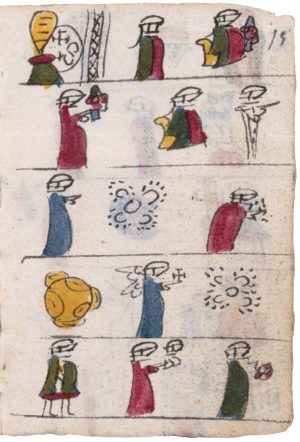
The Franciscan Mission in New Spain
Franciscans were among the earliest monks to arrive in New Spain, including the three prominent Flemish Franciscans Peeter van der Moere of Ghent (a.k.a. Pedro de Gante), Jehan der Auwera (a.k.a. Juan de Aora), and Johan Dekkers or de Toict (a.k.a. Juan de Tecto). For monks, the first order of business was to begin construction on mission churches that functioned as “theaters of conversion,” as art historian Samuel Y. Edgerton refers to them, since they served as sites of theatrical performances and processions that merged both pre-Hispanic and Christian rituals. [2] In preparation for this process of conversion, monks—particularly Franciscans—would learn the languages and cultures of the local populations, allowing them to integrate indigenous names, iconography, and customs into the Christian practices of New Spain. The most powerful of didactic tools, however, were visual aids that helped overcome the challenges of illiteracy and language barriers.
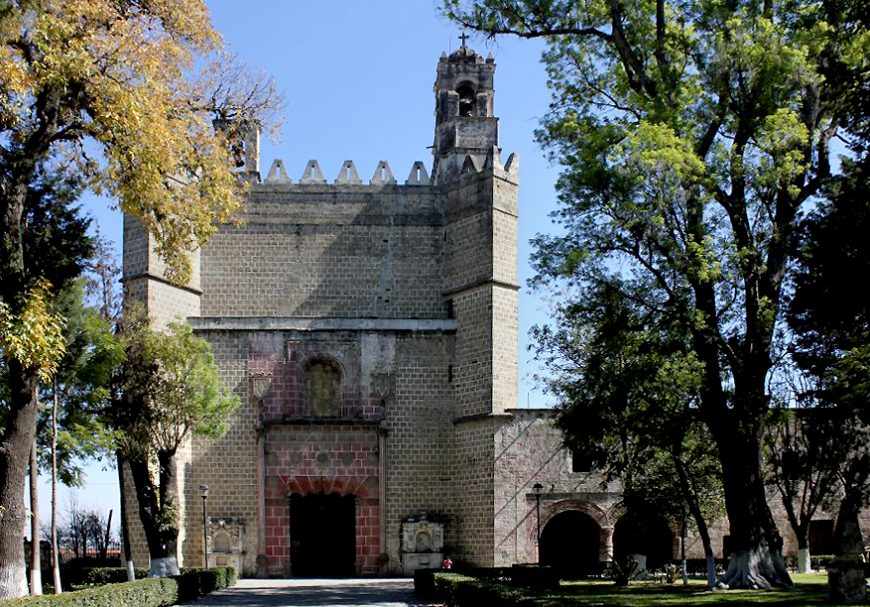
The exterior of the Franciscan mission Church of San Miguel in Huejotzingo serves as an exemplar of the importance of designing a proper space of conversion. Featuring high, thick walls topped by crenellations, the church appears—at least from the exterior—as a type of fortress. This design might have suggested the permanence of these Christian missions in New Spain. Monks came and went, but the church and its congregation remained. The design might have also alluded to the belief that Christian monks were the soldiers of God—though such associations might have been lost on the indigenous population.
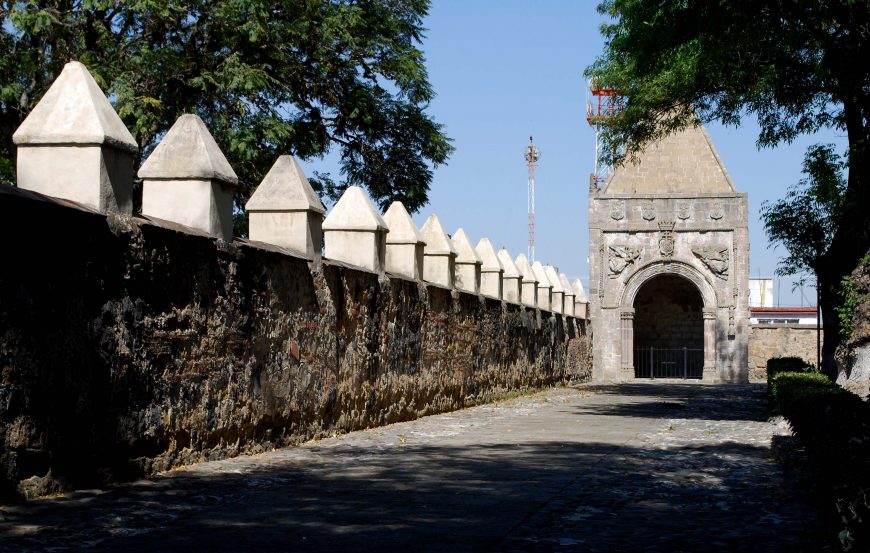
Unique characteristics
The convento was, in and of itself, a foreign concept. Therefore, the fact that these churches were built by indigenous masons and often times in an indigenous style helped to further legitimize the idea of the convento as part of their local community. A unique characteristic of Mexican conventos was the creation of open spaces, like the capilla india, used to address large native crowds, and the smaller posa chapels in the corners of the atrium (typically found in Franciscan churches), used for ritual processions involving portable altars. While the creation of these outdoor spaces solved the problem of accommodating the growing population of converted Christians, it resonated among the natives who, during the pre-Columbian period, performed dances and rituals in walled outdoor spaces, recalling the open-air layout of the Templo Mayor in the Aztec capital city of Tenochtitlan.
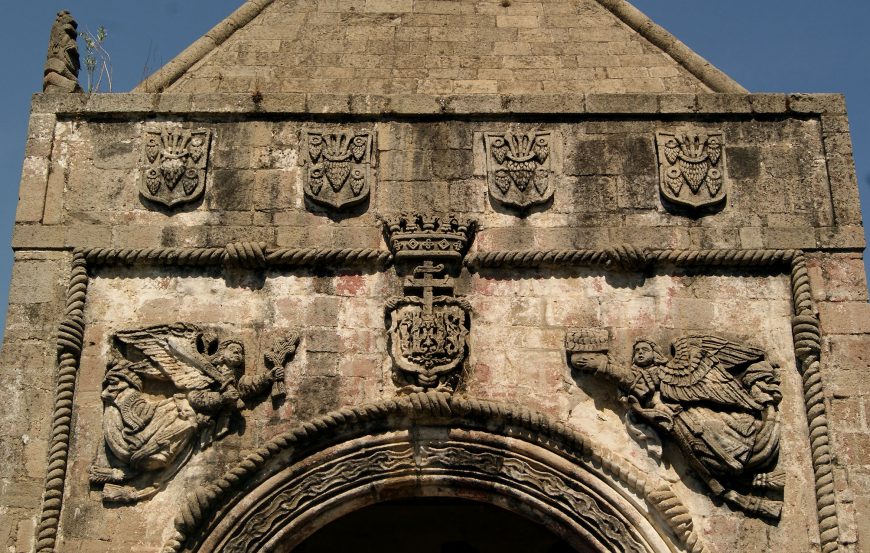
As was typical of Franciscan mission churches, the Church of San Miguel includes four posa chapels, each located in a corner of the perfectly squared patio. Above the archway, relief sculptures of angels appear inside a knotted cord, a reference to the habits of the Franciscan monks, who each tied a cord around their waist. Above these angels, four shields contain the emblems of the Franciscan order. The distinctive pyramidal roof is another common trait of posa chapels.
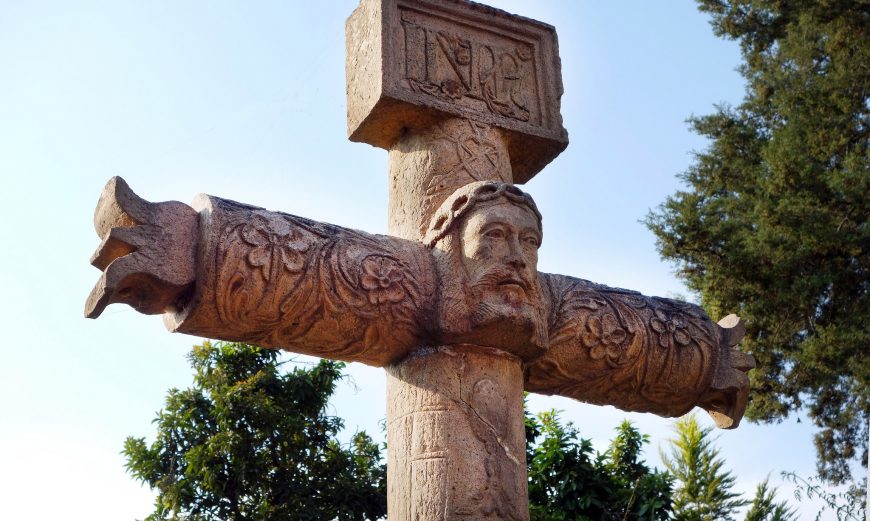
Sculpture and painting in conventos
Found in conventos of different religious orders, atrial crosses were sculpted stone crosses displayed in courtyards, such as the one found at the Convento of San Agustín de Acolman. They usually represented the instruments of Christ’s passion in relief, thus avoiding the need to represent the actual Crucifixion. By avoiding a realistic depiction of Christ’s sacrifice, the early missionaries were intentionally de-emphasizing the existing ideas about human sacrifice prevalent in Mesoamerican cultures.
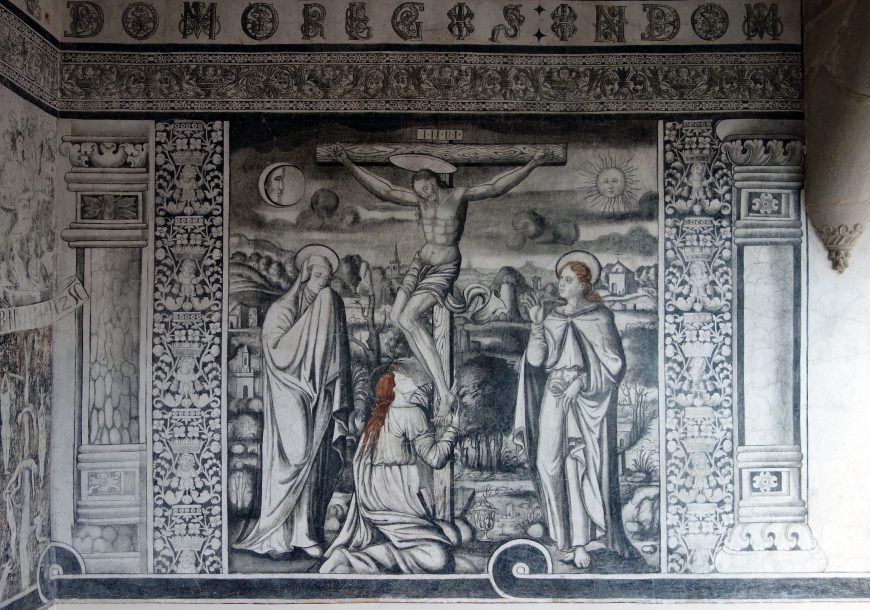
At the Convento of San Agustín de Acolman, one can also find a series of fresco paintings that detail the Passion of Christ through a narrative sequence. Indigenous artists, who were most likely looking at religious prints imported from Europe, created these frescoes, with their sparse composition and limited color palette. Much like the atrial cross, these murals functioned as didactic tools that gave visual clarity to an otherwise complex narrative, and borrowed from both Christian and native practices.
Carefully combining local and foreign practices, these mission churches created a unique colonial iconography and architecture that is indebted as much to Amerindians as it is to Europeans. While conventos served to first congregate and convert locals during the early decades of colonization, they largely fell out of favor by the end of the sixteenth century. Yet despite their demise, Catholicism continued to flourish in New Spain, and even after independence.
Footnotes:
- Barbara Mundy, The Mapping of New Spain: Indigenous Cartography and the Maps of the Relaciones Geográficas, (Univeristy of Chicago Press, 1996), p. 79.
- Samuel Y. Edgarton, Theaters of Conversion: Religious Architecture and Indian Artisans in Colonial Mexico (University of New Mexico Press, 2001).
Additional resources:
“Surveying Political Force,” essay on politics and the Church in New Spain from Vistas
The original Papal Bull of 1537
Official pages for the Ex Convento of San Agustin de Acolman and Ex Convento de San Miguel, Huejotzingo (in Spanish) from INAH (Instituto Nacional de Antropología e Historia)
St. Michael the Archangel in Huejotzingo
by DR. EMMANUEL ORTEGA

In 1994, UNESCO (The United Nations Educational, Scientific and Cultural Organization) named the earliest sixteenth-century Mexican monasteries found on the slopes of the Popocatepetl volcano in central Mexico a World Heritage Site. These fourteen monasteries define the history of Christian evangelization for much of Mexico’s colonial period (1521–1821). One of these monasteries is the Franciscan mission of St. Michael the Archangel in Huejotzingo, twenty-three miles outside the city of Puebla.
Temple fortress
When building the mission of Huejotzingo, the friar-architects likely envisioned themselves constructing a new temple of Jerusalem, an expression of the westward expansion of Christianity.

The monasteries constructed between the 1520s and 1550s may have also been designed with a second purpose in mind, to defend monks from attacks by unconverted local and regional populations. However the fortress-like appearance of these missions is now generally accepted as reflecting earlier representations of the temple of Jerusalem in western art.

The Franciscan monastery of Huejotzingo is a landmark in the development of sixteenth-century art in central Mexico. Huejotzingo’s impressive church façade displays a variety of Spanish architectural styles while the church as a whole contains a consistent theological program. Most prominent is the church’s retablo (altarpiece). It was painted by the Flemish artist Simon Pereyns and is located in the mission church. It displays aspects of Mannerism, a style that remained influential in colonial México for almost a hundred years.
Posas
Among the church’s most important architectural features are a group of four open-air chapels known as posas located in each of the corners of the monastery’s atrium. They are among the best preserved in all of Mexico and exemplify the practice of outdoor spiritual teaching that was so much a part of the process of colonization. In the Franciscan mission at Huejotzingo, a new visual language representing spiritual conversion is evident when the visitor crosses the threshold of the posas.

The posas are vaulted in the interior, capped by a pyramid-like structure, and adorned with crosses on their pinnacles. The structures are accessible through arches on two adjacent sides to allow processions to move through unimpeded. Each posa measures seventeen feet across and are twice as high. They are constructed of stone, like the rest of Huejotzingo. However, their historical significance is principally the result of how Mesoamerican religious practices were implemented here for the purpose of mass spiritual conquest.
The position of the chapels in the atrium’s corners allowed for a large number of people to participate in dramatic daily liturgical processions. The interiors of the posas were decorated with frescoes that included themes of the Immaculate Conception of the Virgin Mary and the Last Judgment. These images would have intensified the emotional effects of spiritual salvation and condemnation for recent indigenous converts. Posas were most likely adaptations of tremezzi, which date back to fourteenth-century Italian religious architecture. A tremezzo was a bridge and porch-like form that spanned across a church nave. Its purpose was to shelter altars, and was used as a stage for preaching and dramatic enactments. In addition to any possible European architectural forerunners, one must also consider Mesoamerican precedents. For instance, posas resemble callis (“house” in Nahuatl, an indigenous language of Central Mexico), which were rectangular and open on one side, and Aztec temple houses, which were erected atop pyramids (teocalli).

Posas allowed for conversion to take place outside the main church. While this may have been done for practical purposes, pre-Columbian Mexican spiritual ceremonies also took place out of doors. Worshippers were accustomed to gathering in open courtyards to listen to priest-rulers. Another example of the fusion of Christian and indigenous spiritual meaning is presented by the pyramidal shape of the chapels’ roofs, which were surmounted by highly ornate crosses. Crosses were important symbols for water, fertility, and sustenance prior to the arrival of the Spaniards. Non-Christian, pre-Columbian crosses were often created out of trees and represented the Tree of Life in various rituals. In mission spaces such as Huejotzingo, crosses became a powerful symbol for the source of spiritual life shared by Europeans and indigenous peoples alike. They were placed in the center of monastery atriums as a symbol of the Christian and indigenous axis mundis (world axis). The crosses that topped the posas, of which only the example from below survives, were modeled with similar didactic functions as the large atrium crosses that decorated most sixteenth-century missions in this region. They were carved with a fusion of Mesoamerican and European symbols, offering natives an opportunity to learn about Christ’s life, death, and resurrection through familiar regional motifs.

Huejotzingo’s Posa Cross has a serpentine base that resembles Christ’s crown of thorns, and the wounds of Christ’s Passion (the stigmata) are shown through carved circles that drip blood in the form of grape clusters (or, perhaps maize cobs, if one considers a possible indigenous meaning). The stigmata were not only representations of Christ’s Passion, but in this context, also the miraculous stigmatization of St. Francis, the patron saint of the Franciscan order. Above the open sides of the posas, which are framed by a relief of the order’s knotted rope cord, appear four Franciscan Order shields, containing five grape clusters, reiterating the stigmata iconography (wine from grapes miraculously becomes the blood of Christ during the Eucharist).
Posa façade iconography
On every arch, two apocalyptic angels hover within an alfiz. This is a term borrowed from Mozarabic architecture and it is used to describe the relief details that surround the perimeters of an arch. In Huejotzingo’s posas, the alfiz is carved to resemble a knotted Franciscan cord. Each angel holds a different Instrument of the Passion (or the Arma Christi), announcing the sacred battle against pagan forces. Above the keystone, we see an emblem of the Virgin Mary capped by a crowned cross. The posa carvings communicate the unifying suffering of Saint Francis and Christ.

The carving style of the dynamic hovering angels is at times described as Romanesque, Gothic, Tequitqui, or Indo-Christian.¹ Many sculpted and frescoed details from this period can be traced to Northern European prints while the overall theological program was most likely envisioned by people like friar Pedro de Gante whose indigenous art school in Mexico City trained the artists that created this and other important sixteenth-century monuments.

Huejotzingo’s posas constitute a blend of Christian and indigenous Mesoamerican symbols that established a message of evangelization that achieved new levels of success.
1. “Tequitqui is a term “meaning ‘laborer’ or ‘tribute payer’ in Nahuatl, used by 20th-century scholars to describe the sculpture and architectural decoration created in New Spain in the sixteenth century…” Leibsohn, Dana, Barbara Mundy, “Vistas: Visual Culture in Spanish America, 1520-1820.”
Additional resources:
The sixteenth century: Age of the conventos
Jaime Lara, City, Temple, Stage: Eschatological Architecture and Liturgical Theatrics in New Spain (Notre Dame, Ind: University of Notre Dame Press, 2004).
Richard Perry, Mexico’s Fortress Monasteries (Espadaña Press: Santa Barbara California, 1992).
Eleanor Wake, Framing the Sacred: The Indian Churches of Early Colonial Mexico (Norman: University of Oklahoma Press, 2010).
The Convento of San Nicolás de Tolentino, Actopan, Hidalgo
by ANA PERRY

Immediately after the Conquest, Spanish colonizers set about the task of imposing Spanish culture, customs, and religion upon the native populations in New Spain (a Spanish colony that was comprised of what is now parts of the Caribbean, Mexico, Central America, and the southwestern United States up to northern California). One of the most important steps in this process was the conversion of the indigenous peoples to Christianity and the elimination of their religious beliefs—beliefs the Spaniards considered idolatry. Three different monastic orders arrived in New Spain to help convert indigenous populations: the Franciscans in 1524, Dominicans in 1526, and Augustinians in 1533. All three monastic orders were mendicants (monks who had taken vows of poverty). The orders directed the construction of conventos (conversion centers or missions)—built with the forced labor of indigenous peoples—where they would simultaneously celebrate the triumphs of Christianity and seek to destroy pagan practices. This process was supported by the construction of elaborate decorative schemes—often murals—that could visually express the word of God.
The Convento of San Nicolás de Tolentino

The murals in the stairwell and open chapel at the Convento San Nicolás de Tolentino in Actopan, a town in Hidalgo, Mexico, offer a unique view into early conversion practices and artistic projects in the decades immediately following the Spanish Conquest in 1521. They were painted in the mid-sixteenth century during the early colonial period of New Spain. The Augustinian friars were particularly concerned with the area around San Nicolás de Tolentino because they feared that continued resistance to Catholicism would lead the local indigenous Hñahñu/Otomí people to join with the nomadic Chichimecas who were particularly hostile to Spanish colonizers.
As a result, local Augustinians launched an aggressive conversion campaign to eradicate native beliefs and enforce religious conformity. This campaign included the creation of elaborate murals throughout the convento that illustrate the benefits of Christianity and the ramifications of continuing idolatrous practices. For example, the stairwell murals of the cloister (an open space surrounded by covered walkways) as well as in the open chapel (located on the side of the church) show the virtues of the Augustinian friar who acts against idolatry as well as the evils of sin and Satan.

The murals on the stairway walls

Black-and-white murals depicting Augustinian heroes (in other words, esteemed figures from the Augustinian tradition) cover every wall of the interior stairs at San Nicolás de Tolentino (above). The walls are divided into five horizontal tiers that rise up the two-story hall. Each tier contains an image of an arcade (a covered walkway with arches) of plateresque pilasters (below). The style is named for its affinity with silver work (plata means silver in Spanish). The plateresque style was common on architectural façades throughout Spain beginning in the 15th century and can be found on a number of institutions devoted to higher education, like the University of Salamanca in Spain (left). That the Augustinians would use the plateresque style makes sense given the order’s historical ties to education and intellectual pursuits. In fact, many distinguished Augustinians were professors of philosophy and theology at some of the greatest universities in Europe. In the murals, Augustinian heroes are shown sitting beside desks, either reading or writing (below). Several of the figures face the viewer with pens held up, as if we have caught them in mid-thought, emphasizing their roles as intellectuals and scholars and suggesting a sense of immediacy.

One section of the stair mural veers from the intellectual and scholarly model (below). It shows friar Martín de Acevedo on the far left (possibly the author of the mural program), and two indigenous men named Don Juan Atocpa and Don Pedro Izquicuitlapico (possibly patrons of the program). The three figures kneel and pray towards a small statue of the crucifixion in an outdoor setting. This scene emphasizes the potential for salvation and celebrates the converted indigenous men as a part of the convent.

The influence of European prints

The artist’s method of depicting the seated heroes on a gridded floor framed in an arcade (see image above) demonstrates the influence of European prints (left). Prints imported from Europe had become useful in the evangelization process. Friars used them as educational tools and as artistic models. In the absence of paintings or models with color, the murals maintained the grayscale palette so commonly found in prints. Since few European artists came to the Spanish viceroyalty in the sixteenth century, prints served as an opportunity to import European cultural and artistic practices and establish the superiority of Euro-Christian traditions.
The murals in the open chapel
In contrast to the mural paintings of the stair hall, the open chapel includes brightly colored narrative murals depicting scenes of sin and the Last Judgment (in the Christian tradition, the final and eternal judgment by God of all peoples). The architectural form of open chapels in early sixteenth-century missions varied, but they often took the form of an apse (the semi-circular area that surrounds an altar in a church) or arcaded porch that faced an atrium (an open plaza). The open chapels, which contained altars, were always located outside so many people could congregate in front of them. In this way, a large audience could see the altar during the celebration of mass or other religious events.

In the open chapel, friars also preached to a large indigenous audience to carry out their conversion practices. Since there were often only a few friars for entire communities of indigenous peoples, the convents needed a large space where friars could speak to many people. The open chapel allowed the friars to bring potential converts into one space and use sermons as well as images to root out idolatry and evangelize large groups of people together.

At Actopan, the back wall, where the altar was placed, contains a series of panels depicting important Catholic teachings, like the expulsion of Adam and Eve from the Garden of Eden (above), the destruction of Babylon, Purgatory, the Flood, and the Last Judgment—the latter depicted sinners being tortured by demons in the flames of Hell. These scenes correspond with the function of the open chapel as a conversion space. The missionaries believed that indigenous religions and practices were the direct result of Satan’s influence and saw it as their role to guide the indigenous population down the path to salvation and away from Satan’s grasp. In this way, the panels depicting God’s punishment for sinners and the path to Hell are a direct manifestation of the missionaries’ fears of idolatry and their attempt to save the souls of the local population. On the surrounding walls, additional scenes of torment and torture reinforce the dangers of Satan’s influence.

Though the imagery is drastically different from the stairwell murals, the open chapel murals also borrow from other examples of Christian art in Europe. For example, the motif of Adam and Eve cowering as they walk out of Eden is common throughout European art (for example, Masaccio’s fresco in the Brancacci Chapel in Florence). In the Actopan open chapel, Adam and Eve are initially shown nude in the Garden of Eden with a large snake entwined around a tree facing Eve. The narrative continues to show Adam and Eve, now with their genitals covered, as they leave Eden, as in Masaccio’s painting.
Importantly, the open chapel mural paintings highlight acts that the friars believed were particular dangers and temptations for the local indigenous communities. Sins such as adultery, idolatry and drunkenness are illustrated alongside demonic figures and figures supposed to represent the indigenous peoples. In one scene, an indigenous convert turns his back to a pagan temple, following instead a Spanish man towards the sun, which represents Jesus Christ in this case. Depicted on the left and right walls, a monstrous mouth (a “Hell Mouth”) devours sinners and confirms what awaits those who choose to follow idolatrous paths (above, left). Rather than the heavenly scene on the back wall, the adulterers, drunks, and idolaters fall into monstrous mouths and face horrifying scenes in the afterlife, including flaying and grilling (below).

Directly above this scene, and topping the back wall, is a panel of the Last Judgment. The panel is split horizontally and shows primarily white Europeans, similar in dress and appearance to the friars. They are seated behind Christ in heaven, with a light color palette that is in stark contrast to the deep reds of hell. The figures in hell are shown as natives with darker skin, and they are included here to reinforce the message against the evils of indigenous cultural and religious practices.
Educating a new Christian population
The open chapel and the stair hall together offer two different motivations of the friars at Actopan—they wanted to establish their place within the lineage and history of other heroes of the Augustinian order and emphasize their roles as educators of the Christian faith. The murals also demonstrate the great fear and urgency of the evangelization process and the friars’ desire to eradicate idolatry. The juxtaposition of indigenous converts kneeling in the stairwell with the burning and tortured bodies of those who maintain idolatrous practices in the open chapel establishes the two potential outcomes for the local congregation.
Additional resources:
Colonial mural paintings at the website of the Inter American Institute
Victor Manuel Ballesteros García, The Monasteries of the State of Hidalgo: Religious Expressions of the Art and the Culture of the Sixteenth Century (Pachuca, México Universidad Autónoma del Estado de Hidalgo, 2000).
Samuel Y. Edgerton, Theaters of Conversion: Religious Architecture and Indian Artisans (Alburquerque: University of New Mexico Press, 2001).
Robert H. Jackson, Conflict and Conversion in Sixteenth Century Central Mexico: The Augustinian War on and Beyond the Chichimeca Frontier (Leiden: Koninklijke Brill NV, 2013).
Eleanor Wake. Framing the Sacred: The Indian Churches of Early Colonial Mexico (University of Oklahoma Press, 2012).
Atrial Cross at Acolman
by DR. ELENA FITZPATRICK SIFFORD
Video \(\PageIndex{14}\): Atrial Cross, convento San Agustín de Acolman, mid-16th century
Speakers: Dr. Lauren Kilroy-Ewbank and Dr. Beth Harris
Conventos
When we think of the conquest of the “New World,” we may immediately picture the violence of the military encounter between Spaniards and the indigenous peoples of the Americas. While the process of colonization began through bloodshed, relatively few Indians fought against Spanish soldiers.
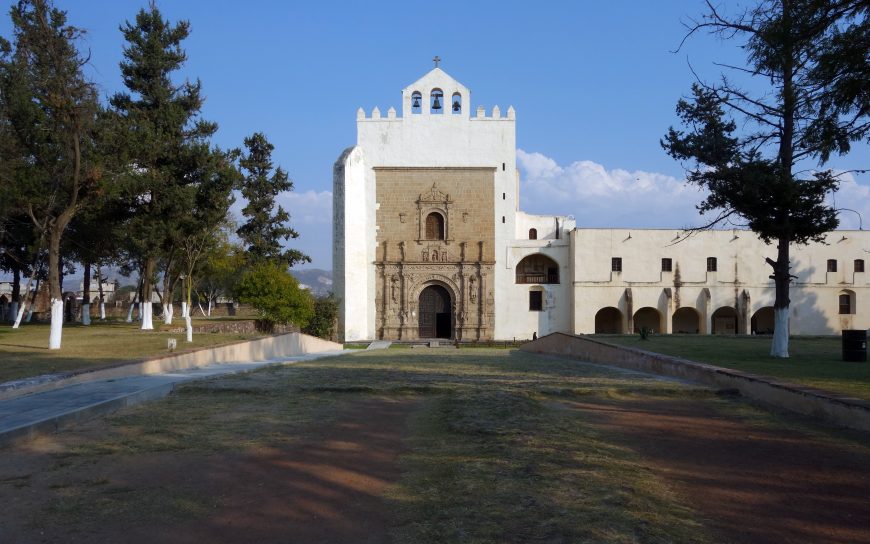
Instead, their first exposure to the new conquerors was often within the large walled complexes called conventos (missions). Built by indigenous populations alongside mendicant friars (who were the mendicant friars?), these compounds contained a church, cloister, patio (also known as an atrium), and an outdoor chapel. Within the conventos indigenous people were baptized and taught the tenets of the Christian faith. The outdoor walled atrium hosted autos (religious plays) as well as religious processions that were staged in a counter-clockwise direction, imitating the direction of Nahua rituals (the Nahua are an indigenous people of Mexico and El Salvador).
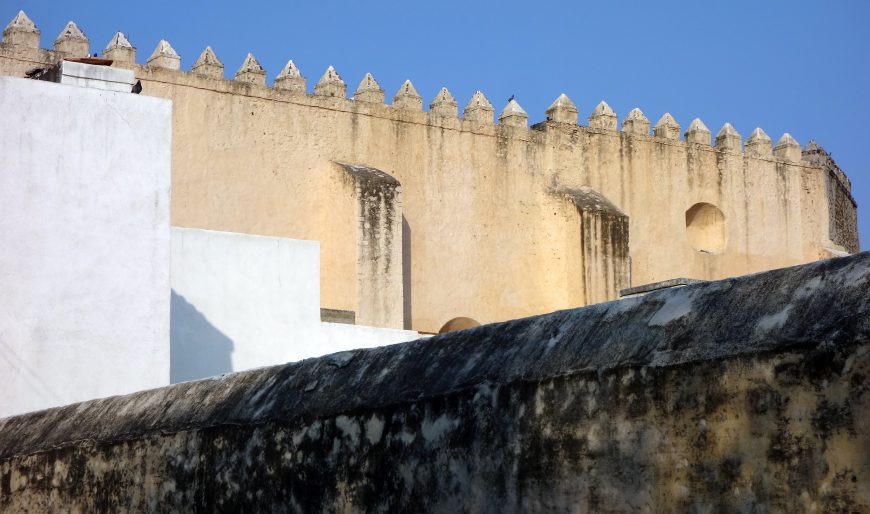
One of the most celebrated Mexican conventos is the Augustinian mission of San Agustín de Acolman (Acolman was a Nahua village located just north of Mexico City). Built in the mid-sixteenth century, the complex features a rusticated façade with boldly projecting stones, and a crenellated (notched) roofline, giving it a fortress-like appearance (see image above). This architectural style was common among the conventos of New Spain (the former Spanish colony that is now Mexico, Central America, and the southwestern United States). San Agustín de Acolman’s architectural style suggests a protective function, and may have referenced the temple of Jerusalem, celebrating Mexico as a “New Jerusalem” where the Christian faith could flourish.
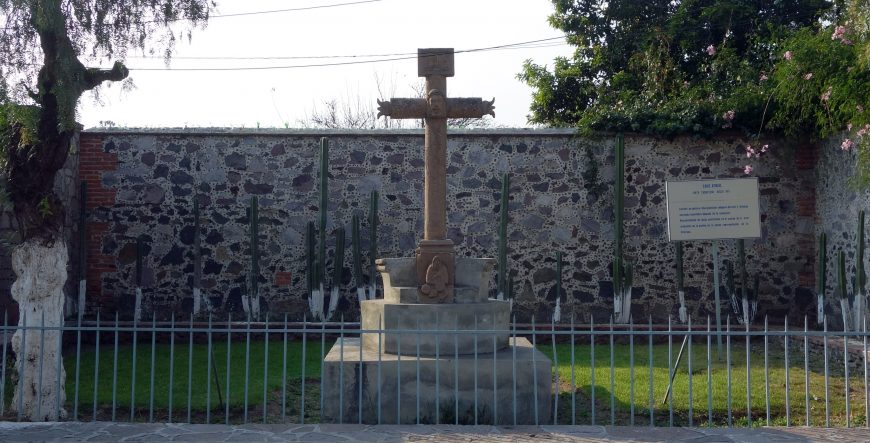
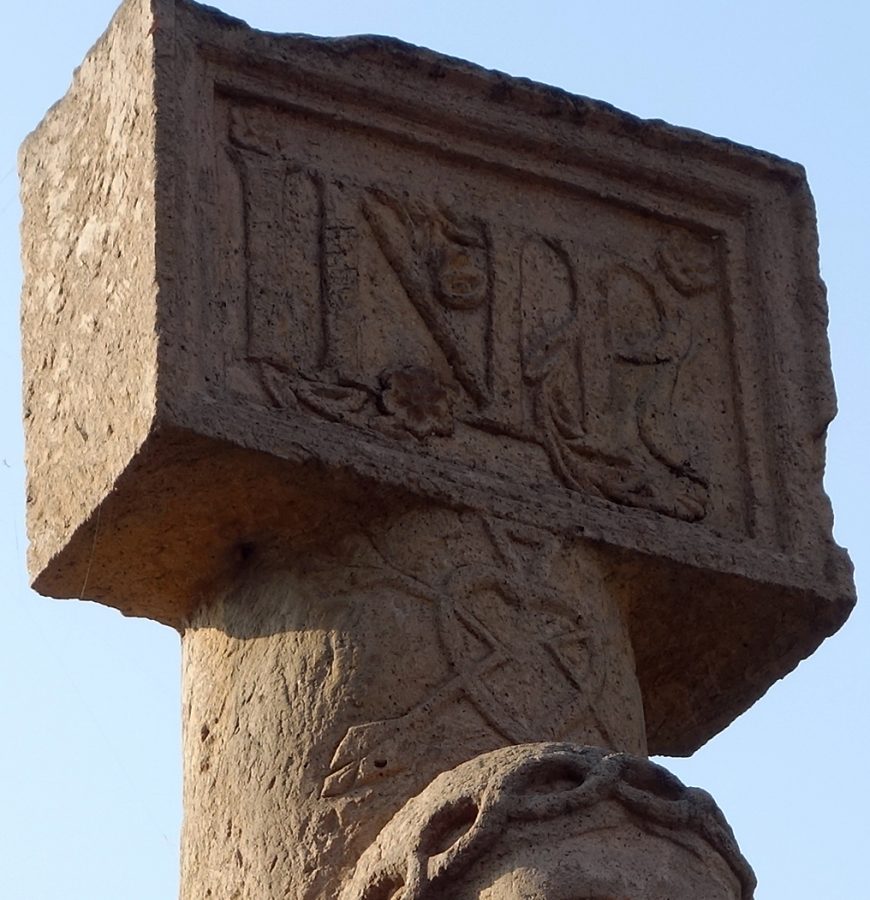
The Atrial Cross at Acolman
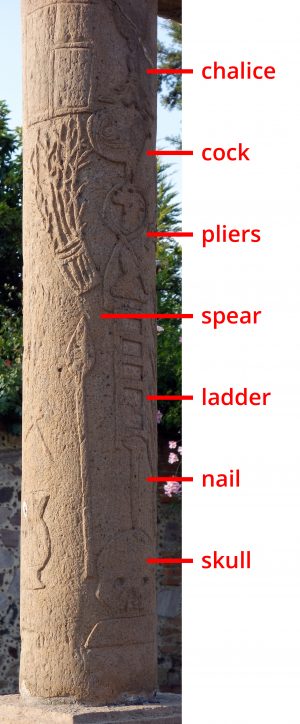
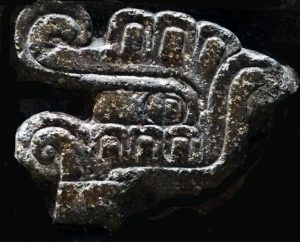
The remainder of the shaft features the Arma Christi (literally, “weapons of Christ,” the objects associated with the Passion) including a chalice, cock, pliers, spear, ladder, nail, and a human skull. These objects relate to the story of Christ’s entry into Jerusalem and his suffering at the hands of the Roman soldiers before his death on the cross and eventual resurrection. The objects are isolated from one another, displaying an affinity with the Aztec pictographic writing system. Each “instrument,” like an Aztec glyph, is boldly outlined and reduced to simplicity of forms for the sake of legibility. Within the ritual theater of the convento, the cross served as a teaching tool for new Nahua converts to learn an episode of the Passion story by metaphorically zooming in on the relevant “glyph.” For example, the spear would illustrate the story of the Roman soldier who pierced Christ’s side, and the ladder would narrate the deposition, or removal of Christ’s body from the cross.
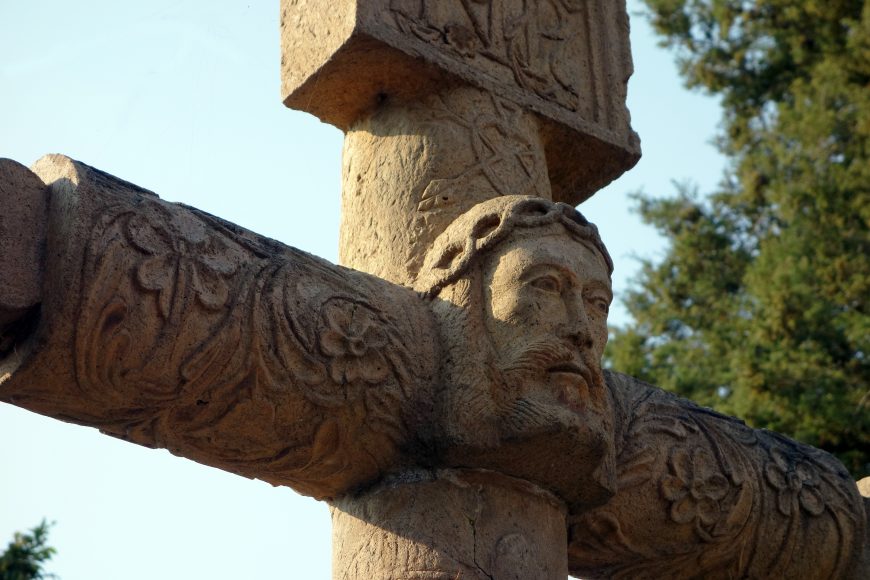
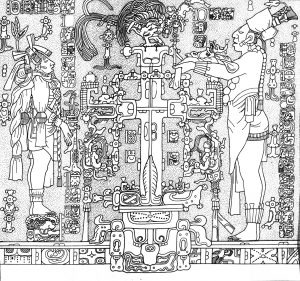
In addition to these symbols, the cross’s arms feature vegetal designs (see image above), a trope connected to the indigenous “World Tree,” the symbolic center of the universe from which the human race emerged (see image at left). Spaniards of the period noted that Indian images of the World Tree bore similarities to the Christian cross, surmising that Saint Thomas the Apostle had introduced the cross to the Americas in Biblical times, but that his efforts were destroyed by the workings of the Devil. In fact, the World Tree was an ancient symbol in Mesoamerica (modern-day Mexico and much of Central America), and had no original connection to Christ’s martyrdom. Rather than Christ’s body hanging on a cross as is typical for a Crucifix, the center of the Acolman cross features his boldly projecting face (see image above), perhaps also connecting it to the World Tree as a place of creation.
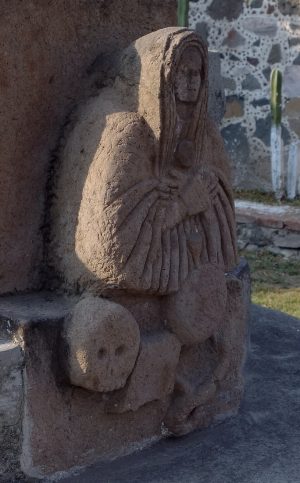
Alternatively, Christ’s face may be a rendering of the sudarium, or the veil that Saint Veronica used to wipe Christ’s blood and sweat as he carried the cross to his execution. The veil that became imprinted with his visage is one of the arma Christi which might explain its inclusion on the atrial cross. Finally, the base of the cross includes a rendering of the Virgin Mary alongside a human skull, a reference to Calvary, or “the place of the skull,” the burial place of Adam and the hill upon which Christ died (see image at left). This complex iconography derived from European print sources and was executed by native artists in native styles. This legacy is clearly visible when comparing the cross to pre-Hispanic Nahua monumental stone sculpture in the round that similarly features bold designs executed in varying relief.
A hybrid style
“Tequitqui” is one term given to this type of early colonial sculpture from Central Mexico that displays indigenous symbolism and style. Created as a collaborative effort, the hybrid atrial cross offers a fascinating look into the interactions between Spanish friars and Nahua converts in the years directly following the conquest of Mexico. While Spaniards wielded power as conquerors, indigenous people nevertheless played a major role in shaping the new colonial society. At Acolman, we can see these interactions at play, manifested in this masterfully carved monumental stone cross.
[1] INRI are initials for the Latin words that Pontius Pilate had written over the head of Jesus Christ on the cross (Iēsus Nazarēnus, Rēx Iūdaeōrum, Jesus the Nazarene, King of the Jews)
Additional resources:
Samuel Y Edgerton, “Christian Cross as Indigenous ‘World Tree’ in Sixteenth-Century Mexico” in Exploring New World Imagery, edited by Donna Pierce (Denver: Mayer Center for Pre-Columbian and Spanish Colonial Art, 2002), pp. 16–24.
Jaime Lara, City, Temple, Stage: Eschatological Architecture and Liturgical Theatrics in New Spain (Notre Dame: University of Notre Dame Press, 2004).
Murals from New Spain, San Agustín de Acolman
by DR. LAUREN KILROY-EWBANK and DR. BETH HARRIS
Video \(\PageIndex{15}\): Murals, c. 1560-90, large cloister of the ex-convento, San Agustín de Acolman, Acolman de Nezahualcóyotl, Mexico
SmartHistory images for teaching and learning:

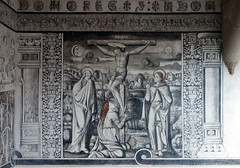



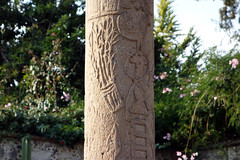
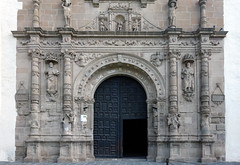

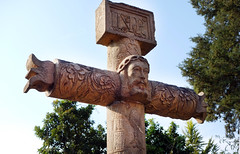
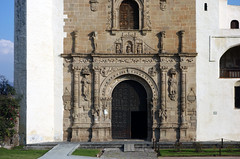

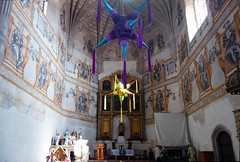
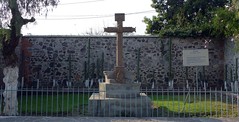
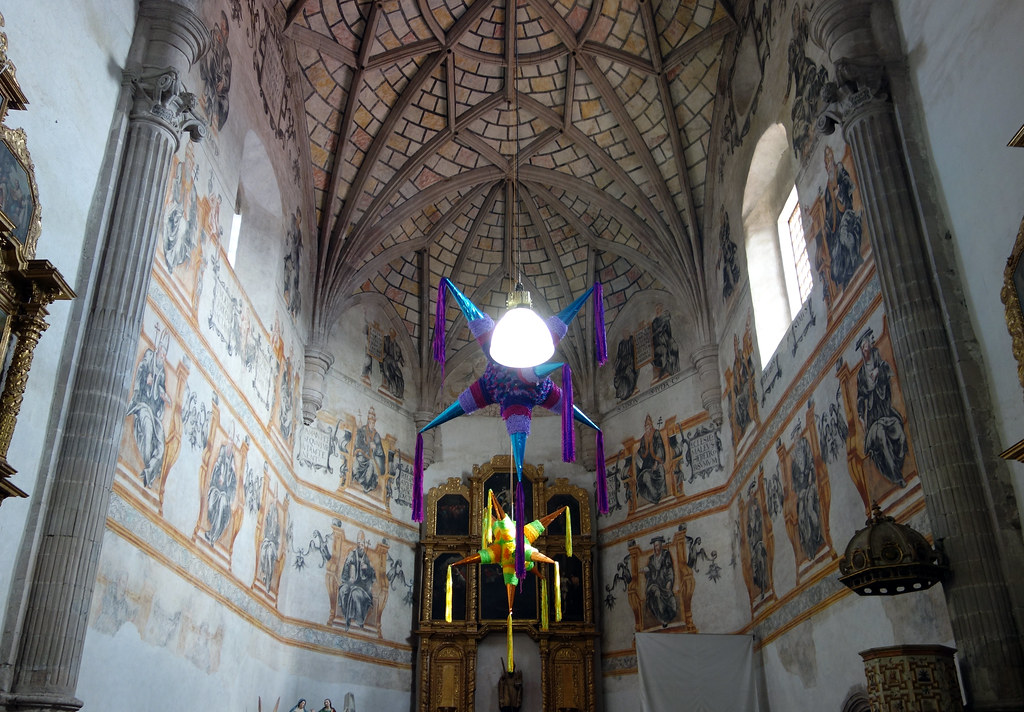
Frontispiece of the Codex Mendoza
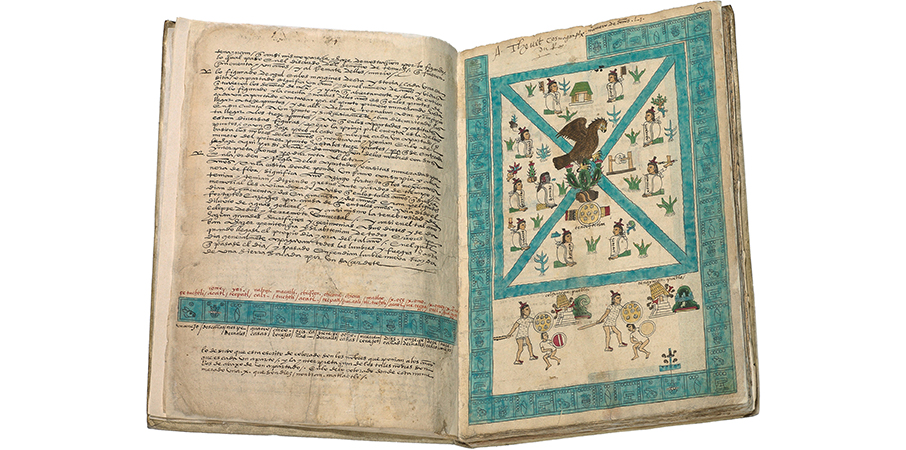
Priests and pirates
Around 1541, the first viceroy of New Spain, Antonio de Mendoza, commissioned a codex to record information about the Aztec empire. The codex, now known as the Codex Mendoza, contained information about the lords of Tenochtitlan, the tribute paid to the Aztecs, and an account of life “from year to year.” The artist or artists were indigenous, and the images were often annotated in Spanish by a priest that spoke Nahuatl, the language spoken by the Nahuas (the ethnic group to whom the Aztecs belonged). Viceroy Mendoza intended to send the Codex to the Spanish King, Emperor Charles V of Spain, although it never made it to Spain; French pirates acquired the Codex and it ended up in France. Upon its appearance in sixteenth-century France, it was acquired by André Thevet, the cosmographer to King Henry II of France, and Thevet included his name on several pages, including at the top of the Codex Mendoza’s frontispiece.

The Codex contains a wealth of information about the Aztecs and their empire. For instance, the Codex’s frontispiece relates information about the organization and foundation of the Aztec capital, Tenochtitlan, or the place of the prickly pear cactus. Tenochtitlan was established in the middle of Lake Texcoco in the Valley of Mexico in 1325. Given that much of the former Aztec capital is below modern-day Mexico City, the Codex Mendoza frontispiece corroborates other information we have about the capital city and its origins. For instance, it shows us a schematic diagram of Tenochtitlan, with the city divided into four parts by intersecting blue-green undulating diagonals. The city was made of canals, similar to the Italian city of Venice, and was divided into four quarters. The image displays the quadripartite division of the city and the canals running through it. The division of the city into four parts was intended to mirror the organization of the universe, believed to be four parts aligned with the four cardinal directions (north, east, south, west).
Tenochtitlan
At the center of the schematic diagram of Tenochtitlan is an eagle on a cactus growing from the midst of a lake. The eagle and the cactus relate to the narrative surrounding the capital’s establishment. According to Aztec myth, their patron deity, Huitzilopochtli (Hummingbird Left), told the Aztecs’ ancestors to leave their ancestral home of Aztlan and look for a place where they saw an eagle atop a cactus growing from a rock. He informed them that when they saw this sign, they should settle and build their city. For the Aztecs, they observed the sign in the middle of Lake Texcoco, and so established their capital on an island in the lake.

The cactus upon which the eagle rests also symbolizes the place name of Tenochtitlan. The cactus is a nopal, or prickly pear cactus, which in Nahuatl is nochtli. The cactus grows from a stone, or tetl. When paired together, they form te-noch to connote the place of the prickly pear cactus, or Tenochtitlan. Today’s Mexican flag similarly displays the eagle on a nopal cactus growing from a stone in the middle of a lake, relating to the mythic origins of the Mexican capital.

Tenoch
Ten men are also depicted in the four quadrants, wearing white garments and displaying top knots in their hair. These figures are the men who led the Aztecs to this island location. Their name glyphs are attached to them in a manner typical of pre-Conquest manuscripts; a thin black line connects to a symbol that denotes their name. One man, different than the rest and seated to the left of the eagle, has gray skin, as well as a different hairstyle and red mark around his ear. These traits identify him as a priest because he let blood from his ear as offerings to deities and ash covers his skin. His name glyph identities his as Tenoch. Other motifs, such as the speech scroll coming from his mouth and the woven mat upon which he sits, convey his high status as well. Tenoch died in 1363, and the first Aztec tlatoani, or speaker (the ruler), was elected in 1375 by a council of elders.

Surrounding the entire page are year glyphs, beginning on the upper left with the date 2-House (1325 C.E.) and finishing (counter clock-wise) with the date 13-Reed. There are a total of fifty-one year glyphs. One year is marked—the year 2-Reed, which occurred twenty-six years after Tenochtitlan’s establishment; the reed has a cord wound around it and a fire drill appears above it. These symbols note that the year 2-Reed was the first year of a new 52-year cycle, the time during which new fire was drilled to begin the new cycle and signal the completion of the previous 52-year cycle. For the Aztecs, the New Fire ceremony occurred every 52 years—a complete cycle of the solar calendar—and it assured that the sun would rise again. Just prior to the beginning of a new cycle, new fire was drilled in the body of a sacrificial victim. After this point, the fire was distributed among people to light their homes.

Conquest
Below the schematic diagram of the city are two scenes of military conquest. The artist emphasizes the military power of the Aztecs by showing two soldiers in hierarchic scale: they physically tower over the two men they defeat. The Aztec warriors are also identified by their shields—identical to the one above that is associated with Tenochtitlan—and their obsidian-bladed weapons (called macana). The defeated men come from two different locations, both identified with place glyphs as Colhuacan and Tenayuca, both located around Lake Texcoco. In this case, burning temples paired with specific hills note that Colhuacan and Tenayuca were defeated. Spanish glosses also identify these place names as “colhuacan pueblo” and “tenoyucan pueblo.” This scene of conquest alludes to early Aztec military victories, which aided them in building their power even prior to their first official tlatoani came to power.
Additional resources:
Aztec Society, Foundation for the Advancement of Mesoamerican Studies
Aztec Group codices, Foundation for the Advancement of Mesoamerican Studies
Spoken excepts from the Codex Mendoza in Nahuatl, Spanish, and English, Bodleian Libraries
The Aztec World, Elizabeth Baquedano and Gary M. Feinman editors (New York: Abrams in association with the Field Museum, 2008).
Frances F. Berdan, The Essential Codex Mendoza (Berkeley and Los Angeles: The University of California Press, 1997).
The Florentine Codex
Bernardino de Sahagún and collaborators, Florentine Codex
by ERIKA NELSON

How would you try to understand a culture that was completely unknown to you? In the sixteenth century, shortly after the Spanish arrived in what today is Mexico, one of the first things they created was a 12-volume encyclopedic work, known as the Florentine Codex, or The General History of the Things of New Spain. The 12 volumes document the culture, religious and ritual practices, economics, and natural history of the indigenous central Mexican peoples in the years immediately preceding the Spanish Conquest, as well as the events of the Conquest itself.
The Codex is quite large with 1,200 folios (pages) and 2,468 painted illustrations! The Franciscan friar Bernardino de Sahagún, and a group of Nahua (one of the indigenous groups that occupied Central Mexico) writers and illustrators, conceived of and compiled the Codex. Today, we think of the Florentine Codex as one of the most remarkable manuscripts created in the early modern era (roughly the period from the late 15th through late 18th centuries).

When it was completed in 1579, they sent the Codex to Madrid, where it was likely meant to train Spanish missionaries about Nahua people and customs. Exactly when and under what circumstances the book traveled from Madrid to Florence is unclear. We refer to the work of Sahagún and his collaborators as the Florentine Codex because of its present-day location. The Medici family of Florence, Italy, assumed ownership of the manuscript no later than 1588. It first appeared in a catalog of the Medicea-Laurenziana Library in 1793, but it remained untitled for nearly a century until 1886 when it acquired its current title.
The creation of the Codex

Sahagún’s preparation for the creation of the Florentine Codex began shortly after his arrival in 1529 to New Spain, an area that included modern-day Mexico, Central America, Cuba, Hispaniola, Puerto Rico, Jamaica, the Philippines, Florida, and most of the southwestern United States. A viceroy (like a governor) ruled New Spain on behalf of the King of Spain. During his first years in New Spain, Sahagún prepared for the creation of this encyclopedia through the training of young indigenous students who became his collaborators in the creation of the Codex. He also produced an earlier manuscript, known as the Primeros Memoriales (First Memorials) in Nahuatl, a language spoken by the Nahua and other indigenous groups in Central Mexico before the Conquest. Primeros Memoriales served as the foundation for the Florentine Codex.
By about 1549, Sahagún began the process of assembling the Florentine Codex, collaborating with two groups. First, the principales (literally, the chiefs), a group of Nahua wise elders, answered questionnaires about their culture and religion. They recorded the answers as paintings, using pictographs (icons that communicate meaning by resembling a specific object, like drawing two parallel squiggly lines to suggest a river). Painted manuscripts with pictographs had been a traditional Nahua practice. Second, the grammarians, a team of Christianized indigenous nobility who were trained in Latin, Spanish, and Nahuatl, interpreted the principales’ paintings, expanded the answers, and transcribed them into alphabetic Nahuatl. By 1569, this information took the shape of twelve books, and the grammarians had completed the alphabetic Nahuatl text. By 1576, Sahagún and his collaborators began to create and include new illustrations and to translate the text into Spanish. They completed the entire project by 1579, when they sent it to Spain.
The structure of the Codex
The Codex is composed of twelve volumes, each of which documents a specific component of Nahua culture. They include:

Book 1: The gods
Book 2: The ceremonies
Book 3: The origin of the gods
Book 4: The soothsayers
Book 5: The omens
Book 6: Rhetoric and moral philosophy
Book 7: The sun, moon and stars, and the binding of the years
Book 8: Kings and lords
Book 9: The merchants
Book 10: The people
Book 11: Earthly things
Book 12: The conquest
Each page of the Florentine Codex contains parallel columns of Nahuatl and Spanish text. The Nahuas recorded their culture and history in their own language in the right text column, and Sahagún had the Nahuatl translated into Spanish in the left text column. These translations are abbreviated, so the Spanish text is not as long as the Nahuatl. This provides numerous opportunities for the insertion of illustrations–thousands of these appear throughout the 12 volumes.
Cross-cultural influence

In the illustrations of the Codex, we see the ability of the Nahua artists to continue working in a style characteristic of the Mesoamerican (or pre-Hispanic Nahua) painted manuscripts, but they also demonstrate the ability to adapt to European methods of perspective and shading.
For example, in Book 9, we see a representation of Nahua featherworking (left), another artistic practice that predated the arrival of the Spanish, in which artists “painted” by pasting brightly colored feathers to sheets. The artist who illustrated this scene for the Florentine Codex worked in a manner similar to the earlier, indigenous painted manuscripts. For example, the profile views and the heavy outlines of the bodies and objects are characteristic of the pre-Hispanic Nahua painted manuscripts. Yet, the imagery also demonstrates clear shifts from Nahua graphic systems to European modes of representation. For instance, in these same scenes, the backgrounds also feature typical classical Renaissance architecture, like doorways flanked by columns. The artist, or artists, also use linear perspective (in which parallel lines appear to converge in the background, creating a convincing illusion of space) in their depiction of the tiled floors in each illustration, thus recalling European artistic methods. The Nahua did not use linear perspective prior to Spanish colonization.


The subject matter of the three scenes on folio 64v depict the artists working in both European and Nahua modes of representation. For instance, in the top scene (above, left), an artist paints a man who has his arms outstretched. He has used shading to convey roundness of form, a technique that was not typical of Nahua painted manuscripts. Also, in the middle and bottom scenes, we see featherwork artists at work—pasting brightly colored feathers to create beautiful imagery. In fact, in the middle scene of folio 64v (above, right), a disembodied hand appears to rest atop a blank white mat to suggest and emphasize an artist’s involvement in creating a featherwork “painting.” Featherworking not only pre-dated the Spanish but also continued and transformed after their arrival. In fact, the conquistador Hernán Cortés marveled at featherwork objects and sent them back to Spain. In these scenes, we get a sense of both the Spanish appreciation of this practice, and its importance to the Nahua.
A Nahua perspective?

In the Florentine Codex, the Spanish text is not a strict, literal translation of the Nahuatl text, but rather in some instances an approximation or summary. For this reason, discrepancies occur between the two sets of text. These discrepancies are in no way arbitrary, and, through them, some of the European biases become clear. In the image to the left (folio 74v), the Nahuatl text describes Nahua tactics of warfare and the failed Spanish attempt to use a catapult. The Nahuatl text takes up two full-page columns, but the Spanish translation only amounts to two lines. Sahagún leaves the column reserved for the Spanish translation blank, as he was unlikely to translate in great detail the failings of Spanish forces. Sahagún also possibly planned the empty spaces for more images, but we know that epidemics prevented the images’ completion.
Even though the Spanish text often attempts to de-emphasize the “unpleasant” aspects of the Conquest in Book 12, the illustrations cannot conceal its sheer violence and destruction. We see this in an illustration of the Toxcatl massacre, an event that took place on May 20, 1520, during the celebration of a main deity. The Nahuatl text describes the massacre in which the blood of warriors “ran like water,” and the ground became “slippery with blood.” The Spanish text leaves much of this text untranslated. However, the event is illustrated in chapter one of Book 12 (below), directly below the title of the book. It shows Spanish soldiers hacking away at a group of Nahua people at a temple, with bodies strewn about the temple base. So while the Spanish text and the Nahuatl text do not correspond precisely, if we consider the two texts with the illustrations, we get a more complete understanding of the events of the Spanish Conquest. This is true in many instances in the Florentine Codex, which often conveys the conflicting views and ideas of the time period. Importantly, we get a sense of the Nahua perspective from this period through some of these discrepancies.

Reading the Florentine Codex today
Due to its unparalleled wealth of information regarding the people and culture of central Mexico immediately preceding the Conquest, and its discussion of the Conquest itself, scholars have made the text of the Florentine Codex accessible to a larger audience through comprehensive translations of both the Nahuatl and Spanish. A full digital version is also now available at the website of the Medicea-Laurenziana Library. Together, the images and text in the Florentine Codex demonstrate the complex negotiation of culture, tradition, and identity in the years immediately following the Spanish Conquest.
Additional resources:
This work at the Medicea Laurenziana Library
Gauvin A. Bailey, Art of Colonial Latin America (London; New York: Phaidon, 2005).
Diana Magaloni Kerpel, “Painters of the New World: The Process of Making the Florentine Codex,” In Gerhard Wolf and Joseph Connors, eds. Colors Between Two Worlds: The Florentine Codex of Bernardino de Sahagún (Florence: Villa I Tatti and Harvard University Press, 2011), pp. 47-76.
H.B. Nicholson, “Fray Bernardino de Sahagún: A Spanish Missionary in New Spain, 1529–1590.” In Eloise Quiñones Keber, ed. Representing Aztec Ritual: Performance, Text, and Image in the Work of Sahagún, (Boulder, CO: University Press of Colorado, 2002), pp. 21-42.
Kevin Terraciano, “Three Texts in One: Book XII of the Florentine Codex,” Ethnohistory 57, no. 1 (Winter 2010), pp. 51-72.
Remembering the Toxcatl Massacre: The Beginning of the End of Aztec Supremacy
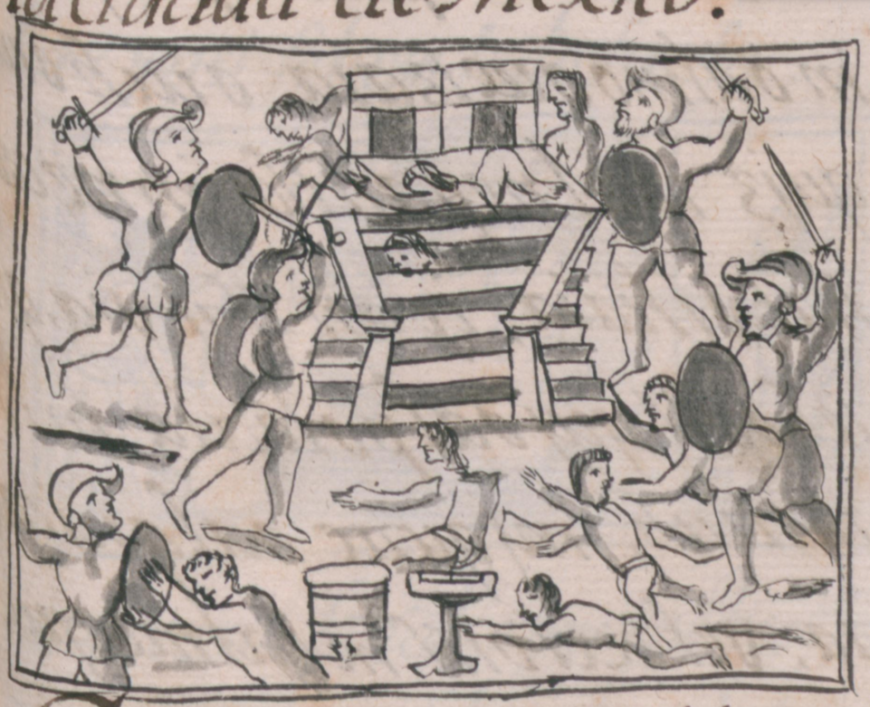
Competing Histories
This May marks 500 years since the Toxcatl massacre, in which Indigenous people were killed during a festival that took place in the Aztec capital of Tenochtitlan (today’s Mexico City). Two competing histories of this event exist. In the Spanish telling, the conquistadors acted in self-defense, yet a very different narrative emerges in the Indigenous version.
On May 22, 1520, Spanish conquistadors and their Indigenous allies attacked the Mexicas—the Nahuatl-speaking ethnic group that dominated a vast multi-ethnic territory that spanned from the Pacific Ocean to the Gulf coast, and from central Mexico to present-day Guatemala. The attack during the Toxcatl festival incited a war that led to the end of Mexica supremacy and to the beginning of the conquest of Mexico.
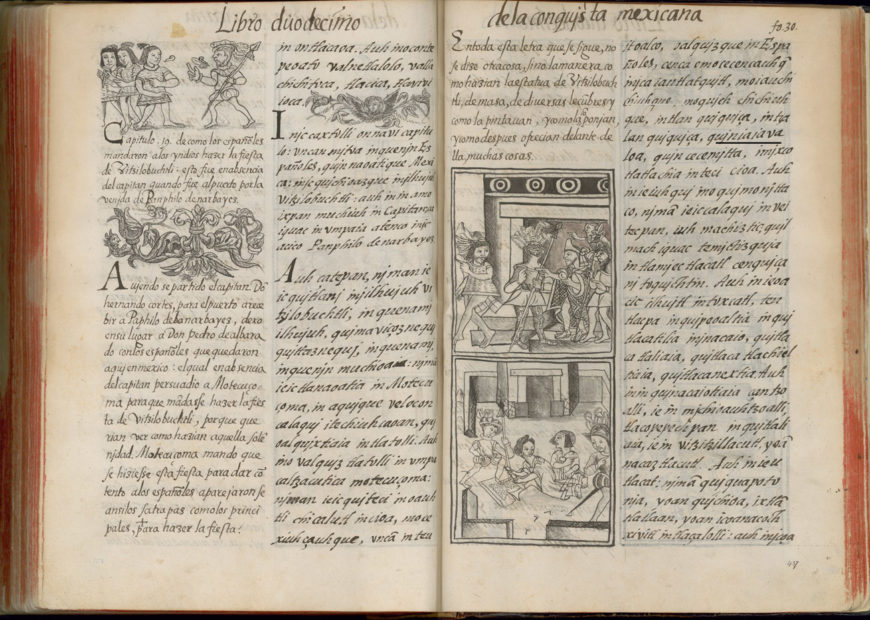
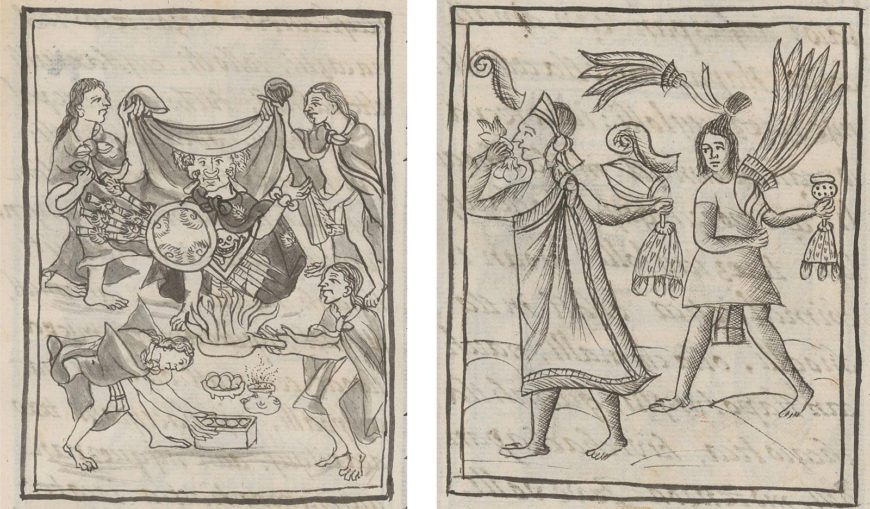
For most of the past 500 years, this history of the conquest of Mexico has been based on the accounts of Spaniards. Francisco López de Gómara’s La conquista de Mexico was one of the most influential historical accounts of the conquest of Mexico, drawing on Hernán Cortés’s letters addressed to the Spanish king that justified the attack. The Spaniards claimed the festival was a cover-up for an Indigenous rebellion. However, Nahuatl-language texts survive that tell us an alternative version. They excruciatingly detail the human horror and the treachery of a mass murder, now known as the Toxcatl Massacre. One of the most critical Indigenous sources is Book 12 of the Florentine Codex, the manuscript that is the focus of a digital research initiative at the Getty Research Institute.
The Mexica Perspective
Book 12 of the 16th-century Nahuatl-Spanish encyclopedia, known as the Florentine Codex, preserves the point of view of the Mexicas. It is the longest and most detailed historical account of the conquest written in Nahuatl, the lingua franca of pre-Hispanic central Mexico. Here the Toxcatl Massacre is described as an attack carried out with cruelty, stealth, and treachery. The Nahua authors write that the Spaniards ordered the ceremony to take place, even after they detained the Mexica ruler, Moteuczoma Xocoyotzin, and looted the palace for gold.
Book 12 of the Florentine Codex begins with an illustration of the Toxcatl Massacre. The Nahua authors and artists deliberately placed this image at the beginning of the book to foreground their underlying argument: the treacherous attack and ensuing war on Tenochtitlan, the Mexica capital, and the sister city Tlatelolco were unjustified.
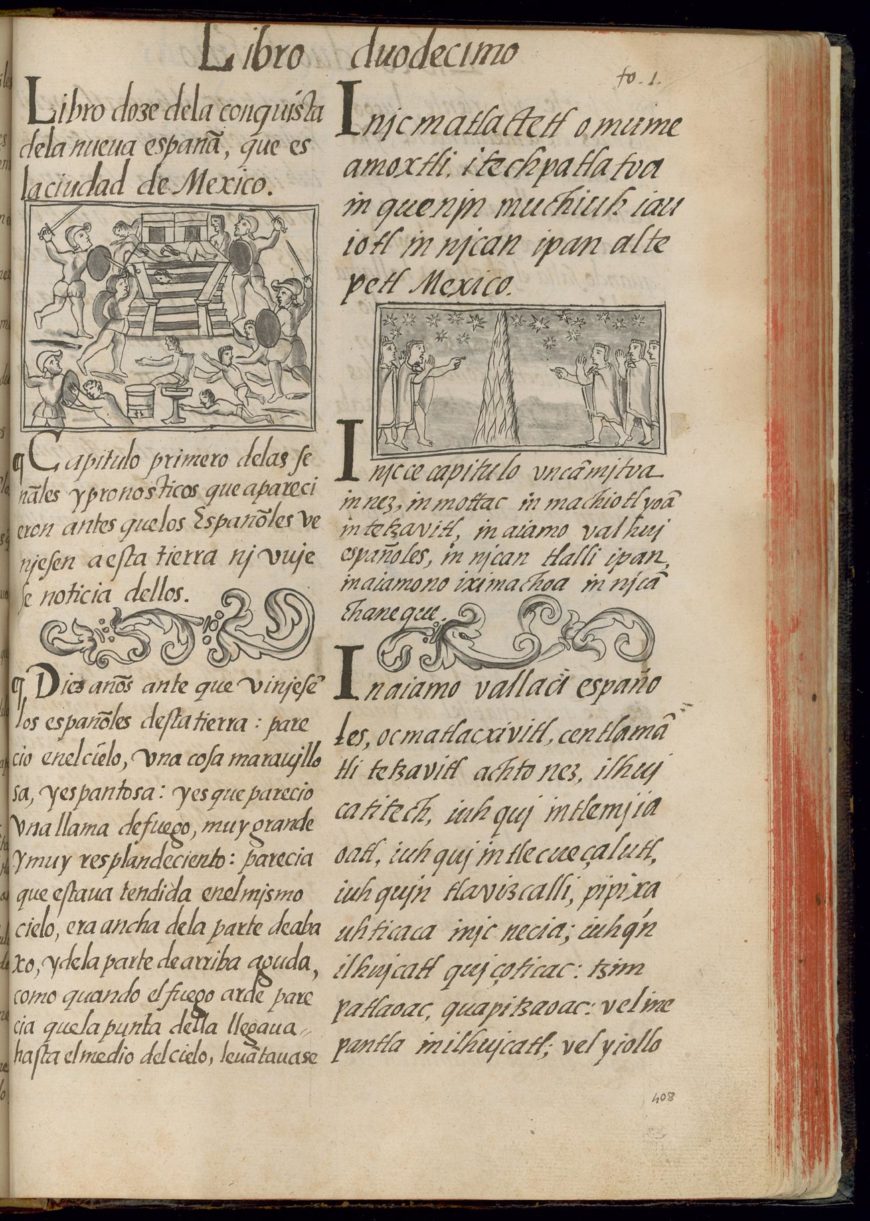

The image depicts the gruesome attack: armed Spaniards crowd in from all sides and hack away at unarmed Mexicas gathered for the ceremony. In the background is the Templo Mayor, Tenochtitlan’s main ceremonial temple, signaling the sacred environment in which this massacre was perpetrated. Two traditional drums in the foreground, the vertical huehuetl and the horizontal teponaztli, underscore the violent interruption of the religious festival. The Nahuatl text in Book 12 and in other 16th-century Nahuatl sources, such as the Codex Aubin, detail how the Spaniards initiated the attack by cutting off the hands of the drummer and then dismembering him—a traumatizing memory also captured in multiple images in the manuscript.
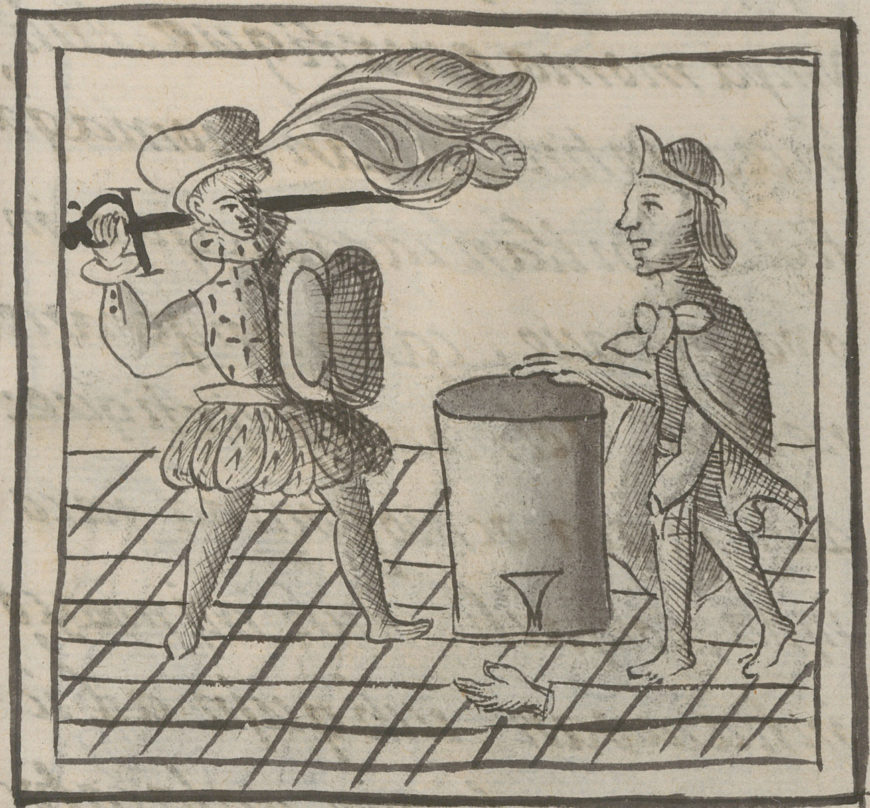
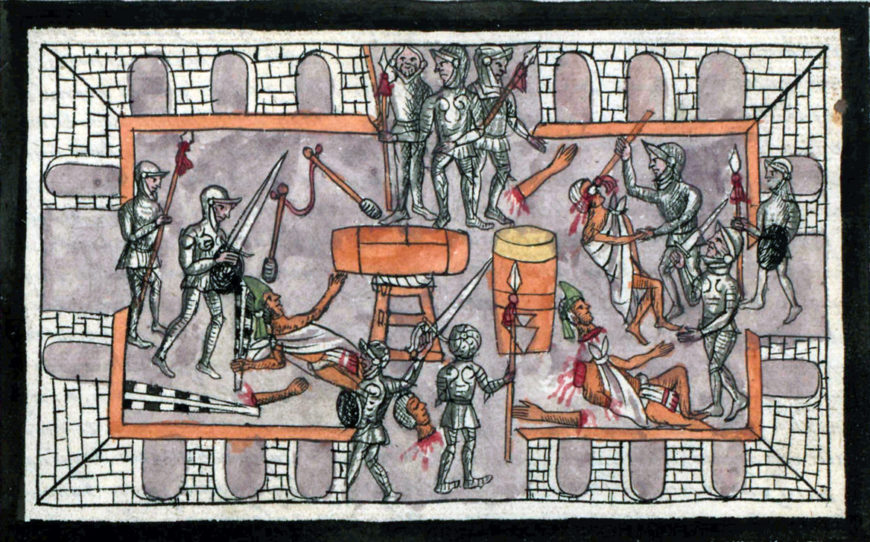
These painful visual elements are echoed in this colorful image painted in a history of New Spain compiled by the Dominican friar Diego Durán in 1579. Again, we see two drums at the center, Spaniards entering the sacred courtyard from all four sides, and dismembered and bleeding Mexica bodies. This image was most likely painted by an Indigenous artist. We see a European-style colonnade, but the architecture and people are flattened against the pictorial plane to allow for maximum visibility following Indigenous artistic norms.
The Nahuatl text of Book 12 recounts the bloody scene:
Then they stabbed every one with iron lances and struck them with iron swords. They stuck some in the belly, and then their entrails came spilling out. They split open the heads of some, they really cut their skulls to pieces, their skulls were absolutely pulverized. And some they hit on the shoulders; their bodies broke open and ripped. Some they hacked on the calves, some on the thighs, some on their bellies, and then all their entrails would spill out. And there were some who were still running in vain: they were dragging their intestines and seemed to get their feet caught in them. Eager to get to safety, they found nowhere to go.Book 12 of the Florentine Codex
The Mexica Counterattack
Soon, the Mexicas organize a counterattack. The Nahua authors record a speech calling the warriors to take up arms: “Mexica! Warriors! Come running, get outfitted with devices, shields, and arrows. Hurry! Come running! The warriors are dying; they have died, perished, been annihilated. Mexica! Warriors!”
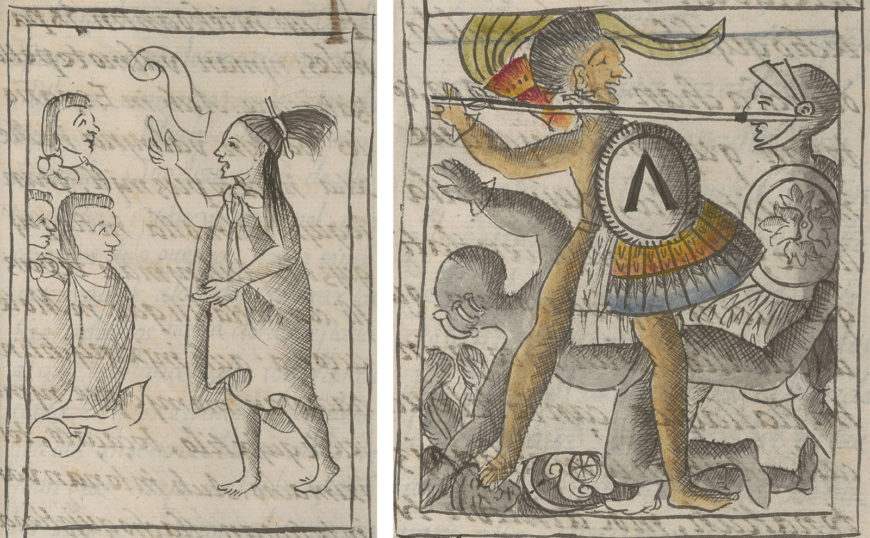
The chapter on the Toxcatl Massacre ends with the Mexica fending off the attackers, in an atmosphere described as “yellowish” (cozpol). The color yellow refers to the blur of arrows, harpoons, and darts, all made from reeds, falling upon the attackers. The Mexicas win this battle but will lose the war that follows. The story ends with the surrender of the Mexicas, led by Cuauhtemoc, the last ruler of Tenochtitlan.
Essay first published in the iris (CC BY 4.0)
Featherworks: The Mass of St. Gregory
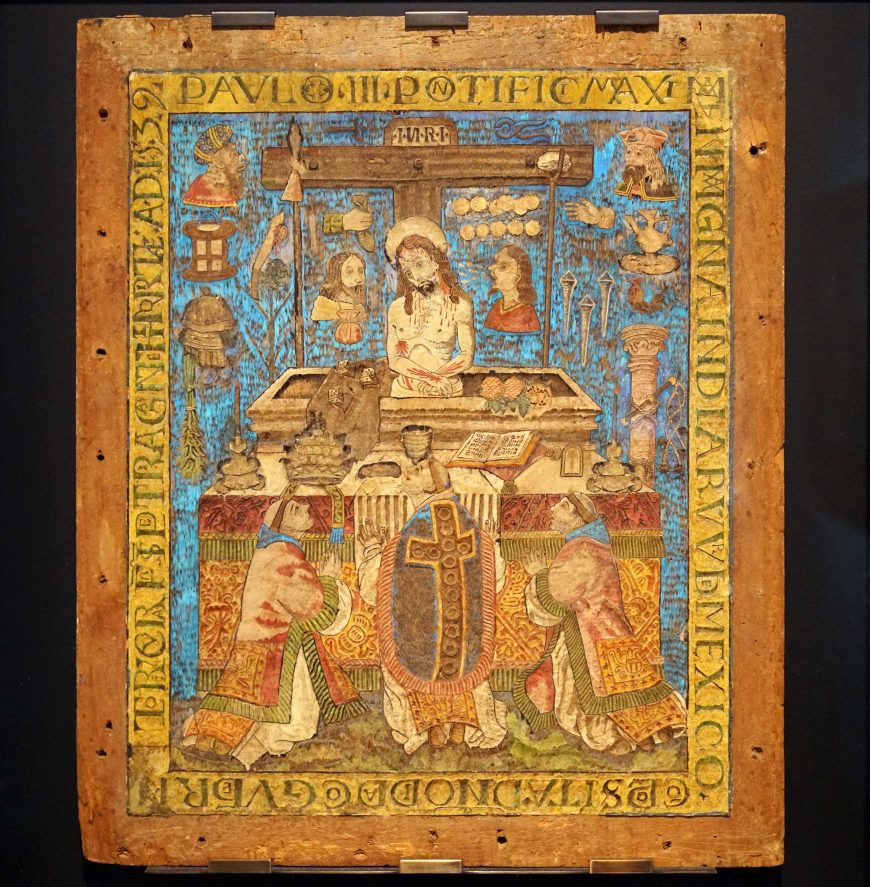
Imagine a two-dimensional artwork made of feathers instead of paint, pen, or pencil. The feathers rustle with the breeze or as you exhale, their iridescent qualities creating a luminous effect as you turn the artwork in your hands or lift it upwards. Feathered artworks were created in Mesoamerica before and after the Spanish Conquest in 1521, with Spaniards and other Europeans marveling at their shimmering beauty and originality.
A clash of traditions
In 1539, the Nahua noble and gobernador (governor) of Mexico City, Diego de Alvarado Huanitzin (nephew and son-in-law to Moctezuma II, the last Aztec ruler before Spanish colonial rule began in 1521), commissioned a featherwork for Pope Paul III showing the Mass of St. Gregory. This artwork, made of different types of bird feathers attached to a wood panel, is remarkable for several reasons. Not only is it the oldest surviving featherwork from colonial Mexico, but it was made by an Indigenous man in order to be sent to the Pope during the early period of Spanish colonization. Two years before the featherwork’s creation, Pope Paul III had issued the bull Sublimus Dei that decreed Amerindian peoples to be rational human beings complete with souls, and called for an end to their enslavement.
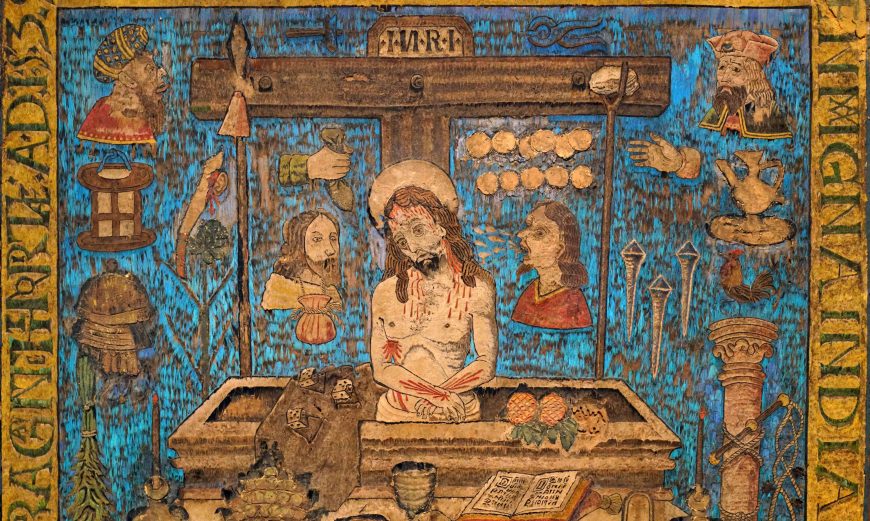
The subject of the Mass of St. Gregory was popular at this time because of its focus on transubstantiation—the belief that the bread and wine transform into the body and blood of Christ during Mass. Saint Gregory was an important 6th-century pope, and one day during Mass he raised the consecrated host (the bread) and experienced a miraculous vision of Christ on the altar. His vision offered proof that the bread literally became Christ’s body when consecrated. Christ appeared to Saint Gregory as the Man of Sorrows—a type of image of Christ, where he is shown above the waist, with his wounds displayed on his hands and side.
The featherwork production of The Mass of Saint Gregory was likely supervised by the famous Franciscan missionary, Pedro de Gante, who came to the Viceroyalty of New Spain (the Spanish colonies in North America) from Flanders to aid in converting the native peoples to Christianity. He established a well-known school that trained Indigenous men in European artistic conventions and techniques. Prints were often supplied as models for these Christian neophytes. The featherwork represents the clash of different worlds—its technique is Mesoamerican, but the subject is European and Christian.
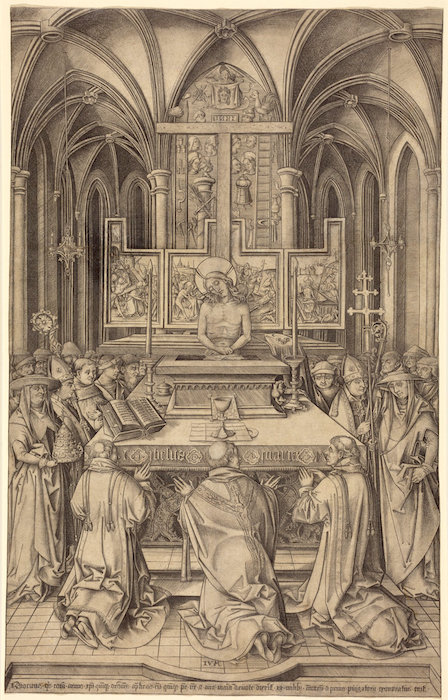
Indigenous artists of early colonial Mexico learned about European artistic techniques and Christian subject matter in schools attached to conventos (missionary centers). Mexico City had some of the most famous, including the School of San Jose where Pedro de Gante worked. Some of the most common models supplied to the students were prints brought from Europe. The Mass of St. Gregory featherwork compares to Israhel van Meckenem’s The Mass of St. Gregory, c. 1490—suggesting the print came to New Spain and provided a model for the 1539 featherwork.
The instruments of the Passion of Christ (also known as the Arma Christi— specifically the instruments of Christ’s suffering, including the column, nails, sponge, cock, and flagellant whip) appear on or surrounding the altar in both van Meckenem’s print and the featherwork. Other colonial Mexican artworks—especially those used to aid in conversion of Indigenous populations—displayed passional instruments. On atrial crosses (crosses found in the courtyards, or atria, of missionary churches), for example, friars could point to the different Arma Christi as they taught native peoples about Christian dogma and biblical history.
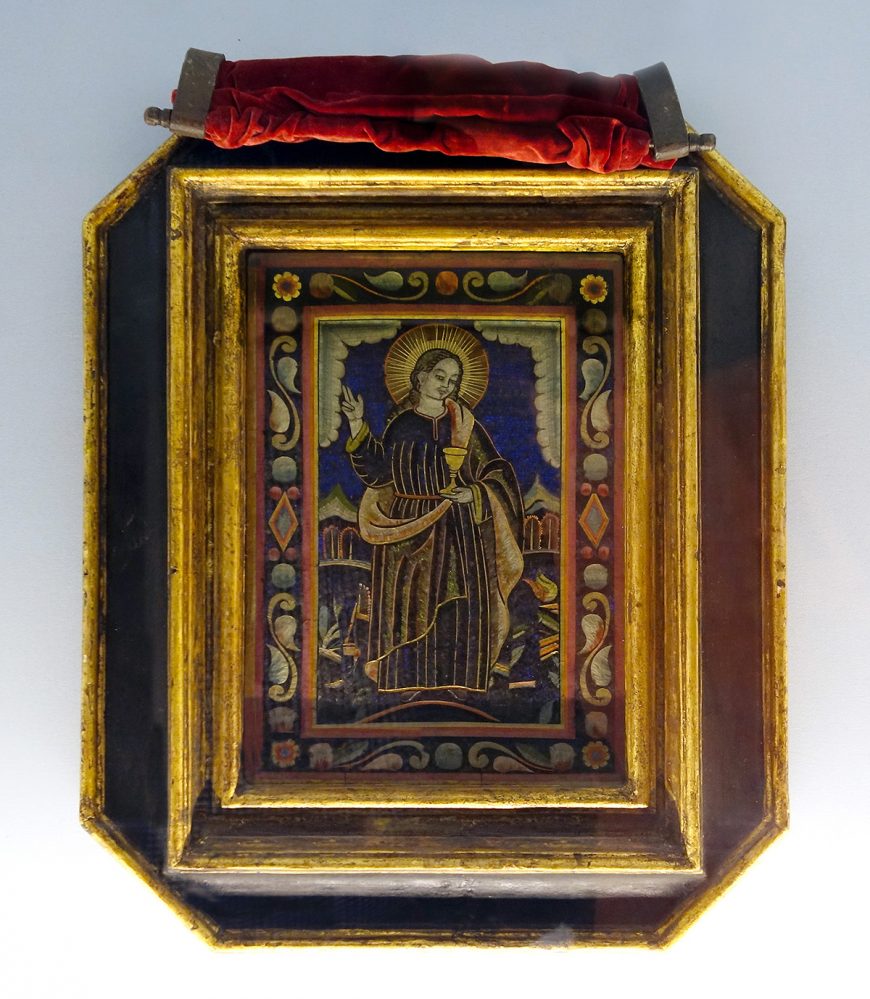
Featherworks
Featherworks were among the most highly prized objects in the early post-Conquest period. Hernan Cortes sent feathered objects to Holy Roman Emperor Charles V to dazzle him with their richness and unique qualities. Others, like Diego de Soto, carried packages of featherworks from New Spain to Spain to give to Charles V soon after the Spanish Conquest. Many featherworks found their way into cabinets of curiosities throughout Europe, no doubt collected because they symbolized the exotic “New World” across the Atlantic. Still today, feathered goods like the so-called Headdress of Moctezuma are some of the most prized possessions of European museums.
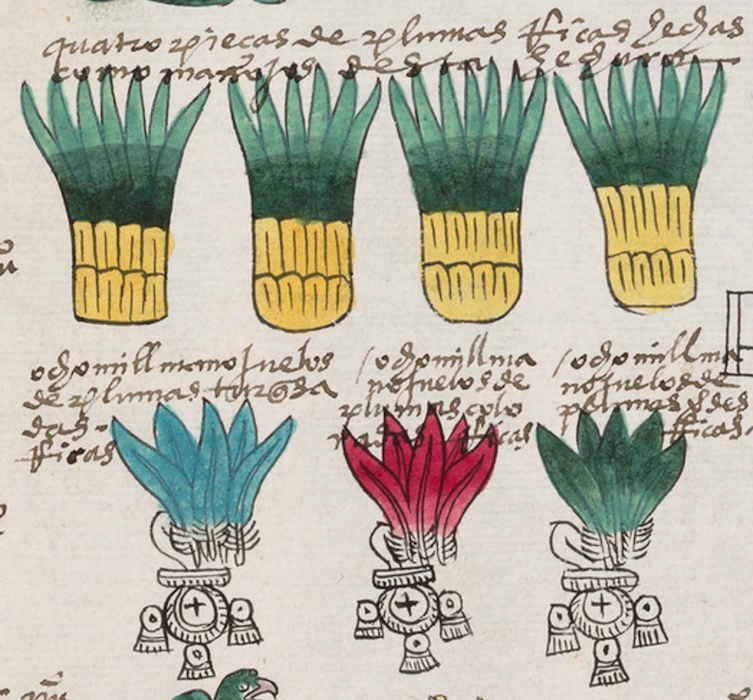
We find many Indigenous groups used feathers to adorn luxury goods, festoon clothing, and function within ceremonies. The Mexica (more commonly known as the Aztecs), were among those groups who prized feathers. Through long-distance trade, the Aztecs acquired feathers from afar. The most highly prized feathers—those of the resplendent quetzal—came from Guatemala. Hummingbirds, macaws, and many other birds supplied feathers. The Mexica also collected feathers as tribute from areas they conquered. Tribute lists illustrated in the Codex Mendoza, produced after the Spanish Conquest, demonstrate the large number of birds and feathers sent to the Aztec capital city, Tenochtitlan. In Tenochtitlan, featherworkers comprised their own special social class. They lived in a neighborhood called Amantla, which is why they were called amanteca.
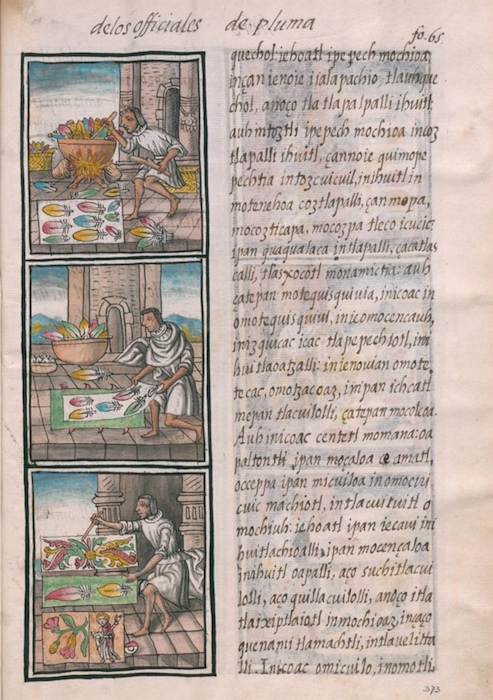
The amanteca and their featherworks were both valuable, as indicated by the attention paid to them in the encyclopedic Florentine Codex, produced by the Franciscan friar Bernardino de Sahagun and his Indigenous collaborators between 1577–79. The Codex devotes many pages to the amanteca and provides numerous illustrations detailing how they worked, including how they glued feathers to flat surfaces.
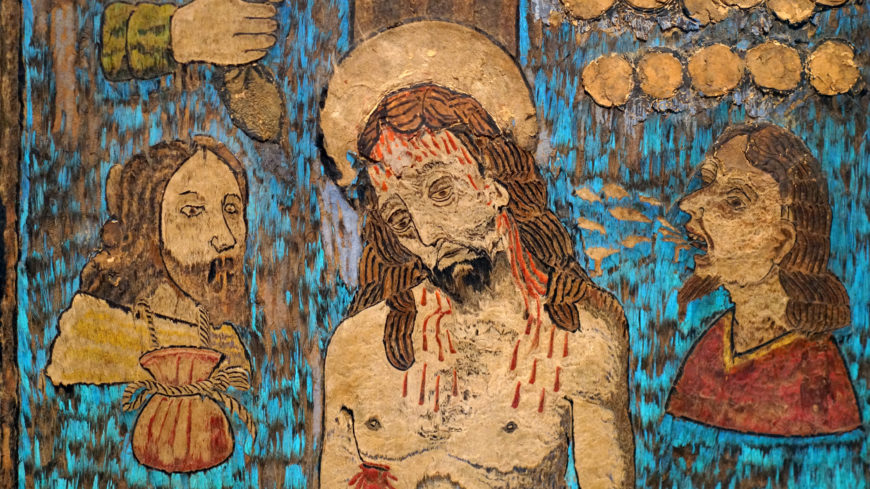
Divine Light
As religious or devotional objects, iridescent featherworks like The Mass of St. Gregory seemed to communicate ideas about divine light. As air passed over their surface, the feathers rustled and moved, animating the object with a life force. Depending on how you held the object, the colors of the feathers seemed to transform as well. Green hummingbird feathers became purple or pink, corresponding to Christian notions of divine light. The iridescent qualities of feathers and their Christian symbolism compare to stained glass windows in Gothic cathedrals, all of which relate to Christ as the lux mundi (the light of the world).

The potential religious connotations of featherworks stimulated the creation of liturgical garments and objects made of feathers. Examples of bishops’ garments (like miters and stoles) and eucharistic altars still exist. Many of the liturgical garments were sent to Europe in the sixteenth century. We know, for instance, that Ferdinando I de’ Medici, the Grand Duke of Tuscany, actively collected featherworks and other items from colonial Mexico.
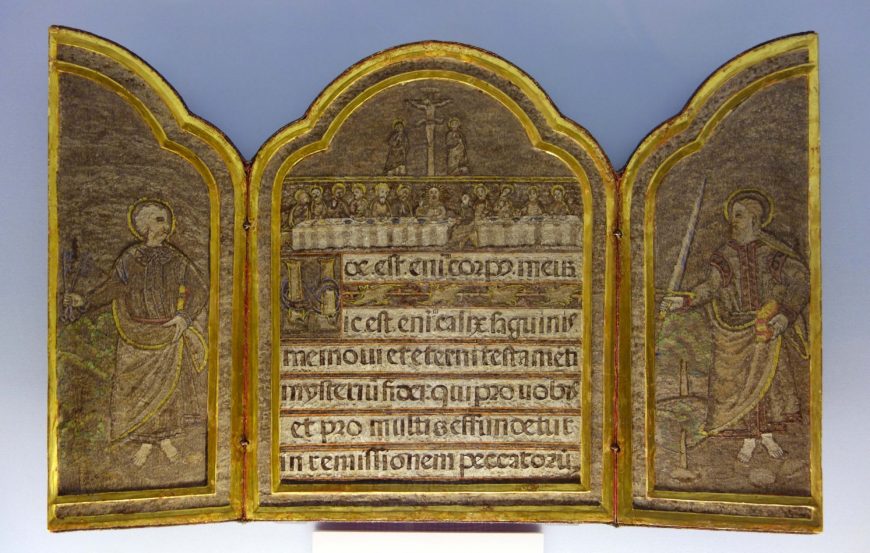
Several sixteenth-century eucharistic triptychs portray the Last Supper flanked by saints Peter and Paul. The central panel also includes a Latin inscription that relates the moment when Christ offers his body and blood—the very same words a priest would say during Mass at the moment of transubstantiation.
Additional resources:
“The Mass of St. Gregory,” in Painting a New World, exh. cat., ed. Donna pierce, Denver Art Museum (Austin: University of Texas Press, 2004), pp. 98-102 (available online).
Engravings in Diego de Valadés’s Rhetorica Christiana
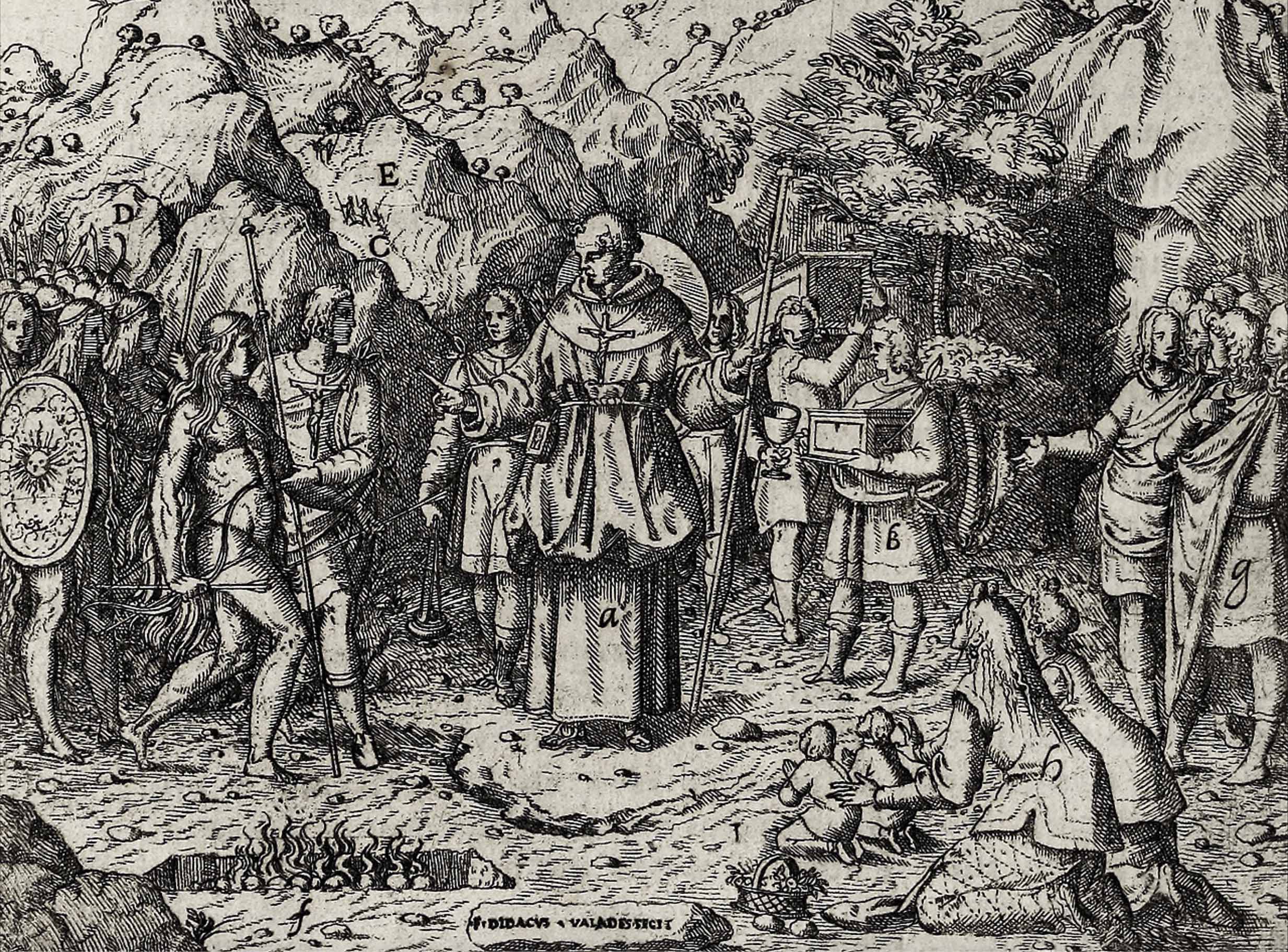
The first book ever printed by an American author was Rhetorica Christiana (or Christian Rhetoric) in 1579 in the city of Perugia, Italy. It was written in Latin and illustrated by Diego de Valadés, who was born in Mexico to a Spanish conquistador father and an Indigenous mother in 1533. He would become the first mestizo to join the Franciscan religious order in the viceroyalty of New Spain, and in 1570 he traveled to Rome on behalf of the Franciscans. His written account was the first published text to describe the evangelization and conversion of Indigenous peoples in the Americas from the perspective of a missionary, and it included twenty-seven copperplate engravings. One shows Valadés accompanied by an inscription that states “F. Didacus Valadés Fecit” or “F. Diego Valadés maker,” announcing to any reader that he created the engravings. Valadés died around 1582, never having returned to Mexico.
Author, Artist, and Missionary
![Diego Valadés, “The Great Chain of Being” or “Ad sensus aptat coelestia dona magister, Aridaq eloquij” 1579, copperplate engraving, within Rhetorica Christiana ad concionandi et orandi usum accommodate […] ex Indorum maximè deprompta sunt historiis. Perugia: Petrus Jacobus Petrutius, 1579.](https://smarthistory.org/wp-content/uploads/2019/11/ChainOfBeingWhole-scaled.jpg)
The Franciscan order was the first group of mendicant friars to arrive in New Spain after the Spanish conquest. They arrived in 1521 in order to convert the Indigenous populations. At the time Valadés joined the Franciscans, Indigenous converts were not allowed to enter the mendicant orders. This might explain why his name is omitted from some records. His father’s status as a conquistador may have helped the young Valadés gain entry to the Franciscan order.
One of Valadés’s teachers was friar Pedro de Gante (Pieter of Ghent), a well-known Franciscan friar who was among the first three Franciscans to arrive from Spain in Mexico, and who worked at the school of Santiago Tlatelolco. Gante helped to train young Indigenous men in the ways of European artistic conventions and to learn Latin and Spanish. Valadés himself was the product of this school. Gante was highly esteemed by Valadés, as well as the king, Charles V, who at one point asked Gante to become archbishop; in his book, Valadés notes that Gante refused.
![Diego Valadés, “The Great Chain of Being” or “Ad sensus aptat coelestia dona magister, Aridaq eloquij” 1579, copperplate engraving, within Rhetorica Christiana ad concionandi et orandi usum accommodate […] ex Indorum maximè deprompta sunt historiis. Perugia: Petrus Jacobus Petrutius, 1579.](https://smarthistory.org/wp-content/uploads/2019/11/ChainofBeingThroneofMercy-scaled.jpg)
Rhetorica Christiana reflects Valadés’s classical, humanist education under Gante, with its references to ancient Greco-Roman authors like Plato, Aristotle, Cicero, Virgil, and Horace, among others. One image called the “Great Chain of Being” encapsulates some ideas derived from ancient philosophers like Plato, Aristotle, and Neoplatonic thinkers in its illustration of a hierarchy of existence. God sits at the top of the hierarchy, with angels below him. They are all encompassed in clouds to suggest their spirit form, which was intended to convey their infinite, un-changing, and perfect form.
Lower on the hierarchy are beings that do change and are imperfect: (in order) humans, animals, plants, and finally stones and minerals. Hell is at the bottom of the engraving, with Satan ruling over the realm of the fallen and sinners. The image encapsulates a sophisticated understanding of matter, science, philosophy, and alchemy borrowed from classical and more modern sources, and speaks to Valadés’s own humanist education.
![Diego Valadés, “The Great Chain of Being” or “Ad sensus aptat coelestia dona magister, Aridaq eloquij” 1579, copperplate engraving, within Rhetorica Christiana ad concionandi et orandi usum accommodate […] ex Indorum maximè deprompta sunt historiis. Perugia: Petrus Jacobus Petrutius, 1579.](https://smarthistory.org/wp-content/uploads/2019/11/ChainOfBeingPeopleToTrees-scaled.jpg)
![Diego Valadés, “Mnemonic Alphabet,” 1579, copperplate engraving, within Rhetorica Christiana ad concionandi et orandi usum accommodate […] ex Indorum maximè deprompta sunt historiis. Perugia: Petrus Jacobus Petrutius, 1579.](https://smarthistory.org/wp-content/uploads/2019/11/hearts-300x433.jpg)
Valadés would eventually work at San José de los Naturales (an important early center for conversation in Mexico City) with Gante between 1543 and 1553. Valadés claims in his book that he learned three Indigenous languages: Nahuatl, Tarascan, and Otomí. He, like many other Franciscans, learned Indigenous languages as a way to facilitate communication and conversion. Valadés served as a missionary for years among the Chichimecs in northern Mexico (in the modern states of Durango and Zacatecas) before he eventually traveled to Europe, most notably to Spain and Italy. It was during his time in Rome that he began work on the Rhetorica Christiana.
Rhetorica Christiana is written in Latin, which indicates its use for a learned audience, specifically Franciscan friars who wished to better understand the missionary ventures in the Americas. The book tackled a number of issues and themes, and supported the overall conversion goals of the Franciscans in New Spain. It includes a number of engravings accompanying the written text, suggesting the important role that Valadés accorded to images. Many of them function as visual mnemonic devices, or a means of using images to help cement ideas in a person’s memory.
Friar Preaching to the Indigenous Population
Valadés describes in the text and shows in the image how Franciscans converted the local Indigenous populations, as well as preached to them. One engraving in Rhetorica Christiana shows a Franciscan friar, likely Pedro de Gante, preaching to a large crowd of Indigenous converts. The friar uses a stick to point to images of the Passion, likely on a lienzo, a large painted cloth, and which was similar to the types of murals often found painted within missionary spaces. This engraving reveals the important role that images played in early conversion efforts because language barriers still existed, and using images became a powerful strategy to teach recent converts Catholic dogma.
![Diego Valadés, “Friar Preaching to Native Converts,” 1579, copperplate engraving, within Rhetorica Christiana ad concionandi et orandi usum accommodate […] ex Indorum maximè deprompta sunt historiis. Perugia: Petrus Jacobus Petrutius, 1579.](https://smarthistory.org/wp-content/uploads/2019/11/preaching.jpg)
Many of Valadés’s images include letters scattered about the scene to help viewers understand concepts. For instance, the letter A is located on the pulpit where the preacher speaks to the crowd and points to images. In the corresponding text, it notes that the letter A says that the friar speaks to the converts in an Indigenous language. With the letter B, it notes that the friar points to the image to correspond to what he says aloud.
The Ideal Atrium
In his discussions of evangelizing the Indigenous population, Valadés mentions that friars preached outside so that they could reach large crowds of people. The engraving of the “Ideal Atrio” is an image of idealized missionary conversion carried out by the Franciscans in Mexico. Letters included with each scene are connected to a key with explanations of each vignette in the scene.
![Diego Valadés, “The Ideal Atrium,” 1579, copperplate engraving, within Rhetorica Christiana ad concionandi et orandi usum accommodate […] ex Indorum maximè deprompta sunt historiis. Perugia: Petrus Jacobus Petrutius, 1579.](https://smarthistory.org/wp-content/uploads/2019/11/RC-atrium.jpg)
In the center of the image, the founder of the Franciscan order, St. Francis of Assisi, leads a procession, which also includes the principal Franciscan missionary Martin de Valencia who was the leader of the group of twelve Franciscans who came to Mexico in 1524. They lead other Franciscans as carriers of the church. The inscription accompanying the central scene states “The first to bring the Holy Roman church to the New World of the Indies.” Above the Franciscans carrying the church we see the dove of the Holy Spirit framed within the architecture, and above the structure itself is God holding Jesus on the cross, creating a vertical line connecting father, son, and holy spirit, and a common visual reminder of the Trinity.
![Diego Valadés, “The Ideal Atrium,” 1579, copperplate engraving, within Rhetorica Christiana ad concionandi et orandi usum accommodate […] ex Indorum maximè deprompta sunt historiis. Perugia: Petrus Jacobus Petrutius, 1579.](https://smarthistory.org/wp-content/uploads/2019/11/RC-atrium-copy.jpg)
In the rest of the image, Franciscan friars teach young men and women about Catholicism. The image also shows friars administering the sacraments, which include baptism, confession, and marriage. Several friars are shown engaged in teaching, subjects such as the creation of the world and penitence.
![Diego Valadés, “The Ideal Atrium,” 1579, copperplate engraving, within Rhetorica Christiana ad concionandi et orandi usum accommodate […] ex Indorum maximè deprompta sunt historiis. Perugia: Petrus Jacobus Petrutius, 1579.](https://smarthistory.org/wp-content/uploads/2019/11/RC-atrium-copy-2.jpg)
The long sticks used to point to images on a wooden board or textile are visible, once again revealing the importance of images as teaching aids in the early post-conquest period. Valadés even includes friar Pedro de Gante teaching Indigenous converts in the upper left corner.
At the bottom of the image, inside the arched structure, friars listen to confession, offer communion, deliver justice, and give last rites to a dying individual. We also see men and women separated, each within their own domed structures at each of the four corners. These chapels in the atrium’s corners recall posa chapels that were built in actual Franciscan missionary complexes, like that at Huejotzingo. They were used similarly to what we see in Valadés’s image: for friars to pause and teach Indigenous people about Catholic dogma or was way stations during processions.
![Diego Valadés, “The Ideal Atrium,” 1579, copperplate engraving, within Rhetorica Christiana ad concionandi et orandi usum accommodate […] ex Indorum maximè deprompta sunt historiis. Perugia: Petrus Jacobus Petrutius, 1579.](https://smarthistory.org/wp-content/uploads/2019/11/RC-atrium-copy-3.jpg)
It is possible that the ideal atrium depicted here was directly borrowed from Valadés’s own missionary experiences during his time at San José de los Naturales under Gante. There, a large atrium and accompanying capilla indio, or chapel for Natives, had been created. This architectural form served as a model for other missionary complexes built throughout New Spain in the sixteenth century.
Indigenous Customs
![Diego Valadés, “Mexico City” 1579, copperplate engraving, within Rhetorica Christiana ad concionandi et orandi usum accommodate […] ex Indorum maximè deprompta sunt historiis. Perugia: Petrus Jacobus Petrutius, 1579.](https://smarthistory.org/wp-content/uploads/2019/11/RC-teocalli-870x1263.jpg)
![Diego Valadés, “Mesoamerican and Julian Calendars,” 1579, copperplate engraving, within Rhetorica Christiana ad concionandi et orandi usum accommodate […] ex Indorum maximè deprompta sunt historiis. Perugia: Petrus Jacobus Petrutius, 1579.](https://smarthistory.org/wp-content/uploads/2019/11/RC-calednar.jpg)
Other parts of the book illustrate and describe Mesoamerican practices, ceremonies, and ideas. In one image, Valadés attempts to reconcile Indigenous timekeeping with European timekeeping. He tries to match the Mesoamerican calendrical wheel with the Julian calendar, although in the end it is not entirely accurate.
In another image, we see a view of Mexico City with a teocalli, around which people engage in diverse activities. They are identifiable as Amerindians by the ubiquitous use of feathered headdresses. By this point, feathers had become a symbol for America and of the Indigenous peoples living there.
Valadés depicts the teocalli as an elevated platform, on top of which is an open air space and a rounded, apsidal space. Below the elevated platform, people dance in a slightly sunken courtyard. Surrounding the teocalli we find buildings, trees, pathways, and people engaged in day-to-day activities. This particular engraving was actually a fold-out image.
The importance of education
Rhetorica Christiana asserts the success of the Franciscan mission to convert Native peoples in New Spain. For Valadés the proof lay in Native peoples’ understanding Catholic dogma and liturgy. Throughout his text, Valadés argues for the education of Indigenous peoples, and in so doing also argues for their humanity. After the Spanish conquest in 1521, and throughout the sixteenth century, there were arguments over whether Indigenous peoples of the Americas qualified as human beings, as people with souls.
![Diego Valadés, “The Seven Liberal Arts,” 1579, copperplate engraving, within Rhetorica Christiana ad concionandi et orandi usum accommodate […] ex Indorum maximè deprompta sunt historiis. Perugia: Petrus Jacobus Petrutius, 1579.](https://smarthistory.org/wp-content/uploads/2019/11/RC-liberal-arts.jpg)
Valadés makes his position clear—Native peoples needed to be educated. For Valadés, a Christian humanist education brought with it a civilizing influence, and so he argued for the need to educate the Indigenous population. One of his engravings shows the seven liberal arts, which included grammar, dialectic or logic, rhetoric, arithmetic, music, geometry, and astronomy. An engraving like this one reminded readers once again of the importance of a liberal arts education in an American context, and the images clearly played an important role within Valadés’s own vision of education and evangelization.
Additional resources
Read more about mission churches as theaters of conversion in New Spain
Learn more about how friars used atrial crosses to educate the Indigenous population of Mexico about Catholicism
Read more about how other artists invented visions of America in the sixteenth century
Saintly violence? Santiago on Horseback
by DR. LAUREN KILROY-EWBANK and DR. BETH HARRIS
Video \(\PageIndex{16}\): Santiago on Horseback, 16th century, polychromed and gilded wood (Museo Franz Mayer, Mexico City, Mexico)A conversation between Dr. Lauren Kilroy-Ewbank and Dr. Beth Harris
Introduction
Santiago Matamoros (or Saint James the Moor Slayer) was the patron saint of the conquest and colonization of the Americas by Spain. He was associated with conquest long before the Spaniards arrived in the Americas, since he was believed to have miraculously helped Spanish Christians during the Reconquest of the Iberian Peninsula (Spain and Portugal) from Muslims (which started after 711).
In 1492, the final Muslim stronghold was defeated—the same year that Christopher Columbus arrived in the Caribbean. After the Spanish Conquest of the Aztecs in 1521 (in what is today Mexico City), the process of colonization and conversion began in what would be called the Viceroyalty of New Spain. Santiago became an important saint in New Spain, and he became known by the nickname Santiago Mataindios (Indian Killer)—recast to convey Spanish dominance over the Indigenous population. The saint’s aggressive, violent defense of Spanish Christians was celebrated on both sides of the Atlantic but is deeply troubling today. To complicate matters, in the seventeenth and eighteenth centuries, some indigenous groups in the Americas even adopted the saint’s image as an icon of resistance–in what may seem at odds with what the saint symbolized for Spaniards after the conquest. It testifies to the many meanings that saints accrued in the complex communities of the Americas.

Terms
- Reconquest
- Polychrome wooden sculpture
- Estofado
Test yourself with a quiz!
START
Additional resources:
Read more about Spain in the 15th and 16th centuries
Read more about another version of Santiago Matamoros/Mataindios from New Spain on Vistas
Javier Domínguez García, “Santiago Mataindios: La Continuación De Un Discurso Medieval En La Nueva España.” Nueva Revista De Filología Hispánica 54, no. 1 (2006): 33-56
Joan Myers, Marc Simmons, and Donna Pierce, Santiago: Saint of Two Worlds (Albuquerque: University of New Mexico Press, 1991)
For more on how indigenous peoples (on occasion) adopted Santiago after the sixteenth century, see John M. Watanabe, “From Saints to Shibboleths: Image, Structure, and Identity in Mayan Religious Syncretism,” American Ethnologist 17, no. 1 (Feb 1990): 131–50
Constanza Ontiveros Valdés, “Las andanzas de Santiago en la nueva España y la imagen del indio: Santa María Chiconautla,” Ad Limina , no. 4 ( 2013)
Elisa Vargas Lugo et al., eds., Images of the Natives in the Art of New Spain (Mexico City: Banamex, 2005)
For the classroom
Print out and use the Santiago Active Video Note-taking document (for teachers and students)
Discussion questions
- Compare the sculpture with the painting of Saint Michael Defeating the Devil by the Master of Belmonte (15th century, Spain). What do these works tell us about the idea of conquest and religion in Spanish culture of the fifteenth and sixteenth centuries?
- What does Santiago Mataindios tell us about race and the process of colonization in New Spain? How does this compare with other types of 16th-century New Spanish art, such as the murals of San Agustín de Acolman?
- How do polychrome wooden sculptures, such as Santiago Mataindios and Juan Martínez Montañés and Francisco Pacheco’s Christ of Clemency broaden our understanding of renaissance/early modern sculpture? How do they compare with sculptures such as Michelangelo’s Pietà?
- How do we think about works of art that were once celebrated but are now deeply troubling and racist? Why is it important to study violent and intolerant periods in history?
The manuscripts of Luis de Carvajal
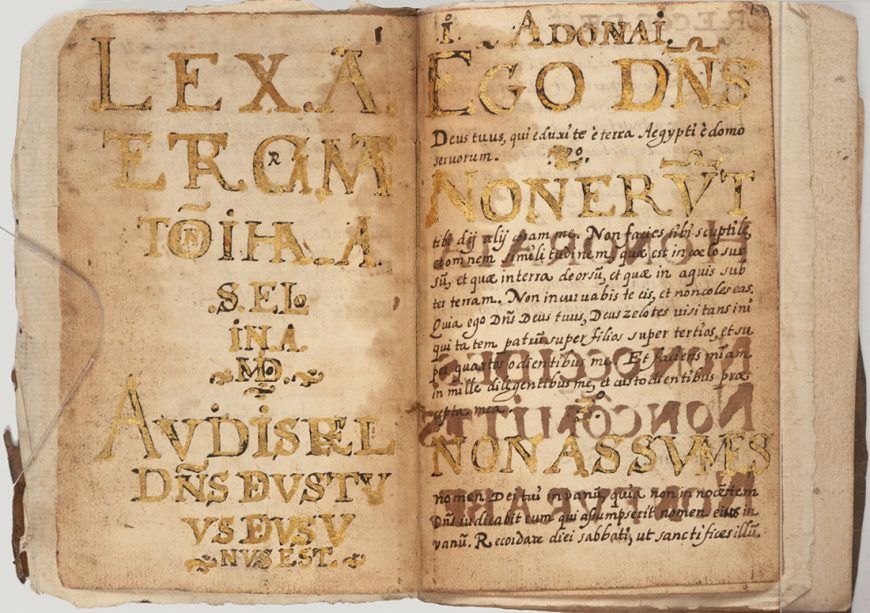
A secret faith
In 1596, Luis de Carvajal, along with his mother and sisters, were condemned to the flames of an auto da fé in Mexico City for their secret adherence to Judaism. The Carvajals were conversos, descendants of Jews who converted to Catholicism often under great duress in Spain and Portugal during the late middle ages. A minority of these converts maintained their ancestral faith in secret, braving the wrath of the Inquisition.
The Carvajals moved to Mexico for the same reason other Spaniards left the Old World for the New—economic opportunities and the chance to remake themselves in a new land. While the Inquisition only functioned in the Americas beginning in 1571, many conversos migrated to the ports and major urban centers of the Americas from the earliest days of Spanish conquest and colonization in the early 16th century. Carvajal’s uncle, also named Luis de Carvajal, was a decorated conquistador who was named the governor of the frontier territory of the Nuevo Reino de León in the Northeastern part of modern-day Mexico, and he invited relatives to join him in New Spain. Though he was a devout Catholic, much of his family, including his nephew Luis, who worked as his main assistant, were crypto-Jews. Eventually the secret unraveled, and the family was arrested by the Inquisition in 1589. The younger Luis, his mother, and his sisters all asked for mercy and were placed in a monastery to serve out their penance. The uncle was stripped of his position and exiled; he died in prison.
A life story lost and found
Soon after the younger Carvajal was released from the monastery, he began to compose an electrifying spiritual autobiography. He was a trained calligrapher and he wrote his life story in tiny, lucid script in a small leather-bound book that he kept hidden on his person throughout his travels. In these writings, he charts the guiding hand of Providence in his spiritual adventures, and his last entry tells of his planned escape to Italy. Sadly, Carvajal and his family were arrested before they made it to safety, and the autobiography which was meant to declare God’s mercies was found and used by the Inquisitors as evidence against them.
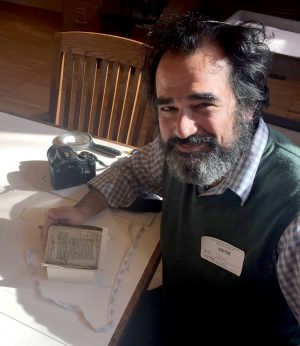
The autobiography, along with some of Carvajal’s other writings, were preserved with the extensive trial records and stored in the Mexican National Archives until they were mysteriously stolen in 1932. These documents were thought to have been lost for over eighty years, until they resurfaced and were identified as the long-lost texts by Leonard Milberg, a renowned collector. Milberg alerted the authorities and arranged for the return of these documents to Mexico.
Before their official return, however, the manuscripts were put on display at the New York Historical society, where I had a chance to look at them up close. I have been working on Carvajal’s life story for the past 15 years and I was overjoyed to finally see his handwriting and read the lines he penned with such passion. I—and all of the scholars who have investigated this sensational case of crypto-Jewish activity in the heart of colonial Mexico—had previously relied on a transcription of Carvajal’s autobiography made by Alfonso Toro a few years prior to the theft of the manuscripts. After many years living with this text, analyzing, contextualizing, and turning it around in my head, it was a real thrill to sit with the original, up close.
New discoveries, new questions
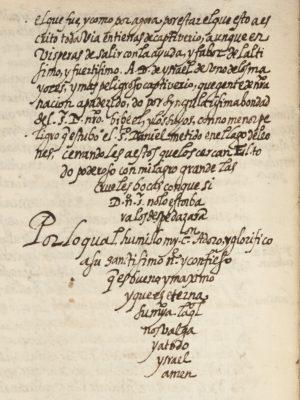
The small bundle of manuscripts seemed to be inviting me in with their neat lines of tiny script. The first section was like meeting an old friend, or seeing the face of a longtime pen pal. I knew the lines of Carvajal’s autobiography inside and out, but I had never seen them in his own hand, nor did I know about the small side notes and elegant arrangement of the heading—the dedication to the Lord of Hosts that announces the beginning of his tale—nor the way he arranged the last lines in a final triangular flourish. Those details point to the fact that it was a text he went back to, added to, and revised. It also tells me that he really thought that he was about to escape the shadow of persecution and that his story of trials and tribulations was coming to a favorable end.
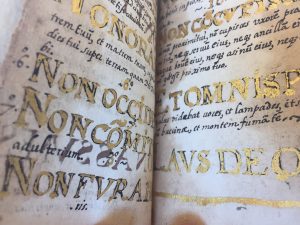
But then I encountered works I had never known about like El modo que es de Rezar, a guide to prayer for himself and for his fellow secret Jews in Mexico, and a list of the acts of mercy that the “most high God performed for Joseph”—a review of the major events of his short and tumultuous life.
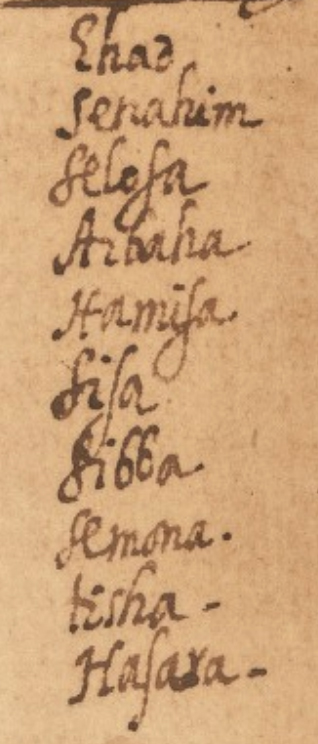
Right before this list, which takes up two pages, I found a section with the ten commandments in Latin, written out in beautiful large letters with gold leaf. New questions emerged: I knew Carvajal was an expert calligrapher, but where would he have had access to the materials and knowledge of the technique to apply the gold leaf?
There is another page towards the end with a list of Jewish holidays and their corresponding Christian dates, along with another column featuring the name of the Hebrew months and a list of transliterated Hebrew numbers from one to ten—a Hebrew primer for a fully Latinized Converso Jew? What follows is even harder to understand—some psalms in Latin and some prayers in Portuguese, along with some deeply cryptic lists that seem to be mystical codes waiting to be deciphered.
More to decipher
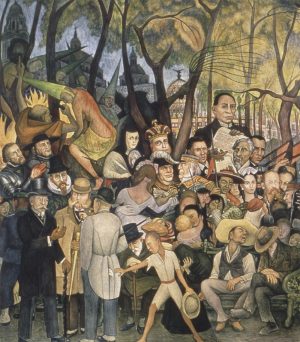
The story of the Carvajal family has intrigued historians of colonial Mexico and has caught the imagination of a wide range of Mexican intellectuals and artists. Their experience is often read as an exemplary tale of the abuses of religious authority and the struggle for freedom of belief. I believe that the story of the Carvajals also complicates and enriches our understanding of Latin American religious history and points to the diversity of colonial society and the dynamism of religious creativity and expression that can still speak to spiritual seekers today.
Now that these texts have been digitized and the originals are securely back in Mexico, scholars will be able to explore and ask more questions of these beguiling records of a vibrant and short-lived religious life.
Additional resources:
Digitized version of the Luis de Carvajal manuscripts from Princeton University Digital Library
“A Secret Jew, the New World, a Lost Book: Mystery Solved,” The New York Times, January 1, 2017
Ronnie Perelis, Narratives from the Sephardic Atlantic: Blood and Faith (Indiana University Press, 2016)
What does the music of heaven sound like? St. Cecilia in New Spain
Video \(\PageIndex{17}\): Andrés de Concha, St. Cecilia, 1590, oil on wood (Museo Nacional de Arte, Mexico City, Mexico)
Additional resources
This painting in the collection of MUNAL, Mexico City
A Renaissance miniature in wood and feathers
by DR. LAUREN KILROY-EWBANK and DR. BETH HARRIS
Video \(\PageIndex{18}\): Pendant triptych with scenes of the Passion, 16th century, boxwood, feathers, gold, enamel, 4.4 x 4.4 cm (The Metropolitan Museum of Art)
17th and 18th centuries
Baltasar de Echave Ibía, The Hermits
by DR. LAUREN KILROY-EWBANK and DR. STEVEN ZUCKER
Video \(\PageIndex{19}\): Baltasar de Echave Ibía, The Hermits, Saint Paul and Saint Anthony, c. 1620, oil on copper, 51.5 x 37.5 cm (Museo Nacional de Arte [MUNAL], Mexico City)
SmartHistory images for teaching and learning:
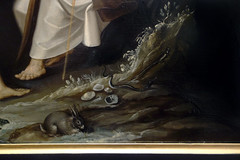

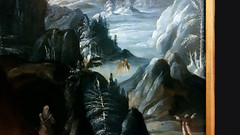
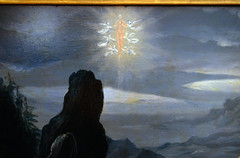
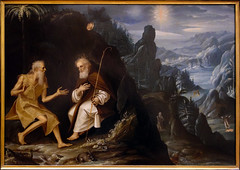
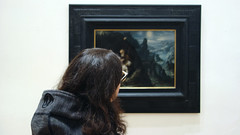
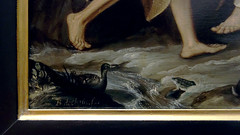
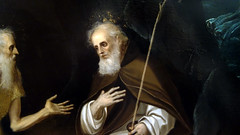


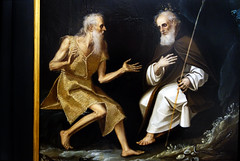

Mission Church, San Esteban del Rey, Acoma Pueblo
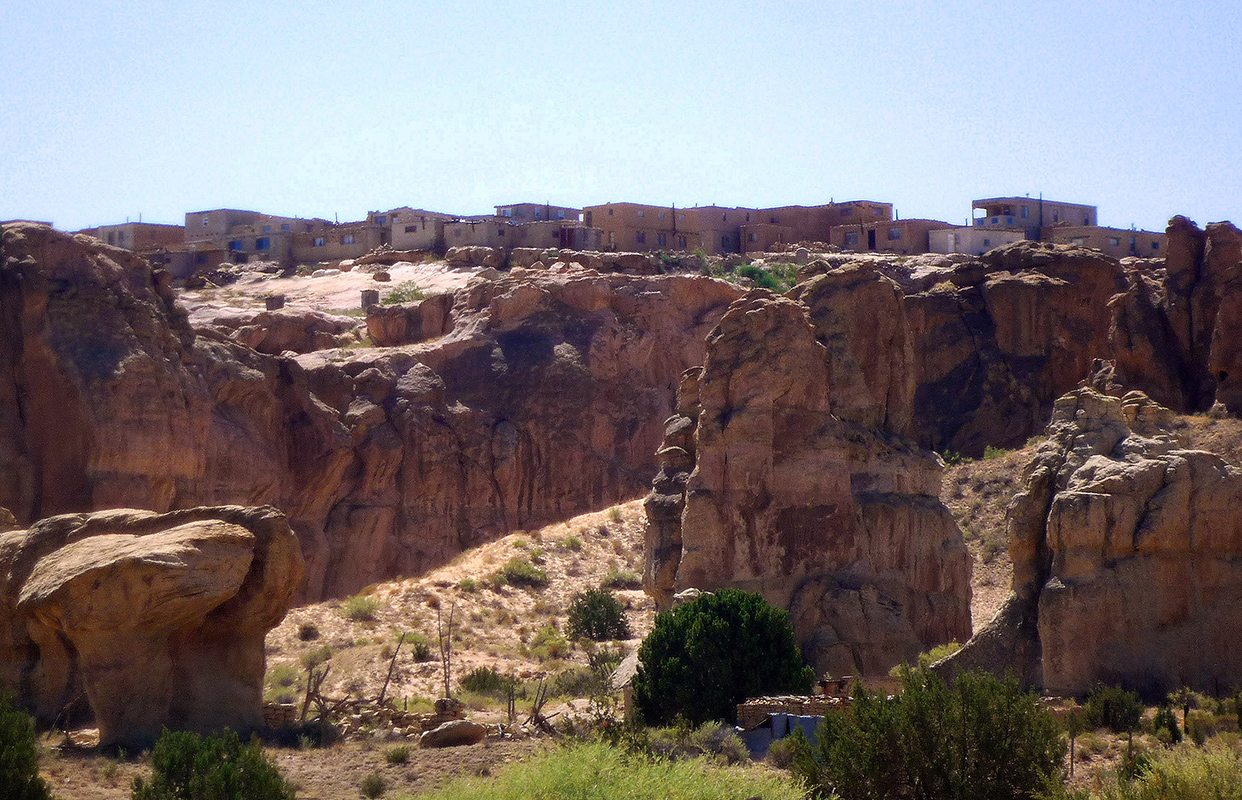
Stunning and dramatic, Acoma Pueblo is magnificent to visit not only for its spectacular location, but also because it is home to one of the best-preserved early mission churches in the United States. Standing on the edge of Acoma Pueblo (referred to as Sky City), one can see vast panoramas of the New Mexican landscape. What is a mission church?
Acoma sits on a mesa—a flat-topped hill with steep sides—about 360 feet above sea level, and until the mid-20th century, the only access to the Pueblo was via a narrow stone staircase carved into the mesa itself (pueblo is the Spanish word for a town or village). The location of the Pueblo is imposing and impressive, and it is easy to grasp why so many described it as impregnable. In the past, its elevated location aided in protecting it from invaders. Acoma Pueblo is believed to be one of the oldest continuously inhabited communities in the United States.

A city in the sky
The Pueblo is filled with dwellings ranging from one to two stories, all fashioned in adobe (mud-brick). The tallest and largest structure is the mission church of San Esteban del Rey, built between 1629 and 1642. A Spanish Franciscan friar named Juan Ramirez directed the construction of the church in 1629. The Franciscans are mendicant friars (a religious order where the monks take vows of poverty, chastity, and obedience and depend on charity for their livelihood) that helped to convert the peoples of modern-day New Mexico beginning in the sixteenth century. The practice of building missions for the purpose of conversion began soon after Spaniards defeated the Mexica (often called the Aztecs) in their capital city of Tenochtitlan (what is today Mexico City) in 1521. The Spanish established the viceroyalty of New Spain, which eventually comprised parts of the southwestern United States, Mexico, Central America, Spain’s Caribbean colonies, and the Philippines. What is a viceroy and a viceroyalty?

The church of San Esteban del Rey is based on missionary churches found in Colonial Mexico, but combines local Indigenous techniques and architectural elements. Because it was the first mission built in New Mexico, it became the model for many others erected in this area.
It is a single nave church—it has no transept (or crossing), and is approximately 150 feet long and 40 feet wide. Typical of other mission churches of this era in the Spanish viceroyalty, it has a cloister (a covered walkway surrounding an open space) that may have been used to instruct Indigenous converts, an atrium (an open courtyard in front of the church), and an elevated open-balcony chapel. The walled atrium yard also functions as a cemetery, called a campo santo, in front of, and to the side of, the church.

The Spanish in New Mexico
Spaniards had two primary interests for desiring missions like the one at Acoma in New Mexico—to convert peoples to Christianity and to protect mines in northern Mexico. Led by Francisco Vazquez de Coronado, the Spanish arrived in the area around 1540. In 1542, New Mexico and Arizona were claimed for Spain, but the geographic regions remained largely unsettled because of the harsh conditions and lack of water. The Spanish king, Philip II, officially authorized settlement of New Mexico in 1583, but it was not until 1598 that Juan Perez de Oñate officially claimed this region for Spain.
Franciscans arrived at Acoma in 1598. At first, the peoples of Acoma defeated the Spaniards, but in 1599 the Spaniards were successful after a strategic attack. They claimed St. James (Santiago), appeared on horseback brandishing a sword and intervened to help them conquer Acoma.
The façade of San Esteban del Rey

The church’s unadorned adobe façade is stark and austere, which is different from other Franciscan mission churches such as San Miguel in Huejotzingo, Mexico (in the state of Puebla, image below). San Esteban del Rey has two bell-towers framing a rectangular central area and an elevated open balcony chapel above the main entrance. This elevated space allowed friars to preach to people in the atrium outside the church, and so provided both practical and spiritual functions. Any priest in the open chapel stood higher than any new converts, suggesting he was closer to God and to Heaven.

San Esteban del Rey’s massive adobe walls—bricks made from a mix of clay and straw—need continuous maintenance. In places the walls are seven feet thick, keeping the interior cool during the hot New Mexican summer, but also warm when the temperature drops. The heavy adobe construction limits the number of windows in the church structure. Small windows appear high above the ground, allowing little light into the church interior. The thick adobe walls and dark interior add a sense of awe and mystery to the space, especially as you pass through the main door from outside. You immediately know you have entered a holy space.

The thick unadorned walls, interrupted by only a few windows, gives the façade an imposing quality. Some scholars describe it as having a militaristic or defensive appearance, yet there are no crenellations or other militaristic motifs like the ones we find on Central Mexican mission churches such as Huejotzingo. It is unclear whether San Esteban del Rey actually functioned as a fortress or if this impression was intended to symbolically convey the impression that the church was the stronghold of God.
To build the church, people gathered materials and then transported them up to the top of the mesa. The vigas (wooden beams), for instance, were brought from the San Mateo Mountains—some of which were considered sacred—and which are about thirty miles north of Acoma. This demonstrates the substantial labor required to construct the church.

Church interior
The church’s interior is simple like the outside. You’ll need to imagine what it looks like because interior photos are forbidden. There are no arches, domes, or stoneworking; instead, there are flat ceilings with vigas over forty feet long. The nave is narrow, due in part due to the use of adobe since it can’t hold as much weight as stone.
Packed earth covers the floor. A raised sanctuary demarcates the holiest space within the church. Some of the windows shine light on the altar, literally highlighting its importance. An altarpiece stands in the church’s raised sanctuary. Originally the interior was painted with frescoes, which were repainted often. Today sacred symbols like rainbows, clouds, and corn are visible. These symbols attest to the syncretic Catholicism practiced at Acoma, the result of Puebloan and Christian sacred ideas and practices becoming entangled over time.
The original interior frescoes were whitewashed likely as a result of the Acoma Revolt (1680–92), a period during which many missions were destroyed and missionaries like the Franciscans killed or expelled. Yet San Esteban del Rey survived and it remains a stunning testament to the events that shaped this area during the sixteenth and seventeenth centuries.
Additional resources:
Most of the photographs in this essay were taken by Dr. Steven Zucker and can be found here.
Edward Proctor Hunt, The Origin Myth of Acoma Pueblo (Penguin Classics, 2015)
Ward Alan Minge and Simon Ortiz, Acoma: Pueblo in the Sky (University of New Mexico Press, 1991).
SmartHistory images for teaching and learning

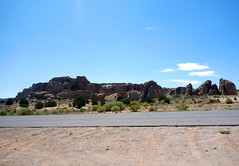


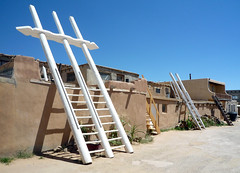
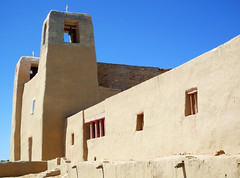
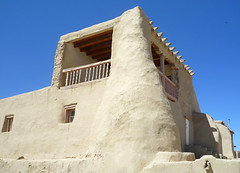
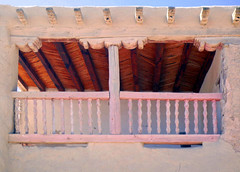

Miguel González, The Virgin of Guadalupe
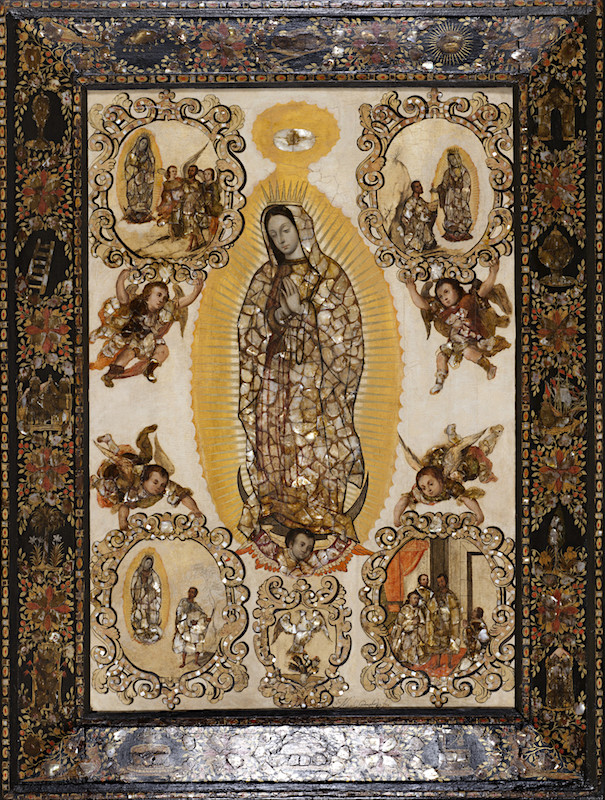
The Virgin of Guadalupe reveals herself to Juan Diego
On December 9th, 1531, a decade after the downfall of Tenochtitlan and the beginnings of Spanish colonization, a man named Juan Diego (born Cuauhtlatoatzin) was walking across the Hill of Tepeyac near a razed shrine to the Mexica (Aztec) earth goddess Tonantzin when a woman appeared and spoke to him in Nahuatl, his native tongue. She revealed herself as the Virgin Mary, and asked Juan Diego to go to the local bishop, Juan de Zumárraga, and ask for a church to be built on the hill in her honor. Bishop Zumárraga did not believe Juan Diego’s story. The Virgin Mary revealed herself to Juan Diego two more times with the same request, but still no shrine was constructed. During her fourth request on December 12th, she told Juan Diego to gather roses from the hill into his cloak (or tilma). When he stepped before the bishop and opened his cloak, the roses—Castillian roses (which are not native to Mexico) spilled forth. Imprinted on the tilma was an image of the Virgin Mary herself, known today as the Virgin of Guadalupe. Zumárraga recognized the miracle, and a shrine to the Virgin of Guadalupe was built on the Hill of Tepeyac, with a basilica to her constructed below. Today, the original miraculous tilma image hangs in the new basilica at Tepeyac in Mexico City.
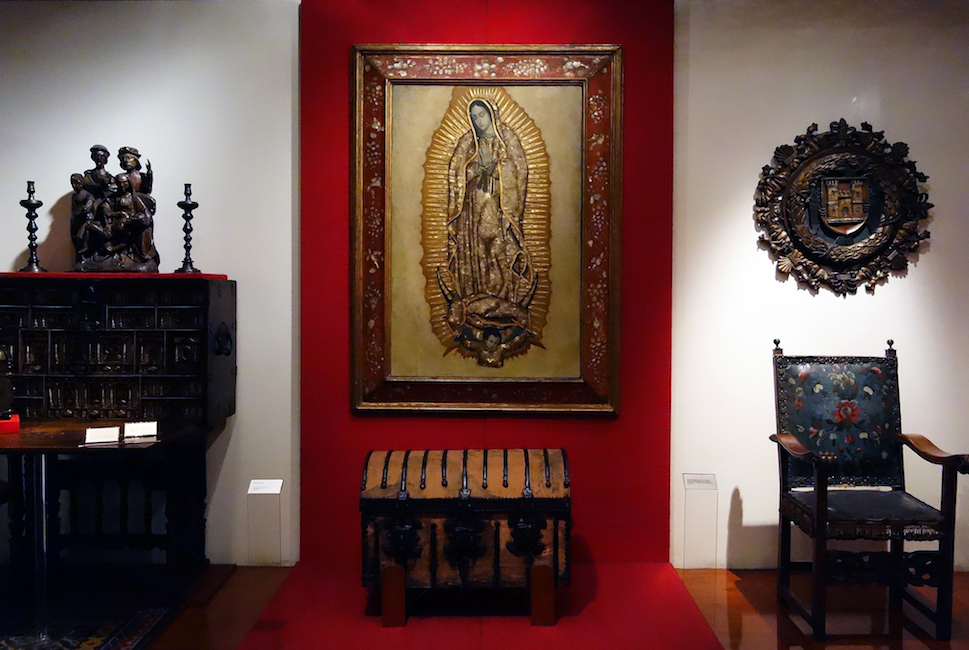
Devotion to the Virgin of Guadalupe increased dramatically in Mexico during the seventeenth century with the publication of books printed in her honor and greater support from the creole population. One of the earliest books recording the apparitions was the Nican mopohua, written in Nahuatl in the sixteenth century and widely distributed in the following century. Creoles began to identify with an “American” or Mexican identity, and supported the Virgin of Guadalupe as a uniquely americano miracle. After all, she had revealed herself on Mexican soil to a Nahua (indigenous) man. With her increased popularity came a demand for more images, especially those that faithfully copied the original miraculous tilma (as in the painting above in the Franz Mayer Museum). Many paintings even include the phrase fiel copia, or “true copy,” to suggest their painting is a direct copy of the tilma image.
Miguel Gonzalez’s enconchado painting
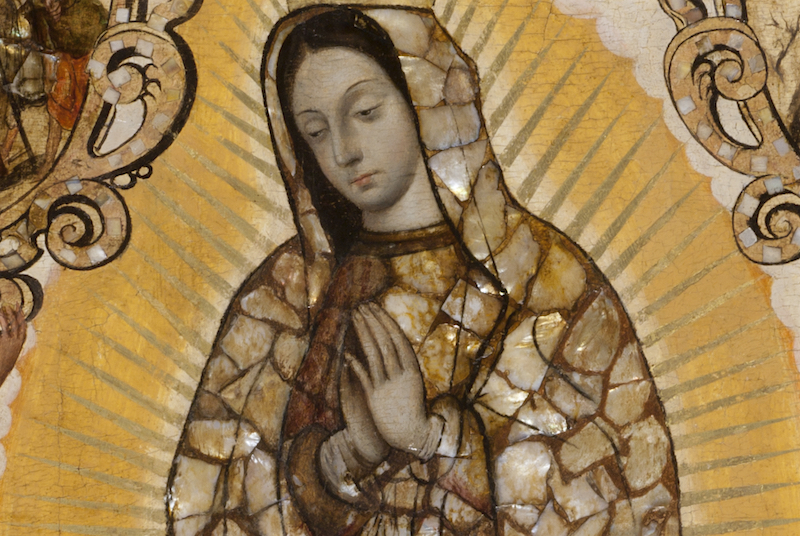
Some of the most remarkable images of the Virgin of Guadalupe are created not entirely in paint, but also include mother-of-pearl, or enconchado. Miguel González’s version portrays the Virgin as she appears on the tilma: in three-quarter view, crowned, hands clasped, eyes cast downwards, encased in light, and standing on a crescent moon that an angel supports. The manner in which the Virgin of Guadalupe appears relates to Immaculate Conception* imagery which was based on Revelation 12: “clothed with the sun, with the moon under her feet and a crown of twelve stars on her head.”

In the four corners of the painting (below) we see four framed scenes carried by angels. These represent different moments in the story of the miracle.
- In the upper left, Juan Diego is led to the Virgin Mary by angels. In the upper right, Juan Diego has a vision of the Virgin Mary at the Hill of Tepeyac; in the lower left, Juan Diego takes leave of the Virgin Mary with a full cloak, and in the lower right Juan Diego reveals the miraculous image on his cloak to the bishop and others.
González uses pieces of mother-of-pearl shell to form most of the Virgin Mary’s clothing (it even decorates the bodies of the angels and the frames they support). The iridescent shell would reflect shimmering candlelight to emphasize the sacredness and importance of the Virgin Mary.
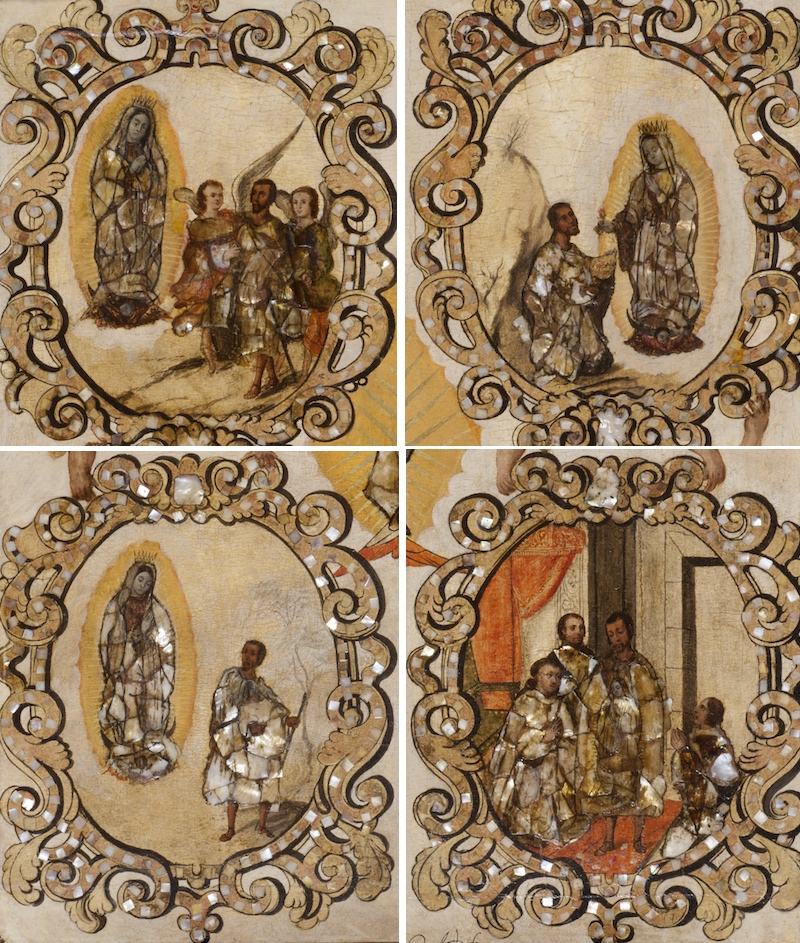

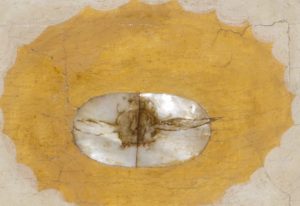
Above the Virgin of Guadalupe is the dove representing the Holy Spirit in a golden cloud, and below an eagle perches on a cactus. You might be familiar with this symbol from the Mexican flag, which refers to the Mexica (or Aztec) and the mythic founding of their capital city, Tenochtitlan (now Mexico City). On their journey from their homeland (Aztlan), the Mexica patron deity Huitzilopochtli (pronounced “wheat-zil-oh-poach-lee”) informed the Aztecs that they would know when to end their journey and establish a new home when they saw an eagle perched on a cactus (the snake got added to the story later), which happened to be on an island in the middle of Lake Texcoco (today, under Mexico City).
By the seventeenth century, when creoles were looking for ways to emphasize New Spain’s greatness and uniqueness, the symbol of the eagle on the cactus once again became popular as a symbol for Mexico City. Its inclusion here—as well as in many other artworks—signals the Virgin of Guadalupe’s direct connection to the people of New Spain, and so connects her to the creoles as well.

Beyond the elaborate use of mother-of-pearl, González also created a frame that includes more pieces of shell inlaid into wood. Floral decorations in red and gold alternate with common symbols of the Virgin Mary that derive in part from the Song of Songs and other Old Testament sources. We see a ladder, palm tree, ship, lily, and fountain. The ladder connoted Jacob’s Ladder or the ladder to Paradise (think of Mary as the ladder by which her son descended to earth and by which mortals will ascend into heaven), while the palm tree signified an Exalted Palm (as recounted in Ecclesiasticus 24:14) and also the righteous and chosen ones (mentioned in Psalm 92:12). Mary is seen as the ship of salvation, but the ship could also refer to Noah’s Ark. The lily refers to Mary’s purity (she is the lily among the thorns), and the fountain refers to Mary as “the fountain of living water” (Jeremiah 17:13).
- Enconchado
Enconchado artworks were popular in seventeenth-century Mexico. The shell is placed into the painting like mosaic, then covered with glazes. Shell-working had been an important art form among some Mesoamerican peoples. In the Florentine Codex, we see illustrations of Mexica shell workers, and discussions of the types of shell used in different types of objects.
Some scholars have noted the connection between enchonchado and Japanese namban lacquer work that uses a similar technique with shell inlaid into wood. Many namban lacquer works also show a preference for red and gold colors, like we see on our Mexican enconchado painting.
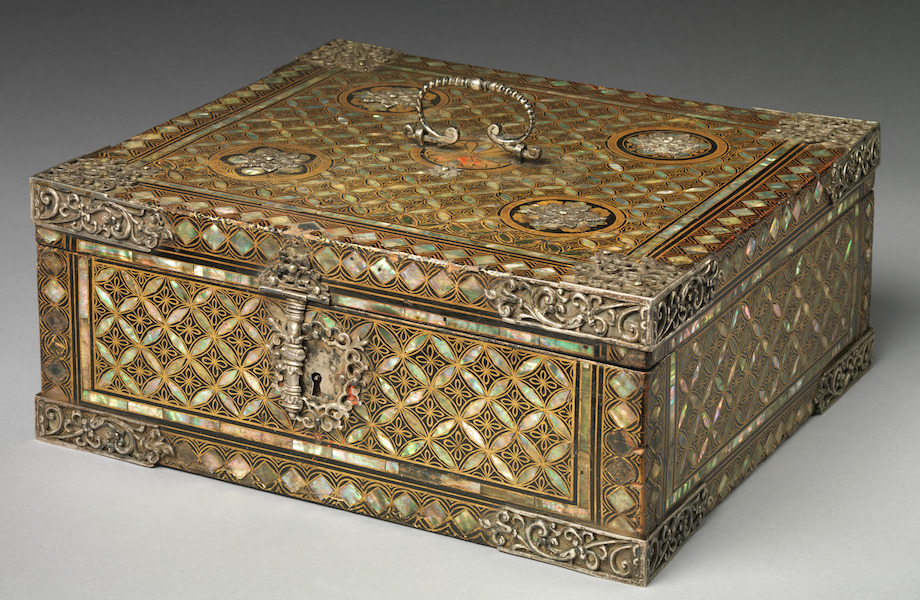
Japanese goods were imported to Mexico via the Manila Galleons, where they were sold or sent on to Spain. Eventually, non-Japanese artists began to copy the Japanese technique.
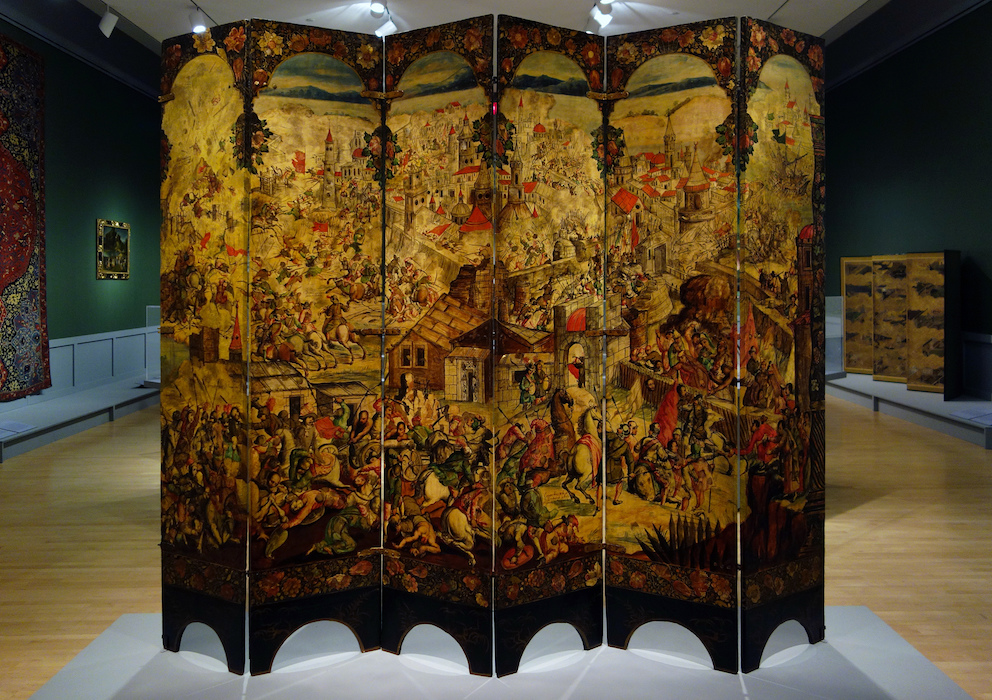
Other types of Japanese objects, like folding screens (called biombos, example above), also became popular. It has been suggested that after Japan cut ties with foreigners in the seventeenth century, the demand for Japanese goods (or Japanese-inspired goods) increased. We even have an example of a Mexican enconchado folding screen that is based on Japanese folding screens and namban lacquer works, but uses imagery borrowed from European prints and tapestries. The desire for Japanese objects is likely one reason for the popularity of enconchado paintings like González’s Virgin of Guadalupe, and they showcase the cosmopolitan nature of colonial Mexican society.
*See the essay on Miguel Cabrera, Virgin of the Apocalypse for more on immaculate conception iconography.
Additional resources:
This painting at the Los Angeles County Museum of Art
Painting Conservation of the Virgin of Guadalupe at the Indianapolis Museum of Art
The Virgin of Guadalupe on Vistas (Visual Culture in Spanish America, 1520-1820)
Screen with the Siege of Belgrade and Hunting Scene (or Brooklyn Biombo)
by DR. LAUREN KILROY-EWBANK and DR. STEVEN ZUCKER
Video \(\PageIndex{20}\): Screen with the Siege of Belgrade and Hunting Scene (or Brooklyn Biombo), Circle of the Gonzales family, c. 1697-1701, oil on wood, inlaid with mother-of-pearl, 229.9 x 275.8 cm (Brooklyn Museum and Museo Nacional del Virreinato – INAH, Tepotzotlán)
SmartHistory images for teaching and learning:
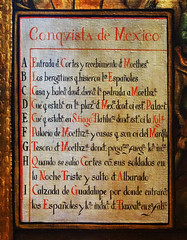
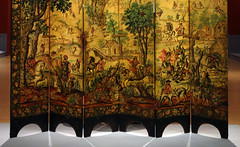
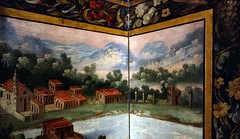
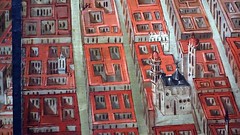



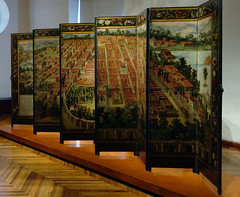
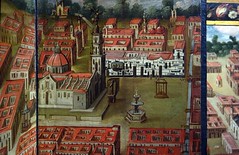

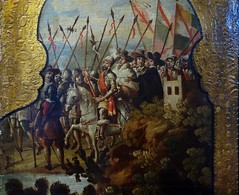
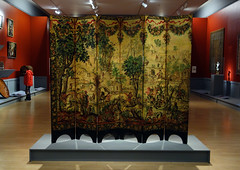
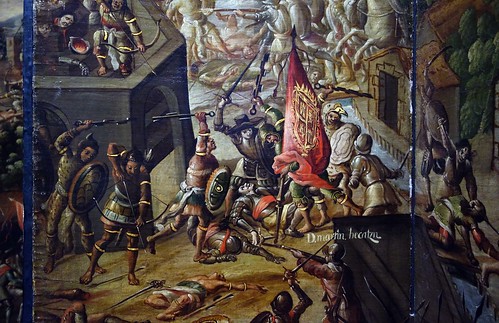
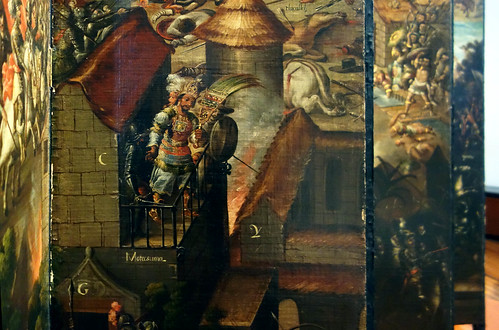
Biombo with the Conquest of Mexico and View of Mexico City
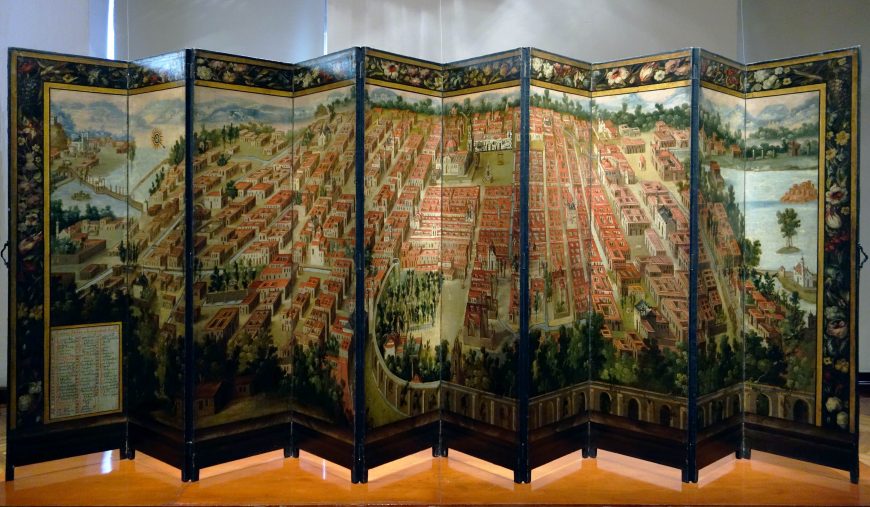
Spices, silks, porcelains and more
François Boucher’s A Bourgeois Breakfast (below) features an upper middle class French family in their fashionable home. In the corner of the room, nestled on a small shelf, is a Buddha statuette, perhaps imported from China, but also possibly created in Meissen, Germany in imitation of Chinese porcelains. “Chinoiserie,” (and later, “Japonisme”) are terms used to describe eighteenth- and nineteenth-century Europe’s fascination with East Asian goods. In reality Europeans had long sought spices, silks, and porcelains from the East, but the Ottomans controlled the trade in these and other luxury goods.
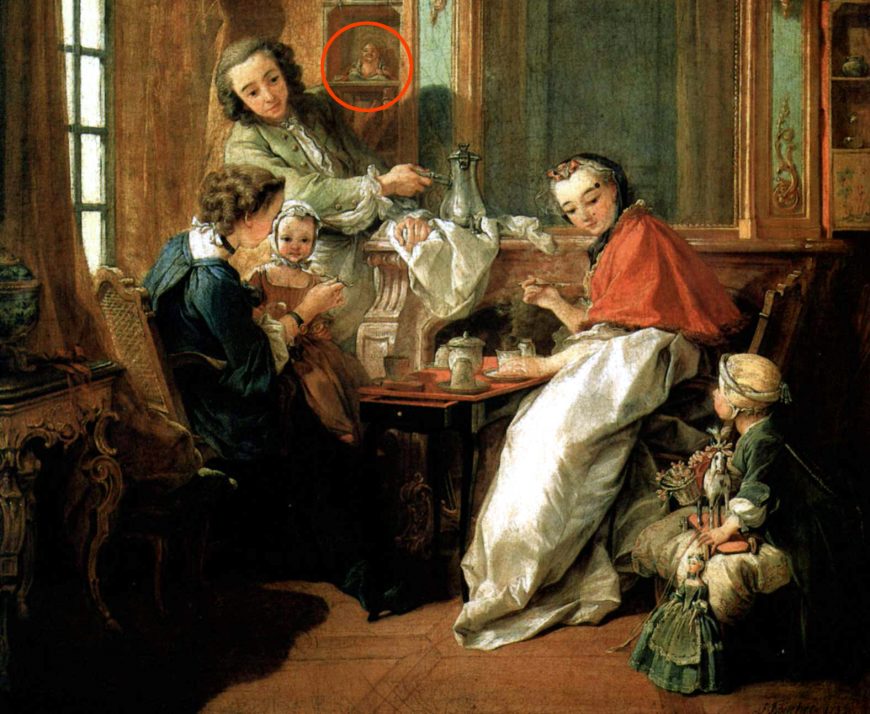
In search for a direct route to Asia that bypassed Ottoman control, Christopher Columbus, a Genoese navigator backed by the Spanish crown, accidentally stumbled upon the so-called “New World,” though he believed he had found the Western route to Asia. Spanish navigators quickly realized they were not in fact in Asia and set about colonizing the Americas. Europeans soon made their way across the Pacific and the first Spanish settlement in Asia was established in San Miguel, present day Cebu (Philippines) in 1565. The Viceroyalty of New Spain eventually came to include much of North America including Mexico and Central America, as well as the Philippines.
Asia + the Americas (via Spain)
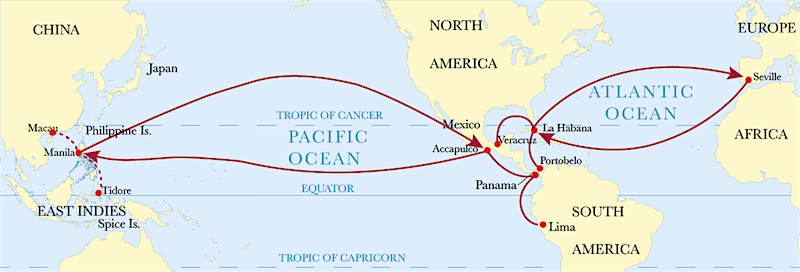
These two disparate Asian and American territories were joined by a fleet of Spanish ships called the Manila Galleon that left biannually from the cities of Manila in the Philippines and Acapulco in Mexico. From Acapulco, Asian luxury goods were transported over land to Veracruz where they were placed onboard ships bound for Spain, or made their way either by boat or mule to port cities like Lima, Havana, Cartagena, and Portobelo.
Elite Spaniards and Creoles decorated their homes and adorned their bodies with stunning examples of East Asian textiles and manufactured goods, as seen in a Mexican portrait of a Young Woman with a Harpsichord (left). The sitter holds an Asian (or Asian-inspired) fan and wears an elaborate silk dress—both the height of fashion at the time. Soon local artists were inspired to create their own versions of Asian goods, or to inject East Asian styles and motifs into their work. The influence of Asian art is particularly evident in viceregal textiles, ceramics, and furniture. Some examples are the resplendent biombos, or folding screens, made in Mexico beginning in the seventeenth century.
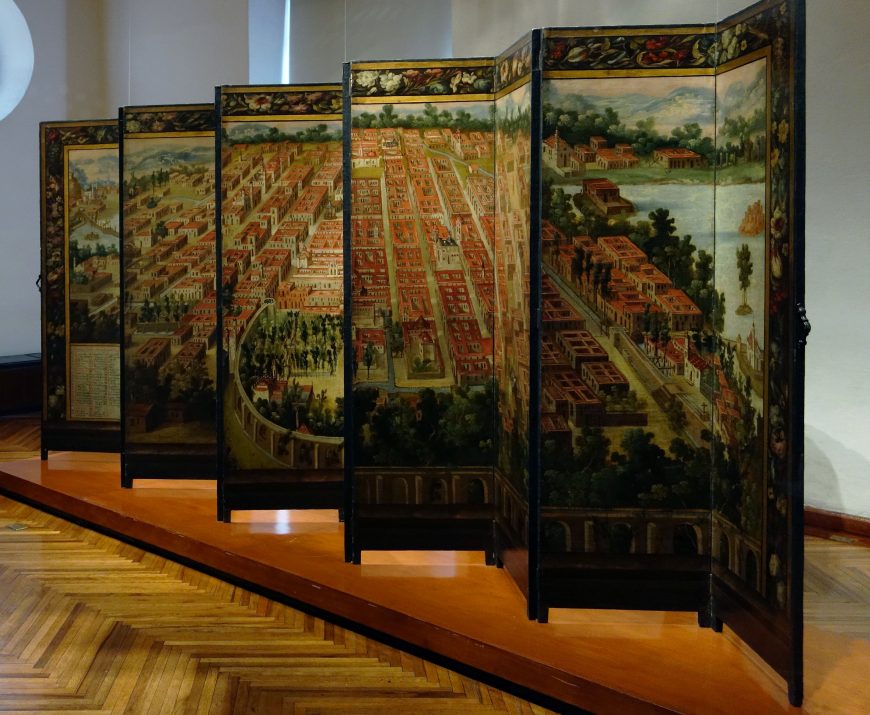
What is a Biombo?
The word biombo is a Hispanization of the Japanese byobu, which can be translated as “protection from wind.” The first byobu arrived in Mexico City as early as 1614 and quickly became highly sought after luxury items. These screens, originally imported from China to Japan in the eighth century and made of separate folding panels hinged together, were used within homes to divide or enclose interior spaces. Japanese screens typically featured landscapes with people or animals, but biombo made in Mexico featured secular subjects set within a city or landscape. Popular subjects included indigenous festivities, allegories of the four continents, and scenes from the conquest of Mexico.
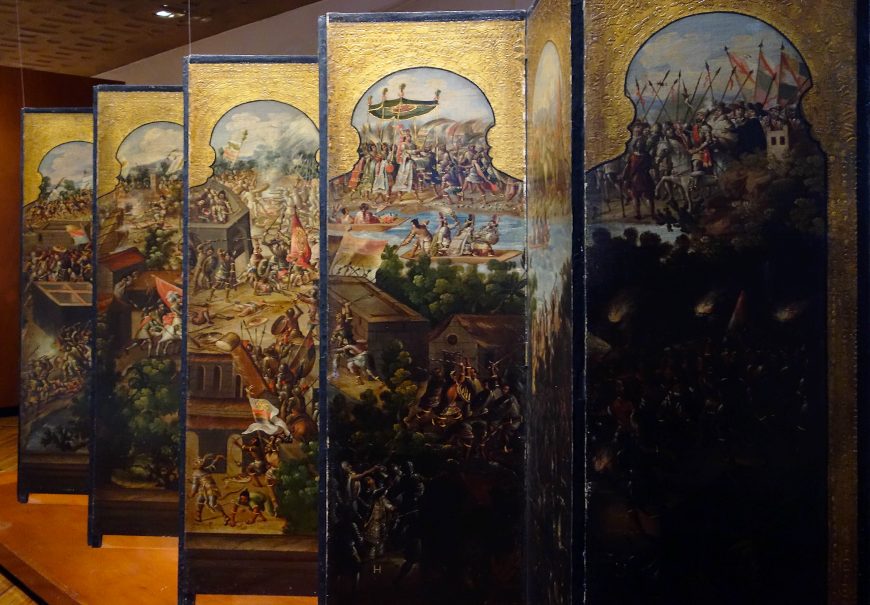
Biombo as Map
The Biombo with the Conquest of Mexico and View of Mexico City in the Museo Franz Mayer in Mexico City (above) is exemplary of the genre. Created in the second half of the seventeenth century, the screen features a panoramic birds-eye map of Mexico City on one side and scenes from the Conquest of Mexico on the other. While both sides of the biombo show the same geographic space (Tenochtitlan/Mexico City), the city is rendered very differently on each side.
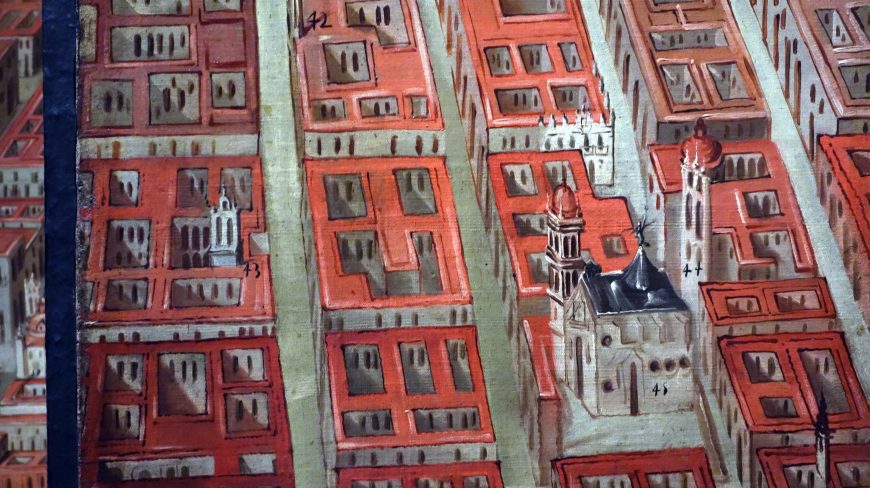
This birds-eye view of the city (above) gives a cartographic rendering of the city in three dimensions. Likely based on a seventeenth-century map of the city, this side of the biombo focuses on the physical aspects of Mexico City. The image is idealized—privileging the elite Spanish view of the city. Notably absent, for example, are the small indigenous dwellings that could be found on the outskirts of the city.
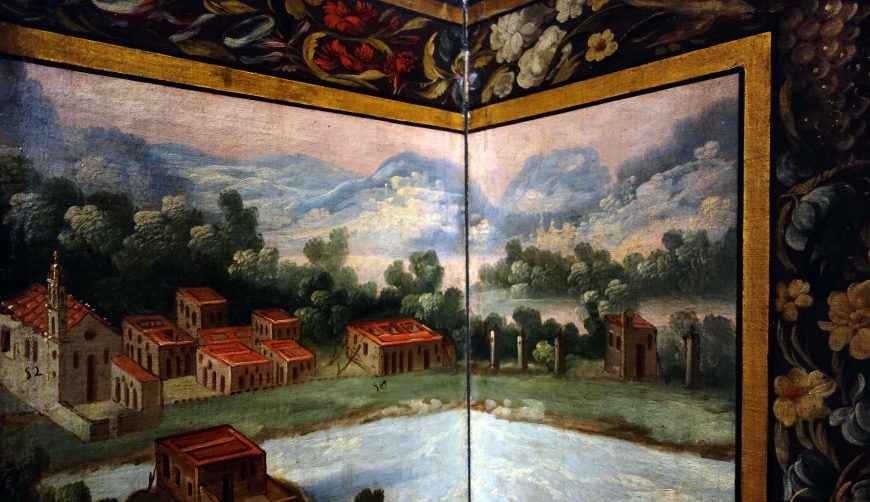
Devoid of people, the sweeping city on a lake appears picturesque, with mountains rising in the distance and causeways that radiate out from its carefully organized grid of plaza, streets, and canals. The grid was established by the Mexica (Aztecs) who founded the city. The Spanish troops who arrived in 1519 were amazed; conquistador Bernal Díaz del Castillo wrote: “Among us there were soldiers who had been in many parts of the world, in Constantinople and all of Italy and Rome. Never had they seen a square that compared so well, so orderly and wide, and so full of people, as that one.”1 He marveled also at the “straight, level causeway,” and “high towers, pyramids, and other buildings, all of masonry, which rose from the water.” For the Spaniards, they had arrived in a city of dreams—one that mirrored the Renaissance ideals of city planning that had yet to be realized in Spanish medieval cities.
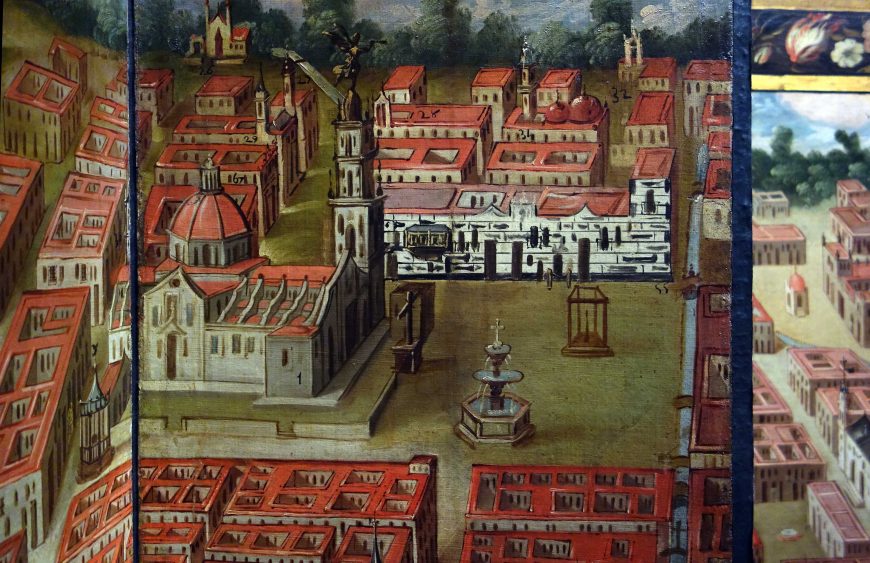
Following the Conquest, Tenochtitlan was renamed Mexico City, and was transformed to more closely resemble a European city. Painted in one point perspective (a convention of European painting), the biombo showcases seventeenth-century Mexico City as a sprawling metropolis of stucco buildings with red slate roofs. Particular attention is paid to its most prominent structures: churches, schools, hospitals, monasteries, and convents. The perspectival focus is on the traza, the center of the city that was reserved for the Spanish elites, but the indigenous city of Tlatelolco, the “sister” city of Tenochtitlan, is rendered on the left hand side of the island (above).
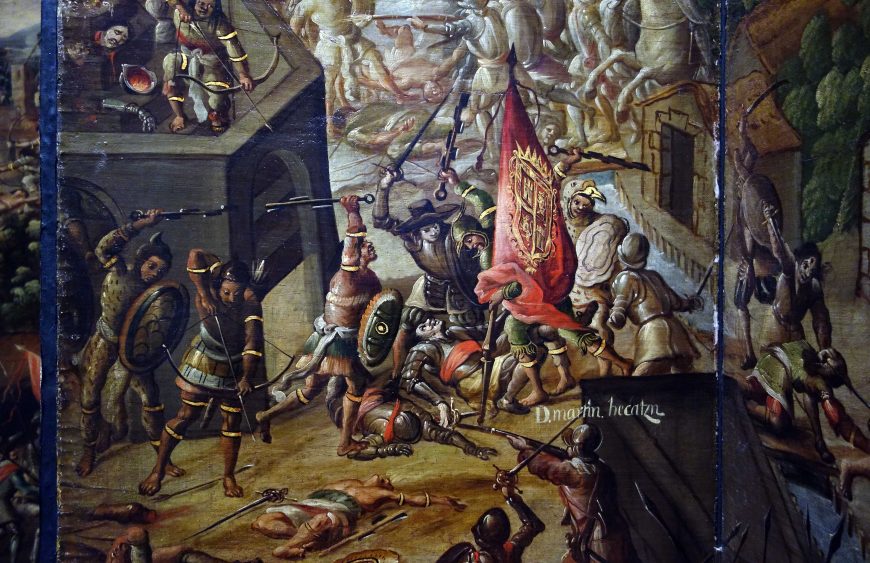
Biombo as Narrative
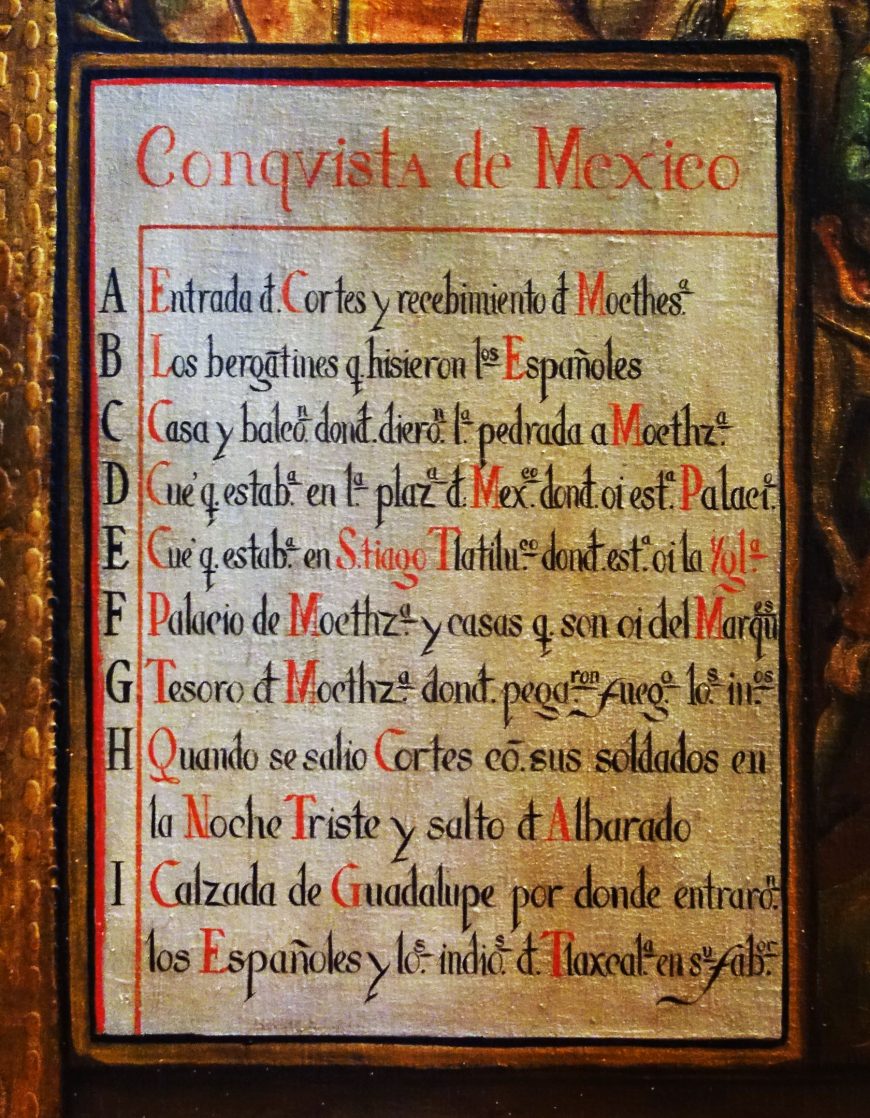
In contrast, the opposite side of the biombo is full of figures—both native and Spanish. It too depicts the Mexican capital, but rather than an idealized map, the reverse of the biombo teems with action, depicting the epic clash between Hernan Cortés’ troops, their indigenous allies (the Tlaxcalteca) and the Mexica warriors (above). Specific events of the Conquest are placed in the locations where they took place rather than in chronological order. Letters next to the scene and a cartouche at the bottom right corner (left) serve as narrative devices for decoding the different battles and events of the Conquest.
Perhaps the most prominent portion of the biombo lies in the scene depicting the assassination of the Mexica emperor Moctezuma II (below) at the bottom right corner. Spanish accounts, such as the wildly popular History of the Conquest of Mexico by the Spaniards by Antonio Solís, blame the Mexica for killing their leader in an act of vengeance for his perceived errors in handling the Spanish incursion. Contemporary indigenous accounts, however, such as in Bernardino de Sahagún’s Florentine Codex, record that Moctezuma was killed by the Spanish before they fled the city. Clearly this biombo privileges the Spanish (or Creole) view of the Conquest—showing the Mexica leader being executed by one of his own people, thus exculpating the Spaniards in this key moment of the violent conquest.
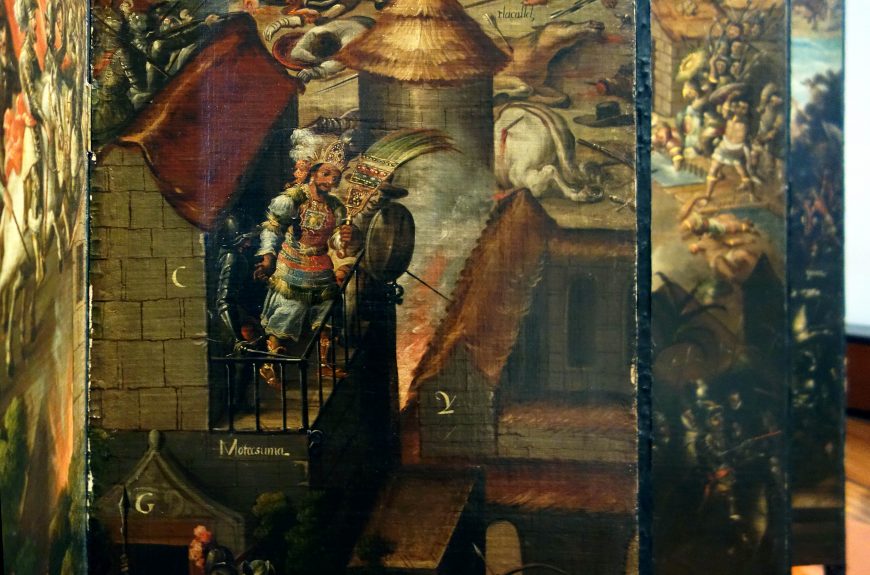
Biombo in Context
Imagine this folding screen in a large and sumptuously decorated home in Mexico City. Its recalling of Asian art forms was a reflection of the sophisticated tastes of its cosmopolitan owners. The Spanish or Creole elites would have used the biombo as a conversation piece, or perhaps invented games and riddles that related one episode of the Conquest to a particular part of the city. The biombo could serve as a mnemonic device for recalling collective and oral histories of the city.2 While the Conquest view illustrated the discord of the pre-Hispanic period, the map view celebrated order under Spanish rule. Though never visible at the same time, the two scenes are interrelated, and the act of going back and forth between the physical city and its historic Conquest was one that fascinated both the eye and the mind. Through the act of looking, its owners could superimpose themselves within both the physical and historical city, becoming a part of the transition of the Mexica capital of Tenochtitlan to the Spanish capital of Mexico City.
Notes:
1 Bernal Diaz del Castillo, The History of the Conquest of New Spain, ed. John Cohen (New York: Penguin Books Limited, 1963), p. 235.
2 Barbara E. Mundy, “Moteuczoma Reborn: Biombo Paintings and Collective Memory in Colonial Mexico City,” Winterthur Portfolio, vol. 45, no. 2/3 (Summer/Autumn 2011), p. 164.
Additional resources:
“The Circulation of Japanese and Mexican Art in the Early Modern World,” Sofia Sanabrais (video)
The Manila Galleon Trade on The Metropolitan Museum of Art’s Heilbrunn Timeline of Art History
Vistas: Visual Culture in Spanish America (Fordham University)
Barbara E. Mundy, “Moteuczoma Reborn: Biombo Paintings and Collective Memory in Colonial Mexico City,” Winterthur Portfolio, vol. 45, no. 2/3 (Summer/Autumn 2011), pp. 161-176.
Sofia Sanabrais, “From Byobu to Biombo: The Transformation of Japanese Folding Screen in Colonial Mexico,”Art History 38, 4 (September 2015), pp. 778-791.
SmartHistory images for teaching and learning:






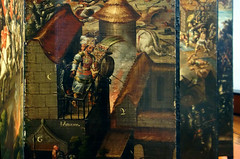




Jerónimo de Balbás, Altar of the Kings (Altar de los Reyes)
Video \(\PageIndex{21}\): Jerónimo de Balbás, Altar of the Kings (Altar de los Reyes), 1718-37, Metropolitan Cathedral of the Assumption of the Most Blessed Virgin Mary (Mexico City)
SmartHistory images for teaching and learning:

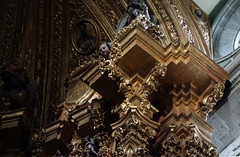
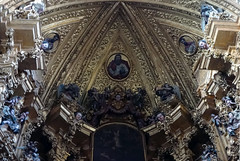
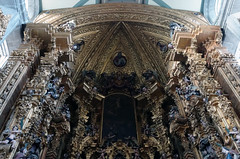




Christ Crucified, a Hispano-Philippine ivory
This ivory sculpture of Jesus traveled between three continents, demonstrating the global flow of materials, objects, and Christianity in the sixteenth and seventeenth centuries.
Video \(\PageIndex{22}\): Christ Crucified, 17th century, ivory (Museo Franz Mayer, Mexico City), speakers: Dr. Lauren G. Kilroy-Ewbank and Dr. Steven Zucker
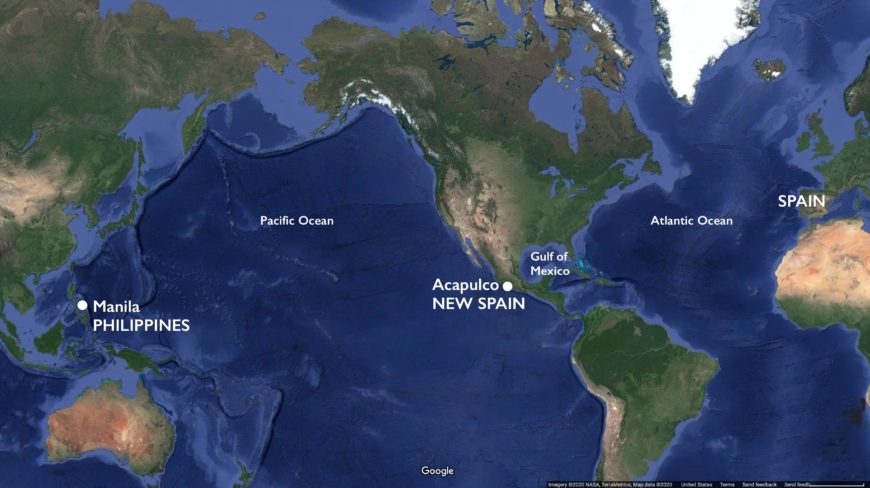
Introduction
Both the Philippines and Mexico formed part of what was once called the Viceroyalty of New Spain, which was controlled by the Spanish Crown. Beginning in the sixteenth century, Spanish galleons (large, multi-decked ships) began to sail between Manila (in the Philippines) and Acapulco (in Mexico). This trans-Pacific Manila Galleon trade created an important route for the global exchange of materials (such as silk, spices, porcelain, and ivory from Asia and silver and gold from the Americas). Many of the resources and goods coming from Asia would also travel overland from Acapulco to the Gulf Coast of Mexico, at which point they would be shipped across the Atlantic Ocean to Spain.
These objects are often labeled “Hispano-Philippine ivory sculptures” to denote their creation in the Philippines (or possibly even China) but made for a Spanish clientele (whether in the Spanish Americas or the Iberian Peninsula). The artists may also have been originally from China.
Artists carved a number of small-scale devotional objects, like Christ Crucified from ivory— a luxurious material in the sixteenth and seventeenth century. While some of these ivory sculptures were ultimately destined for Spain, many remained in the Americas. An object like Christ Crucified also demonstrates the global reach of Catholicism in the sixteenth and seventeenth centuries.
Terms
- New Spain
- Manila Galleon
- ivory
Test yourself with a quiz!
START
Additional resources:
Learn more about New Spain
Learn about a New Spanish folding screen that also speaks to the Manila Galleon trade
Read about the Manila Galleon trade on The Met’s Heilbrunn Timeline
Marjorie Trusted, “Survivors of a Shipwreck: Ivories from a Manila Galleon of 1601,” Hispanic Research Journal, 14:5 (2013): 446-462
M. Estella Marcos, Ivories from the Far Eastern Provinces of Spain and Portugal, ed. by L. Sada de González (Monterrey: Espejo de Obsidiana Ediciones, 1997)
For the classroom
Print out and use the Christ Crucified active note-taking activity (for teachers and students)
Mapping activity
Print out a blank world map (like these ones), and have several different colored pens or pencils available. Choose 3-4 objects to track across the globe. Some examples of objects that can be used for this activity include:
-
- Christ Crucified
- The Florentine Codex
- Sapi Lidded Saltcellar
- Chinese export porcelain
Mark each object’s point of original production, and then add points to the map where they moved. Use a different color for each object.
- What do you notice about these objects’ movement in space and time? Do these objects intersect at any points? What does tracing their movements in space tell us about the sixteenth and seventeenth centuries?
Discussion questions
- Compare the sculpture with other depictions of Christ Crucified from the renaissance, such as Matthias Grünewald’s Isenheim Altarpiece or Juan Martínez Montañés and Francisco Pacheco’s Christ of Clemency. What does this comparison tell us about how peoples in different parts of the world pictured the Crucifixion?
- Compare Christ Crucified to other examples of objects made for private devotion, such as Rogier van der Weyden’s Crucifixion Triptych (c. 1445). What do they have in common?
- What does Christ Crucified tell us about global trade in the 17th century? Consider other New Spanish objects, such as featherworks, folding screens, and paintings on copper that might also speak to issues of trade, cross-cultural exchange, and the cosmopolitan nature of New Spain.
- The video mentions that Crucified Christ speaks to the new global reach of Catholicism in the sixteenth and seventeenth centuries. How do other objects and spaces speak to this as well? You might consider spaces like the mission church of San Esteban del Rey at Acoma Pueblo in New Mexico or paintings like Bernardo Bitti’s Coronation of the Virgin in Peru.
- How does our understanding of art and artists of a specific time period shift when we focus on objects that moved across vast distances over time? How do we categorize objects that migrate?
Research topics
- Consider the history of ivory sculpture over time and in different cultures. How does Crucified Christ fit into a longer history of ivory sculpture that we see in objects such as the Minoan Statuette of a Male Figure (The Palaikastro Kouros, 1425 B.C.E.), the Byzantine The Emperor Triumphant (Barberini Ivory) from the 6th century, the Pyxis of al-Mughira from AH 357/ 968 C.E., and the Queen Mother Pendant Mask (Iyoba), 16th century, Edo peoples, Court of Benin?
Miguel Cabrera, Virgin of the Apocalypse
The Michelangelo of Mexico
Miguel Cabrera was one of the most celebrated and prolific artists of viceregal Mexico in the eighteenth century—painting everything from casta paintings and portraits to large-scale religious altarpieces and small devotional paintings. During his lifetime, he achieved great renown, and even attempted to create an official Academy of Painting in Mexico City modeled after the Royal Academy of Fine Arts of San Fernando in Madrid.
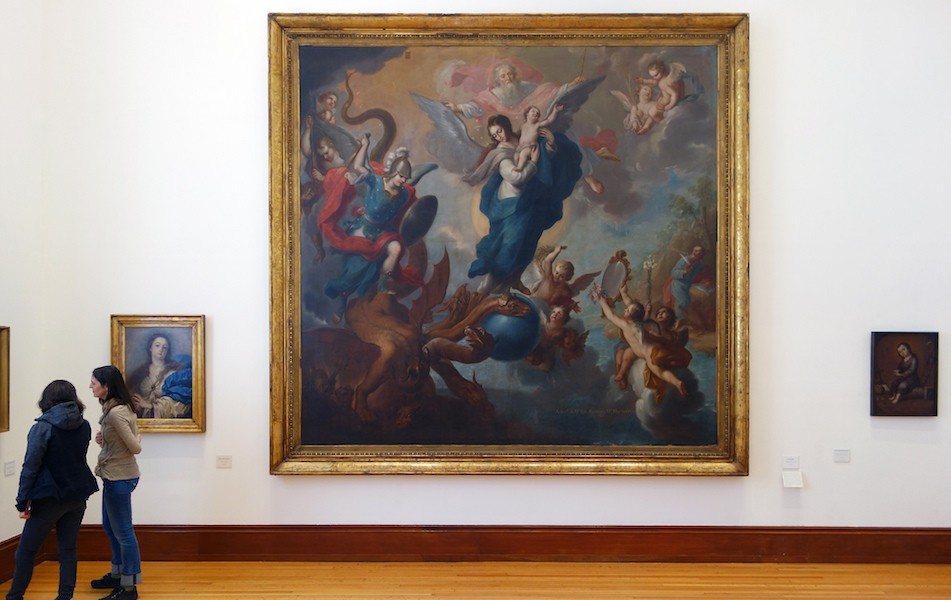
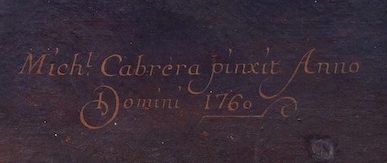
On his 1760 painting, The Virgin of the Apocalypse (above), Cabrera notably signed his name as “Michelangelo” (left) to draw comparisons between himself and the great Italian Renaissance master and to promote the idea that he was the Michelangelo of Mexico.
Even beyond the signature—which links the art of New Spain to the European tradition—this painting reveals other artistic and religious exchanges between the Spanish viceroyalty (in what was known as the “new world”) and parts of Europe.
Iconography
The iconography of Cabrera’s The Virgin of the Apocalypse derives from chapter 12 of the Book of Revelation—a book of the New Testament that prophesies and describes the end of the world and the second coming of Christ. This comes as no surprise since subjects related to the apocalypse (the end of the world) and the Virgin Mary were increasingly important from the late seventeenth century onwards in New Spain. In chapter 12, John of Patmos, the author, describes a woman “clothed with the sun” and pursued by a dragon who wants to devour her child.
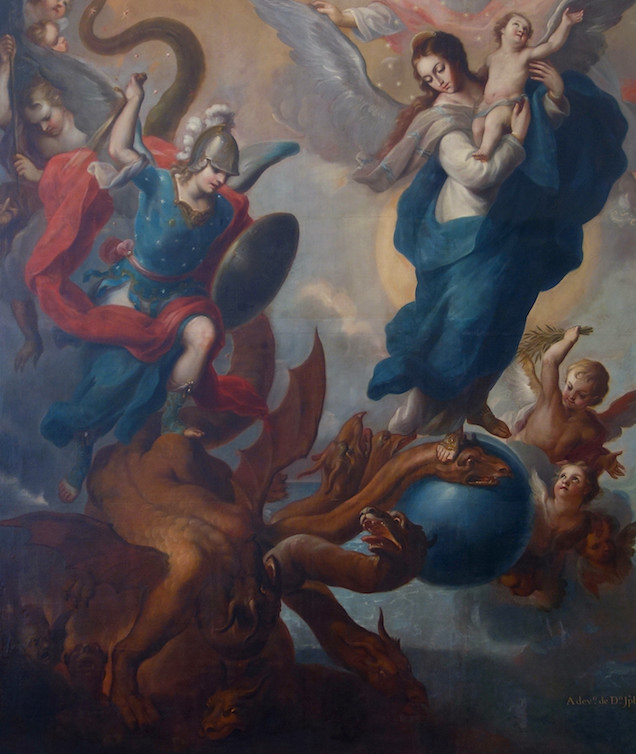
The Book of Revelation, chapter 12, verses 1-5 read:
1 A great sign appeared in the sky, a woman clothed with the sun, with the moon under her feet, and on her head a crown of twelve stars.
2 She was with child and wailed aloud in pain as she labored to give birth.
3 Then another sign appeared in the sky; it was a huge red dragon, with seven heads and ten horns, and on its heads were seven diadems.
4 Its tail swept away a third of the stars in the sky and hurled them down to the earth. Then the dragon stood before the woman about to give birth, to devour her child when she gave birth.
5 She gave birth to a son, a male child, destined to rule all the nations with an iron rod. Her child was caught up to God and his throne.
The rest of the chapter describes how “war broke out in heaven” and how the archangel Michael and his angels fought the dragon who fled with the wings of an eagle.
The woman of the apocalypse is a long-standing subject in Catholic art and theology—understood by early Church thinkers to be a personification of the Church and by medieval interpreters as the Virgin Mary (based on the text describing a woman who gave birth to a “male child who is to rule the nations with a rod of iron”). The male child was often interpreted as Jesus. Broadly speaking, the woman was understood to represent Christianity itself. However, it is worth noting that the symbolism in the Book of Revelation often carries multiple meanings.*
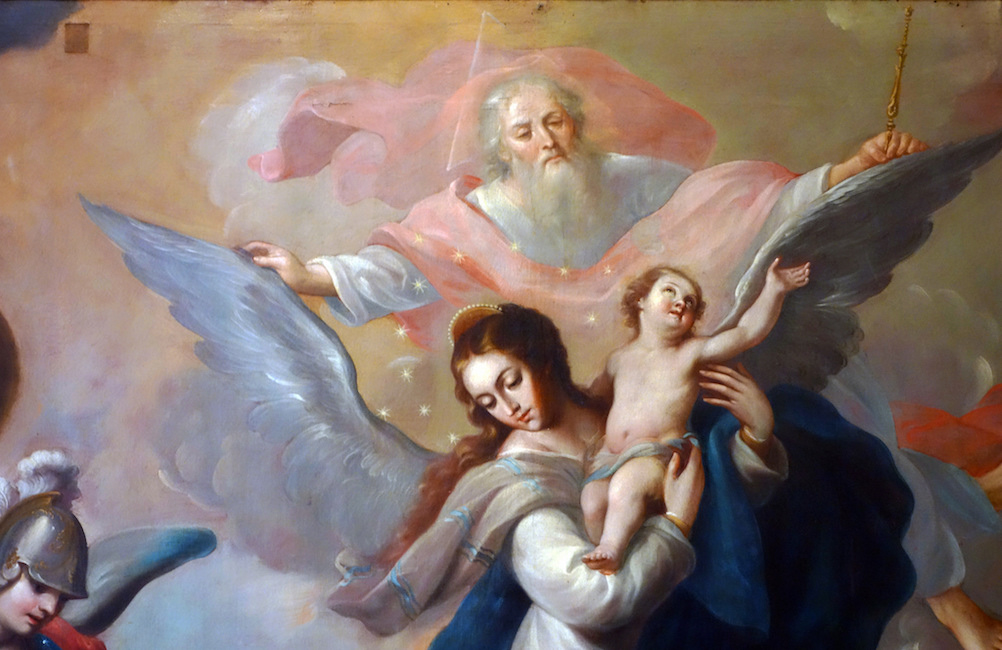
The representation of the Woman of the Apocalypse in Baroque art included recognizable Marian iconography deriving from the Litany of Loreto (also known as the Litany of the Blessed Virgin Mary), approved by Pope Sixtus V in 1587 (a litany is a call and response form of prayer).
The Woman of the Apocalypse is often dressed in the Virgin Mary’s colors—either blue and red or white and blue as seen here. The white and blue color scheme corresponds to the iconography of the Immaculate Conception (the doctrine that Mary was conceived without original sin in her mother’s womb)—a popular subject in Spanish Baroque art (examples here). In his treatise entitled El arte de la pintura (The Art of Painting, 1649), the Spanish painter and theorist Francisco Pacheco offered guidelines as to how the Immaculate Conception should be represented, proposing that painters depict Mary wearing a white tunic with a blue mantle and stars around her head—all motifs derived from the Book of Revelation.
A great sign appeard in the sky
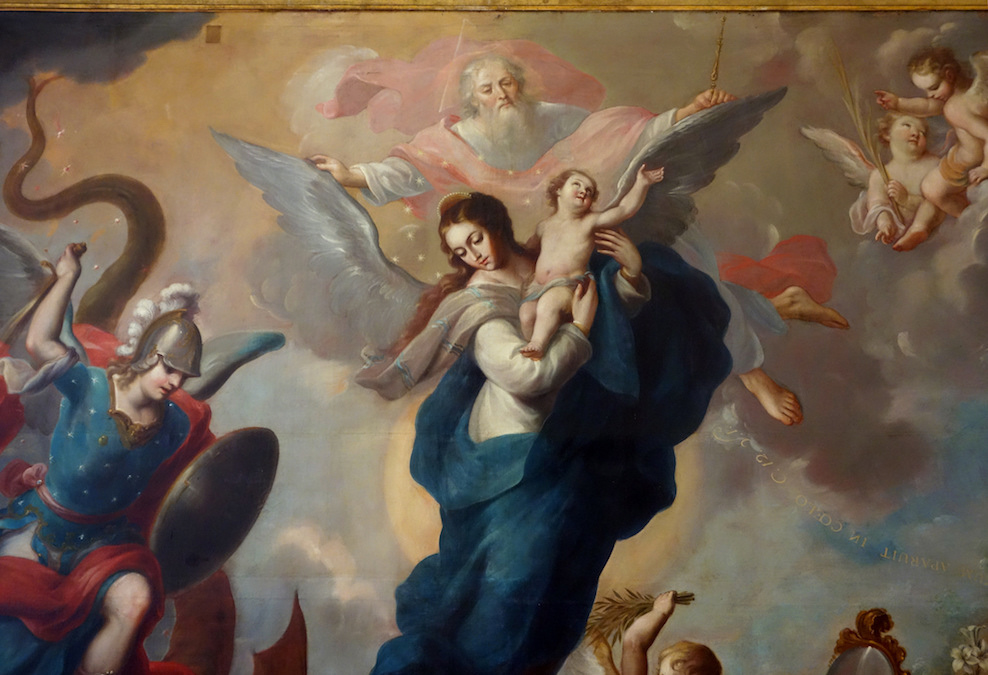
In Cabrera’s painting we see a literal representation of the heavenly battle described in the Book of Revelation. At the center of the composition a woman stands in front of the sun, dressed in a white tunic and a blue cloak (the white shawl with blue stripes draped over her shoulder resembles a tallit (a Jewish prayer shawl). She stands over a blue orb and steps on one of the dragon’s seven heads. Like the woman in Revelation, she has two wings and twelve stars around her head. She holds aloft a young boy who is reaching up to God the Father. God, clothed in red and white, is identifiable by the traditional long white beard and triangular halo that symbolizes the Holy Trinity. God is painted somewhat fainter than the woman to indicate that he is behind her. His arms are outstretched over her wings, implying divine assistance as she triumphs over the dragon.
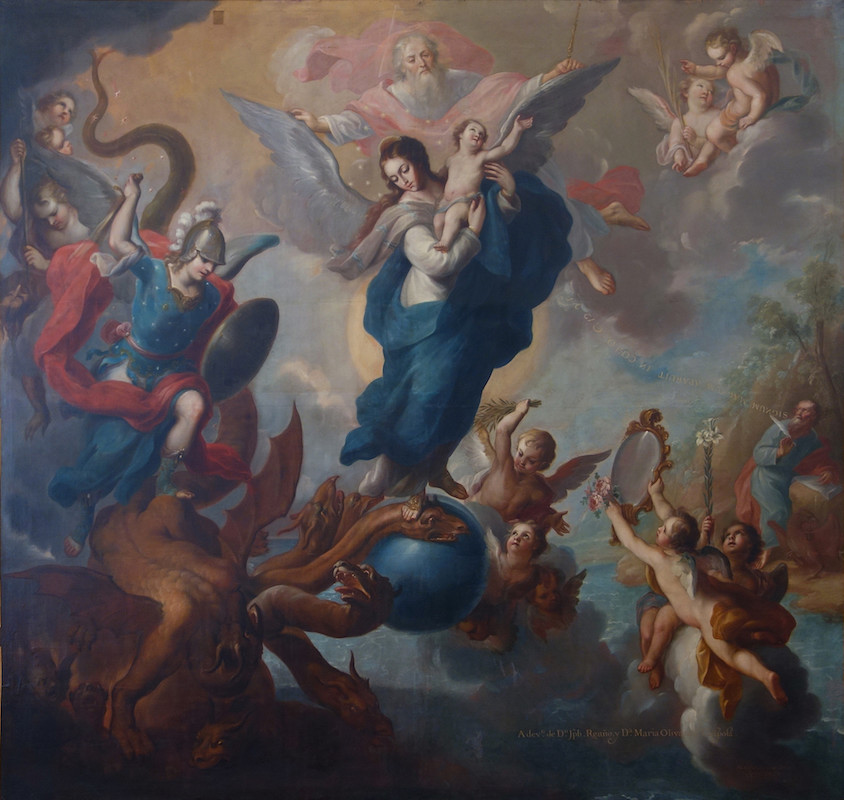
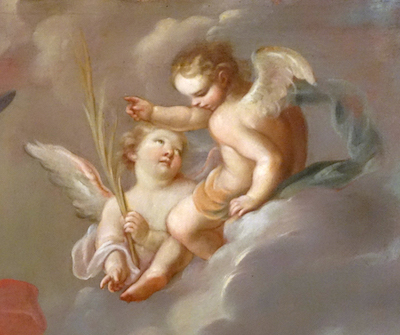
The heavenly battle unfolds to the viewer’s left; St. Michael and his army of angels come down from heaven. Like the woman, Michael has one foot on the dragon, as he casts the monster down into a fiery, demon-filled hell on the lower left. In the top right clouds (image left), one angel bears a palm frond (a traditional symbol of victory) as the other looks down while also pointing to God.
The angels at the lower right hold a mirror and small bouquet of roses referencing symbols in the Litany of Loreto. The mirror stands for the Virgin Mary’s title of speculum justitiaé (mirror of justice); the roses are for her title of Rosa mystica (mystical rose). Another angel holds a lilies (a symbol of purity); the rose and the lily are flowers often included in depictions of the Virgin Mary. Both are mentioned in a passage from the Song of Songs (part of the Hebrew Bible) often associated with the Virgin, that reads “I am the Rose of Sharon, the lily of the valleys” (2:1). Off in the distance on the right side is John, the writer of the Book of Revelation. He sits outdoors recording his vision; he looks to the sky and the words from his prophecy, signum magnum apparuit in caelo c. 12 (and a great sign appeared in the sky, Ch. 12) come forth from his mouth written upside down—perhaps an indication that their real author was in heaven.
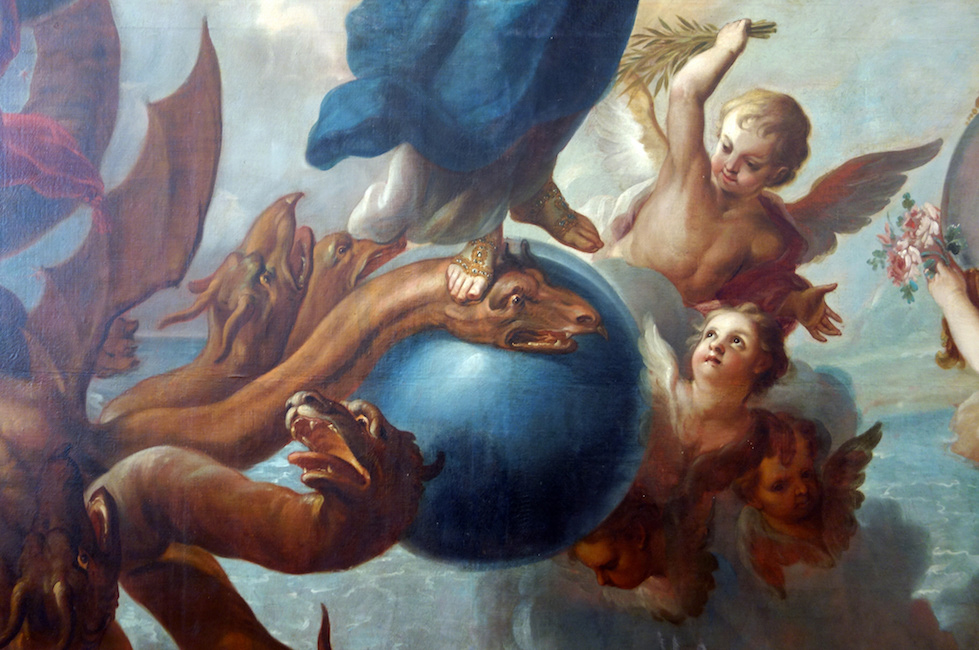
The woman crushing the head of the serpent in Cabrera’s painting symbolizes the defeat of heresy. But another interpretation is possible. Many Mesoamerican cultures venerated a feathered serpent deity (Quetzalcoatl for the Aztecs), and in the wake of Spanish colonization—beginning after the defeat of the Aztecs in 1521—there were many attempts to eradicate the traditional beliefs of the indigenous people as they were being converted to Christianity. The image of the woman of the apocalypse crushing the serpent could be therefore also interpreted as Christianity defeating indigenous Mesoamerican religious beliefs.
Artistic Exchange
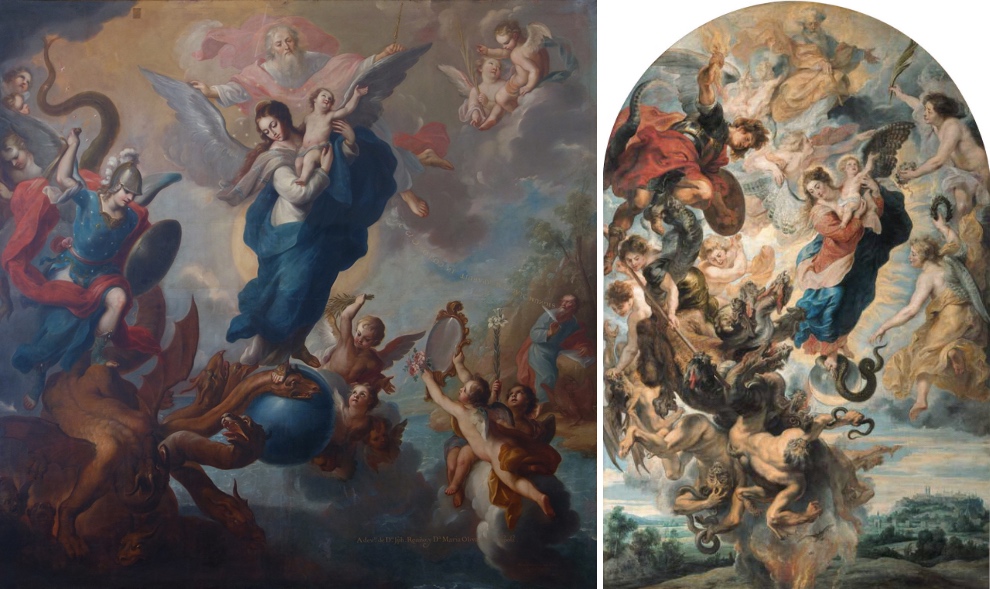
The format and iconography of Cabrera’s Woman of the Apocalypse is borrowed from the Flemish painter Peter Paul Rubens’ work of the same subject (above, right). Rubens lived in Antwerp (then part of the Spanish Netherlands). Skilled in both art and diplomacy, he was employed by the Spanish crown in both capacities. King Philip IV of Spain was one of Rubens’ patrons and thus his work was highly regarded and widely reproduced through prints. These prints made their way to the Spanish Americas where they influenced local artists. One artist, Cristóbal de Villalpando created a large version of the Woman of the Apocalypse between 1684–88 for the sacristy of the Metropolitan Cathedral of Mexico City. Other Mexican painters, including José de Ibarra (Pinacoteca Profesa, Mexico) and Miguel Vallejo (Museo Regional de Querétaro), also painted their own versions of the Woman of the Apocalypse prior to Cabrera, demonstrating the subject’s popularity in the Spanish viceroyalty.
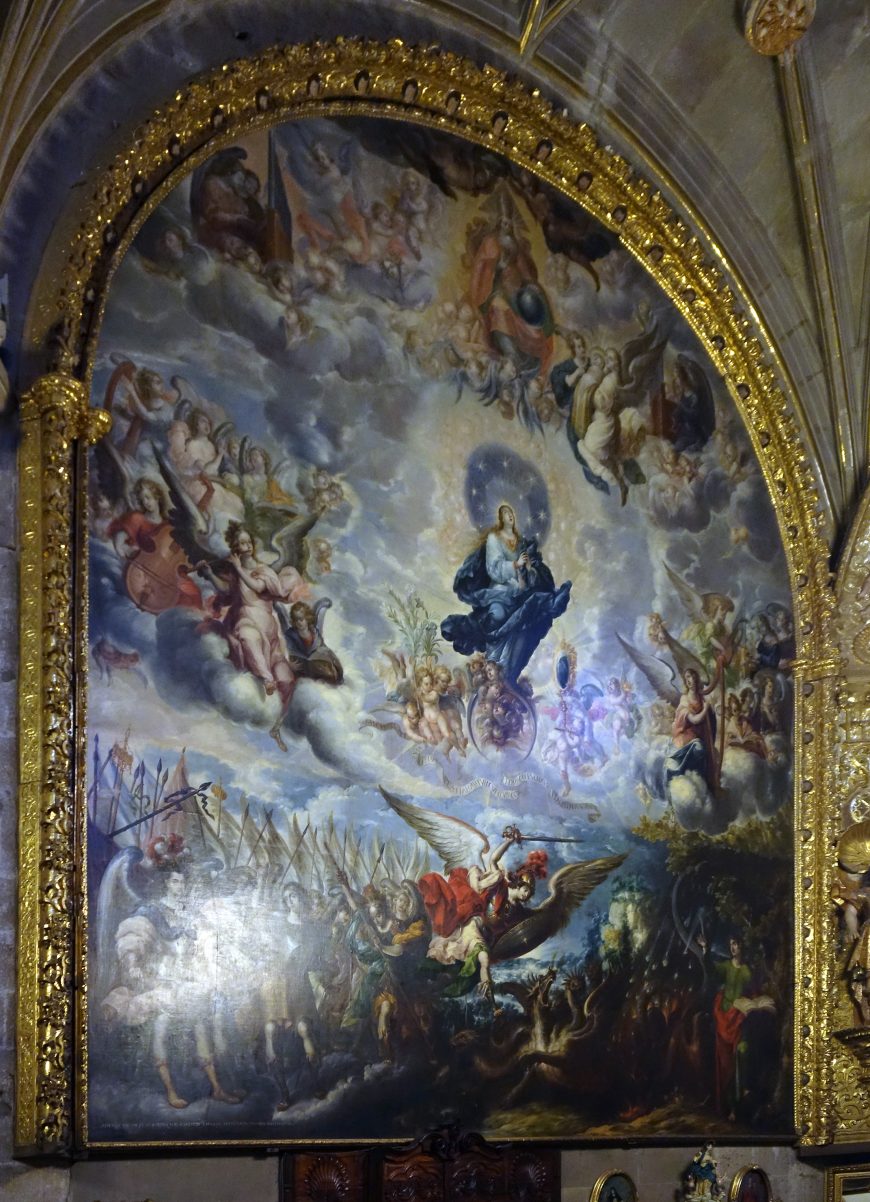
Cabrera’s style has been likened to the work of Spanish artist Bartolomé Esteban Murillo as well as Rubens, though his style is softer and more delicate. Rubens’s painting of this subject is more energetic and has a vertical emphasis (where the Cabrera is more square in format). In the Rubens, the viewer clearly sees a landscape and a tumultuous battle in the sky that curves around the central figure of the Woman/Virgin Mary. Most of the iconography and its placement remains the same in Cabrera’s work, though Mary does not wear red—instead Cabrera follows Pacheco’s suggestion of white and blue clothing.
The Virgin of Guadalupe and the Woman of the Apocalypse

Cabrera and his workshop produced many secular and religious artworks. For instance, he made numerous versions of Our Lady of Guadalupe—a miraculous image of the Virgin Mary who appeared to an indigenous man (Juan Diego) in Mexico in 1531. Significantly, the Woman of the Apocalypse, the Virgin of the Immaculate Conception, and Our Lady of Guadalupe all share similar iconographic details such as stars, the moon under her feet, being “clothed with the sun,” and crushing a serpent. Our Lady of Guadalupe was often interpreted as the Woman of the Apocalypse by contemporary Mexican writers including Miguel Sánchez and Jerónimo de Valladolid. This was an important identification because it associated Juan Diego with John of Patmos, the author of the Book of Revelation.
Our Lady of Guadalupe is further linked to the Immaculate Conception by the proximity of their Holy Days: Guadalupe is celebrated on December 12 and the Solemnity of the Immaculate Conception on December 8, though it was celebrated on December 9 in Mexico—the day the Virgin first appeared to Juan Diego. Miguel Cabrera even wrote a short treatise entitled Maravilla americana (American Marvel, 1756) on the miraculous nature of the image of Our Lady of Guadalupe from an artist’s point of view.
The prominence of the apocalyptic iconography of the Woman of Apocalypse is thus linked to other important Marian apparitions and advocations in colonial Mexico at a moment in time when many elite creoles (pure-blooded Spaniards born in the Americas) were championing their local identities and the greatness of New Spain. Miguel Cabrera’s painting was commissioned by the elite creole patrons, Don José Reaño and his wife Doña Maria Olivares, indicated by an inscription at the bottom of the painting, A la Devoción de Don José Reaño y Doña María Olivares, su esposa [To the devotion of Don José Reaño and Doña Maria Olivares, his wife].

Unlike Rubens’ painting, which was meant as a cathedral altarpiece, this painting was displayed at the Royal and Pontifical University of Mexico. The University (the first in the Americas) was founded in 1551 by Friar Juan de Zumárraga, first bishop of Mexico, and Viceroy Antonio de Mendoza. The university was established “to serve God and the public welfare.” In 1557 a decree was issued that limited the number of students of “mixed blood” (those with Spanish and indigenous parentage) to six and in the 17th century, essentially only those of Spanish descent were admitted.[1] The painting was later moved to the San Carlos Academy of Fine Arts, then to the San Diego Viceregal Painting Gallery and finally the Museo Nacional de Arte (MUNAL), where it is housed today.
*Much of the symbolism in Revelation is drawn from the Old Testament, specifically from the book of Genesis. The twelve stars, the sun and moon refer to Jacob and the twelve patriarchs (twelve tribes of Israel). The twelve apostles of Christ parallel the tribes and the Christian community is considered the New Israel.
[1] Philip Russell, The Essential History of Mexico: From Pre-Conquest to Present (Routledge, 2015), p. 88.
Additional resources:
Art of the Spanish Americas on the Metropolitan Museum of Art’s Heilbrunn Timeline of Art History
Michael J. Schreffler, The art of allegiance: visual culture and imperial power in Baroque New Spain (Pennsylvania State University Press, 2007)
Kelly Donahue-Walace, Art and Architecture of Viceregal Latin America, 1521-1821 (University of New Mexico Press, 2008)
Lois Parkinson Zamora and Monika Kaup, eds., Baroque New Worlds: Representation, Transculturation, Counterconquest (Duke University Press, 2009)
SmartHistory images for teaching and learning:
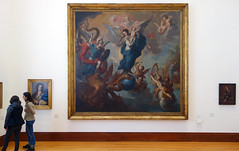
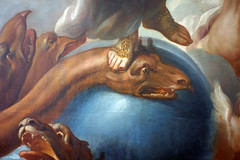
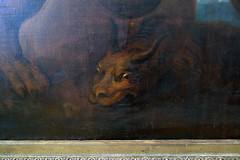
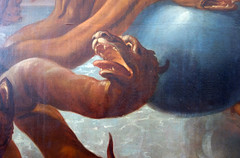
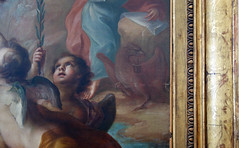

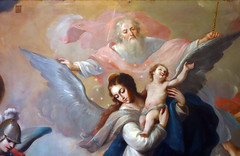
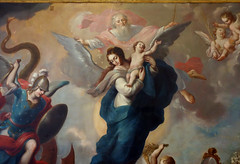

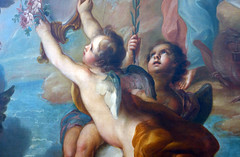



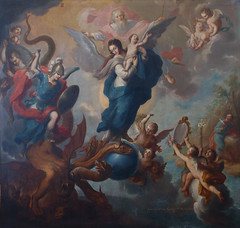
Miguel Cabrera, Portrait of Sor Juana Inés de la Cruz
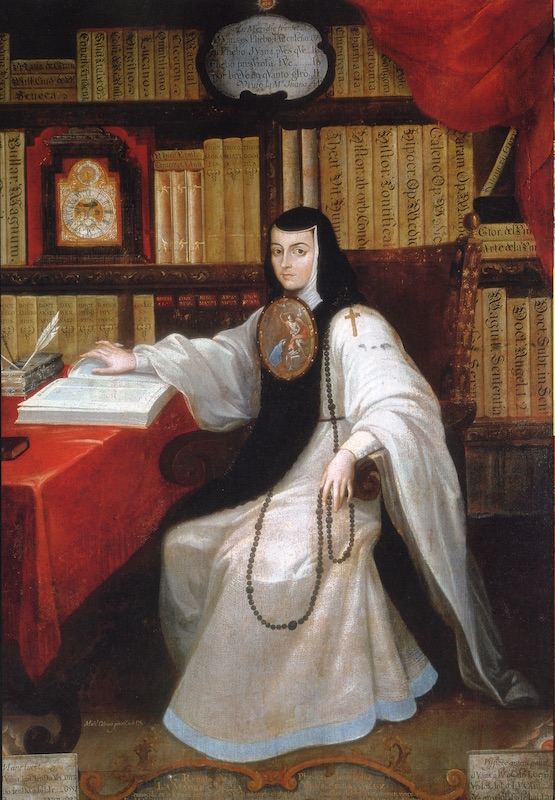
Miguel Cabrera’s posthumous portrait of sor Juana Inés de la Cruz (1648-1695) is a famous depiction of the esteemed Mexican nun and writer. Considered the first feminist of the Americas, sor Juana lived as a nun of the Jeronymite order (named for St. Jerome) in seventeenth-century Mexico. Rather than marry, she chose to become a nun so she could pursue her intellectual interests. She corresponded with scientists, theologians, and other literary intellectuals in Mexico and abroad. She wrote poetry and plays that became internationally famous, and even engaged in theological debates.
Her life
Born to a creole family in 1648, sor Juana was a child prodigy. At the age of fifteen, she amazed people at court by excelling at an oral exam that tested her knowledge of physics, philosophy, theology, and mathematics.
She came to live as a lady in waiting in the house of the viceroy (the substitute or representative for the Spanish king in Mexico). Shortly afterwards, she chose to become a nun instead of marry. She entered the Carmelite convent in 1667, but left a year later to join the Jeronymite order in 1669—and in the process gained intellectual freedom. The Jeronymite order allowed her to host intellectual gatherings and live a comfortable life.
In 1690 she became involved in an ecclesiastical dispute between the bishops of Mexico City and Puebla. She responded to the criticism she received as a woman writer, which culminated in one of her most famous works: The Answer (1691). This work defended her right as a woman to write and to be a scholar. At one she claimed that:
I do not study in order to write, nor far less in order to teach (which would be boundless arrogance in me), but simply to see whether by studying I may become less ignorant. This is my answer, and these are my feelings. . . .
Despite her eloquent defense, the Church forced her to relinquish her literary pursuits and even her library. When she sold her library and musical and scientific instruments, she wrote a document that renounced her learning, which ended with “I, Sor Juana Inés de la Cruz, the worst in the world,” signed in her own blood. After giving up her intellectual pursuits, she cared for the infirm during an epidemic but she fell sick and passed away.
An intellectual
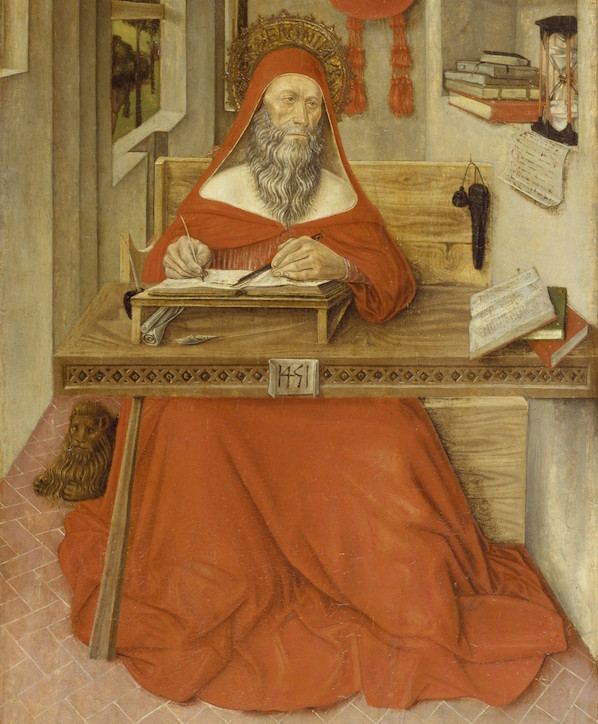
Miguel Cabrera positions sor Juana in such a way that the portrait insists on her status as an intellectual. He never actually met sor Juana, so he likely based his image of her on earlier portraits of her, possibly even some self-portraits. Cabrera likely modeled this painting on images of male scholars seated at their desks. Most importantly, he possibly found inspiration in depictions of St. Jerome, the patron saint of sor Juana’s religious order. Images often portray St. Jerome seated at a desk within a study, surrounded by books and instruments of learning.
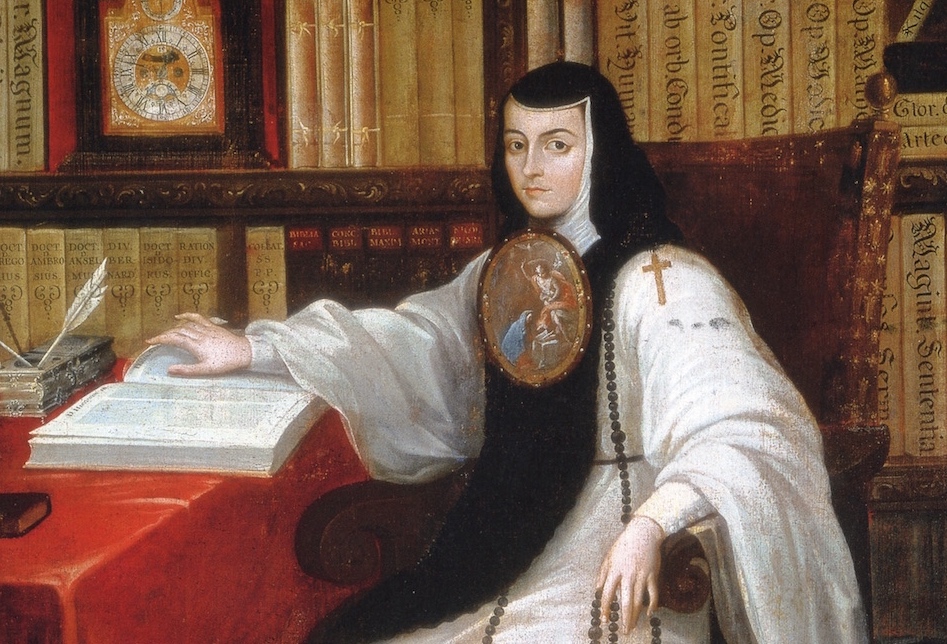
…and a nun
In many ways this is a typical nun portrait of eighteenth-century Mexico. Sor Juana wears the habit of her religious order, the Jeronymites. She also wears an escudo de monja, or nun’s badge, on her chest underneath her chin. Escudos de monja were often painted, occasionally woven, and they usually displayed the Virgin Mary. Sor Juana’s escudo shows the Annunciation, the moment in which the archangel Gabriel informs Mary that she will bear the son of God. Her left hand toys with a rosary, while she turns a page of an open book with her right hand. The book is a text by St. Jerome, the saint after whom her religious order was named.

Cabrera’s portrait differs from other nun portraits in several important ways. She looks towards us, her gaze direct and assertive, as she sits at a desk, surrounded by her library and instruments of learning. The library here includes books on philosophy, natural science, theology, mythology, and history, and so it reflects the types of works in sor Juana’s own library. Writing implements rest on the table, a clear allusion to sor Juana’s written works and intellectual pursuits.
The rosary—a sign of her religious life—is juxtaposed with items signifying her intellectual life. The books, the desk, the quills and inkwell aid in conveying her intellectual status. The red curtain, common in elite portraiture of this period, also confers upon her a high status.
Additional resources:
Another Latin American nun’s portraits at the Google Art Project
Another portrait of Sor Juana Inés de la Cruz at the Philadelphia Museum of Art
Electa Arenal and Amanda Powell, eds. The Answer/La respuesta. 2 ed. (New York: The Feminist Press at the City University of New York, 2009).
Charlene Villaseñor Black, “Portraits of Sor Juana Inés de la Cruz and the Dangers of Intellectual Desire,” in Sor Juana Inés de la Cruz: Selected Works, Norton Critical Edition, edited by Anna More (New York: W. W. Norton & Company, Inc., 2016).
Dartmouth’s Sor Juana Inés de la Cruz project
Marion Oettinger Jr., Retratos: 2,000 Years of Latin American Portraits (New Haven: San Antonio Museum of Art and Yale University Press, 2004).
Spaniard and Indian Produce a Mestizo, attributed to Juan Rodriguez Juárez
In America people are born in diverse colors, customs, temperaments and languages. From the Spaniard and the Indian is born the mestizo, usually humble, quiet and simple.¹
So states an inscription on José Joaquín Magón’s painting, The Mestizo, made in New Spain (Spanish colonial Mexico) during the second half of the eighteenth century. The painting displays a Spanish father and Indigenous mother with their son, and it belongs to a larger series of works that seek to document the inter-ethnic mixing occurring in New Spain among Europeans, indigenous peoples, Africans, and the existing mixed-race population. This genre of painting, known as pinturas de castas, or casta paintings, attempts to capture reality, yet they are largely fictions.

Typically, casta paintings display a mother, father, and a child (sometimes two). This family model is possibly modeled on depictions of the Holy Family showing the Virgin Mary, saint Joseph, and Christ as a child. Casta paintings are often labeled with a number and a textual inscription that documents the mixing that has occurred. The numbers and textual inscriptions on casta paintings create a racial taxonomy, akin to a scientific taxonomy. In this way, casta paintings speak to Enlightenment concerns, specifically the notion that people can be rationally categorized based on their ethnic makeup and appearance.

They are commonly produced in sets of sixteen, but occasionally we see sixteen vignettes on a single canvas. Costume, accouterments, activities, setting, and flora and fauna all aid in racially labeling the individuals within these works.
The first position of the casta series is always a Spanish man and an elite Indigenous woman, accompanied by their offspring: a mestizo, which denotes a person born of these two parents. As the casta series progresses and the mixing increases, some of the names used in casta paintings to label people demonstrate social anxiety over inter-ethnic mixing and can often be pejorative.
For instance, a Spaniard and a mestizo produce a castizo (“burned tree”), while a Spaniard and a morisco (a muslim who had been forced to convert to Christianity) produce an albino torna atrás (“Return-Backwards”) and a No te entiendo (“I-Don’t-Understand-You”) with a Cambuja (offspring of an Indian woman and African man) makes a tente en el aire (“Hold-Yourself-in-Mid-Air”). Indigenous peoples who chose to live outside “civilized” social norms and were not Christian were labeled mecos, or barbarians.

Casta paintings convey the perception that the more European you are, the closer to the top of the social and racial hierarchy you belong. Pure-blooded Spaniards always occupy the preeminent position in casta paintings and are often the best dressed and most “civilized.” Clearly, casta paintings convey the notion that one’s social status is tied to one’s perceived racial makeup.

Many famous artists, including Juan Rodríguez Juárez, Miguel Cabrera, and Juan Patricio Morlete Ruiz, produced casta paintings. Rodríguez Juárez created some of the earliest casta paintings, and Spaniard and Indian Produce a Mestizo (above), which displays the same subject as Joaquín Magón’s painting², is attributed to him.

The painting displays a simple composition, with a mother and father flanking two children, one of whom is a servant carrying the couple’s baby. The indigenous mother, dressed in a beautiful huipil (traditional woman’s garment worn by indigenous women from central Mexico to parts of Central America) with lace sleeves and wearing sumptuous jewelry, turns to look at her husband as she gestures towards her child. Her husband, who wears French-style European clothing including a powdered wig, gazes down at the children with his hand either resting on his wife’s arm or his child’s back. The young servant looks upwards to the father. The family appears calm and harmonious, even loving. This is not always the case, however. Often as the series progresses, discord can erupt among families or they are displayed in tattered, torn, and unglamorous surroundings. People also appear darker as they become more mixed. Casta paintings from the second half of the eighteenth century in particular focus more on families living in less ideal conditions as they become more racially mixed. Earlier series, like Rodríguez Juárez’s, often display all families wearing more fanciful attire.
But who commissioned these works and why? The existing evidence suggests that some of these casta series were commissioned by Viceroys, or the stand-in for the Spanish King in the Americas, who brought some casta series to Spain upon their return. Other series were commissioned for important administrators. However, little is known about the patrons of casta paintings in general. Yet, we can infer to a degree who might have commissioned such paintings. Because casta paintings reflect increasing social anxieties about inter-ethnic mixing, it is possible that elites who claimed to be of pure blood, and who likely found the dilution of pure-bloodedness alarming, were among those individuals who commissioned casta paintings.
1. “En la America nacen gentes diverzas en color, en costumbres, genios y lenguas. Del español y la yndia nace el mestizo, por lo común, humilde, quieto y sencyllo.”
2. De español y de india, produce mestiso [sic].
Additional resources:
Why an Albino? Some Notes On Our New Casta Painting by Miguel Cabrera (Getty Museum)
Ilona Katzew, Casta Painting: Images of Race in Eighteenth-Century Mexico (New Haven: Yale University Press, 2005).
Francisco Clapera, set of sixteen casta paintings
Video \(\PageIndex{23}\): Francisco Clapera, Set of Sixteen Casta paintings, c. 1775, 51.1 x 39.6 cm (Denver Art Museum). Speakers: Sabina Kull, Meyer Center Fellow, Denver Art Museum and Beth Harris.
Test your knowledge with a quiz
START
Key points
- New Spain was a viceroyalty of the Spanish empire. The presence of people of many different ethnic backgrounds and their relative social mobility in New Spain prompted Spanish anxiety about racial mixing and a desire to maintain social hierarchies that privileged European lineage.
- Casta paintings used labels and visual details such as different skin tones, dress, occupations, and settings to distinguish ethnicity and to signal economic and class divisions. These images did not reflect reality so much as represent stereotypes arranged along a biased, hierarchical scale.
- Francisco Clapera was involved in the founding of an art academy in New Spain. It is likely that many casta paintings were produced for export back to Spain, as part of an effort by artists in the viceroyalty to demonstrate their skill and sophistication, as well as the wealth and productivity of New Spain.
Go deeper
Learn more about this painting at the Denver Art Museum
See another example of a set of Casta paintings
How did the Manila Galleon Trade influence local culture in the Americas?
How was ethnicity thought about in New Spain?
What are some examples of upper-class Spanish-American portraiture?
How did ethnic and social divisions intersect with the production of art in New Spain?
Another set of Casta paintings, recently acquired by the Los Angeles County Museum of Art
More to think about
Casta paintings depicted stereotypes about race and social class in New Spain. How do we, today, perpetuate stereotypes about race, class, and identity in the United States?
SmartHistory images for teaching and learning:
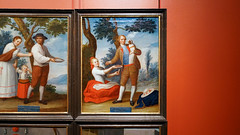
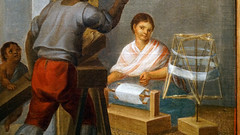
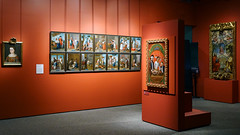
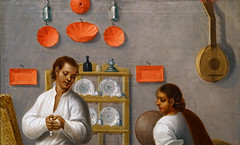

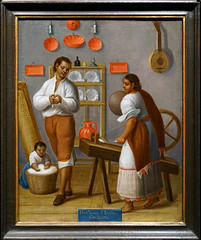
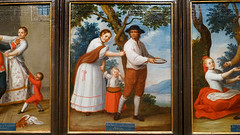
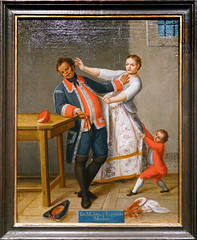

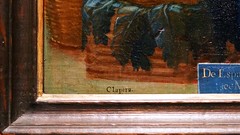

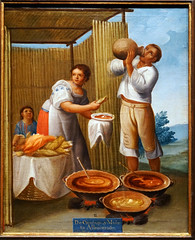
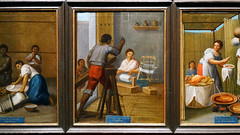
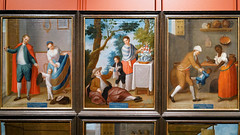
The Virgin of the Macana and the Pueblo Revolution of 1680
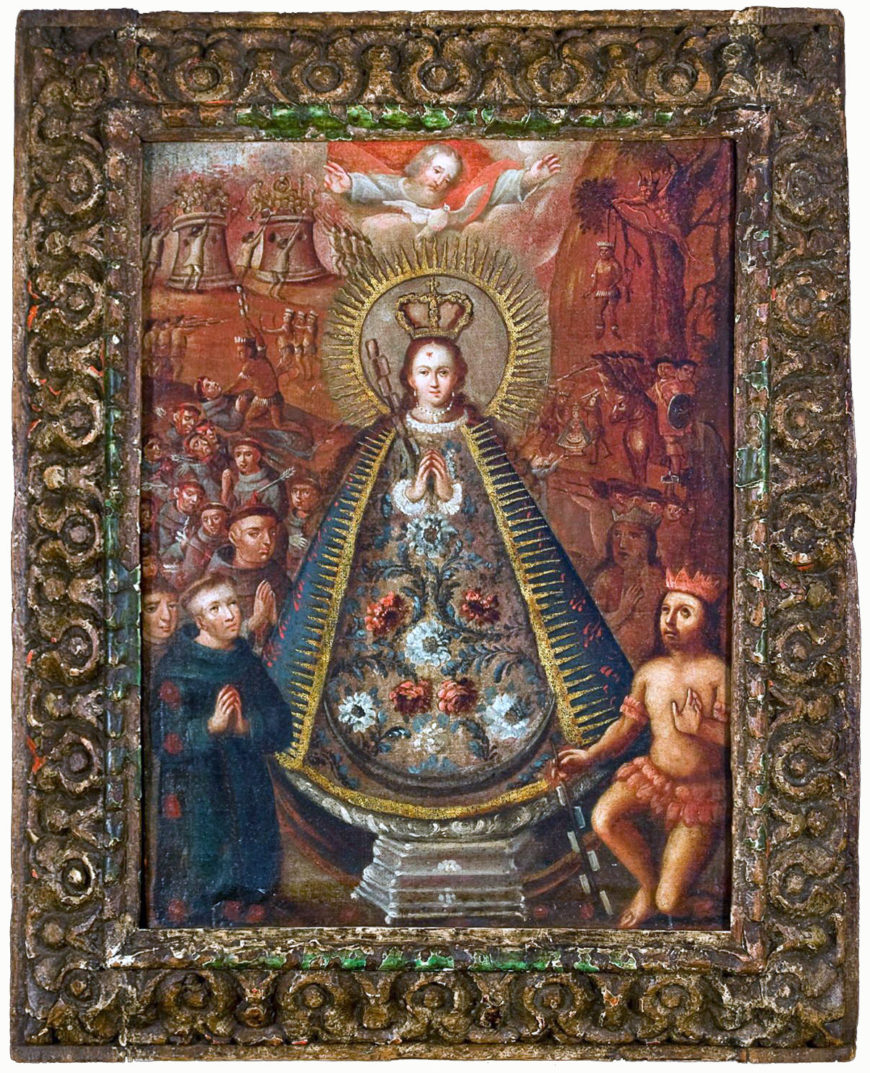
Did you know that the first American Revolution took place in New Mexico? The Pueblo Revolution, better known as the Pueblo Revolt of 1680, was the only successful Indigenous insurgency (armed rebellion) to expel Spanish colonial forces in the Americas (Spanish colonization began in 1492 when Christopher Columbus landed on the island that would become Hispaniola). In the 17th century, New Mexico was part of the northern frontiers of the viceroyalty of New Spain, where Spanish control was continuously contested by Native groups and other European powers. The Pueblo Revolution involved Christianized Pueblo peoples and non-Christian Apaches rising up against the Spaniards, killing 21 Franciscans and almost 400 Spanish colonists. The thousands of remaining colonists were forced to flee.
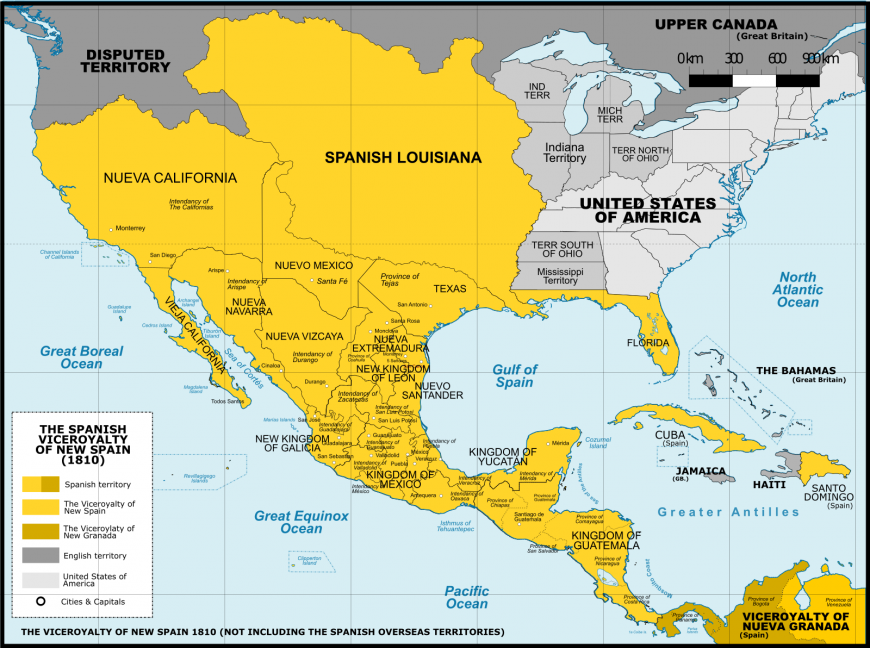
The Pueblo Revolution was a monumental event during which the Native Pueblos of New Mexico regained their independence for twelve years. Despite this, no artists of the period depicted this event, though Spaniards (whose goal was to justify their control of these lands and people) did write about it. It is only in later 18th-century images, such as the The Virgin of the Macana now in the New Mexico History Museum, that help us learn more about this important historical revolution and how artists chose to depict it.
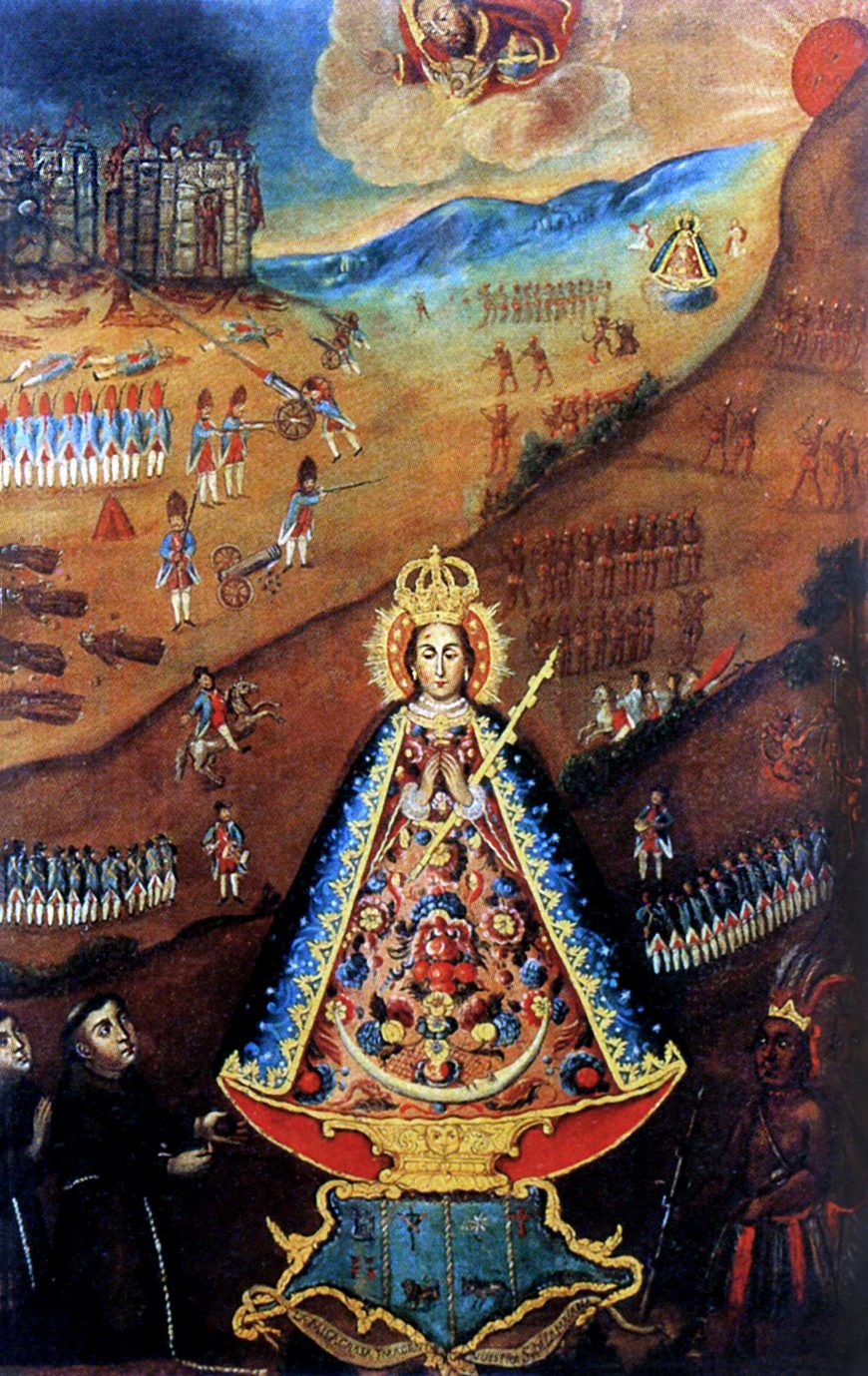
The paintings
Only a few paintings of the Virgin of the Macana (also called just Macana) still exist, and they all date to the second half of the 18th century. They all display remarkably similar iconography: Mary is shown as a statue, bleeding from her forehead, wearing a crown, and holding a macana (a wooden weapon embedded with obsidian blades commonly used by the Nahua peoples of central Mexico—not by the Pueblo peoples in New Mexico). She is surrounded by events from the Pueblo Revolution.
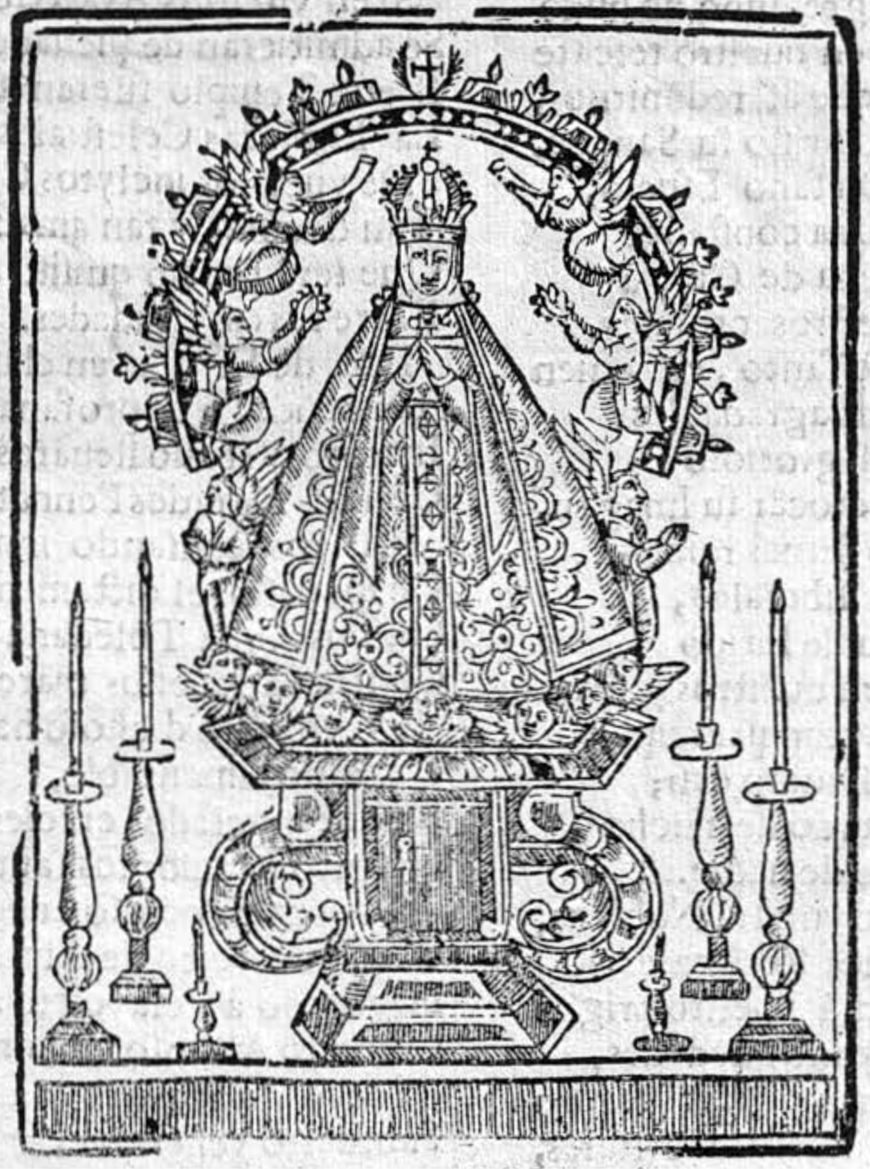
With the Spanish conquest and colonization of the Americas, devotions to and images of the Virgin Mary, Jesus, and saints were transported across the Atlantic Ocean, where they were then adapted to the historical and regional peculiarities of the Spanish colonies. Paintings and prints showing statues (called “statue paintings”) were a popular genre in Spain that was brought to the Spanish viceroyalties. One example is a copy of a statue of the Virgin of Toledo (Nuestra Señora del Sagrario de Toledo), which was brought to New Spain by Franciscan missionaries who viewed Mary as their protectress while they established missions and converted Indigenous peoples. This statue of the Virgin of Toledo would be recast as the Virgin of the Macana (with the addition of the scar and a weapon) in New Mexico a century after the Pueblo Revolution.
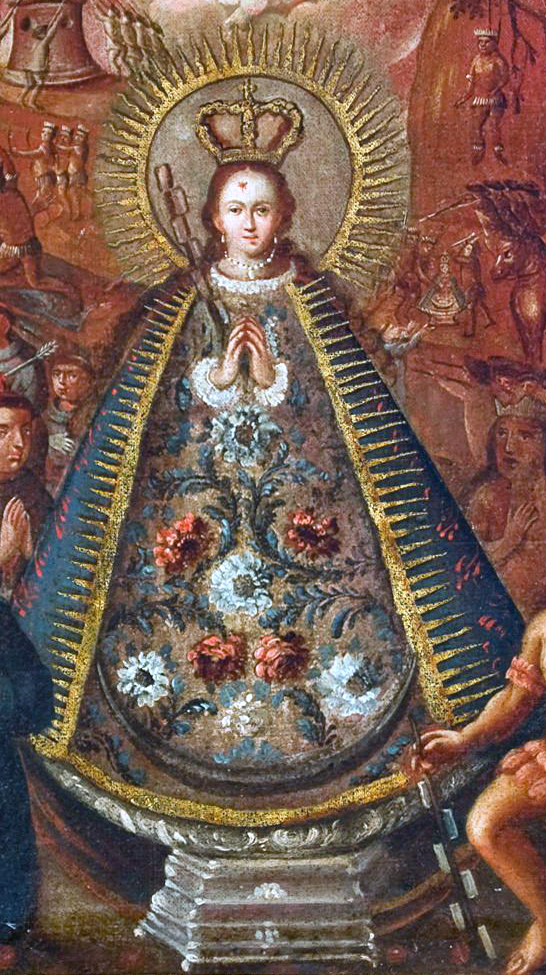
In the painting of Macana in the New Mexico History Museum, the statue of Mary dominates most of the composition. Mary is identifiable as a statue because a pedestal is visible beneath her. We also see a crescent moon at the base of the statue; Mary is often shown standing on a crescent moon (as a reference to her purity and immaculate conception), but here her feet are absent. She wears a blue mantle and an elaborate dress covered in flowers. The dress flares outwards to create a pyramid shape, adding to the impression that this is a painting of a statue. We get no sense of her body underneath. Statues such as this would have been carved in wood, then painted. Additional clothes and jewelry (that could be swapped out) would have further enlivened it.

In the painting, she is flanked on either side by two kneeling figures, a Franciscan friar (to our left) wearing a blue habit and an Indigenous man (to our right) wearing only a headdress, two arm bands, and a feathered loincloth. The man on the right steadies himself with a macana. Both men look up at Mary. The friar and the Native man are not specific individuals—they are generic types that represent the two main groups (Spaniards and Puebloans) that fought one another during the Pueblo Revolution. The kneeling Franciscan missionary also represents the Franciscan friars who had come to the northern frontier of New Spain, and who were killed during the Pueblo Revolution.
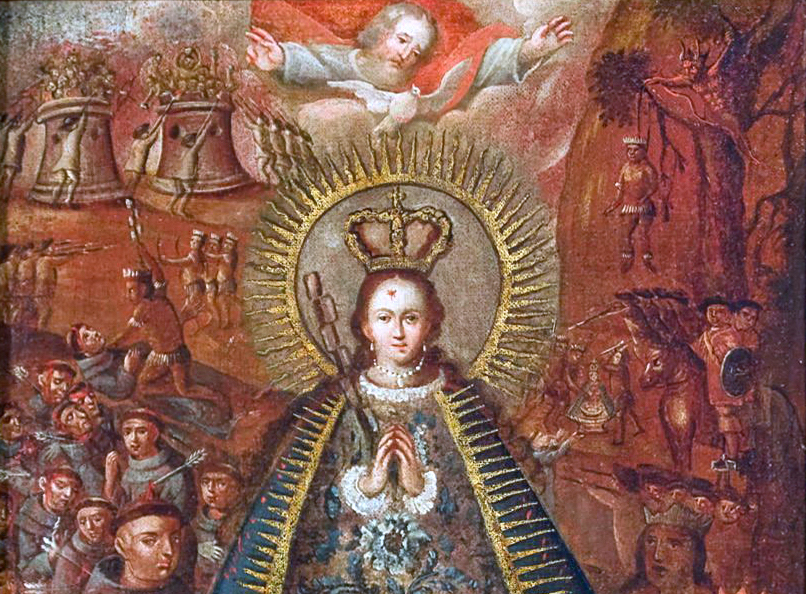
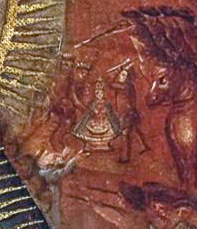
Behind them, a chaotic battle scene plays out. On the top left, Native peoples throw stones against the Spanish army from defensive towers as the Spanish troops fire guns at them. Below, an Indigenous person raises a macana to strike a friar. We also see mutilated Franciscans, many of them with wounds on their heads and arrows through their hearts. The foreground of the painting presents the idea that the Pueblo people who revolted were “barbarians” who killed innocent and unarmed Franciscans.
On the right side of the painting, we see more fighting, with Spanish forces pointing guns and riding in on horses to stop the rebellious Natives. We also see Pueblo peoples attacking the statue of the Virgin of Toledo, and a Native man hanged in a tree in the upper right. Above all this violence, we see God the Father and the Holy Spirit, both framed by clouds.
Questions remain: why did the Pueblos rise against the Spaniards? And why are the Pueblo peoples shown as violent, barbaric aggressors in this painting? Whose version of events do we see here?
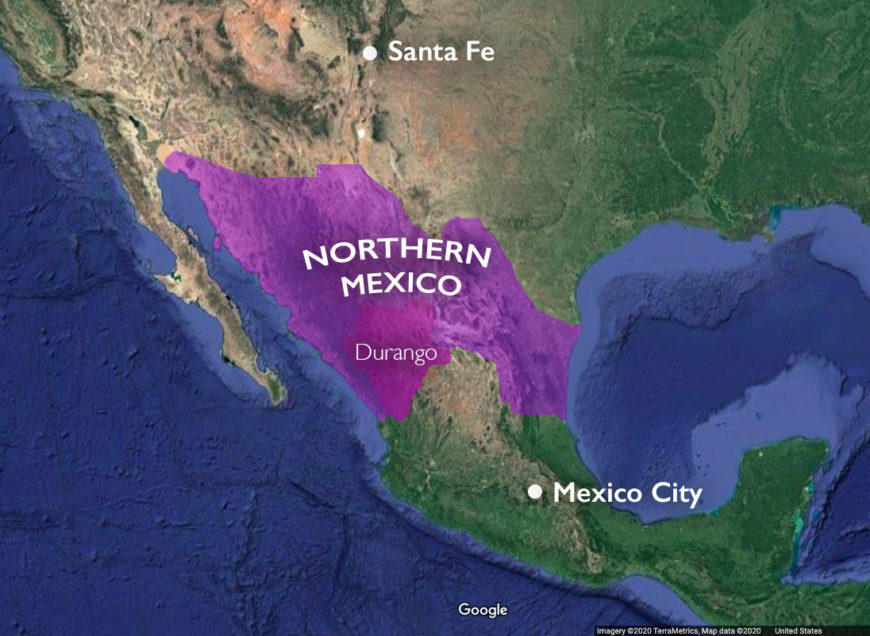
Native resistance
The history of the Americas under the Spanish is marked by a series of often violent encounters between Native peoples and Castilians (as the Spanish knew themselves). If we are to understand this history more fully, we must re-contextualize colonial history to include the series of Indigenous resistance movements that constantly challenged Spanish authority in the territories they administrated. The Pueblo Revolution was only one of many Native uprisings in the northern provinces of New Spain during the 17th century. These included (unsuccessful) uprisings from the Tepehuanes (1616–1620, in present day Durango), Tobosos, Conchos, and the Tarahumaras (1644–1652, in present day northern Mexico), all of whom responded to mistreatments from colonial authorities.
The groups who today identify as Pueblo peoples (in what is today the southwestern United States) shared similar religious beliefs, and a similar visual and material culture, but their languages and customs varied and historically, the Pueblo peoples did not see themselves as part of a unified ethnic group. After the Revolution of 1680, however, a shared sense of regional pride and unity developed as a strategy to keep the Spaniards away from their lands.
The Franciscans and the conversion of the Pueblo peoples
When the Spaniards founded the village of Santa Fe in 1607, the spiritual conquest of the local Pueblo peoples was entrusted to the Franciscans, a religious order that had arrived early on in New Spain, following closely the initial Spanish conquests of central Mexico. The Franciscans began to convert Indigenous peoples to Christianity, and worked throughout the Americas to eliminate what they believed were the idolatrous beliefs of the Native populations. They saw it as their duty to defend what they believed to be the true religion, Christianity. Images such as The Virgin of the Macana, with its depiction of Native people attacking a representation of the Virgin Mary demonstrate how Europeans justified colonization by depicting Native resistance as an attack on their faith.
Under the religious zeal of the Franciscans, Pueblo peoples and their traditions were continuously targeted. Violent colonial practices resulted in severe corporal punishment for many activities including the refusal to observe the Spanish prohibition of Native ceremonial dances. The Spaniards also carried out the near total destruction of Indigenous religious centers and the sacred objects of their worship. Official Spanish accounts of this period focus not on the injustices suffered by Indigenous people, but instead on Native assaults on Spanish authority.
The legend of the Virgin of the Macana
A text written shortly after the Pueblo Revolution helps us to better understand the iconography of paintings of the Virgin of the Macana and how it reflects the Franciscan perspective of the Pueblo Revolution. The Franciscan chronicler Friar Agustín de Vetancurt wrote about the origins of the Virgin of the Macana in his book Teatro mexicano (1698), and later 18th-century artists borrowed from this account to create their images of Macana. Published a few years after Spanish control was restored over the Pueblos (which occurred in 1692), Vetancurt drew information from funeral orations honoring the fallen Franciscans and historic accounts as told by Spanish soldiers including the Spanish Governor of Santa Fe during the Pueblo Revolution.
According to Vetancurt, a copy of the statue of the Virgin of Toledo originally came to New Mexico with Franciscans sometime after the conquistador Juan de Oñate y Salazar intruded into the area in 1598. They had brought the statue from Spain as protection during their mission and it was also intended to signal to local Pueblo peoples that Spanish forces were powerful because Mary watched over them.
Vetancurt’s story details how a few years before the Pueblo Revolution, the Virgin of Toledo appeared to the six-year old daughter of the Spanish governor. The Virgin miraculously cured the girl of a physical ailment, and then cautioned her to warn her father and local administrators against the injustices they had committed against the Pueblo peoples for almost a century. She also requested that the Franciscans be treated better by Spanish administrators (there were ongoing tensions between political colonial administrators and the Franciscan missionaries at this time). If the abuses of either group continued, the Virgin of Toledo warned, the conquistadors would be punished. The Virgin is quoted as saying:
Raise thyself child, and tell that this province will soon be destroyed for the lack of reverence that it shows my priests, and that this miracle will be the testimony of this truth; that they mend their ways, should they not want to experience punishment. [1]
In other words, the apparition was supposed to be a wake-up call to local government authorities. Yet those cautioned ignored her call, and six years later, the Pueblo Revolution occurred.

According to legend, during the Revolution a Native struck the forehead of the statue of Our Lady of Toledo in an attempt to destroy it, creating a wound that was visible on the statue. From the Spanish perspective, Macana’s survival was miraculous. The statue survived the Revolution largely unscathed at a time when other churches and Christian images were destroyed. In painted versions of Macana, the wound is visible on the statue to remind viewers of this miraculous moment.
This violent act transformed the statue of the Virgin of Toledo into the Virgin of the Macana; she was given the macana to hold. Here, the statue’s forehead wound represents Native violence, and more importantly, Christian triumph over the “barbarian.” A Native weapon transferred to the hands of the Virgin became a powerful Christian emblem that legitimized the Spanish campaign against Native people and their perceived idolatry (which the Spanish believed was aided by the Devil). In this way the Macana also undermined the legitimacy of the Pueblo Revolution despite the warning of the Virgin to the daughter of the Governor. After the Revolution, the statue was moved to Mexico City, and, after 1754 was housed in the main Franciscan convent of San Francisco where it is still venerated to this day (although the statue today is possibly not the original). [2]
Franciscan martyrdom
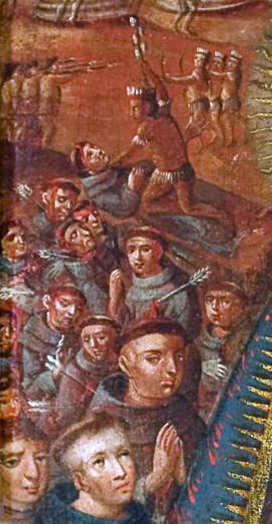
In paintings of Macana, Indigenous people attack and kill Franciscans. From the Franciscan perspective, these men died as martyrs—in other words they died for their Christian faith. Paintings, like the version in the New Mexico History Museum, show the martyr-making process that was desired by the members of the Franciscan order. Those who died through the violent acts of barbarian heathens (as they understood it) echoed Christ’s death at the hands of the pagan Romans.
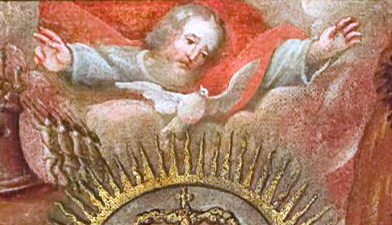
The inclusion of God and the Holy Spirit at the top of the painting suggests the divine destiny of the twenty-one Franciscans who were martyred during the uprising. God holds his arms open, blessing the Virgin Mary and the martyrs in the chaotic scene below.
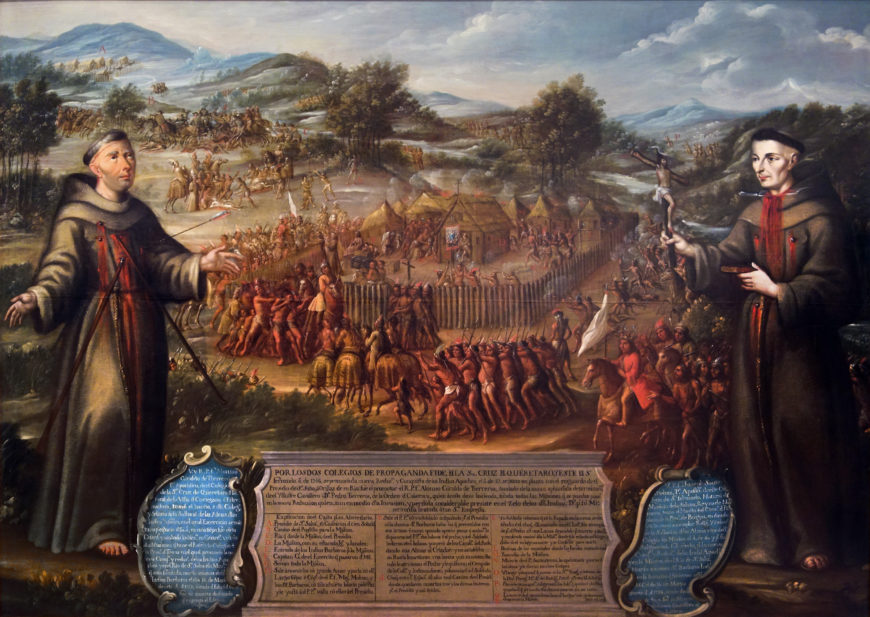
Paintings of the Virgin of the Macana relate to another genre of images that were popular in the later viceregal era: Franciscan martyr portraits, such as one attributed to José de Páez displaying the friars José de Santiesteban and Alonso Giraldo de Terreros who were killed at the Mission San Saba in Texas. These types of portraits typically depict the individuals killed, along with smaller scenes showing their violent death at the hands of Indigenous peoples. Inscriptions detail the events of the martyrdom and the biography of the martyr. Like paintings of Macana, martyr portraits foregrounded missionaries dying as a result of Native violence and visually eliminated Indigenous struggles under Spanish subjugation. Images showing Franciscan martyr narratives were common in monastic spaces because they were thought to inspire future missionaries who might die on the northern frontiers of New Spain.
Images of Macana were intended for a Franciscan audience. They functioned as a powerful testament to the Franciscan mission to convert Native peoples at a time when Spanish administrators felt the religious order was failing. This helps to explain why an event from the late 17th century was an important subject in the later 18th century, and why we do not have a larger number of paintings (as we do for other miraculous Marian apparitions such as the Virgin of Guadalupe). The legend of Macana, as portrayed here, served a specific Franciscan agenda.
“Devout Indians” and “Barbarians”
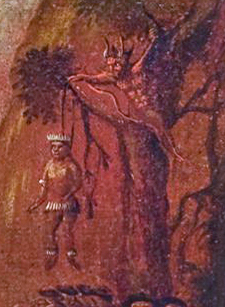
In paintings of the Virgin of the Macana, we see two types of Indigenous people: the violent barbarians who kill the Franciscan friars and pious Indigenous figures who kneel before the Virgin Mary, reformed of their violent habits. In Vetancurt’s book, he claims the Devil advised Pueblo peoples to engage in the violent insurrection. In other scenes, violent “barbarians,” driven by un-Godly motives, attack the Franciscans as well as the Marian statue. In their attacks, they wield the macana, a weapon, as previously noted, that wasn’t used by the Pueblo peoples. This was a means to underscore the trope of the barbarian—historical accuracy wasn’t important. The devil himself actually makes an appearance in the painting, holding the rope by which the Native man is hanged (even as the Devil is understood to have encouraged the revolt). The hanged man is represented as the man who struck the statue of the Virgin in the scene directly below this one.
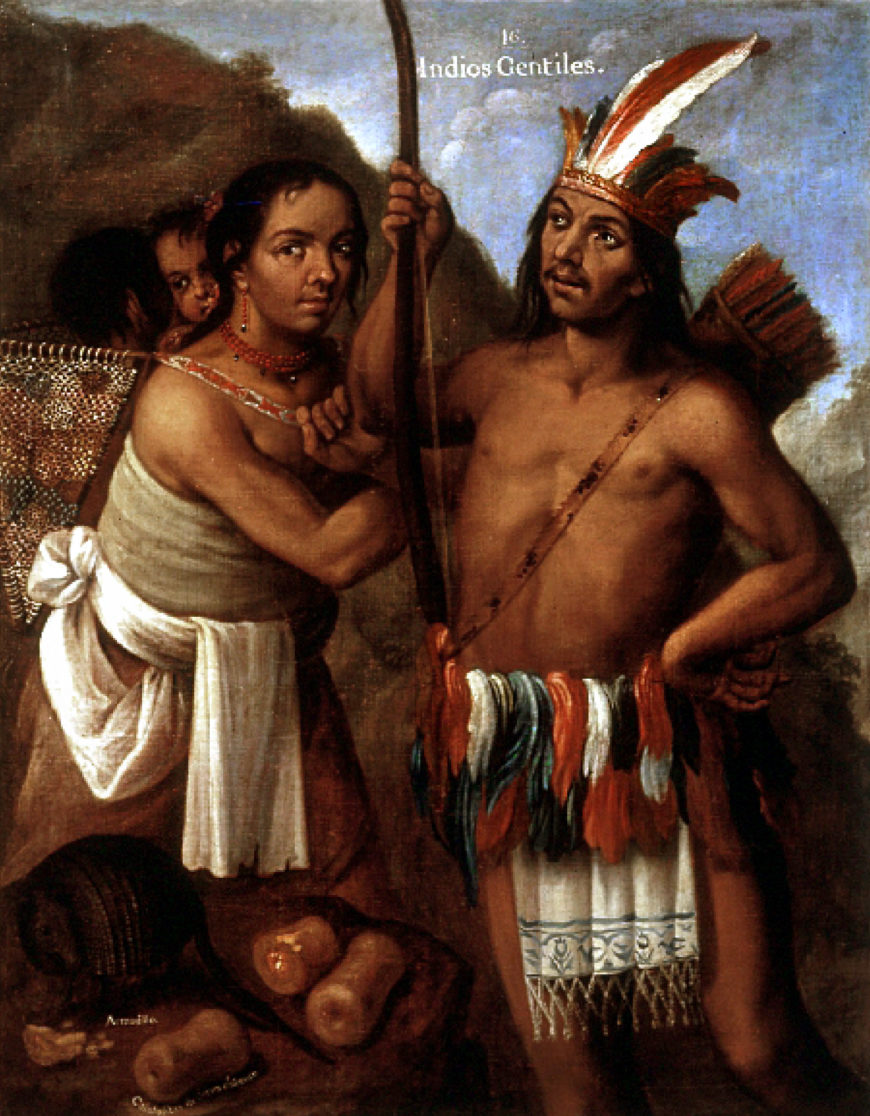
In Colonial Spanish American art, the “barbarian” was commonly represented half-naked, wandering through rural settings, and in need of spiritual intervention. From early 16th-century maps and prints of the Americas showing bands of naked cannibals to 18th-century casta paintings (such as a panel by Miguel Cabrera showing indios genitles) depicting nomadic tribes at the edges of the empire, the iconography of the uncivilized “barbarian” remained popular throughout colonial visual culture (as well as in Europe).

One aspect of these paintings did change over time. The locations in which Natives were represented. In the early 1500s, images of Indigenous people were located in places like Central Mexico where the Spaniards had defeated the powerful Mexica Empire. Representations of “barbarians” were enlivened with careful renderings of plants, natural topographic features, and animals found in this region. After the success of the Pueblo Revolution, artists began to show Natives on the edges of the Spanish empire—in Texas, New Mexico, and California (such can be seen in José de Páez’s martyr portraits of friars José de Santiesteban and Alonso Giraldo de Terreros in Texas). Such paintings were used as visual evidence of the need for tighter colonial administration of these areas.
In The Virgin of the Macana, the miraculous intervention of the Virgin Mary transforms the uncivilized, violent Native into one who is subdued and converted to Christianity, here symbolized by the Native men kneeling beside her in the foreground. The “devout Indian” became a common trope throughout the 300 years of Spanish control in the Americas and was intended to show the successful conversion of Native peoples. Showing Native peoples before and after Christian conversion emphasizes the power of the Virgin’s intervention during the Pueblo Revolution, and by extension, the success of the Franciscan mission system in New Mexico.
Revolutionary Images
Colonial paintings of the Virgin of the Macana are important because they reveal the process in which Franciscans obscured Indigenous discontent by rendering Native groups as violent savages with no justification for their resistance. Vetancurt’s account and the later images of the Virgin of the Macana focus on Pueblo violence and idolatry, and reference the tense political environment in late 17th-century New Mexico. The representation of Native resistance, spiritual conquest, and the triumph of Catholic dogma underline the extraordinary effort undertaken to convert Native Peoples. However, re-contextualizing devotional paintings such as The Virgin of the Macana in the New Mexico History Museum to include a less biased history of the Pueblo Revolution makes it possible to visualize alternatives readings of the violence against Native people, as well as their historic resistance.
Notes:
[1] Augustín de Vetancurt, Teatro mexicano: descripción breve de los sucesos ejemplares de la Nueva-España en el Nuevo Mundo Occidental de las Indias (Madrid: J. Porrúa Turanzas, 1960), 103.
[2] Antonio García Cubas, El libro de mis recuerdos: narraciones históricas, anecdóticas y de costumbres mexicanas anteriores al actual estado social, ilustradas con más de trescientos fotograbados (Mexico City: Imprenta De Arturo Garcia Cubas, 1904), p. 64.
Additional resources
Ilona Katzew,“The Virgin of the Macana: Emblem of a Franciscan Predicament in New Spain,” Colonial Latin American Review 12, no. 2 (2003): pp. 169–198
Luisa Elena Alcala, “The Images of the Devout Indian: The Codification of a Colonial Idea,” Contested Visions in the Spanish Colonial World, ed. Ilona Katzew (Los Angeles: LACMA, 2011)
Images of the Natives in the Art of New Spain, 16th to 18th centuries (Mexico City: Banamex, 2005)
Learn about Columbus’ Landing and Erasing Native Resistance with the project Unsettling Journeys
Emmanuel Ortega, “Hagiographical Misery and the Liminal Witness: Novohispanic Franciscan Martyr Portraits and the Politics of Imperial Expansion,” in Visualizing Sensuous Suffering and Affective Pain in Early Modern Europe and the Spanish Americas, ed. Lauren G. Kilroy-Ewbank and Heather Graham (Leiden: Brill, 2018), pp. 234–65.
Crowned Nun Portrait of Sor María de Guadalupe
Video \(\PageIndex{24}\): Crowned Nun Portrait of Sor María de Guadalupe, c. 1800, oil on canvas (Banamex collection, Mexico City)
SmartHistory images for teaching and learning:
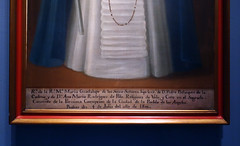
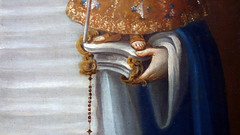
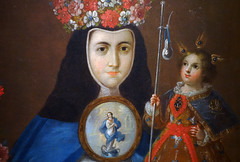
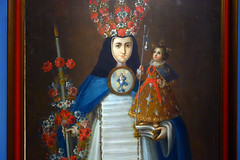

British colonies to the Early Republic
Artists in the British colonies and early United States looked to Europe for inspiration.
1607 - 1820
Colonial period
Inventing “America,” The Engravings of Theodore de Bry
Theodore de Bry’s Collected travels in the east Indies and west Indies
In the center of a print image we see a finely-dressed Christopher Columbus with two soldiers. Columbus stands confidently, his left foot forward with his pike planted firmly in the ground, signaling his claim over the land. Behind him to the left, three Spaniards raise a cross in the landscape, symbolizing a declaration of the land for both the Spanish monarchs and for the Christian God.
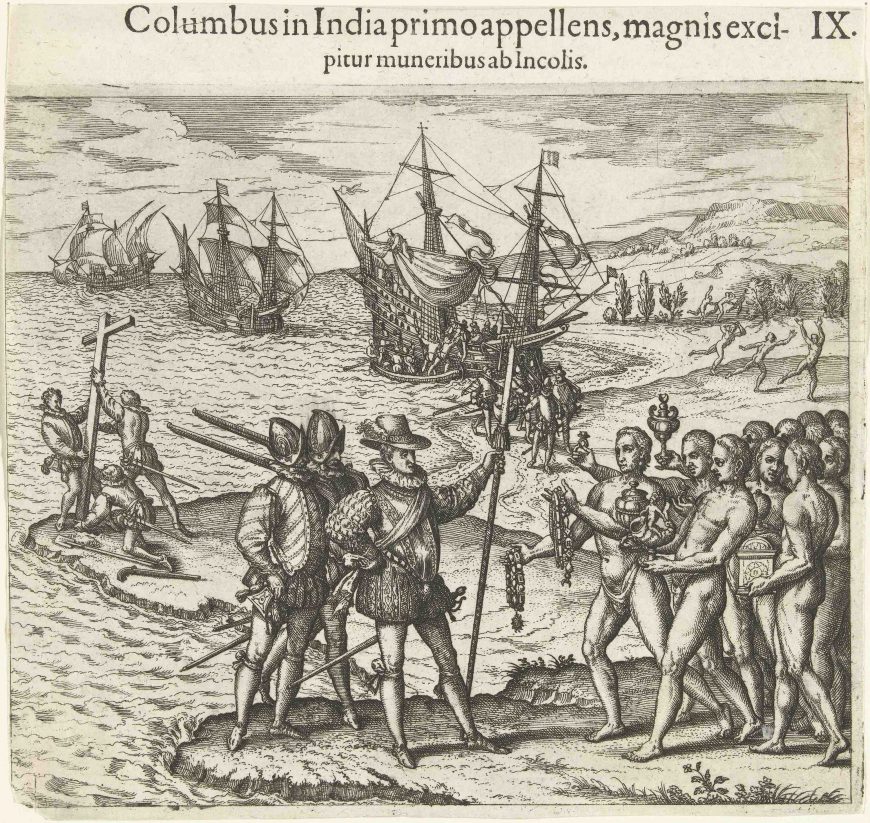
Unclothed Taínos, the Indigenous peoples of the island of Ayiti (better known by the later Spanish name, Hispaniola), walk toward Columbus bringing gifts of necklaces and other precious objects. Further in the background, on the right side of the print, other Taínos, with arms raised and twisting bodies, flee in fear from the Spanish ships anchored offshore.
This print from 1592, by the engraver Theodore de Bry, presents Columbus and his men as the harbingers of European civilization and faith, and juxtaposes them with Tainos, who are presented as uncivilized, unclothed, and pagan. This print, along with hundreds of others de Bry made for his 27 volume series, published over more than forty years, Collected travels in the east Indies and west Indies (1590–1634), affirm and assert a sense of European superiority, as well as invent for Europeans what America—both its land and its people—was like.
Though de Bry is most famous for his engravings of European voyages to the Americas (and Africa, and Asia), he never actually traveled across the Atlantic. It is not surprising then that de Bry’s depiction of the Indigenous peoples of the Americas was a combination of the work of other artists who had accompanied Europeans to the Americas (artists were often brought on journeys in order to document the lands and peoples of the Americas for a European audience) as well as his own artistic inventions. For instance, he adapted (without credit) some of the images created by Johannes Stradanus, a well-known illustrator who created early images of the Americas. In his Collected travels in the east Indies and west Indies, de Bry republished (and translated into multiple languages) the accounts of others who had spent time traveling around the globe, and created more than 600 engravings to illustrate the volumes. The engraving above of Columbus and the Taínos comes from volume 4 of the Collected travels in the east Indies and west Indies. This volume reprinted the accounts of the Milanese traveler Girolamo Benzoni, who himself had drawn on the accounts of Columbus in his own writings.
The volumes of the Collected travels in the east Indies and west Indies that treat the voyages across the Atlantic to the Americas are known as the Grands Voyages, while the Petit Voyages (small voyages), were those to Africa and Asia.
Documenting America
De Bry’s copperplate engravings were among the first images that Europeans encountered about the peoples, places, and things of the Americas, even if he began making them almost a century after Columbus’s initial voyage. In the engraving with Columbus on the shoreline, the barely clothed Taínos resemble Greco-Roman sculptures, especially their poses and musculature. De Bry apparently had no interest in documenting the actual appearance of the Taínos.
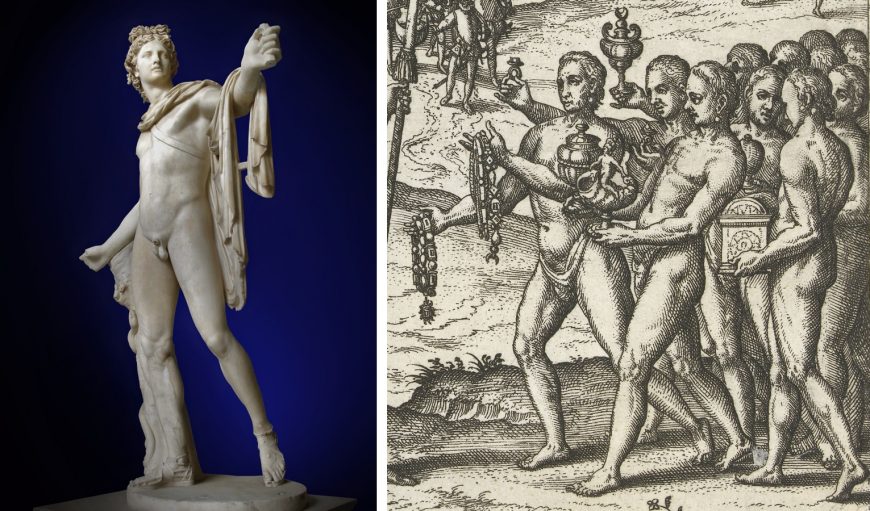
De Bry’s Collected travels belongs to the genre of travel literature, which had been popular since the Middle Ages. Accounts of the Americas became wildly popular after Columbus’s first voyage. For example, Columbus’s 1493 letter to King Ferdinand and Queen Isabel (who had helped finance the voyage) was published in seventeen editions by 1497, and often included woodcuts depicting select moments of his voyage.
De Bry and his audiences
De Bry was a Protestant, and fled Liège (today in Belgium) where he was born to avoid persecution. He made his way to Frankfurt, which is where he started work on Grands Voyages. After his death in 1598, his family continued his work and finished the remaining volumes in 1634. Interestingly, different versions of the Grands Voyages catered to different Christian confessional groups. The volumes in German were geared towards Protestants, while those in Latin appealed to Catholics. De Bry created images that he could market to either audience, but he made changes to the texts to appeal more to either Catholics or Protestants. Psalms that Calvinists felt encapsulated their beliefs or longer passages criticizing Catholic beliefs or colonial practices were omitted from Latin versions, which were often filled in with more engravings duplicated from other parts of the text.
General subjects of the Grands Voyages engravings
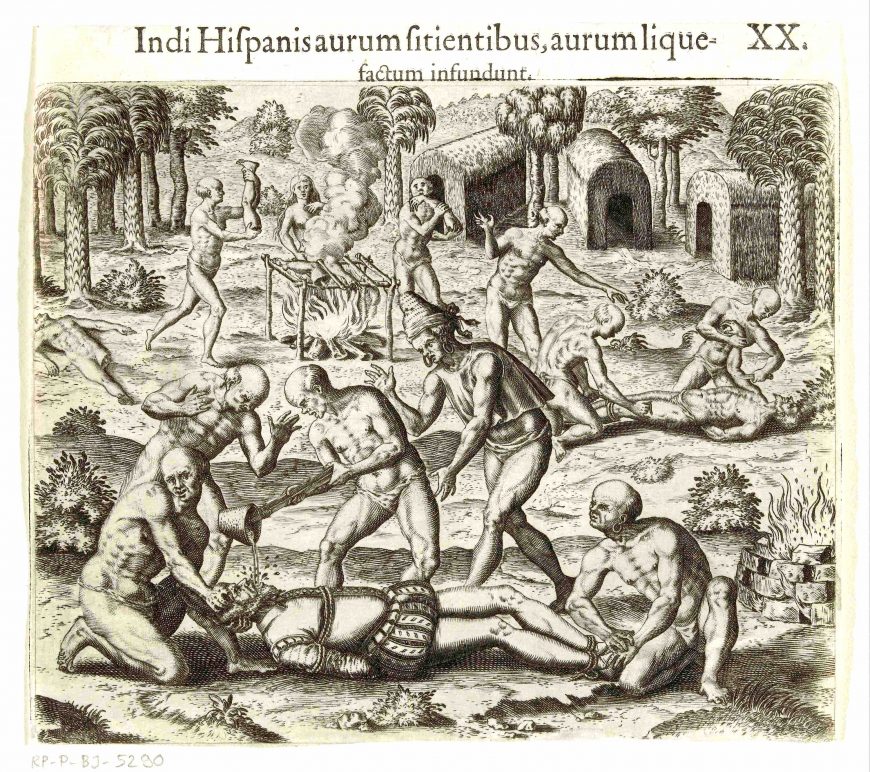
While some of de Bry’s prints in Grands Voyages focus on the exploits of famed European navigators like Columbus, others show Indigenous groups and their customs. Some of these images display the atrocities that occurred in the wake of Europeans’ arrival, violent conquest, and colonization. Indigenous peoples are fed to dogs, hanged, or butchered. Still others depict native responses to the European invasion, such as drowning Spaniards in the ocean or pouring liquid gold into invaders’ mouths.
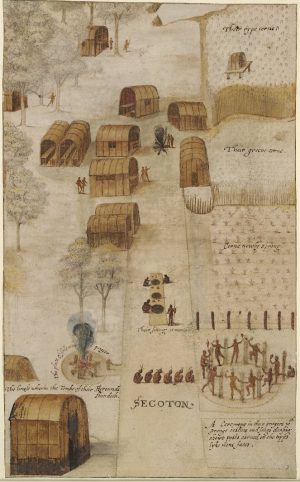
Travels to Virginia
The Grands Voyages (the section on cross-Atlantic voyages) begins with a reprint of an earlier text by the English colonist Thomas Hariot, A Brief and True Report of the New Found Land of Virginia (1590). It also includes translations of this text into Latin, German, and French. De Bry’s accompanying engravings were based on watercolors by John White, who had settled on Roanoke Island, North Carolina in 1585 and who had created paintings while there. His watercolors document clothing, dwellings, and rituals of the eastern Algonquian peoples.
Even though Virginia and North Carolina were colonized by Europeans after they had seized other areas in the Americas, de Bry placed them in the first volume of his Grands Voyages. This may be because he had visited London just after Hariot’s book was published in 1588, and was given both that text and the watercolors of White. De Bry was clearly not interested in a providing a chronological account of European exploration and colonization.
One of White’s paintings represents the town of Secoton, with people going about their daily life activities. In the right foreground people dance in a circle. Corn grows in neat rows. Dwellings line a road. In his engraving, de Bry made several changes to White’s watercolor. He expanded the village and removed the textual inscriptions that identified important features of the village (instead incorporating a separate key).
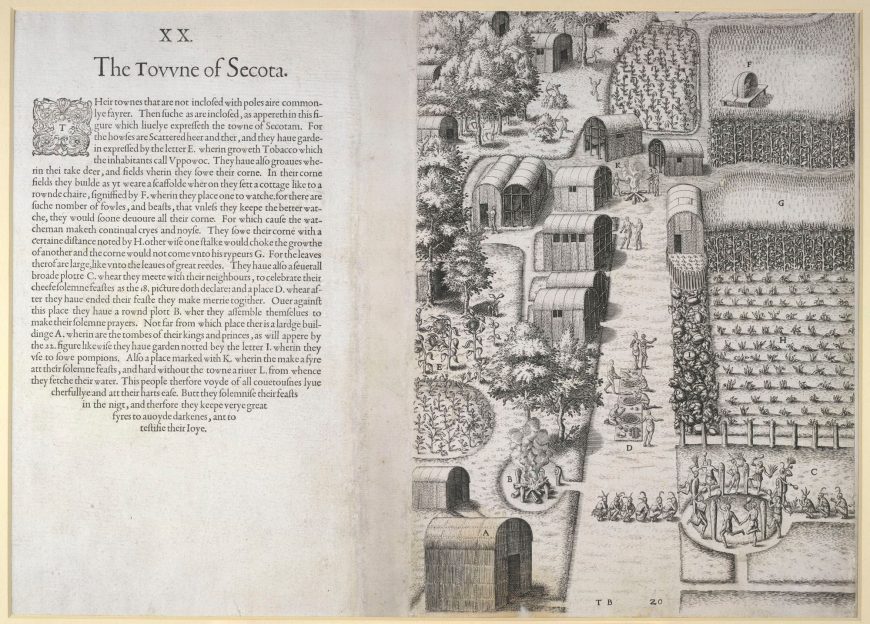
For his engravings, de Bry also transformed watercolors White had created of Scottish Picts (an ancient pagan Indigenous peoples of Scotland who lived in a loose confederation of groups and who painted their bodies). But why include a discussion of Picts in a book on the Americas?
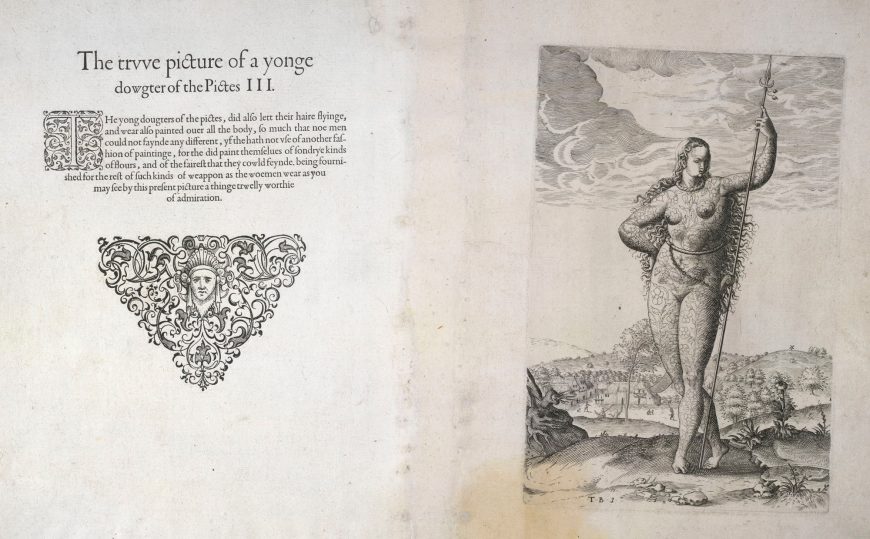
Hariot’s text states that “Some picture of the Picts which in the old time did inhabit one part of the great Britain,” which according to him “show how that the inhabitants of the great Britain have been in times past as savage as those of Virginia.”[1] White compares them to the Algonquian peoples to suggest that Europe has its own history of uncivilized, pagan people. Despite attempting to reconcile the Algonquian peoples with the Picts in Europe, the manner in which he compares them—as savages—speaks to a presumed European superiority.
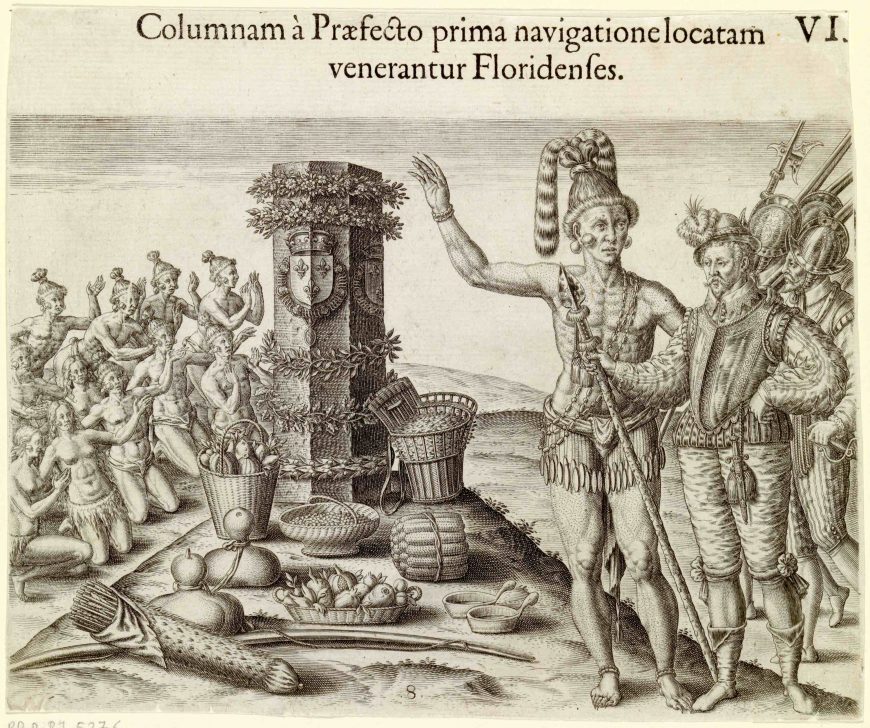
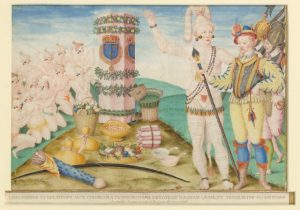
Travels to Florida
Volume 2, published in 1591, focused on French voyages to Florida, and was based on the accounts of the French colonist René Goulaine de Laudonnière. De Bry created engravings based on the watercolors of Jacques Le Moyne de Morgues, who was part of the French expeditions to Florida that were headed by Jean Ribault in 1562 and Laudonnière in 1564. One of the engravings adapted from Le Moyne’s watercolors shows the Timucua worshipping a column that had supposedly been erected by Ribault. The most prominent figure, identified as chief Athore, stands next to Laudonnière, who has followed him to see the sight. The other Timucua kneel, while raising their arms in gestures of reverence in the direction of the column, itself decorated with garlands. Before it, offerings of food and vegetables abound. De Bry made several notable changes to the print, such as adjusting Athore’s features to look more European, with raised cheekbones and an aquiline nose. Le Moyne’s earlier watercolor had also Europeanized the Timucua peoples: he paints them with the same complexion as Laudonnière, but with even blonder hair.
Cannibalism in Brazil
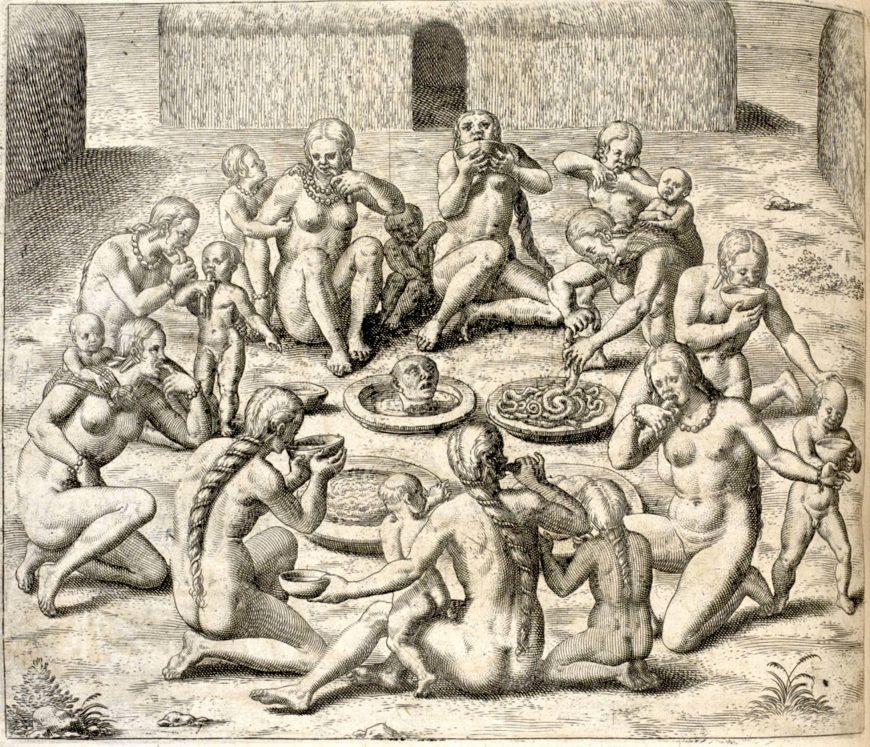
Cannibalism was (and remains) commonly associated with certain Indigenous peoples of the Americas. In de Bry’s series, his third volume recounted Hans Staden’s experiences of cannibalism in Brazil. De Bry’s engravings for this volume were among the most well-known in the late sixteenth and early seventeenth century, in large part because of their gruesome and sensationalistic character. Note that de Bry’s print, “Indians pour liquid gold into the mouth of a Spaniard,” may also depict cannibalism among the figures shown in the background.
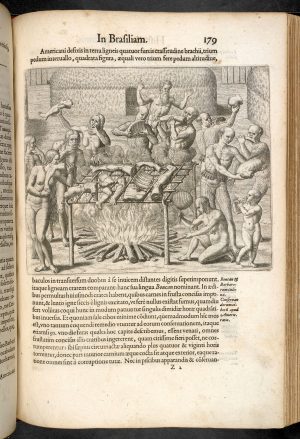
Staden, a German soldier who traveled to South America, had been captured in 1553 by the Tupinambá, an Indigenous group in Brazil. After his return to Europe in 1557, he wrote about Tupinambá customs, family life, and cannibalism, describing how the Tupinambá practiced it ceremonially, especially eating their enemies. Staden’s initial book included simple woodcuts, but de Bry’s updated engravings proved far more popular and enduring in the European cultural imagination. Perceptions of Indigenous Brazilians were shaped by these images, and reinforced the notion that the Tupinambá, and others like them, were depraved, primitive, and sinful.
One of his images depicts naked adults and children drinking a broth made from a human head and intestines, visible on plates amidst the gathering of people. Another depiction of the Tupinamba shows a fire below a grill, upon which body parts are roasted. Figures surround the grill, eating. In the back is a bearded figure, most likely intended to be Staden. Hand-colored versions of de Bry’s prints emphasize the disturbing subject of the images even more.
Cannibalism would come to be closely associated with peoples of the Americas. De Bry would even use images of cannibals to serve as the engraved frontispiece to volume 3. Showing the Tupinambá eating human flesh exoticized them, and justified European control.
Other volumes and the legacy of de Bry
The fourth, fifth, and sixth volumes of the set focus on Girolamo Benzoni’s accounts, such as Historia Mondo Nuovo, with part 6 discussing the atrocities committed against the Indigenous population of Peru. Parts 7 to 12 incorporated the travel accounts of Ulricus Faber, Sir Francis Drake and Walter Raleigh, José de Acosta, Amerigo Vespucci, John Smith, and Antonio de Herrera among others. Like the volumes that came before them, de Bry provided numerous images to increase readers understanding of the narratives.
The Grands Voyages, and the entire Collected Travels, relate more generally to the forms of knowledge and collecting popular at the time. Like a cabinet of curiosity, de Bry’s project organized information in text and images so that readers could come to know the Americas. The volumes seek to provide encyclopedic knowledge about the Americas, much as the objects did in a curiosity cabinet. De Bry’s many prints were important resources for Europeans who sought to better understand the Americas. It allowed readers to take possession of these distant lands and peoples, where they could become participants in the colonial projects then underway, allowing them to feel a sense of dominance over the peoples and lands across the Atlantic—lands which many in Europe would never see firsthand. These often inaccurate images and narratives supported a sense of superiority, with Europeans positioned as more civilized and advanced, and the American “others” as less so. De Bry’s images of America would cement for Europeans a vision of what America was like for centuries to come.
[1] “Some Pictvre of the Pictes which in the olde tyme dyd habite one part of the great Bretainne,” which according to him “showe how that the inhabitants of the great Bretainne haue been in times past as sauuage as those of Virginia.” 67. Thomas Hariot, with illustrations by John White, A Briefe and True Report of the New Found Land of Virginia (1590).
Additional resources:
Picturing the New World: The Hand-Colored de Bry Engravings of 1590
White Watercolors and de Bry engravings, on Virtual Jamestown
De Bry engravings of the Timucua, on Florida Memory
Columbus reports on his first voyage, 1493
Kim Sloan, ed., European Visions, American Voices, British Museum Research Publication 172 (2009).
Bernadette Bucher, Icon and Conquest: A Structural Analysis of the Illustrations of de Bry’s Great Voyages (Chicago: U of Chicago Press, 1981).
Michael Gaudio, Engraving the Savage: The New World and Techniques of Civilization (Minneapolis: University of Minnesota Press, 2008).
Stephen Greenblatt, Marvelous Possessions: The Wonder of the New World (Chicago: U of Chicago Press, 1991).
Michiel van Groesen, “The de Bry Collection of Voyages (1590–1634): Early America reconsidered,” Journal of Early Modern History 12 (2008): 1–24.
Michael van Groesen, Representations of the Overseas World in the de Bry Collection of Voyages (1590–1634) (Leiden: Brill, 2008).
Maureen Quilligan, “Theodore de Bry’s Voyages to the New and Old Worlds,” Journal of Medieval and Early Modern Studies 41, no. 1 (Winter 2011): 1–12.
Portraits of John and Elizabeth Freake (and their baby)
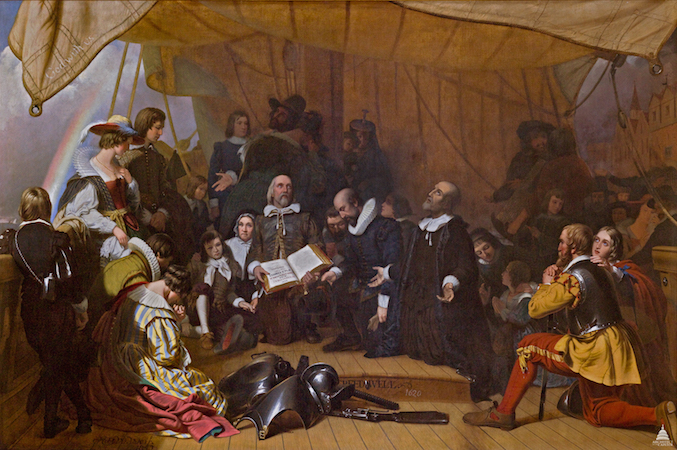
Elementary school history books in the United States might give young students a slightly misleading impression of what the earliest Puritans in North America—those who history calls the Pilgrims—were really like. If images in these texts are to be believed, the men wore black pants and matching waistcoats that were embellished with plain rectangular lace collars. When feeling particularly formal, these Puritans would often wear a plain black hat that was only decorated with an inexplicable buckle in the front. Puritan women dressed in similarly austere attire, seldom straying from dark, somber clothing.
Mr. Freake
While this may have been true for the earliest Puritans in North America, it is significantly less accurate for the Puritans who came to live in the northeast as the seventeenth century moved onwards. This fallacy is visually demonstrated by portraits completed about 1670 by an unidentified artist called the Freake Painter, an artist so named because of his most well known sitters—members of the Freake family. These two paintings, both begun in 1671, depict John Freake in the first portrait, and his wife Elizabeth and their daughter Mary in the second. In many ways, these pendant portraits eloquently speak as to what it meant to be part of the upper-middle-class elite in Colonial New England during the final decades of the seventeenth century.

We can learn much about John Freake (1631-1674), his perception of self, and his place within society through a careful analysis of his portrait. Born in England, Freake immigrated to Boston in 1658 when in his mid twenties and became a merchant and attorney of significant wealth. Indeed, before his death he owned two homes, a mill and brew house, and profitable shares in six mercantile ships. Clearly, he was a man of assets and wealth, and this is reflected in his attire. To begin, Freake wears a fine velvet coat that is dark brown in color rather than the more stereotypical black most of his Puritan brethren may have worn 50 years before. In addition, his coat is decorated with more than two-dozen silver buttons, both along the front of the jacket and atop the pocket flaps. The tailor—either one in colonial Boston or, more likely, one across the Atlantic in England—embellished each buttonhole with expensive silver thread.
Freake’s expensive coat is but one indicator of his elevated social and economic status. In addition, Freake wears a fashionable white muslin shirt with puffed sleeves and elaborate crenulated cuffs. His collar is not the plain, rectangular one we might expect on the basis of our elementary school history books, and is instead a highly decorated and elaborate lace collar imported from Europe, likely from Venice, Italy. Rather than descend from his throat to his sternum, this collar instead circles his neck and stretches across both of Freake’s shoulders. The ornate silver broach Freake touches with his left hand and the gloves he holds with his right—in addition to the ring he wears on the pinky of his left hand—all speak to his wealth and his status as a gentleman.
Roundhead or Cavalier? Look at the hair!
Thus, Freake’s clothing announces something important about his prosperity. Likewise, his hair comments on his sense of religious identity. During the end of the seventeenth century, there were two distinct hairstyles that helped identify those who wore them. If one were to wear their hair in short manner, they announced themselves to be a Roundhead, a visual representation of Puritan austerity. In contrast, long hair—or, the wearing of a wig—announced the man as one who was a morally questionable Cavalier. With these two extremes in mind—the Puritanical Roundhead and the suspicious Cavalier—John Freake comfortably resides in the middle. Neither too short nor too long, Freake’s hair—and it is that, rather than an artificial wig—announces his morality and religiosity squarely in the middle, a kind of hirsute juste milieu (middle ground).
Thus, Freake’s clothing and hair does much to identify him during the end of the seventeenth century. His attire is fashionable, but not overly extravagant. Freake was among those who believed that his prosperity in life was due to God’s blessing, and as that was the case, it was not inappropriate to dress in a way that highlighted that divine favor. Likewise, his hair identifies him as religiously moderate; neither excessively devout nor liturgically loose.

Mrs. Freake
Similarly, the artist has depicted John’s wife, Elizabeth, in a way that highlights her appropriate wealth—and thus her favorable position within the eye’s of God—and her religious moderateness. Like her husband, Elizabeth wears unexpectedly fine attire. A small amount of blond hair is visible underneath her white lace hood. That hood, tied nearly underneath a slightly protruding chin, brings visual attention to the white collar and the striking white lace that covers most of the bodice of her silver taffeta dress. Underneath her skirt is a striking red-orange velvet underskirt that is embroidered with a gold, lace-like pattern. She wears a white blouse that features lace cuffs on the sleeves, while red and black bows provide a visual splash of color and contrast against an otherwise somewhat achromatic ensemble.
Like her husband, Elizabeth’s portrait is filled with baubles that speak to their affluence and to the family’s growth. She wears a triple-stranded string of pearls about her neck, a gold ring on her finger and a beautiful four-stranded garnet bracelet can be seen on her left thumb and wrist. She sits on a fashionable chair, and a Turkey-work rug can be seen resting on the back of the chair. Although Elizabeth currently holds her infant Mary, radiograph x-ray photography shows that she originally held a fan. That the painting has been modified—fan out, new baby who wears a fashionable dress in—tells us much about the extravagant cost of having one’s portrait commissioned in the seventeenth century. It was more practical to have your daughter painted into an old portrait than to pay for a new one.
Displays of wealth
A twenty-first-century audience might scoff at these images, thinking them, perhaps, too flat, too inanimate, and too serious for our own particular aesthetics. However, this pair of images powerfully speaks to the Freakes’ understanding of their place in their world while at the same time dismissing our mistaken stereotypes of seventeenth-century Puritans. The Freakes are not an austere couple, entirely clad in black. Instead, they display their wealth—both in dress and in accessories—in a moderate and acceptable way that suggests divine blessing. In addition, while we might dismiss this artist as an unaccomplished limner (an artist with no or little formal training), he was instead a talented portraitist who was working within a rich tradition of Elizabethan painting. His images helped situate his sitters within a distinguished and rich traditional of English court portraiture.
Additional resources:
Elizabeth Clarke Freake at the Worcester Art Museum
Puritan court cupboard
Video \(\PageIndex{25}\): Court Cupboard, 1665-73, red oak with cedar and maple (moldings), northern white cedar and white pine, 142.6 x 129.5 x 55.3 cm (Wadsworth Atheneum Museum of Art)
African Burial Ground, New York City
Video \(\PageIndex{26}\): Rodney Leon, African Burial Ground National Monument, 2006, New York City, an ARCHES video, speakers Dr. Renée Ater and Dr. Steven Zucker
Additional resources
African Burial Ground National Monument, National Park Service
Establishment of the African Burial Ground National Monument, Federal Register
Gerardus Duyckinck I (attributed), Six portraits of the Levy-Franks family, c. 1735
Video \(\PageIndex{27}\): Gerardus Duyckinck I (attributed), six portraits of the Levy-Franks family (Franks Children with Bird, Franks Children with Lamb, Jacob Franks, Moses Levy, Mrs. Jacob Franks (Abigaill Levy), and Ricka Franks), c. 1735, oil on canvas (Crystal Bridges Museum of American Art) A conversation with Dr. Mindy Besaw, Curator of American Art, Crystal Bridges Museum of American Art, and Dr. Beth Harris
Additional resources:
The portraits at the Crystal Bridges Museum of American Art
SmartHistory images for teaching and learning:

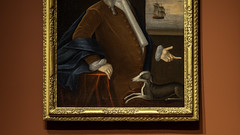

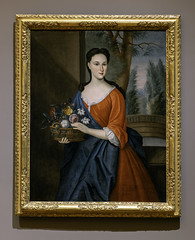
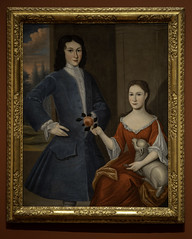

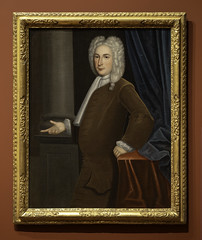
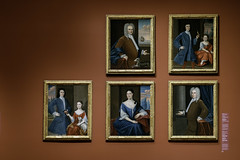
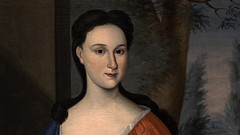
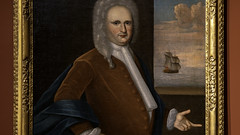
The triangle trade and the colonial table, sugar, tea, and slavery
Video \(\PageIndex{28}\): Covered sugar bowl, c. 1745, silver, 11.5 x 9.1 cm (Wadsworth Atheneum Museum of Art)
Benjamin West, The Death of General Wolfe
Benjamin West has always been a difficult artist to classify. American historians generally claim him as an American artist as he was born in what would become the state of Pennsylvania. West’s earliest paintings date from his fifteenth year, and if his own attempts at myth making are to be believed—they should be taken with the proverbial grain of salt—he was mostly self taught.

In 1760, two wealthy Philadelphian families paid for the young artist’s passage to Italy so he could learn from the great European artistic tradition. He was only 21 years old. He arrived in the port of Livorno during the middle of April and was in Rome no later than 10 July. West remained in Italy for several years and moved to London in August of 1763. He found quick success in England and was a founding member of the Royal Academy of Art when it was established in 1768. West was clearly intoxicated by the cosmopolitan London and never returned to his native Pennsylvania. West’s fame and importance today rest on two important areas:
West as teacher
West taught two successive generations of American artists. All of these men traveled to his London studio and the most returned to the United States. Indeed, a list of those who searched out his instruction comprises a “who’s who” list of early American artists and includes names such as Charles Willson Peale, Gilbert Stuart, John Trumbull, Thomas Sully, and Samuel F. B. Morse.
West as history painter
If his role as a teacher was the first avenue to West’s fame, surely his history painting is the second. Of the many he completed, The Death of General Wolfe (1770) is certainly the most celebrated.

In this painting, West departed from conventions in two important regards. Generally, history paintings were reserved for narratives from the Bible or stories from the classical past. Instead, however, West depicted a near-contemporary event, one that occurred only seven years before. The Death of General Wolfe depicts an event from the Seven Years’ War (known as the French and Indian War in North America), the moment when Major-General James Wolfe was mortally wounded on the Plains of Abraham outside Quebec.
Secondly, many—including Sir Joshua Reynolds and West’s patron, Archbishop Drummond—strongly urged West to avoid painting Wolfe and others in modern costume, which was thought to detract from the timeless heroism of the event. They urged him to instead paint the figures wearing togas. West refused, writing, “the same truth that guides the pen of the historian should govern the pencil [paintbrush] of the artist.”

Artistic license
Yet despite West’s interest in “truth,” there is little to be found in The Death of General Wolfe. Without doubt, the dying General Wolfe is the focus of the composition. West paints Wolfe lying down at the moment of his death wearing the red uniform of a British officer. A circle of identifiable men attend to their dying commander. Historians know that only one—Lieutenant Henry Browne, who holds the British flag above Wolfe—was present at the General’s death.
Clearly, West took artistic license in creating a dramatic composition, from the theatrical clouds to the messenger approaching on the left side of the painting to announce the British victory over the Marquis de Montcalm and his French army in this decisive battle. Previous artists, such as James Barry, painted this same event in a more documentary, true-to-life style. In contrast, West deliberately painted this composition as a dramatic blockbuster.

This sense of spectacle is also enhanced by other elements, and West was keenly interested in giving his viewers a unique view of this North American scene. This was partly achieved through landscape and architecture. The St. Lawrence River appears on the right side of the composition and the steeple represents the cathedral in the city of Quebec. In addition to the landscape, West also depicts a tattooed Native American on the left side of the painting. Shown in what is now the universal pose of contemplation, the Native American firmly situates this as an event from the New World, making the composition all the more exciting to a largely English audience.
Wolfe as Christ
Perhaps most important is the way West portrayed the painting’s protagonist as Christ-like. West was clearly influenced by the innumerable images of the dead Christ in Lamentation and Depositions paintings that he would have seen during his time in Italy. This deliberate visual association between the dying General Wolfe and the dead Christ underscores the British officer’s admirable qualities. If Christ was innocent, pure, and died for a worthwhile cause—that is, the salvation of mankind—then Wolfe too was innocent, pure, and died for a worthwhile cause; the advancement of the British position in North America. Indeed, West transforms Wolfe from a simple war hero to a deified martyr for the British cause. This message was further enhanced by the thousands of engravings that soon flooded the art market, both in England and abroad.

Historical significance
Benjamin West’s The Death of General Wolfe justifiably retains a position as a landmark painting in the history of American art. In it, West reinterprets the rules of what a history painting could be—both in regard to period depicted and the attire the figures wore—and at the same time followed a visual language that would have been familiar to its eighteenth-century audience. This composition set the stage for the many ‘contemporary’ history paintings that John Singleton Copley and John Trumbull painted throughout the rest of the eighteenth century.
Additional resources:
This painting in the National Gallery of Canada
Benjamin West, Penn’s Treaty with the Indians
Video \(\PageIndex{29}\): Benjamin West, Penn’s Treaty with the Indians, 1771-72, oil on canvas, 191.8 x 273.7 cm (Pennsylvania Academy of the Fine Arts), A Seeing America video
A conversation with Monica Zimmerman. Vice President of Public Education and Engagement, Pennsylvania Academy of the Fine Arts and Beth Harris
Additional resources
SmartHistory images for teaching and learning:
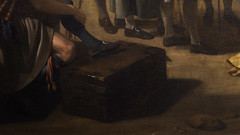
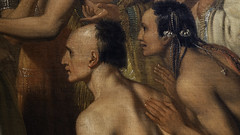

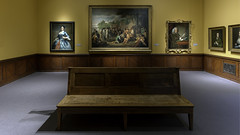
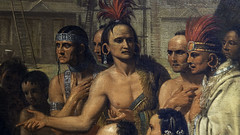
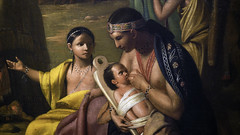
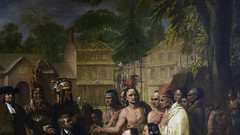

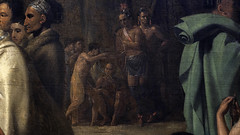
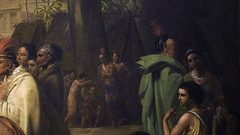

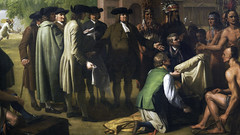


John Singleton Copley, A Boy with a Flying Squirrel (Henry Pelham)
Video \(\PageIndex{30}\): John Singleton Copley, A Boy with a Flying Squirrel (Henry Pelham), 1765, 77.15 x 63.82 cm (30-3/8 x 25-1/8 inches) (Museum of Fine Arts, Boston)

Some background
John Singleton Copley is commonly considered the greatest portrait painter in the history of the American colonies, and yet despite this sterling reputation, his life began at somewhat of a disadvantage. He was born in Boston to Richard and Mary, who presumably had recently emigrated from Ireland. Copley’s father, a tobacco merchant, died around the time of his son’s birth, leaving Mary a widow and suddenly in charge of the tobacco business. She must have been a shrewd businessperson, however, for ten years later, on 12 July 1748, she ran an advertisement in the Boston Gazette promoting her tobacco shop:
Mrs. Mary Pelham, (formerly the Widow Copley, on the Lang Wharf, Tabacconist) is remov’d into Lindel’s Row, against the Quaker’s Meeting House, near the upper End of King Street, Boston, where she continues to sell the best Virginia Tobacco, Cut, Pigtail and spun, of all Sorts, by Wholesale or Retail, at the cheapest Rates.
Interestingly, the man Mary Copley married was Peter Pelham, a London-trained engraver who specialized in mezzotints. Pelham emigrated from England to Boston around 1728, an arrival that roughly coincided with that of the portraitist John Smibert whose own entry into Boston was during the following year. For some years, Pelham engraved the portraits that Smibert had painted. In addition to his own art, Pelham also owned an extensive print collection from his time working in London. This was the environment in which the young John Singleton Copley lived; a home that was as filled with paintings and engravings as one could find in colonial Boston during the first half of the eighteenth century. What is mezzotint?
Painting portraits
Like Smibert before him, Copley’s painting output while in Boston (and, more broadly, when he traveled to New York City, too) consisted almost exclusively of portraits, for this was the only kind of painting for which there was a market in the American colonies. Early on, Copley based his compositions on the late-seventeenth and early-eighteenth-century British engravings he likely saw in his stepfather’s print collection. His 1760 portrait of Epes Sargent is but one example (below, right). Sargent leans to his right, his elbow resting on a circular plinth. This same pose and plinth can be seen in an engraving Peter Pelham made in 1726 after an earlier Hans Hysing portrait of the architect James Gibbs. Much like one today might flip through a fashion magazine to search out a new outfit or hairstyle, Copley was utilizing preexisting compositions for his Bostonian clients.

To be certain, Boston was as lively as a colonial city as there was during the middle of the eighteenth century, and as such, it had become the home to several prominent portraitists. John Smibert and Robert Feke had been active there during the first half of the century, and by the time the 1750s had arrived, Joseph Badger and Joseph Blackburn were also actively accepting portrait commissions. Unfortunately for these two artists, the 1750s also announced the arrival of John Singleton Copley, teenage portrait painter. In short order, both Badger and Blackburn found themselves in sincere want for work. Blackburn left Boston in 1758 for Portsmouth, New Hampshire, and Badger’s artist output slowed to a trickle before his death in Boston in May of 1765.
A brief comparison of roughly contemporary portraits by Badger, Blackburn, and Copley easily explains why Copley quickly found himself atop the Boston portraiture world. Badger’s portrait of John Haskins (1759) and Blackburn’s likeness of Colonel Theodore Atkins (1760) are competently painted images, and are as good of a portrait as one was likely to have seen in Boston by any artist other than Smibert, a painter with the prestigious pedigree of European training. The faces are somber, and more stiff than lively. Their bodies appear heavily cloaked by the clothing they wear, and there is no real sense that an actual body exists underneath these garments. In short, they are competent, yet uninspired.

To compare these two portraits with one Copley painted in 1758—that of Mary and Elizabeth Royall (below)—is to understand why Copley so quickly put other portraitists out of business. These young daughters of Isaac Royall (a much younger Mary can be seen in Robert Feke’s 1741 portrait of Isaac Royall and Family—more info about the family here) wear shimmering velvet gowns, Copley has painted their faces to show not only what they looked like, but to display a sense of their personality, too. Mary displays a hummingbird that is perched on her finger, while the younger Elizabeth pets a King Charles spaniel. Their gowns, the curtain and column in the background, and the inclusion of rare (a hummingbird) and royal (the King Charles spaniel) animals makes this a compositionally daring and visually interesting image. And Copley was then only 20 years old.

Boy with a Squirrel
As Copley matured as an artist, however, he became even more compositionally inventive. A great example of this is an early masterpiece, Boy with a Squirrel, a portrait of the artist’s half-brother, Henry Pelham. While it is, of course, a portrait, it would be more accurate to consider this painting as a tangible demonstration of the artist’s skill. Indeed, from the beginning, Copley intended this painting not for a wall in a Boston parlor, but instead for the wall of a London exhibition space. It is, as such, as much about what Copley could do as an artist as it is about the likeness of Henry Pelham.

And yet, what a portrait! Copley has painted Pelham in profile—something exceedingly rare in his pre-London oeuvre. He looks to left side of the composition as if dreamily lost in thought. The first thing a viewer might notice is that Copley has beautifully framed his half-brother’s face in front of a vibrant red curtain. Pelham wears a dark frock coat that is embellished with a pink satin collar. The yellow vest underneath his coat largely obscures his white shirt, although the collar and cuffs brilliantly contrast with the pink and dark blue of his coat. Copley has taken particular care to show the play of light and shadow across these garments. Note the ruffles in his cuffs, the ripples across his pink collar, and the shadows underneath the vest’s buttonholes. Clearly Copley was pulling out all of the artistic stops for this composition.

But it is not only the likeness that shows Copley’s interest in creating a showstopper. If the viewer’s eye begins at Pelham’s face and then moves downward along his right shoulder and arm, they would next notice Pelham’s brightly illuminated (particularly against the dark base of the column) right hand that delicately holds a meticulously painted gold chain. Pelham grasps it between his thumb and index finger, and it runs atop his hand, falling to the underside of his palm, and then is delicately laid atop his pinky. The oval of the end of the chain mirrors the ovals present in the glass of water underneath his hand. And this gold chain leads the eyes rightward towards a pet flying squirrel that nibbles on the meat of a recently cracked nut.

Copley has taken particular care in the painting of this small mammal: large obsidian eyes, dark whiskers, grey and black topside with a snowy-white belly and a bushy tail. The most impressive element in this painting, however, may be the beautifully rendered and highly polished mahogany table. In some ways, this piece of furniture serves as a vehicle for Copley to demonstrate his ability to paint reflections of material objects. Reflections of the glass of water, the cracked nut, the squirrel’s belly, and Pelham’s white cuffs can all be seen on the polished tabletop. These elements—chain, glass, squirrel, table—make Boy with a Squirrel as much about things in the painting as it is about the person depicted within it.

Sent to London for feedback
The portrait was sent to London for the 1766 exhibition of the Society of Artists. Copley received feedback from his contemporary expatriate Benjamin West and Sir Joshua Reynolds, perhaps the most authoritative voices on British art at the time. Captain R.G. Bruce, Copley’s friend, took Boy with a Squirrel to London and returned with Reynolds’s assessment: “in any Collection of Painting it will pass for an excellent Picture, but considering the Disadvantages…you had labored under, that it was a very wonderfull Performance.” The “disadvantages” to which Reynolds refers to are likely those that involve Copley’s location (Boston, the very fringe of the British empire) and his opportunity for formal artistic instruction there (none).
West agreed when he wrote to Copley on 4 August 1766. In his particular brand of creative spelling, West wrote, “while it was Excibited to View the Criticizems was, that at first Sight the Pictures struck the Eye as being to liney, which was judgd to have arose from there being so much neetness in the lines, which indeed as fare as I was Capable of judgeing was some what the Case.”
Although somewhat critical of Copley’s work, West was clearly impressed, and encouraged his colonial counterpart to send a composition to the Society of Artist’s April 1767 exhibition. “I advise you to Paint a Picture of a half figure or two in one Piec, of a Boy and Girle, or any other subject you may fancy,” West wrote. “And be shure take your subjects from Nature as you did in your last Piec…let it be Painted in oil.” West ended his letter by informing Copley that a three or four year visit to Europe studying the Old Masters would greatly improve his skill. In closing, West, ever the giving teacher, offered his mentorship, something for which his fame still rests today: “if ever you should make a viset to Europe you may depend on my friendship in eny way thats in my Power to Sarve.”
A move to London?
Prior to 1766, Copley must have wondered if he had the talent and skill to move to London and become a successful portraitist. By the close of that year, the positive feedback that he had received from both Sir Joshua Reynolds and Benjamin West—the current and future presidents of the Royal Academy of Arts—must have put the painter at ease. Rather than wondering if he could make it in London, Copley instead was forced to ponder if it would be financially prudent to relocate to the other side of the Atlantic Ocean, as he was becoming increasingly more wealthy painting in Boston. Copley did eventually move to London to seek future fortunes, but it was the brewing political turmoil that brought about this change in location as much as any desire to increase his finances. This was still eight years away in 1766. Until 1774 when he departed, Copley continued to paint the social and economic elite in colonial Boston: lawyers, merchants, politicians, and even an accomplished silversmith.
Additional resources:
Copley’s A Boy with a Flying Squirrel (Henry Pelham), at the Museum of Fine Arts, Boston
Copley’s Mary and Elizabeth Royall at the Museum of Fine Arts, Boston
Badger’s Portrait of John Haskins at the Brooklyn Museum
Blackburn’s Colonel Theodore Atkinson at the Worcester Art Museum
Copley on The Metropoltian Museum of Art’s Heilbrunn Timeline of Art History
SmartHistory images for teaching and learning:

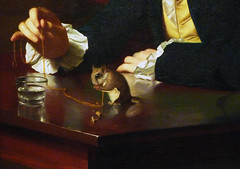
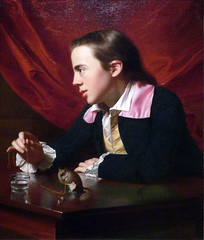
John Singleton Copley, Portrait of Mr. and Mrs. Thomas Mifflin (Sarah Morris)
Video \(\PageIndex{31}\): John Singleton Copley, Portrait of Mr. and Mrs. Thomas Mifflin (Sarah Morris), 1773, oil on ticking, 156.5 × 121.9 cm (Philadelphia Museum of Art). A conversation with Dr. Kathleen A. Foster, The Robert L. McNeil, Jr., Senior Curator of American Art, and Director, Center for American Art, Philadelphia Museum of Art, and Dr. Beth Harris
A Seeing America video
John Singleton Copley, Paul Revere
The fame of Paul Revere
Listen, my children, and you shall hear
Of the midnight ride of Paul Revere,
On the eighteenth of April in Seventy-Five;
Hardly a man is now alive
Who remembers that famous day and year.
He said to his friend, –“If the British march
By land or sea from the town to-night,
Hang a lantern aloft in the belfry-arch
Of the North-Church-tower, as a signal-light—
One if by land and two if by sea;
And I on the opposite shore will be,
Ready to ride and spread the alarm
Through every Middlesex village and farm,
For the country-folk to be up and to arm.
—Henry Wadsworth Longfellow
Thus begins Henry Wadsworth Longfellow’s famous poem “Paul Revere’s Ride,” a work that was first published in the January 1861 issue of The Atlantic Monthly. Although Paul Revere is now famous as one of the Massachusetts Minutemen—a local militia who would defend the colony against the British army at a moment’s notice—he was hardly a public figure during his own lifetime. History tells us that he did ride from Boston’s Old North Church to warn of the approach of the British, but he was never elected to public office and he was only tangentially involved with Revolutionary politics. Indeed, Revere’s limited fame in his own day stems from his considerable talents as a silversmith. His fame during the second half of the nineteenth century comes from his appearance in Longfellow’s poem. Revere’s fame today, however, can be attributed—in part at least—to the remarkable portrait John Singleton Copley painted of the artisan in 1768.
Copley’s beginnings
Copley had extensive access to early eighteenth century prints, and he often incorporated poses and clothing from older images into his portraits of Bostonians (his mother married Peter Pelham, an engraver who specialized in mezzotints after his father died). At the age of 15, for example, Copley painted the portrait of Mrs. Joseph Mann (Bethia Torrey). Her pose—holding a sting of pearls—and attire of a scoop-neckline dress with white trim—were directly taken from a mezzotint of Princess Anne. In today’s world, we might look at such “borrowing” as a kind of visual plagiarism. But this was the vein in which eighteenth-century artists worked and learned. It was expected that one could become great through the attentive copying of the Old Masters.


As Copley matured as an artist, however, he became more compositionally inventive. A great example of this is an early masterpiece, Boy with a Squirrel, a portrait of the artist’s half-brother, Henry Pelham. Copley sent this portrait to London for the 1766 exhibition of the Society of Artists. Copley received feedback from his contemporary expatriate Benjamin West and Sir Joshua Reynolds—perhaps the most authoritative voice on British art at the time. Captain R.G. Bruce, Copley’s friend, took Boy with a Squirrel to London and returned with Reynolds’s assessment: “in any Collection of Painting it will pass for an excellent Picture, but considering the Disadvantages…you had labored under, that it was a very wonderfull Performance.” The “disadvantages” to which Reynolds refers to are likely those that involve Copley’s location (Boston, the very fringe of the British empire) and his opportunity for formal artistic instruction there (none).

And yet despite these disadvantages (although some scholars of American art believe that it was because of them), Copley quickly became the most sought after portrait painter in the colonies. By the middle of the 1760s, he was painting the economic and political elite of his city, and had become a rather wealthy man himself. Before the 1760s were done, Copley had married into a wealthy family and had purchased a 20-acre farm with three houses on it. This estate placed Copley next door to John Hancock, one of the wealthiest merchants in Boston (and future president of the Continental Congress and governor of Massachusetts) when Copley painted him in 1765 (left).
But it was not only the wealthy and political elite who Copley painted. Indeed, during a politically tumultuous time, Copley painted both sides of this vitriolic divide, both Whigs (those in favor of a break with Great Britain) and Tories (those who wished to remain a part of the Empire).
It seems that Copley’s only requisite was that the sitter had the finances to pay for the likeness. It is also possible that Copley would paint a sitter for exchange for past or future goods or services. Paul Revere, a silversmith with modest if not affluent means, might just be one such case.
The portrait of Paul Revere
Copley’s portrait of Paul Revere is striking in many ways. To begin, Revere sits behind a high polished wooden table. Rather than wear his “Sunday’s Best” clothing, as sitters for portraits (and elementary school pictures) so commonly did (and still do), Revere instead wears simple working attire, a decision that underscores his artisan, middle-class status. His open collared shirt is made from plain white linen, and the lack of cravat—a kind of formal neckwear—lends to the informal nature of the portrait. What looks to be an undershirt peeks from underneath his linen shirt, and a wool (or perhaps a dull silk) waistcoat is likewise unbuttoned (although decorated with two gold buttons, features that were not likely present in Revere’s work vest). He does not wear a jacket or coat, and even his wig—something almost every male would have worn if they could to afford to do so—is missing. We can compare what Revere wears to men’s attire from the twenty-first century. Imagine a man wearing a three-piece suit (blazer, vest, buttoned white dress shirt, and a tie). If you were to remove the jacket and tie and unbutton the shirt and vest, you would have an idea of the informality present in Copley’s eighteenth-century portrait of Revere.

Indeed, comparing Copley’s portrait of the silversmith with that of Copley’s neighbor, John Hancock, makes the differences all the more obvious. Both seem to be at work in some ways—Revere on his teapot and Hancock at his ledger—but there the similarities end. Even though Hancock is not dressed as ostentatiously as he could have been, he still wears a dark blue coat that is embellished and trimmed with golden braid and buttons. White cuffs extend beyond his sleeves, and a silken cravat is tied around his neck. His breeches have golden buckles and silk stockings cover his lower legs. A modest powered wig sits upon his head. This modest attire—modest for Hancock, at least—demonstrates the uniqueness of Copley painting Revere while wearing what amounts to working clothes. Indeed, this is the only completed portrait Copley painted of an artisan wearing less than formal attire.

But it is not only what Revere is wearing, it is also what he is doing. The sitter looks at the viewer, as if we have momentarily distracted him from his work. The edge of the table in the foreground suggests that the table he sits behind is parallel to the picture plane. Few would claim that this table is his workbench, for the surface is far too polished and pristine to have been used in the daily activity of his trade. The surface of the table reflects Revere’s white shirt, and the tools in front of him, his engraver’s burins. With his right hand, Revere seems to support his head—and as a corollary, his brain—the source of his artistic ingenuity. His left hand holds the product of that mind, a nearly completed silver teapot, a vessel that has been polished to such a high sheen that Revere’s hand beautifully reflects on its surface.

As a silversmith, Revere made many kinds of objects; spoons, bowls, shoe buckles, dentistry tools, beer tankards, creamers, coffee pots, and sugar tongs. That he should be shown with a teapot was an overtly political decision. By the end of the 1760s, Great Britain was nearing financial ruin after the conclusion of the Seven Years’ War (the North American component of this conflict is called the French and Indian War; the most famous depiction of this war is Benjamin West’s 1770 painting The Death of General Wolfe). In order to increase the revenue in the crown’s coffers in 1767 the British Parliament passed the Townshend Acts, which placed a tax on the colonials’ use of tea (among other imported goods). Paul Revere was clearly engaged in this political issue, for his signature appears on an October 1767 Non-importation agreement. Clearly tea was becoming a politicizing good and it is interesting that Revere chose to be shown holding an object so tied to a commodity that became a divisive symbol. Indeed, this political thread reached a climax with the so-called Boston Tea Party on 16 December 1773 when a collection of colonials—some disguised as Native Americas—raided a merchant vessel in Boston Harbor and threw the tea overboard. Interestingly, the owner of that boat was Richard Clarke, John Singleton Copley’s father-in-law.
Copley, Revere and the Boston Massacre
One other facet of the portrait of Paul Revere is worth exploring, that of its date of completion, for the artist seldom dated or signed his portraits. Copley and Revere had been acquainted since at least 1763 when Revere’s account book notes that Copley had ordered a gold bracelet. Revere also subsequently made sliver frames for Copley’s miniature portraits, and it has been suggested that this portrait might have served as a kind of payment from Copley to Revere for past services rendered and goods received. Clearly, Revere and Copley had a professional relationship. However, this relationship did not likely extend beyond the first half of 1770.
One of the most pivotal movements leading up to the American Revolutionary War was the so-called Boston Massacre. On 5 March 1770, a group of British soldiers fired at an unarmed group of protesters who were throwing snowballs (loaded with rocks) and other objects at the infantrymen. The crowd also repeatedly yelled “Fire!” at Captain Preston, the commanding officer on duty, daring him to order his soldiers to fire their muskets into the crowd. Eventually, the British army obliged their tormentors; five men were mortally wounded and another six were wounded. The soldiers were arrested and stood trial, accused of murder. Their lawyer was future President John Adams, achieved six acquittals and two reduced charges of manslaughter.
This event was instantly politically divisive, and both Whigs and Tories began to use visual propaganda as a way to bring those who were neutral in regards to declaring independence from Great Britain onto their side. In short time, Henry Pelham, Copley’s half-brother completed one such attempt at depicting the events of the Boston Massacre. Pelham finished his engraving immediately following the events of 5 March and then lent a copy to Paul Revere. The silversmith, who had been engraving political cartoons since at least 1765, and ever the entrepreneur, then faithfully copied Pelham’s print and placed an advertisement for its sale no later than 26 March, just three weeks after the event and a week prior to Pelham’s own print being available for purchase.
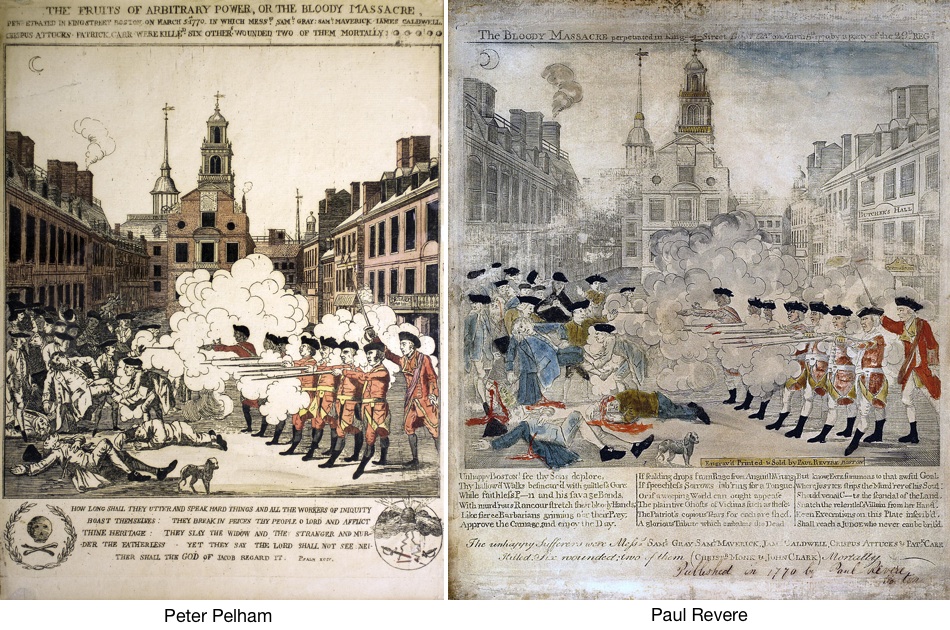
When seen side by side, it is clear that Revere plagiarized Pelham’s then unpublished work; the same arrangement of dead and injured bodies on the left, the same organization of the British soldiers on right, the same dog, the same framing architecture. Although the crescent moon is placed in the same part of the print—the upper left-hand corner—the biggest difference between these two images could be that Pelham’s moon is open on its right side whereas Revere’s is open to the left. This egregious affront against a family member likely brought an end to John Singleton Copley’s relationship with Paul Revere.
It is ironic that Revere is most known today because of Longfellow’s poem, a work that does not mention his more famous artisanal career. Copley’s portrait of the silversmith, likewise as famous, was hidden in a descendant’s attic for most of the nineteenth century and was not publicly displayed until 1928. Since that time, however, the image has contributed to the sitter’s prestige, and the sitter’s fame has likewise contributed to the painting’s fame.
Additional resources:
Copley’s Paul Revere at the Museum of Fine Arts, Boston
Copley’s Boy with a Flying Squirrel at the Museum of Fine Arts, Boston
Copley’s Epes Sargent at the National Gallery of Art
Biography of Copley from the Worcester Art Museum
The Boston Massacre from the Gilder Lehrmann Institute of American History
SmartHistory images for teaching and learning:
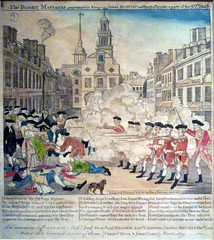
John Singleton Copley, The Copley Family
Invitations to visit Europe
By the time the 1770s arrived, John Singleton Copley was the undisputed king of portraiture in the American colonies. Yet despite this fact, he had longed to visit the Old World, and he had, in fact, received much encouragement to permanently move to London. Copley’s early masterwork Boy with a Squirrel, a portrait of his half brother Henry Pelham, had been shown at the 1766 Society of Artists exhibition. Many artists, particularly Benjamin West and Sir Joshua Reynolds, had been suitably impressed with the artistic virtuosity of the New World wunderkind. West, himself a colonial, wrote to Copley on 4 August 1766 to encourage him embark on a Grand Tour of Europe. With his creative spelling, West urged Copley to make a “viset to Europe for this Porpase for three or four years, you would find yourself then in Possession of what will be highly valuable” (this and all quotes use the 18th century spelling).
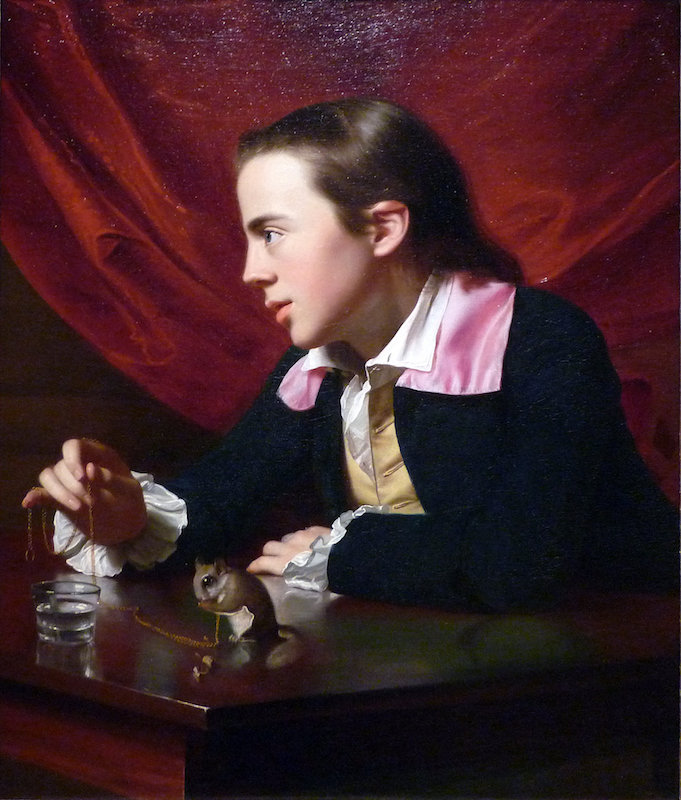
Copley, ever the prudent businessman, was seldom rash or spontaneous. Although West provided rather constant motivation, Copley remained unconvinced that he would have a more affluent life in London than the one he then had in Boston. On 17 June 1768, for example, Copley wrote to the West that, “I should be glad to go to Europe, but cannot think of it without a very good prospect of doing as well there as I can here. You are sensable that 300 Guineas a Year, which is my present income, is a pretty living in America.” Copley continued in this letter to make it clear that he had family obligations to consider: “And what ever my ambition may be to excel in our noble Art, I cannot think of doing it at the expence of not only my own happyness, but that of a Tender Mother and a Young Brother whose dependance is intirely upon me.”
Several years later—in January 1772—John Trumbull, the future painter of the Declaration of Independence, was travelling from his home in Connecticut to Cambridge, Massachusetts in order to enroll at Harvard College. Although Trumbull wanted to be an artist, his father, the former governor of Connecticut, wished for his son to receive a college education and to pursue a more socially prestigious vocation. Although Trumbull was unenthusiastic about the prospect of being a college student, he was excited about visiting Copley, an encounter made possible through a mutual friend. Writing his autobiography nearly fifty years later, Trumbull still recalled this first brush—get it? Brush!—with artistic fame:
We found Mr. Copley dressed to receive a party of friends at dinner. I remember his dress and appearance—an elegant looking man, dressed in a fine maroon cloth, with gilt buttons—this was dazzling to my unpracticed eye! —but his paintings, the first I had ever seen deserving the name, riveted, absorbed my attention, and renewed all my desire to enter upon such a pursuit.
Copley leaves for London (as political tensions rise) and goes on the Grand Tour
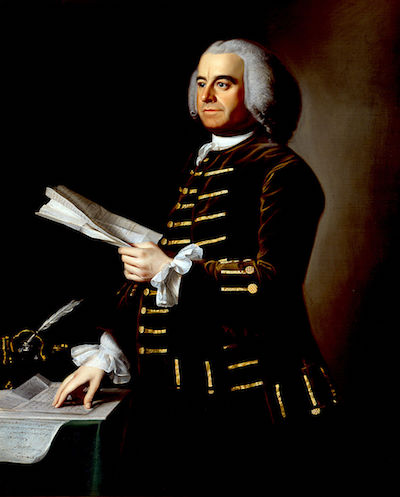
In a city—Boston—that was becoming increasingly more divided between the Tories and the Whigs (those who preferred loyalty to Britain and those who wished for independence, respectively), Copley remained as apolitical as he could. Indeed, a look at his Boston patronage indicates that he painted sitters on both sides of the growing vitriolic political divide.
But as the 1770s progressed, Copley’s life became more and more uncomfortable. Most of his wife’s family were strident Loyalists. His father-in-law Richard Clarke, for example, was the owner of the tea that provoked the Boston Tea Party on 16 December 1773. Several months later—April of 1774—an angry mob arrived at Copley’s home looking for Colonel George Watson, a Tory lawyer Copley had painted in 1768.
This unruly event frightened Copley and helped him realize that the political climate was beginning to get out of hand. “What a spirit!” Copley wrote on 26 April. “What if Mr. Watson had stayed (as I pressed him to) to spend the night. I must either have given up a friend to the insult of a Mob or had my house pulled down and perhaps my family murthered.” Fearful for his own safety, Copley sailed for London in June 1774, just seven weeks later. His family—wife, children, mother, and half-brothers—remained in Boston.
Copley’s passage across the Atlantic lasted until the second week of July, and he wasted little time in visiting Benjamin West, Joshua Reynolds, and the Royal Academy of Art. After some time in London, Copley began his continental Grand Tour, an eighteenth-century staple of art education for an aspiring painter. He first visited Paris—writing to his wife on 2 September—then made his way to Rome via Genoa. Copley arrived in Rome on 26 October and spent the next seven months viewing art and architecture and copying the Old Masters. He also made several side trips to Naples, Pompeii, Herculaneum, and Paestum.
A letter Copley wrote to his mother from Parma on 25 June 1775 states that he had finally left Rome for London on 4 June 1775; he had already visited Florence on his way north. Still in Parma on 22 August, Copley wrote a lengthy letter to his half-brother and stated that, “I propose going from this [Parma] to Venice and through the Tirole, Germany, and Flanders, which is the shortest way to England and a different Rout from that I took in coming to Italy. I shall not return to Parris as I intended.”
In just fifteen months—that is from his departure from Boston to his return to London from the continent in October 1775—Copley had received nothing short of an art education unavailable to anyone in North America. He was primed to open a painting studio in London. By the time he returned to London, his wife and three of their (then) four children were awaiting his return (the youngest, Clarke Copley, born in 1775, did not travel with the rest of the family and died the following year). Copley thusly flipped the page to a new chapter—the English Chapter—in his professional life.
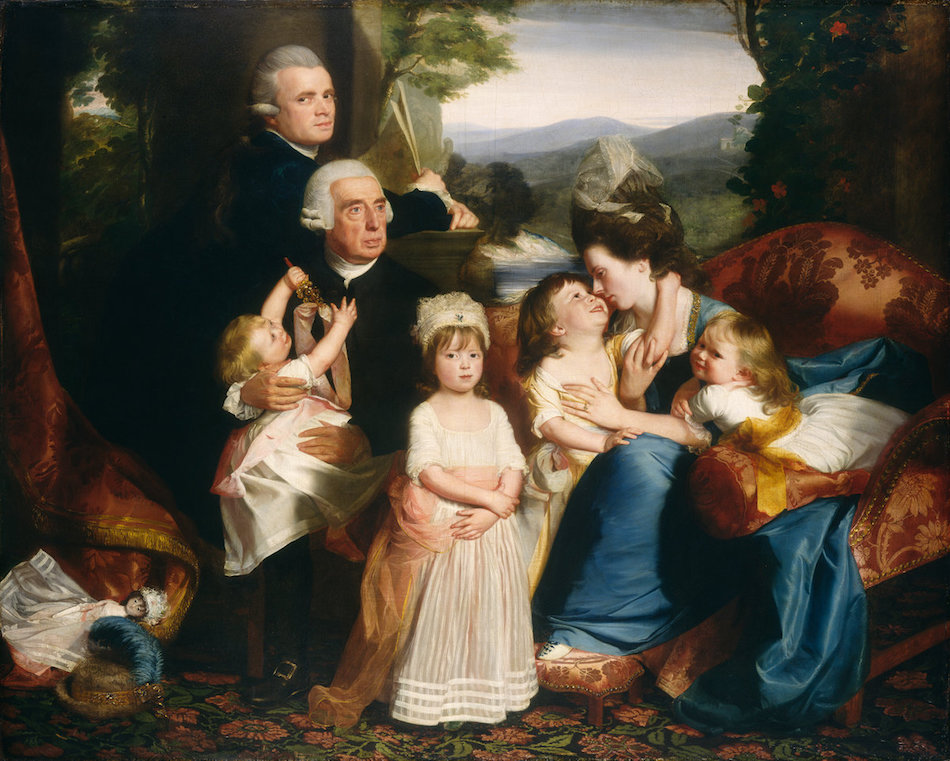
The Copley Family
Copley painted an immense group portrait, The Copley Family, in order to celebrate—and announce—this new chapter in his professional development. This painting accomplished several independent goals at the same time. To begin, it serves as a kind of visual testament to his love and devotion to his family. During their nearly 15 months apart, Copley’s correspondence—primarily to his own mother, his half-brother Henry, and his wife Suzanna who he affectionately referred to as Sukey—is filled with references to both missing his family and his fear for their safety in the increasingly tenuous city of Boston. Writing from Lyon on 15-16 September 1774, for example, Copley stated, “I am very Ancious for you, my Dear, and our Children, for I know not what state you are in, in Boston; but I pray God to preserve you and them.” In closing, he sends affectionate tidings: “give my blessing to my Dear Babys, and a thousand Kisses. tell my Dear Betsey not to forget he[r] Papa.”
The Copley Family shows the six members of the artist’s clan as it existed at the beginning of 1777. Copley has shown three adults—the artist, his wife, and her father—and his four children. As was typical with group portraits that included a self-portrait—see Raphael in The School of Athens and Smibert’s self representation in The Bermuda Group, both of which Copley would have seen—the artist looks directly at the viewer, a look of inquisitiveness on his visage. He holds a set of drawings and leans on a classical plinth. His father-in-law, Richard Clarke, looks to the viewer’s right, seemingly unaware that the youngest daughter, Susanna, is attempting to climb onto his lap. Sukey, shown in profile, lovingly nuzzles John Singleton, Jr., their only son, while Mary, on the far right, attempts to capture her mother’s attention. The only other sitter who seems alerted to the viewer is the oldest, Elizabeth, who stands seemingly unaware of the happenings behind her.
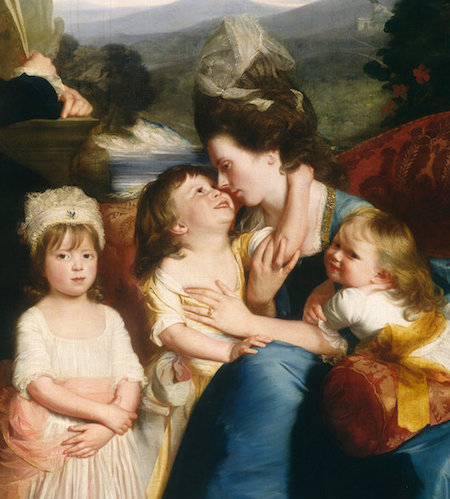
Although Clarke seems more aloof than loving, the rest of the participants in this stage-like setting seem to express tenderness and love for one another. Children play and vie for motherly affection. Sukey plays the maternal role of a loving and tender parent. Elizabeth, the oldest, suspiciously stares at the viewer as if facing a stranger. Copley demonstrates—as he had so consistently in Boston—a keen ability to paint psychologically rich and complex compositions. These are not only accurate likenesses of those who he most loved. Indeed, Copley is able to tell us, through visual means, a bit about who they are.
However, this portrait was not only intended to accurately record who the Copley family was and what the Copley family looked like at a particular moment in time. Instead, Copley completed this work as a way of both advertising his talents and abilities as a painter, but also to announce his family’s formal arrival into fashionable London society. Copley and his wife wear clothing then at the height of fashion, and this attire, in addition to the drapery on the left of the painting and the extravagant furniture and beautifully rendered carpet, dually speaks to the artist’s affluent wealth and his ability at painting fabrics. The drawing he holds, the vase behind his hands—identified as a copy of the Medici Vase Copley would have seen in the Uffizi while in Florence—and the Italianate landscape in the distance that appears as if borrowed from a Raphael Madonna and Child painting all proclaim his Grand Tour pedigree.
Available for hire
In size (6’ x 7.5’), composition, and in artistic references, Copley intended for this group portrait to eloquently advertise that his newly arrived services were available for hire to the London portrait-seeking public. Copley exhibited this work at the 1777 Royal Academy show to nearly universal acclaim. In a career that would extend for almost another forty years, this painting is the only one he formally exhibited with his own likeness within it. Clearly, the work is not only about what it is, but also who made it. The artist achieved his goal. One critic remarked, “Mr. Copley, from the size of his family piece, is likely to be as much the subject of observation in the rooms as any artist who has exhibited…” Years later, in 1792, Copley had achieved such fame that he was set to rival his former advocate, Benjamin West, for the presidency of the Royal Academy of Art. Between The Copley Family in 1777 and the end of his career, the artist shifted his attention from portraiture—which had been his only focus in the American colonies—to that of the more prestigious and ambitious history paintings.
Additional resources:
This painting at the National Gallery of Art
Copley at the National Gallery of Art
John Smibert’s The Bermuda Group at Yale University Art Gallery
Copley on The Metropolitan Museum of Art’s Heilbrunn Timeline of Art History
Portrait Painting in England on The Metropolitan Museum of Art’s Heilbrunn Timeline of Art History
SmartHistory images for teaching and learning:



Early Republic
John Trumbull, The Declaration of Independence
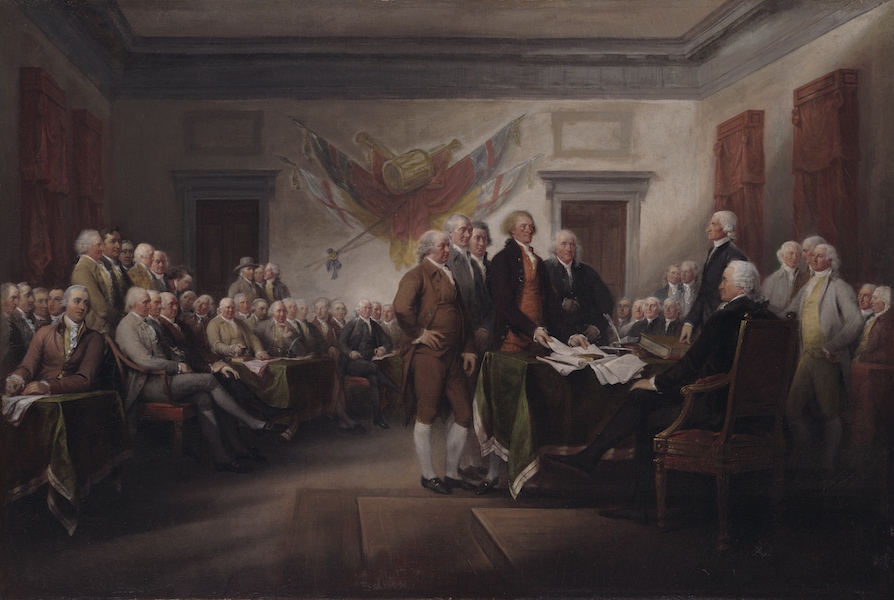
Like many artists of the early-Federal period (c. 1789-1801), the name John Trumbull is not one immediately recognized by most Americans. Yet despite this fact, the majority of Americans are well aware of many of Trumbull’s most famous paintings. Trumbull’s portrait of the first Secretary of the Treasury , Alexander Hamilton, has long graced the ten-dollar bill. Although Trumbull made a career as a portraitist, his real ambition lay in the painting of larger, more ambitious historical compositions. Without doubt, the one that is most frequently reproduced in elementary school history textbooks is The Declaration of Independence, a painting that exists in two versions. The first is smaller in size and is part of the Yale University Art Gallery (above) while the second is the monumental version currently on display in the Capitol Rotunda (below).
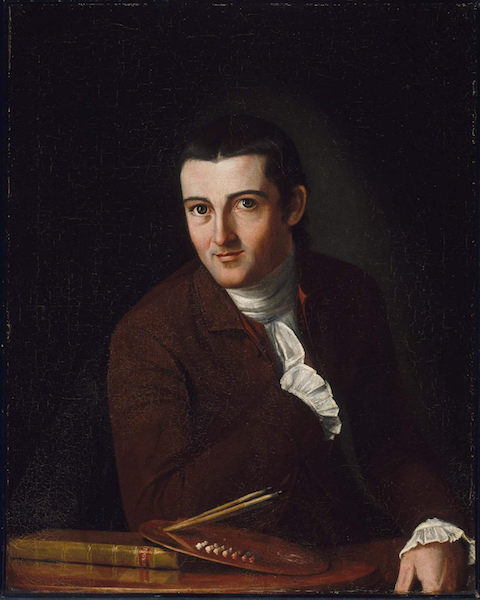
Family history
Yet to understand this composition, one must first grapple with Trumbull’s complicated history and personality. He was the sixth and youngest child of Jonathan Trumbull and Faith Robinson. If there was an aristocracy in colonial New England, Trumbull was born into it. His Harvard-educated father was a representative to the Connecticut General Assembly. Later he served as the Governor of Connecticut Colony (1769-1776) and then after the War of American Independence, as the Governor of the state of Connecticut (1776-1784). The artist’s mother was a direct descendant of John Robinson, the so-called “Pastor to the Pilgrim-Fathers” before they sailed on the Mayflower for the New World. Given his prestigious family legacy, Trumbull the Elder had little interest in allowing Trumbull the Younger to pursue a career as a painter. Instead, Governor Trumbull sent the artist-to-be to Harvard College so that his son could find a more useful vocation in either the law or the ministry.
However, in 1772, Trumbull made a social call to the artist John Singleton Copley who was then still in Boston—just a short distance from Cambridge. When writing his autobiography almost half a century later—in 1841—Trumbull still remembered this meeting with great clarity:
We found Mr. Copley dressed to receive a party of friends at dinner. I remember his dress and appearance—an elegant looking man, dressed in a fine maroon cloth, with gilt buttons—this was dazzling to my unpracticed eye!—but his paintings, the first I had ever seen deserving the name, riveted, absorbed my attention, and renewed all my desire to enter upon such a pursuit. But my destiny was fixed, and the next day I went to Cambridge, passed my examination in fro, and was readily admitted to the Junior class.
There was, of course, no art major at Harvard during the eighteenth century, so Trumbull studied art in his free time, copying and sketching works of art that hung on the college’s walls. He also learned from books he was able to borrow from the college’s library. He graduated in 1773 and became one of the few artists in the history of early American art to complete a college education.
The army
Trumbull’s graduation from Harvard took place during a tumultuous period in American history, and Trumbull wished to secure a commission as an officer in the Continental Army. His brother, Joseph, was the Commissary General of the Army, and likely suggested that his younger brother draw a plan of the British army’s position at Boston Neck to present to General Washington as a way of introduction. Shortly thereafter, Washington appointed Trumbull as an aide-de-camp (a confidential assistant to a senior officer). The following year, in the spring of 1776, Major General Horatio Gates appointed Trumbull deputy adjutant-general (military chief administrative officer) at the rank of Colonel. Alas, Trumbull resigned his commission less than a year later because of a minor squabble with Congress as to the date of the commission. Yet despite being Colonel John Trumbull for little more than a year, the artist carried the honorific title of Colonel for the remainder of his life. His 1841 autobiography, for example, was entitled—not immodestly—The Autobiography of Colonel John Trumbull.
However, it was because of his (admittedly, very limited) military experience that John Trumbull believed that he was uniquely qualified to pictorially depict the major events of the American Revolutionary War. His first step, was to seek out some artistic training, and in this endeavor, he followed in the footsteps of many artists before him (and, for that matter, after him): he sailed for London and Benjamin West’s studio (West was an American artist with a successful career in London). The year was 1780, and the War of Independence was still in full swing, although nearing its completion. It must have caused suspicion that a former officer in the Continental Army has arrived in London to study painting, particularly because Benjamin West, as the official history painter to the court, had the ear and confidence of King George.
Politics
In West’s studio, Trumbull met Gilbert Stuart, who was perhaps West’s most accomplished pupil. But Stuart and Trumbull differed in some key ways. First, Stuart always knew that portraiture would occupy most of his artistic efforts when he returned across the Atlantic Ocean, while Trumbull had the higher aspiration to paint historical compositions. More importantly, perhaps, Stuart largely kept his political beliefs during this vitriolic period to himself, while Trumbull—both in letters home and in his personal interactions about London—was decidedly anti-British. People began to notice, and on 20 November 1780, Colonel John Trumbull was arrested and charged with treason. He was imprisoned for more than 8 months and released only after powerful friends—Benjamin West and the statesman Edmund Burke among others—appealed to the Privy Council for the artist’s release. This was granted on 12 June 1781, and Trumbull was given 30 days to exit Great Britain.
Connecticut and back to London
Trumbull returned to Connecticut for two years, and during that time his father again attempted to convince him to pursue another more profitable vocation. Undeterred, Trumbull returned to London and the warmth of West’s studio in January of 1784. West set forth a rigorous course of study. Trumbull woke at five o’clock in the morning to study human anatomy. After breakfast several hours later, he painted for the rest of the day. His evening was capped by studying at the Royal Academy of Art. The aspiring artist made quick and steady progress. When writing to his brother Jonathan in September of 1784, for example, Trumbull remarked, “I have the pleasure to find that my labour is not in vain, & to hear Judges of the Art declare that I have made a more rapid progress in the few months I have been here than they have before known.”

The history of our country
Growing in confidence, Trumbull was determined to return to the newly formed United States with paintings that would commemorate the recent victory over Great Britain. Writing to his father—whose approval, it seems, he still sought—Trumbull explained in March of 1785,
the great object of my wishes…is to take up the History of Our Country, and paint the principal Events particular of the late War.
By the end of the year, Trumbull had already begun work on two paintings of the series, images known to generations of American elementary school students because of their inclusion in history textbooks: The Death of General Warren at the Battle of Bunker’s Hill, June 17, 1775 (above) and The Death of General Montgomery in the Attack on Quebec, December 31 1775 (below). In 1786, Trumbull began to plan three other Revolutionary War paintings: The Death of General Mercer at the Battle of Princeton, January 3, 1777, The Capture of the Hessians at Trenton, December 26, 1776, and The Surrender of Lord Cornwallis at Yorktown, October 19, 1781. Interestingly, all five of these compositions are, essentially, scenes of battlefields.

The Declaration of Independence
In July of 1786, however, Trumbull accepted Thomas Jefferson’s invitation to visit Paris, and he brought Bunker’s Hill and the Attack on Quebec with him. Jefferson, then the United States Ambassador to France, and a bit of artist himself, managed to convince Trumbull that he should turn his artistic talents towards a scene involving the Declaration of Independence. While in Paris, Trumbull began to sketch out the composition, taking into account Jefferson’s memory of the event and the [diplomat’s own sketch](http://artgallery.yale.edu/collections/objects/2805) of the Assembly Room in the Pennsylvania State House in Philadelphia where the Declaration of Independence was first presented to Congress and subsequently signed.

The painting that resulted from this collaboration between artist and politician has become one of the most famous images in the history of American art. It can be found on the back of the (seldom used) $2 bill, and has graced American postage stamps. And yet, what the painting depicts is often misunderstood. Trumbull himself called this painting The Declaration of Independence, July 4, 1776. However, this is inaccurate; this painting depicts not the signing of the document, but instead the presentation of a draft of it to Congress on 28 June 1776. Our attention begins with the five men standing in the middle of the painting, the so-called Committee of Five that was primarily responsible for the written document. They are—from left to right—John Adams of Massachusetts, Roger Sherman of Connecticut, Robert R. Livingston of New York, Thomas Jefferson of Virginia, and Benjamin Franklin of Pennsylvania. Clearly, the red-headed Jefferson is the most important, for he alone holds the document that he presents to John Hancock, the President of the Continental Congress, who sits behind the desk.

Of the five men standing, Trumbull was able to paint three of them—Adams, Jefferson, and Franklin—from life and directly onto the canvas prior to departing from Europe. When the artist returned to the United States in 1789, he spent several years traveling up and down the eastern seaboard so that he could paint portraits from life. This was not always possible, however, and in 1817—some 27 years later, Trumbull was still at work on what would become his most famous image. He wrote to Jefferson that year to inform the former president as to the progress he had made on this relatively small—21” x 31”—image:
The picture will contain Portraits of at least Forty Seven Members:—for the faithful resemblance of Thirty Six I am responsible, as they were done by myself from the Life, being all who survived in the year 1791. Of the Remainder, Nine are from Pictures done by others:—one Gen[era]l Whipple of New Hampshire is from Memory: and one Mr. Ben. Harrison of Virginia is from description, aided by memory.
To compare this image to those Trumbull began at the same time—the battle paintings of the Revolutionary War Series—is interesting, for while some of those are dynamic and filled with drama, The Declaration of Independence is, at its essence, a static—some might claim pictorially boring—image of a group of seated men looking at a group of standing men. Indeed, other artists—Jacques-Louis David comes to mind—were able to conceive a way to depict a similar event in a visually engaging way. David’s sketch for the Oath of the Tennis Court (below, depicting one of the first events of the French Revolution), for example, is far more dynamic and dramatic than is Trumbull’s painting.

But this seemed not to matter to Trumbull, nor did it bother many members of Congress, for on 17 January 1817 they approved—by an overwhelming 150-50 majority—a proposal to commission Trumbull to complete four paintings for the Great Rotunda of the as yet uncompleted Capitol Building. Increasing the size of The Declaration of Independence to 12’x18’ did little to enhance its dynamism. In 1828, for example, John Randolph of Virginia wrote,
the Declaration of Independence [ought] to be called the Shin-piece, for surely never was there before such a collection of legs submitted to the eyes of man.
Still others criticized the lack of accuracy in the room and furnishings, and, as importantly, as to who was actually present when the document was presented.
But these concerns were of little bother to Trumbull, who had become one of the most powerful voices—if not one of the more skilled paintbrushes—in American art during the first half of the nineteenth century. Indeed, Trumbull served as the President of the conservative American Academy of Fine Arts from 1817 until 1836. Without doubt, this position helped him receive the prestigious congressional commission in 1817 and allowed him to exert considerable influence over the direction of American art during the end of his career. Moreover, his autobiography—written just two years prior to his death—provided the opportunity to explain his (perhaps exaggerated) importance within American art. While the Declaration of Independence might not be the most interesting work within the history of American painting, it certainly is one of the most recognizable. Trumbull, no doubt, would approve of this.
Jean-Antoine Houdon, George Washington
An American hero sculpted by a foreigner

After the successful conclusion of the American Revolutionary War, many state governments turned to public art to commemorate the occasion. Given his critical role in both Virginia and the colonial cause, it is unsurprising that the Virginia General Assembly desired a statue of George Washington for display in a public space.
And so, in 1784, the Governor of Virginia asked Thomas Jefferson (another Virginian who was then in Paris as the American Minister to France) to select an appropriate artist to sculpt Washington. Seeking a European sculptor—and for Jefferson, whose Francophile sympathies were clear, preferably one who was French—was a logical decision given the lack of artistic talent then available in the United States. Through basic necessity, this portrait of an American hero needed to be made by a foreigner.
Jefferson knew just the artist for this task: Jean-Antoine Houdon. Trained at the Académie Royale de Peinture et de Sculpture and winner of the prestigious Prix de Rome in 1761 when only twenty years of age, Houdon was, by the middle of the 1780s, the most famous and accomplished Neoclassical sculptor in France.
Jefferson commissioned Houdon to complete a monumental statue of Washington. Given Houdon’s skill and ambition, the sculptor likely hoped to cast a larger-than-life-sized bronze statue of General Washington on horseback, a format appropriate for a victorious field commander. However, the final product, delivered more than a decade later, was a comparatively simple standing marble.
Evidence suggests that Houdon was supposed to remain in Paris and sculpt Washington from a drawing by Charles Willson Peale. Uncomfortable with carving in three dimensions what Peale had rendered in only two, Houdon made plans to visit Washington in person. Houdon departed for the United States in July 1785 and was joined by Benjamin Franklin—who he had sculpted in 1778—and two assistants. The group sailed into Philadelphia about seven weeks later and Houdon and his assistants arrived at Mount Vernon (Washington’s home in Virginia) by early October. There they took detailed measurements of Washington’s body and sculpted a life mask of the future president’s face.
Contemporary clothing (and not a toga)
While in Virginia, Houdon created a slightly idealized and classicized bust portrait of the future first president. But Washington disliked this classicized aesthetic and insisted on being shown wearing contemporary attire rather than the garments of a hero from ancient Greece or Rome. With clear instructions from the sitter to be depicted in contemporary dress, Houdon returned to Paris in December 1785 and set to work on a standing full-length statue carved from Carrara marble. Although Houdon dated the statue 1788, he did not finish it until about four years later. The statue was delivered to the State of Virginia in May of 1796, when the Rotunda of the Virginia State Capitol was finally completed.
“Nothing in bronze or stone could be a more perfect image…”
In time, this statue of George Washington has become one of the most recognized and copied of images of the first president of the United States. Houdon did not just perfectly capture Washington’s likeness (John Marshal, the second Chief Justice of the Supreme Court later wrote, “Nothing in bronze or stone could be a more perfect image than this statue of the living Washington”). Houdon also captured the essential duality of Washington: the private citizen and the public solider.

Washington stands and looks slightly to his left; his facial expression could best be described as fatherly. He wears not a toga or other classically inspired garment, but his military uniform. His stance mimics that of the contrapposto seen in Polykleitos’s classical sculpture of Doryphoros. Washington’s left leg is slightly bent and positioned half a stride forward, while his right leg is weight bearing. His right arm hangs by his side and rests atop a gentleman’s walking stick.
His left arm—bent at the elbow—rests atop a fasces: a bundle of thirteen rods that symbolize not only the power of a ruler but also the strength found through unity. This visually represents the concept of E Pluribus Unum—”Out of Many, One”—a congressionally approved motto of the United States from 1782 until 1956.
Washington’s officer’s sword, a symbol of military might and authority, benignly hangs on the outside of the fasces, just beyond his immediate grasp. This surrendering of military power is further reinforced by the presence of the plow behind him. This refers to the story of Cincinnatus, a Roman dictator who resigned his absolute power when his leadership was no longer needed so that he could return to his farm. Like this Roman, Washington resigned his power and returned to his farm to live a peaceful, civilian life.
Washington as soldier and private citizen
The statue, still on view in the Rotunda of the Virginia State Capitol, is a near perfect representation of the first president of the United States of America. In it, Houdon captured not only what George Washington looked like, but more importantly, who Washington was, both as a soldier and as a private citizen.
The enormously talented Houdon wisely accepted Washington’s advice. Indeed, Washington knew it was better to be subtly compared to Cincinnatus than to be overtly linked to Caesar, another Roman who, unlike Cincinnatus, did not surrender his power.

To compare Houdon’s statue to Horatio Greenough’s 1840 statue of Washington only makes this salient point more clear. With the sitter’s urging, Houdon opted for subtlety, whereas Greenough decided two generations later to fully embrace a neoclassical aesthetic. As a result, Houdon’s statue celebrates Washington the man, whereas Greenough deified Washington as a god.
Additional resources:
Houdon on The Metropolitan Museum of Art’s Heilbrunn Timeline of Art History
Neo-Classicism on The Metropolitan Museum of Art’s Heilbrunn Timeline of Art History
Gilbert Stuart, The Skater

The fame of Gilbert Stuart today rests on the dozens of portraits he painted of George Washington, the first president of the United States. Indeed, Stuart painted so many likenesses of the first president between arriving in Philadelphia in 1795 and his death more than thirty years later that he often joked that the act of painting Washington’s face was akin to painting a $100—his normal fee. Yet Stuart’s story begins long before Philadelphia and long before he met President Washington.
The Colonies, Scotland and back again
Stuart’s story begins in the American colonies. He was born just outside Newport, Rhode Island in 1755. At a young age he demonstrated an artistic proficiency—a talent that was aided when Cosmo Alexander arrived in Newport. Alexander was a Scottish-born and Italian-trained itinerant artist who was then working his way northward along the eastern seaboard. He possessed knowledge of European art largely unmatched in the American colonies. Alexander was clearly enchanted by the fourteen-year-old and provided Stuart with painting and drawing lessons. Then, in 1771, offered to continue the youngster’s education in Scotland. Unfortunately for Stuart—and, for that matter, Alexander himself—the older artist died not long after the pair crossed the Atlantic. Although Stuart attempted to pursue a career as a portraitist in Scotland, he lacked the credentials, connections, skill, and training to make a successful go of it.

And so, no doubt with more than a small amount of shame, Stuart returned to Newport in 1773. Embarrassed though he may have been at his failed attempt to be a portraitist in the Old World, Stuart was productive once he returned to the New World. Some of the portraits he completed between 1773 and 1775 are accomplished likenesses for a portraitist with little formal artistic education. For example, Stuart’s painted a close friend, Benjamin Waterhouse (left). When Stuart painted this portrait in January 1775, Waterhouse was already planning to pursue medical training in London. Stuart hoped to join him there, but by the time Stuart departed for London in November 1775, his friend had already relocated to Scotland to study at the University of Edinburgh Medical School.
London and an appeal to Benjamin West
Thus, Stuart arrived in London with no friends or social connections, and he lacked a formal letter of introduction to the North American born Benjamin West—then the toast of the London art community. Instead, Stuart found employment at St. Catherine’s Church as on organist, receiving a modest salary of 150 pounds per year. About a year later—mid-December 1776—Stuart seemed to have hit rock bottom. He arrived at Benjamin West’s studio at 14 Newman Street with letter written to his countryman begging for assistance. Filled with Stuart’s creative grammar, punctuation, and spelling, it is worth quoting at length:
Pitty me Good Sir I’ve just arriv’d at the age of 21 an age when most young men have done something worthy of notice & find myself Ignorant with Business of Friends, without the necessarys of life so far that for some time I have been reduced to one miserable meal a day & frequently not even that, destitute of the means of acquiring knowledge, my hopes from home Blasted & incapable of returning tither, pitching headlong into misery I have this only hope I pray that it may not be too great, to life & learn without being a Burthen Should Mr West in has abundant kindness think of ought for me.
Not surprisingly, West took pity on Stuart. Shortly thereafter—January 1777 is likely—West hired Stuart as a resident assistant. West provided Stuart with room and board and paid him one-half guinea a week to paint draperies within his teacher’s portraits. West’s charity and recognition of Stuart’s talent and potential was a pivotal moment in the younger artist’s career.
Although West had made his fame as painter of historical compositions, he was content to allow Stuart to focus on portraiture, the genre of art Stuart knew would dominate his artistic output whenever he returned to his homeland. By all accounts, Stuart was a quick study and an attentive pupil. In five years—that is from 1777 until 1782—he absorbed, and some might say mastered, the painterly mode of portraiture that was fashionable in London during the second half of the eighteenth century.
The Skater

No painting announces Gilbert Stuart’s coming of age as an portraitist quite like that of his likeness of William Grant, an image now affectionately called The Skater. Stuart displayed this painting at the 1782 exhibition of the Royal Academy of Art. During the 1780s, one might find hundreds of bust-length portraits on the walls of this annual show. However, Stuart’s portrait of Grant was what was then called an exhibition piece—an ambitiously sized full-length portrait that often explored not only what a sitter looked like, but also who a sitter was. Artists aspired for grand paintings such as The Skater to be hung “on the line,” a place reserved for large compositions that the artist intended to be seen from a certain distance. Measuring more than eight feet tall and almost five feet across, Stuart believed The Skater would advertise his artistic maturity and his transition from Benjamin West’s student to Benjamin West’s protégé.
Rather than identify the sitter by name, the exhibition catalog listed the title only as Portrait of a gentleman skating. And, indeed, Stuart was deliberate in the ways in which he accentuated Grant’s social status through the use of attire. Grant wears white, grey, and black, then the preferred clothing for the social elite. His suit is made from fine black silk velvet, and his knee-length frock coat is accentuated with fashionable grey fur lapels. His black beaver hat—round and broad—was likewise of the most recent fashion. Grant’s winter-inspired florid cheeks represent the only dash of color in the painting’s foreground.

Although painted almost 90 years prior to James Abbot McNeil Whistler’s portrait of his mother—the so-called Arrangement in Grey and Black No. 1—Stuart’s The Skater is likewise a harmonious composition that largely involves value (light and dark) rather than color. Stuart renders the sky, the frozen Serpentine River in Hyde Park, and the recognizable twin towers of Westminster Abbey along the horizon line on left of the composition all in shades of grey (left).
Skating
Grant’s skating pose may seem unusual to a twenty-first audience, but it was one instantly recognizable to the visitors to the 1782 Royal Academy exhibition. His weight-bearing left leg and slightly bent right leg is a near mirror image of the lower body of the *Apollo Belvedere, perhaps the most famous of classical Greek sculptures in the eighteenth century, and a cast of which stood in the corner of West’s studio. Grant’s upper body—his arms folded across his chest—was a pose typical to ice skaters of the eighteenth century, for its nonchalance accentuated the effortlessness of skater’s movement. In fact, the motion Stuart shows is one reason why The Skater was so novel. Full-length Grand Manner portraits of the eighteenth century generally showed the subject standing still.
What was the “grand manner”?

Rarely, portraitists depicted their subject striding forwards as if to walk. For example, in his Portrait of Admiral Augustus Keppel (left), Joshua Reynolds—recently returned from Italy—also referenced the pose of the Apollo Belvedere to suggest the young naval commander moving ashore. However, showing the sitter (think about that word; the sitter!) in motion—let alone rapidly moving as one does when ice-skating—was unique. The normally light-on-the-praise Horace Walpole wrote “very good” in the margin next to Stuart’s entry in the Exhibition Catalogue. Indeed, Gilbert Stuart’s The Skater was one of the most discussed portraits of the 1782 Royal Academy exhibition, and this work of art launched him to an extraordinarily successful career as a London portraitist. Twelve years—and a stopover in Dublin—later, Stuart was again on North American shores and set to paint his most famous images, those of President Washington.
Additional resources:
This painting at the National Gallery of Art
Gilbert Stuart at the National Gallery of Art
National Gallery online exhibition on Stuart



